Show HN Today: Discover the Latest Innovative Projects from the Developer Community
 ShowHN Today
ShowHN TodayShow HN Today: Top Developer Projects Showcase for 2025-07-23
SagaSu777 2025-07-24
Explore the hottest developer projects on Show HN for 2025-07-23. Dive into innovative tech, AI applications, and exciting new inventions!
Summary of Today’s Content
Trend Insights
Today's Show HN projects underscore a growing trend: AI is no longer just a research topic, but a tool being integrated into everyday workflows. We're seeing AI-powered solutions that automate complex tasks, enhance existing applications, and improve user experiences. Developers are leveraging LLMs and other AI technologies to build everything from AI employees to tools that simplify coding and content creation. Furthermore, we're seeing a rise in tools that bring the power of AI to local and edge devices, ensuring privacy and efficiency. This shift signals a future where AI is seamlessly integrated into our lives, improving productivity and opening up new creative possibilities. Embrace these trends, hackers! Experiment with AI, build your own AI assistants, and find new ways to empower users with the technology. Don't be afraid to experiment with new technologies and find creative solutions to existing problems; the possibilities are truly endless!
Today's Hottest Product
Name
Kafka, the first AI employee (NEW SOTA ON GAIA BY 20%)
Highlight
This project showcases the creation of an AI employee named Kafka, designed to perform production tasks such as code deployment and Upwork/Fiverr work. The innovation lies in its structured planning algorithm, which allows for long-term planning without getting sidetracked, enabling Kafka to achieve high performance on the GAIA benchmark. Developers can learn from the structured planning approach to build more reliable and efficient AI agents capable of handling complex tasks. It's a huge leap towards AI's practical application in real-world jobs!
Popular Category
AI/ML
Productivity
Utilities
Popular Keyword
AI
LLM
Automation
Technology Trends
AI-powered automation of professional tasks
Simplified cloud storage management with GUI tools
AI-assisted code generation and context engineering
Integration of AI into existing workflows, like code review and Slack
Focus on local and edge-based AI applications
Project Category Distribution
AI/ML Applications (25%)
Productivity and Utilities (40%)
Developer Tools (20%)
Games and Entertainment (15%)
Today's Hot Product List
| Ranking | Product Name | Likes | Comments |
|---|---|---|---|
| 1 | Wife-Swipe: A Personalized Image Curator | 685 | 171 |
| 2 | TheProtector: A Linux-Focused Security Sentinel | 138 | 30 |
| 3 | WTFfmpeg: Natural Language to FFmpeg Translator | 83 | 67 |
| 4 | Bookhead: Data Engineering as a Service for Booksellers | 86 | 25 |
| 5 | TurboStitchGIF: A Fast, Zero-Allocation GIF Decoder in Pure C | 47 | 40 |
| 6 | AutoDocServer: Self-Updating Documentation Server for Package Managers | 28 | 15 |
| 7 | BlogInsight: A Topic Explorer for Bloggers and Content Creators | 11 | 3 |
| 8 | RcloneView: Visual Cloud Storage Manager | 12 | 0 |
| 9 | QCache: High-Performance, Sharded Go Cache with LRU/LFU & Object Pooling | 11 | 1 |
| 10 | Equatile: A Logic-Based Puzzle Game Built with Expo | 8 | 3 |
1
Wife-Swipe: A Personalized Image Curator

Author
risquer
Description
This project, Wife-Swipe, is a playfully innovative application mimicking the swipe-right functionality of Tinder, but tailored exclusively to photos of the developer and their wife. The core innovation lies in its extremely narrow focus and the clever use of existing technology in a novel way. It's a lighthearted demonstration of how readily available tools can be repurposed to create personalized, niche experiences.
Popularity
Points 685
Comments 171
What is this product?
Wife-Swipe is essentially a custom image gallery, presented with a Tinder-like interface. The developer likely utilizes existing image serving technologies and a simple front-end framework (like React or Vue.js) to handle the swiping and display of images. The innovative aspect isn't in groundbreaking technology but in the creative application of existing tools to fulfill a very specific, personal need. It demonstrates a pragmatic approach to problem-solving – using the tools at hand to quickly and efficiently build a solution. So this is useful for anyone who wants to create a very customized image viewing experience.
How to use it?
While not intended for public use, the project's concept illustrates how developers can create similar personalized applications. The core would involve hosting images, implementing a swipe-based user interface (possibly using a library or by hand-coding), and managing user interaction. You'd essentially create a system to serve up images and track user choices. Think of it as a template for building a private gallery or a personalized photo browsing app. For example, if you have a collection of family photos, you could use this model. So this is useful for any developer interested in making a custom front-end image gallery application.
Product Core Function
· Image Display and Management: The core function is displaying photos. The value here is the organization and presentation of the image library in a user-friendly, interactive way. Think of it as creating your own, much simpler, version of Google Photos. Applications include personalized photo albums, private collections of images, and other image-focused projects. So this is useful for managing images in a particular way.
· Swipe Interaction: This is the defining feature, allowing users to 'swipe' through the images. The value lies in the intuitive user experience. This is beneficial for applications that require fast and easy browsing of image or visual content. You could apply this to a variety of image-related projects, like showcasing art or organizing visual references. So this is useful for anyone who wants a Tinder-like interface for a different purpose.
· Personalized Data Storage (Implicit): While not explicitly stated, there's an underlying need to store and manage the images. The value is in building a small private system for image content management. The applications include a personal photo archive, or an internal asset library within a family group. So this is useful for storing personalized data in a particular fashion.
Product Usage Case
· Personal Photo Album: A developer creates a swipe-based photo album using the same concept. They store their photos online or on a local server, then build a front-end interface with swipe functionality to easily browse and share those photos with family members. This solves the problem of managing and sharing large photo collections in an engaging format. So this is useful when you have large collections of photos you'd like to view on the go.
· Internal Asset Library for a Team: A small design team uses a similar approach to organize their work. They upload design assets (images, mockups) to a server. The system is built with a swipe interface, allowing the team to rapidly view and browse their project assets. This solves the problem of managing visual assets and quickly finding the desired item. So this is useful when you have a visual team that needs to browse specific images.
2
TheProtector: A Linux-Focused Security Sentinel
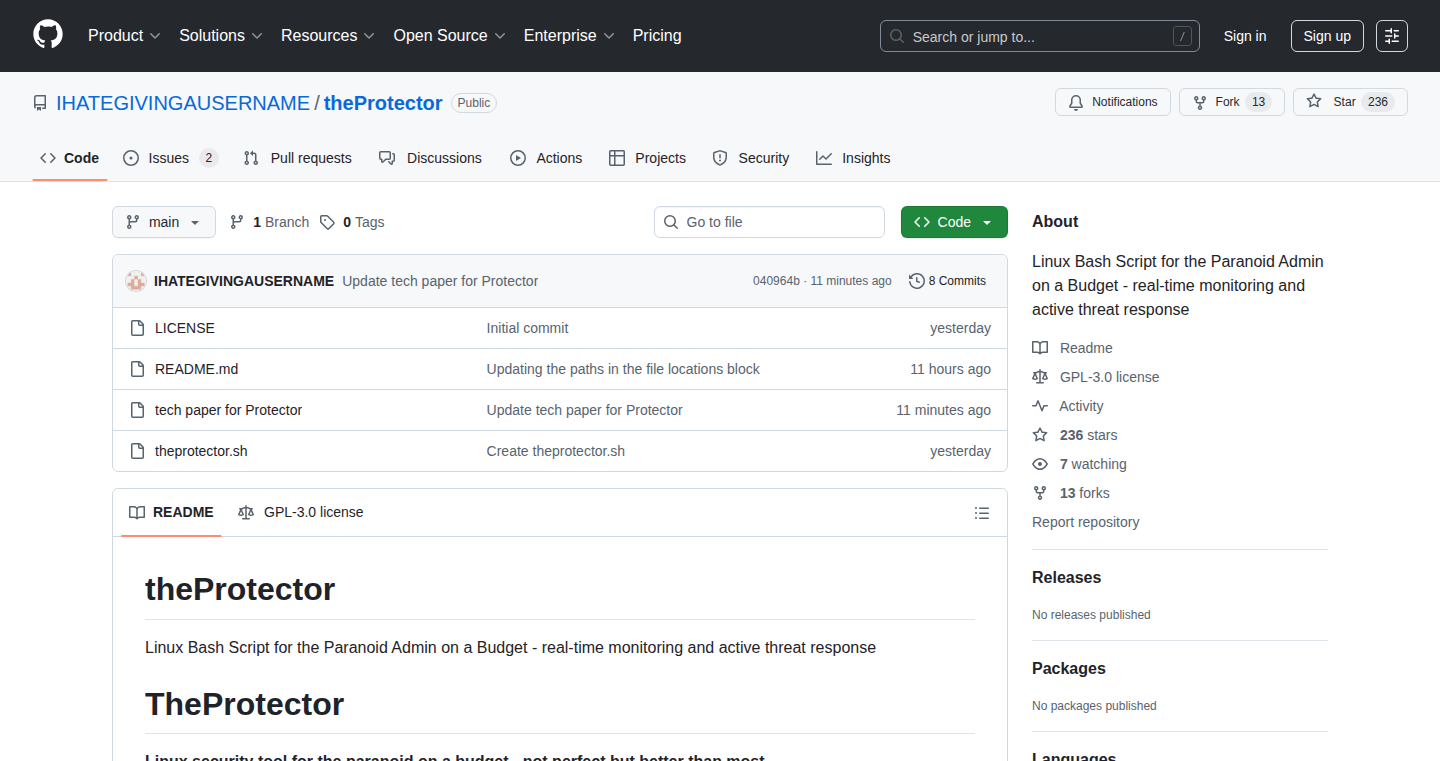
Author
lotussmellsbad
Description
TheProtector is a security monitoring tool built for Linux systems, created to combat the expensive and often ineffective enterprise security solutions. It's designed for users who are security-conscious but don't have massive budgets. The core innovation lies in its simplicity and focus on real-time monitoring of processes, network activity, and file changes, combined with proactive threat response mechanisms. It leverages techniques like YARA malware detection, eBPF kernel monitoring, and behavioral analysis to detect anomalies and potential threats. It's all packaged in a single bash script, making it easy to deploy and understand, offering a cost-effective and transparent security solution.
Popularity
Points 138
Comments 30
What is this product?
TheProtector is a security tool that runs directly on your Linux system. It's like having a vigilant watchdog that constantly monitors what's happening on your computer, looking for suspicious activity. It works by tracking things like which programs are running, what network connections are being made, and changes to files. It uses several clever techniques like: YARA (a pattern matching system to identify known malware); eBPF (a way to peek inside the Linux kernel for suspicious behavior); and behavioral analysis (learning what's normal on your system and alerting you when something unusual happens). This allows it to detect and respond to potential threats in real-time, even blocking them or quarantining malicious files. The beauty is it's a single bash script, meaning it's easy to install, understand, and customize. The tagline 'not perfect but better than most' represents a down-to-earth approach, avoiding the hype often associated with security products. So, this means it’s practical, affordable, and actually does something, unlike the expensive, black-box solutions. The real benefit is a cheaper and customizable alternative security solution that does not rely on expensive and complicated setups.
How to use it?
You can use TheProtector by simply downloading and running the bash script on your Linux system. It's designed to be straightforward, so no complicated installation or configuration is required. You might integrate it into your existing Linux server infrastructure, or on your personal laptop if you want to keep an eye on things. You could also tailor it with custom YARA rules to hunt down specific threats that are relevant to your environment. You run it, configure a few settings (if you wish), and it starts monitoring. This is perfect for individuals and small businesses that want enhanced security without breaking the bank. Its focus on simplicity and customization through the use of bash script enables integration into most environments.
Product Core Function
· Real-time Process, Network, and File Monitoring: This feature constantly observes what’s going on with your computer: which programs are running, what network connections are being made, and what files are being changed. This helps detect any unexpected or suspicious activity by providing a snapshot of the system’s state. So this is for you if you want to quickly see what your system is up to.
· YARA Malware Detection with Custom Rules: YARA is a tool that helps identify malware based on patterns. TheProtector uses YARA rules to scan for known threats. Plus, you can add your own custom rules. So this is for you if you need to identify known malware.
· eBPF Kernel Monitoring: eBPF allows TheProtector to look deep inside the Linux kernel (the core of the operating system) for unusual behavior. This helps detect threats that try to hide. So this is for you if you want to detect stealthy threats that try to avoid detection.
· Behavioral Baseline Establishment and Anomaly Detection: TheProtector learns what “normal” activity looks like on your system. Then, it alerts you to any unusual behavior. So this is for you if you want to be alerted to threats you haven’t seen before.
· Active Threat Response: This allows TheProtector to take action, such as blocking suspicious IP addresses, stopping malicious processes, or isolating infected files. So this is for you if you want an automated way to respond to security threats.
· Anti-Evasion Detection: This functionality helps to identify rootkits and other advanced threats that try to hide their presence. So this is for you if you want to identify advanced malware that tries to be invisible.
· Honeypots for Attack Detection: TheProtector sets up “honeypots” (decoy systems) to attract attackers and provide early warnings of attacks. So this is for you if you want to proactively detect attacks early.
· Web Dashboard for Monitoring: It includes a user-friendly web interface for monitoring and reviewing security events, making it easier to stay informed. So this is for you if you prefer to monitor your system’s security through a graphical interface.
Product Usage Case
· A small business, without a dedicated IT security team, uses TheProtector to monitor their web server. The tool detects unusual network connections and alerts the administrator to a possible intrusion attempt, allowing them to take immediate action and prevent a potential data breach. The solution is a cheap and simple solution for the small business owner.
· A Linux enthusiast uses TheProtector on their personal laptop to monitor for malware and unwanted programs. Custom YARA rules are set to detect specific threats that may be relevant to their use cases. This provides better control and visibility into the activities on their system. This is useful for anyone who wants to have security and know-how their system works in-depth.
· A DevOps engineer integrates TheProtector into their automated deployment pipeline to provide an extra layer of security during the software development and deployment process. The active threat response features automatically block malicious IPs, ensuring a secure and streamlined development and deployment process. The solution offers an accessible, effective, and customizable approach to enhance the security posture of your systems.
· A security researcher uses TheProtector to create their own rules to detect suspicious activities in their lab to study the behavior of malware in a controlled environment. This is useful if you work on research in the cybersecurity industry.
3
WTFfmpeg: Natural Language to FFmpeg Translator
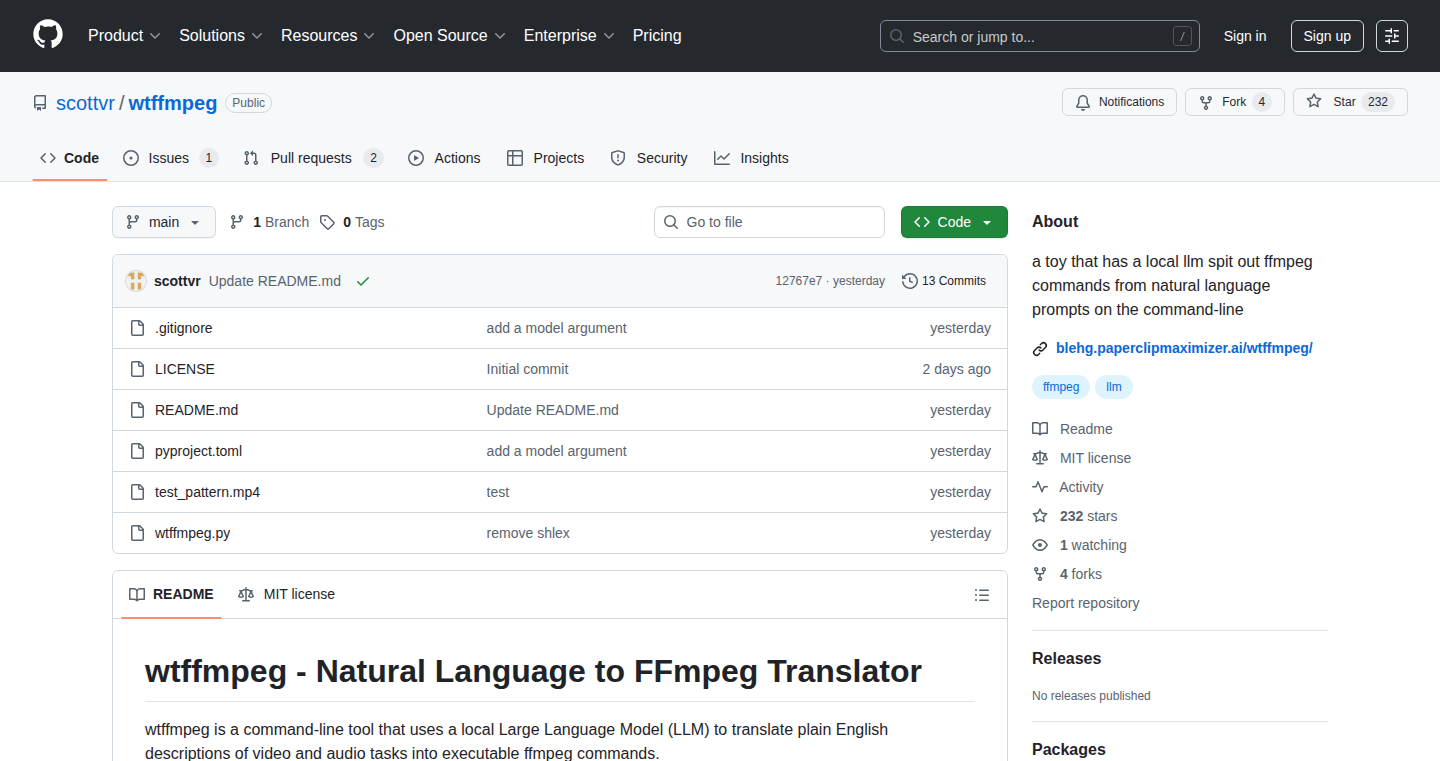
Author
ycombiredd
Description
WTFfmpeg is a fascinating project that bridges the gap between human-readable language and the complex world of FFmpeg commands. It allows users to describe what they want to achieve with video or audio, like 'resize video to 720p' or 'add a fade-in effect', and the tool will translate that description into the corresponding FFmpeg command. The core innovation lies in its natural language processing (NLP) capabilities, turning a complex technical interface (FFmpeg) into something accessible and intuitive. This solves the common problem of needing to memorize or constantly look up obscure command-line arguments, making video and audio manipulation significantly easier for both beginners and experienced users.
Popularity
Points 83
Comments 67
What is this product?
WTFfmpeg is essentially a translator for FFmpeg commands. It takes your everyday English description of what you want to do with a video or audio file and converts it into the correct FFmpeg command. The magic happens through Natural Language Processing (NLP). It breaks down your request, understands the meaning, and generates the equivalent FFmpeg command. This is innovative because it removes the need to learn and remember complicated command-line arguments. So this allows users to work with audio and video without having to become an FFmpeg expert.
How to use it?
Developers can use WTFfmpeg by simply providing it with a natural language description of their desired video or audio manipulation, such as a script or a user interface. It can be integrated into scripts for automating video processing tasks or embedded within applications to provide users with easier control over media files. You would use a simple API, feeding it your English request. Then, the tool provides the FFmpeg command. So this means developers can easily create video and audio manipulation features for their users without deep FFmpeg knowledge.
Product Core Function
· Natural Language to FFmpeg Command Translation: This core function takes natural language input (e.g., 'convert video to mp4') and generates the corresponding FFmpeg command. This simplifies the user experience dramatically. So this feature makes it very easy to use FFmpeg without having to remember any commands.
· Command Generation: Based on the user's description, the tool generates the correct FFmpeg command, handling intricate details of codecs, bitrates, resolution, and effects. So this enables users to perform complex video and audio tasks without detailed technical expertise.
· Error Handling and Feedback: WTFfmpeg likely includes some form of error handling to flag any ambiguities or issues in the user's natural language input. So this provides helpful feedback to users who might have described what they want in an ambiguous way.
· Customization and Presets: The project might incorporate the ability to customize the generated commands or to save commonly used transformations as presets. So this allows for efficient workflows, where users can save time when repeatedly using similar operations.
· User Interface (UI) Integration: Developers can build a user-friendly UI on top of the tool to easily interact with video and audio files. So this allows for the creation of simple, intuitive media editing programs.
Product Usage Case
· Automated Video Processing: A developer wants to automate the resizing and conversion of videos to fit a specific website's requirements. Using WTFffmpeg, they can describe the desired changes and easily generate the necessary FFmpeg command without delving into command-line syntax. So this allows developers to efficiently process videos in bulk.
· Educational Tool for FFmpeg: A developer could build an interactive tool that demonstrates how FFmpeg commands work. The user enters a natural language description, and the tool reveals the corresponding FFmpeg command. So this tool would help people learn and understand FFmpeg commands more easily.
· Simplified Video Editing Application: A developer could integrate WTFffmpeg into a video editing application, allowing users to perform basic video editing tasks using simple English descriptions. So this makes video editing a lot more user-friendly and accessible to non-technical users.
· Converting different video and audio files programmatically using scripts. So it solves tedious and repetitive manual processes.
4
Bookhead: Data Engineering as a Service for Booksellers

Author
greenie_beans
Description
Bookhead is a bookselling application designed to simplify and streamline the online sales process for independent booksellers. It provides an inventory management system that integrates with various e-commerce platforms like Squarespace, Biblio, and eBay. The project focuses on tackling the fragmented and disconnected nature of existing bookselling software by offering a unified platform, acting like a 'Zapier' for booksellers, aiming to simplify their workflows and improve their online presence. This is achieved by providing an inventory, e-commerce, and marketing tool in a single integrated system.
Popularity
Points 86
Comments 25
What is this product?
Bookhead is essentially a 'one-stop-shop' for booksellers to manage their online business. It works by providing an inventory management system to list books on multiple platforms, and also provides an e-commerce platform with a CMS for selling books and allowing store owners to customize their brand. The core innovation lies in the integration and automation of various aspects of bookselling, which addresses the current fragmentation in the market. Think of it as a toolbox, giving booksellers all the necessary tools to build and manage their online store, rather than having them juggle multiple disconnected softwares. So this means you can focus on selling books instead of struggling with technology.
How to use it?
Bookhead is designed to be easy for booksellers to use. You can list your books on various platforms from the inventory management system. The platform integrates with multiple e-commerce options, allowing booksellers to sell their books wherever they want. It also offers an e-commerce platform with a CMS, where you can control the look and feel of your online store. You integrate by simply linking your existing platforms or start fresh. This lets booksellers get started quickly, without requiring technical expertise. So you can get your books online faster and easier.
Product Core Function
· Inventory Management: This allows booksellers to easily track and manage their book inventory, including details such as title, author, condition, and pricing. This reduces the risk of overselling or mismanaging stock. For you, this means less time manually updating spreadsheets and more time for actual book-related tasks.
· Cross-Platform Listing: Bookhead enables booksellers to list their books on multiple e-commerce platforms such as Squarespace, Biblio, and eBay. This increases the visibility of the books and expands the potential customer base. For you, this expands your reach to customers and increases your sales.
· E-commerce Platform with CMS: Provides booksellers with their own online store, including a content management system (CMS) to customize the store's look and feel, manage content, and build a unique brand. This strengthens your brand identity and improves the customer experience. For you, this means control over your store's design and a better brand presence.
· Integration and Automation: Connects and automates various processes of bookselling. Bookhead eliminates the need for manual data entry, saving time and reducing errors. For you, this streamlines your workflow and saves you time to do more valuable activities.
Product Usage Case
· A bookstore owner struggling to manage inventory across multiple selling platforms (eBay, their website, etc). Bookhead allows them to centralize their inventory management, ensuring stock accuracy and consistency across all platforms. This is a direct solution to the common problem of overselling or having to manually update listings on multiple sites. For you, this means less headache and more time to curate book collections.
· A new bookseller wants to establish an online presence but is overwhelmed by technical setup. Bookhead's e-commerce platform with CMS offers an easy-to-use way to create a professional-looking online store without needing coding skills. It simplifies branding and online store management. For you, this reduces the learning curve to launch your online business.
· An established bookstore wants to integrate its inventory with its marketing efforts. Bookhead will potentially allow them to automate marketing campaigns based on their inventory, offering targeted promotions to customers. For you, this means more efficient marketing efforts and increased sales.
5
TurboStitchGIF: A Fast, Zero-Allocation GIF Decoder in Pure C
Author
FerkiHN
Description
This project is a lightweight GIF decoder written entirely in C, designed for situations where speed and memory efficiency are crucial. The most innovative aspect is that it's a 'header-only' library, meaning you only need to include one file in your project. It avoids using dynamic memory allocation (no `malloc`), making it perfect for embedded systems and performance-sensitive applications. It supports both static and animated GIFs, offering both 'turbo' and 'safe' decoding modes. So, if you are working on a device with limited resources or need extremely fast GIF decoding, this is a great solution. It solves the problem of inefficient GIF decoding, enabling smooth GIF playback on resource-constrained devices.
Popularity
Points 47
Comments 40
What is this product?
This is a GIF decoder library. The core technology lies in its efficient implementation in C. It avoids using dynamic memory allocation (no `malloc`), which means it doesn't request memory from the system while running, making it very fast and memory-friendly. Being 'header-only' simplifies integration into any project. It also provides 'turbo' and 'safe' decoding modes, allowing developers to choose between speed and safety. This approach minimizes overhead and improves performance, especially on embedded systems or devices with limited resources. So this allows you to decode GIFs in environments where memory is tight or performance is critical, something that’s hard to achieve with standard libraries.
How to use it?
Developers can simply include the header file in their C project and start using the decoder. The provided code includes clear instructions for initializing the decoder, passing the GIF data, and retrieving decoded frames. Common use cases include integrating GIF playback into microcontrollers, IoT devices, or any platform with a framebuffer. Think of it like this: If you're building a small screen for a device and want to display animated GIFs, this library provides a super-efficient way to do so.
Product Core Function
· GIF Decoding: The core function decodes GIF data, extracting frames, and providing them for display. It supports both static and animated GIFs. This is useful for displaying animated content on resource-constrained devices.
· Zero Memory Allocation: This means the decoder doesn't use `malloc` to request memory during runtime. This is especially important for embedded systems where memory is limited and needs to be managed very carefully. This helps to avoid potential memory-related errors.
· Header-Only: The library is a single header file, making integration extremely easy. Developers just include the header file in their C code and start using the decoder. This reduces complexity and simplifies project setup.
· Turbo and Safe Modes: These modes offer a trade-off between speed and safety. 'Turbo' mode prioritizes speed for maximum performance, while 'safe' mode provides extra checks for data integrity. This lets developers choose the optimal mode based on their needs.
Product Usage Case
· Embedded Systems: Imagine you are designing a smart watch and want to display animated notifications. Using this decoder, you can render GIFs directly on the watch's display without consuming much memory or CPU power. It solves the problem of slow or memory-intensive GIF playback on the watch.
· IoT Devices: If you're building a small display for an IoT device, like a home automation panel, you can use this decoder to show animated icons or status indicators. This enhances the user experience without burdening the device's resources. It provides a lightweight way to display dynamic content on IoT devices.
· Microcontrollers: You're working on a project that requires displaying animations on a small, low-power microcontroller. The zero-allocation feature makes it ideal for this scenario, as it doesn't rely on dynamic memory that microcontrollers often lack or manage poorly. This allows you to display animated content where other solutions would fail.
6
AutoDocServer: Self-Updating Documentation Server for Package Managers
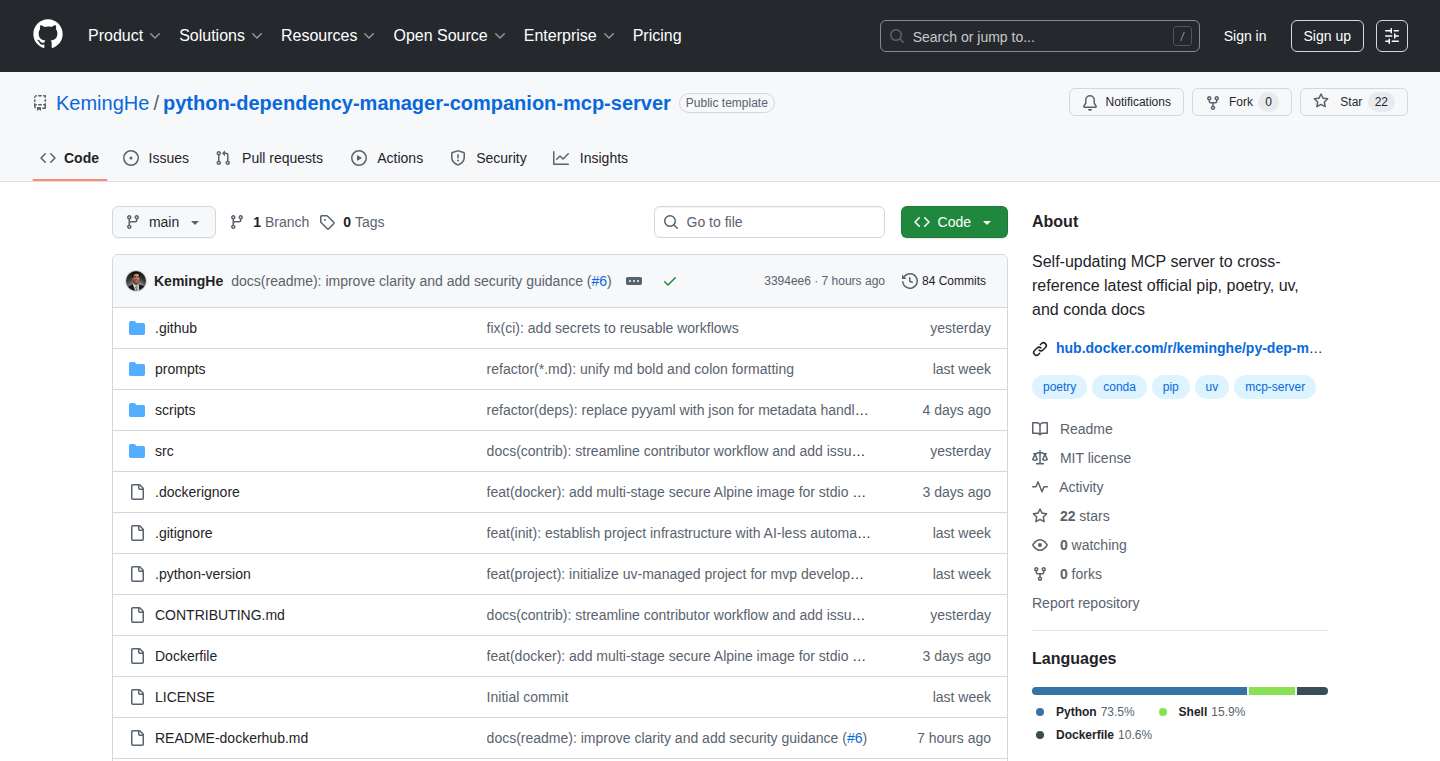
Author
keminghe
Description
AutoDocServer automatically keeps documentation up-to-date for popular Python package managers like pip, uv, poetry, and conda. It tackles the tedious task of manually updating documentation by providing a self-updating server that fetches and serves the latest official documentation. The innovation lies in its automated synchronization with the source documentation repositories, ensuring developers always have access to the most current information.
Popularity
Points 28
Comments 15
What is this product?
AutoDocServer is a server that automatically fetches and serves documentation for Python package managers. Think of it as a smart, self-updating library that provides instant access to the latest instructions and guides for tools like pip, uv, poetry, and conda. Instead of manually searching for the most recent documentation, developers can access it directly through this server. The innovation lies in its automation: it constantly checks and updates itself, making sure the documentation is always current, similar to how your phone automatically updates apps.
How to use it?
Developers can use AutoDocServer by pointing their documentation viewers or IDEs to the server's URL. This could be integrated in an IDE or a documentation viewer, so that when developers are working on a project, and need information about a specific package manager, they can simply look it up. So, the next time you need to quickly understand how to use pip, you won't have to search through different websites; instead, it will be instantly accessible through the AutoDocServer.
Product Core Function
· Automatic Documentation Synchronization: This feature ensures the documentation is always up-to-date by periodically fetching the latest version from official sources. This eliminates the need for manual updates and guarantees users have the most current information. For developers, this means always having the correct instructions at hand.
· Centralized Documentation Access: Provides a single access point for documentation across different package managers, simplifying the process of finding and understanding usage instructions. This makes it easier for developers to quickly switch between different tools.
· Automated Server Maintenance: Handles the underlying infrastructure that serves documentation, which saves time and resources for developers and reduces the need to maintain a local documentation server. This enables the development teams to focus on the more critical tasks.
· Version Control and History Tracking: Automatically keeps track of version changes and allows access to older versions of documentation. In case a new version introduces breaking changes, it enables developers to consult previous version instructions.
Product Usage Case
· Scenario 1: A developer needs to understand the latest options for `pip install`. Instead of navigating to various websites and manually searching for the specific option, they can consult AutoDocServer. This provides the immediate most accurate information. It solves the problem of information overload.
· Scenario 2: A team uses `poetry` and `conda` for different projects. AutoDocServer can be configured to serve both sets of documentation. Instead of spending time switching between documentations, the teams can access each documentation easily in a unified way, ensuring everyone is on the same page regarding usage.
· Scenario 3: A developer is using a new version of `uv` and encounters an issue. They use AutoDocServer to access the documentation. The automated server helps save a ton of time when getting acquainted with the package manager.
7
BlogInsight: A Topic Explorer for Bloggers and Content Creators
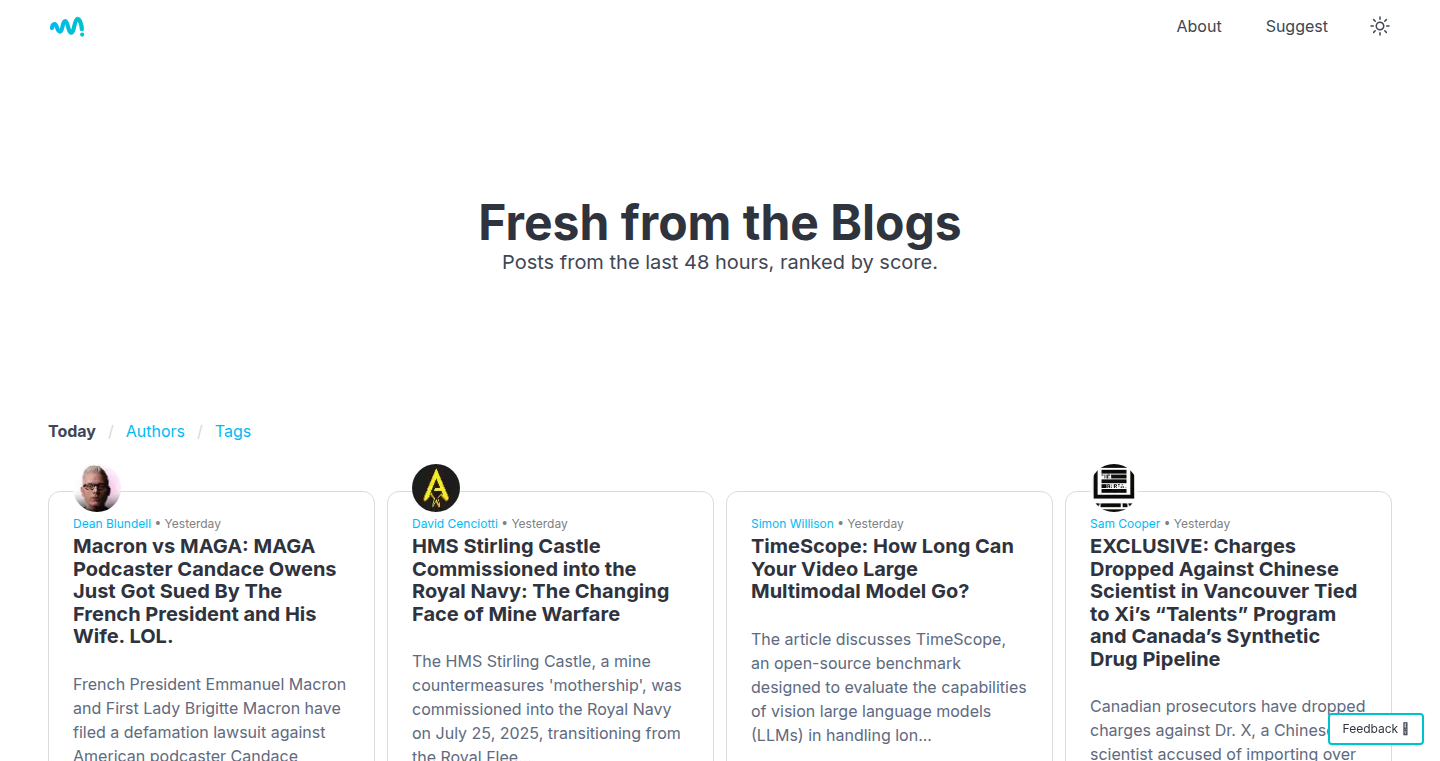
Author
neekp
Description
BlogInsight is a tool that helps you discover bloggers, identify trending blog topics, and get weekly summaries of relevant content. The innovation lies in its ability to automatically crawl and analyze a large corpus of blog posts to extract key topics and identify emerging trends. It solves the problem of manually searching for blog content and staying up-to-date on the latest developments in specific areas.
Popularity
Points 11
Comments 3
What is this product?
BlogInsight uses web scraping techniques to gather data from various blogs and websites. It then employs Natural Language Processing (NLP) to analyze the text, identify key phrases and topics, and track their popularity over time. This allows the tool to identify trending topics and recommend relevant bloggers and content. So this is useful for anyone needing to find and understand blog content without spending hours manually searching and reading.
How to use it?
Developers can use BlogInsight by integrating it into content management systems (CMS) or other applications that require content discovery and analysis. You can access the tool through an API to retrieve trending topics, blogger recommendations, and weekly summaries. For example, developers building content aggregation platforms, or those building tools to automatically curate content for social media. So this will save you time building integrations for content discovery
Product Core Function
· Trending Topic Identification: BlogInsight analyzes a vast amount of blog content and identifies topics that are currently gaining popularity. This feature is valuable for content creators looking to capitalize on current trends and produce timely content. So this is useful for writers trying to stay relevant.
· Blogger Discovery: The tool helps users find relevant bloggers based on topic and popularity, providing a list of bloggers to follow and learn from. This is useful for building connections in your niche.
· Weekly Content Summaries: Users can receive weekly summaries of trending topics and new content from relevant bloggers. This helps save time by providing a concise overview of current happenings.
· Keyword Extraction: BlogInsight extracts the keywords and key phrases used most frequently within a topic. This is helpful for creating SEO optimized content, or getting a sense of what keywords are most popular in the field you're studying. So this will improve your content search rankings.
· Sentiment Analysis: The system may potentially employ sentiment analysis on blog content, identifying the positive or negative sentiment around specific topics. This enables users to understand the public's opinion and create content that resonates accordingly. So this can help you tune the tone of your content.
Product Usage Case
· Content Aggregation Platform: A developer integrates BlogInsight's API into their content aggregation platform to automatically surface trending blog posts and relevant bloggers to its users. This improves user engagement and provides valuable content. So, your users get better content faster, and you get more users.
· SEO Tool: A developer uses BlogInsight to provide keyword recommendations and trending topic insights within their SEO tool. This enables users to create content that is more likely to rank well in search results. So, you help your users reach more customers.
· Social Media Automation: A developer builds a social media automation tool that uses BlogInsight to find interesting content and automatically share it on behalf of users. This increases social media presence and content engagement. So, you help people grow their social media presence.
8
RcloneView: Visual Cloud Storage Manager
Author
newclone
Description
RcloneView is a user-friendly graphical interface (GUI) built on top of Rclone, a powerful command-line tool for managing cloud storage. It simplifies the often complex task of handling files across various cloud services, offering features like file transfer, synchronization, and folder comparison. It solves the problem of developers and power users needing an easier way to interact with Rclone's functionalities. So this is useful for anyone who wants to manage their cloud storage with an intuitive interface instead of using the command line.
Popularity
Points 12
Comments 0
What is this product?
RcloneView takes the power of Rclone and wraps it in a user-friendly visual environment. Rclone itself is like a universal translator for cloud storage, allowing you to connect to and manage files across multiple cloud providers (like Google Drive, Dropbox, etc.) using commands. RcloneView gives you a visual way to do all that, with features like drag-and-drop file transfers, visual folder comparisons for syncing, job scheduling, and the ability to mount cloud storage as a local drive. It's built using cross-platform technologies and supports a wide array of cloud storage services. So this means you get the full power of Rclone with a user-friendly visual interface.
How to use it?
Developers can use RcloneView to easily manage their cloud-based project files, sync code repositories, and back up data. System administrators can use it for server backups and data migrations. Researchers can use it to manage and share large datasets stored across different cloud platforms. You can download and install RcloneView and then connect it to your cloud storage accounts. The interface then allows you to browse, transfer, sync, and manage files visually. You don't need to know the complicated command-line syntax of Rclone, making it easier for anyone to use. So this helps you get started quickly managing your cloud storage, making file management easier.
Product Core Function
· File Transfer, Sync, Copy, and Move: This allows users to easily move files between different cloud storage providers, syncing files to keep data consistent across different locations. This is useful for anyone needing to transfer or synchronize files between their local devices and various cloud storage services.
· Visual Folder Comparison: The ability to visually compare folders before syncing provides a clear overview of the changes, preventing accidental data loss or overwrites. This is valuable for those who need to ensure data consistency and avoid unexpected file conflicts during synchronization.
· Job Management with Scheduling, History, and Dry-Run: Users can schedule tasks, review past operations, and simulate actions without actually making changes, providing control and safety during critical operations. This is helpful for automating cloud storage tasks, tracking operations, and verifying changes before they are implemented.
· Mount Cloud Storage as a Local Drive: This allows users to access their cloud storage as if it were a local drive on their computer, making it easier to work with files without needing to manually download and upload them. This is useful for anyone wanting seamless integration between cloud storage and their computer's file system.
Product Usage Case
· Software developers can use RcloneView to easily sync their code repositories with cloud-based storage, ensuring that their latest version of their code is always backed up and accessible from any device. So, this saves time and improves workflow.
· System administrators can use RcloneView to perform server backups to multiple cloud storage providers, providing redundancy and disaster recovery capabilities. So, this ensures data safety and business continuity.
· Researchers can utilize RcloneView to manage and share large datasets across different cloud platforms, collaborating with others more easily, and making sure their data is properly backed up. So, this simplifies data management and collaboration.
9
QCache: High-Performance, Sharded Go Cache with LRU/LFU & Object Pooling
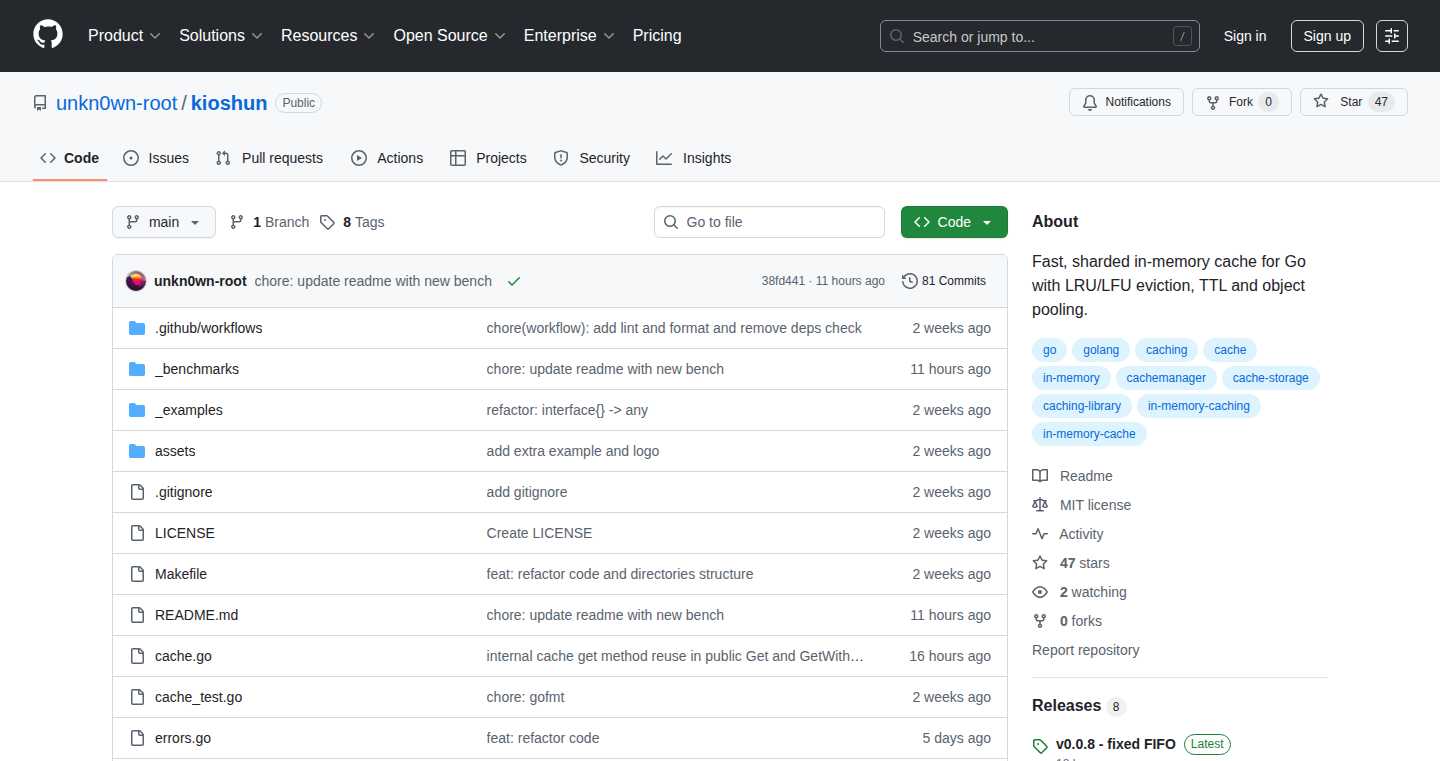
Author
unkn0wn_root
Description
QCache is a Go-based caching system designed for speed and scalability. It employs sharding (dividing data across multiple sections) to improve performance, incorporates Least Recently Used (LRU) and Least Frequently Used (LFU) algorithms for efficient memory management, implements Time-To-Live (TTL) for automatic data expiration, and utilizes object pooling to reduce the overhead of creating and destroying objects. The core innovation lies in its architecture, combining these techniques to achieve both high throughput and efficient resource utilization, making it suitable for demanding applications.
Popularity
Points 11
Comments 1
What is this product?
QCache is like a super-fast, smart storage container for your data in Go applications. It doesn't just store data; it optimizes how that data is accessed and managed. Sharding splits the cache into smaller parts for faster access. LRU/LFU algorithms decide which data to keep based on how often it's used or how recently it was accessed. TTL sets an expiration time for each piece of data, so you don't have stale information. Object pooling reuses memory, making the system more efficient. So what? You get a fast, efficient, and reliable caching solution that can handle a lot of requests.
How to use it?
Developers can integrate QCache into their Go projects as a library. They would typically use it to store data that is computationally expensive to generate (like the results of complex database queries) or frequently accessed. To use it, developers would import the QCache package, configure the cache with desired settings (size, TTL, sharding), and then use simple methods like `Set` to store data, `Get` to retrieve data, and `Delete` to remove data. This is especially helpful for improving the performance of web applications, APIs, or any system where caching can significantly reduce the load on backend resources.
Product Core Function
· Sharding: Splits the cache into multiple segments, enabling parallel access and improved performance under high load. Value: Makes your cache faster, especially when many users are accessing the system, because it avoids a single bottleneck.
· LRU/LFU Eviction: Implements Least Recently Used and Least Frequently Used algorithms to automatically remove the least valuable data when the cache reaches its capacity. Value: Ensures that the most important data is always available in the cache, maximizing the chances of a cache hit and minimizing the chance of retrieving the same data again.
· TTL Management: Provides Time-To-Live functionality, setting an expiration time for each cached item, ensuring data freshness. Value: Keeps your cached data up-to-date automatically; eliminates the need to manually manage when data is outdated.
· Object Pooling: Reuses allocated memory for cache entries to avoid the overhead of creating and destroying objects repeatedly, thus improving performance. Value: Reduces memory allocation overhead, making the cache more efficient, especially when dealing with frequent data updates.
Product Usage Case
· API Caching: Imagine a web application that fetches data from a database. You can use QCache to store the results of database queries. This will reduce the time it takes to respond to user requests and decrease the load on your database. So what? Your API responds faster, and your database doesn't have to work as hard.
· Web Application Session Storage: In a web application, QCache can be used to store user session data. This way, instead of looking up user details in a database every time, you can quickly retrieve the information from the cache. So what? Your users will have a smoother, faster experience.
· Content Delivery Networks (CDNs): QCache can be used to cache content at the edge servers of a CDN. This ensures that content is delivered to users quickly, regardless of their location. So what? Web pages load quickly for users around the world.
10
Equatile: A Logic-Based Puzzle Game Built with Expo
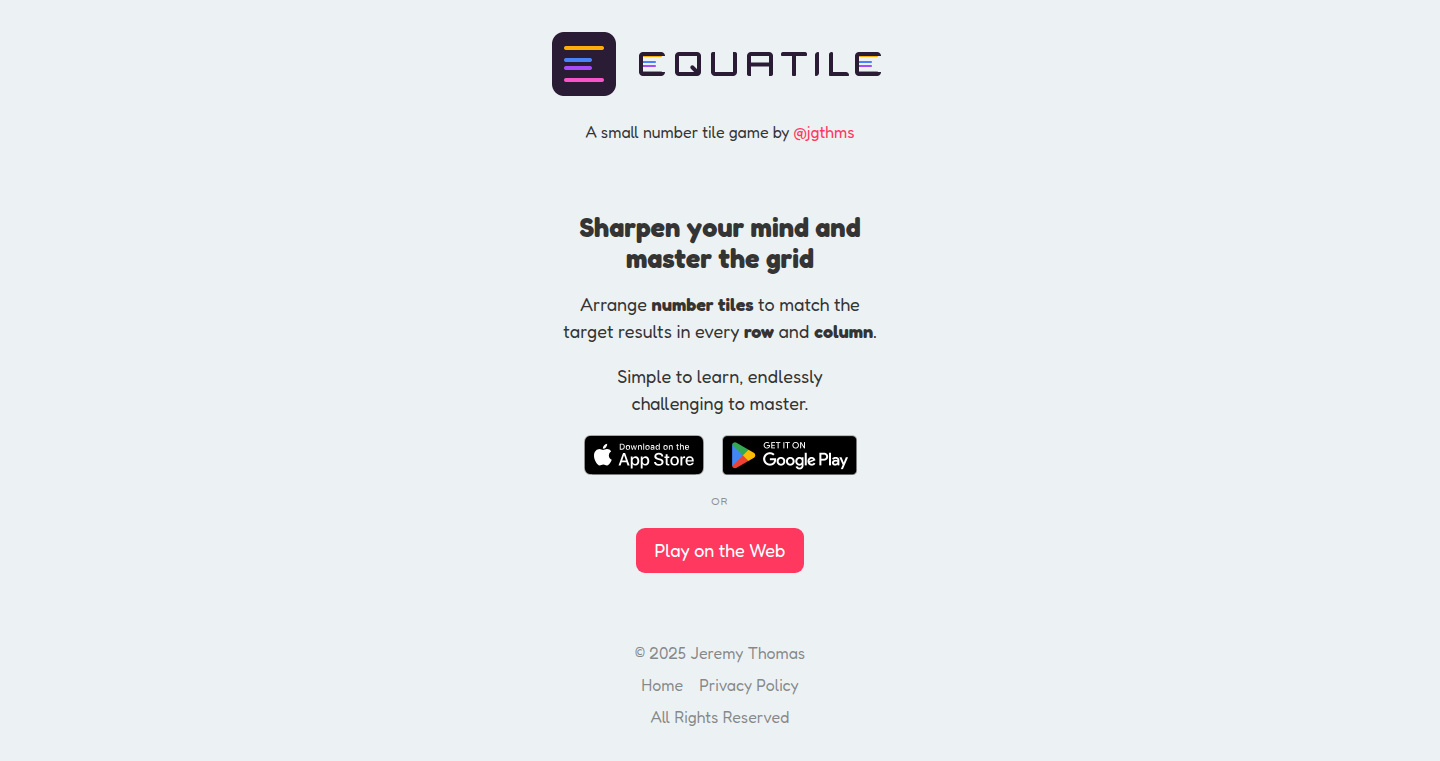
Author
bbx
Description
Equatile is a puzzle game where players arrange number tiles on a grid to make each row and column sum up to target values. The game is built using Expo, a framework that makes it easier to develop cross-platform applications. The core innovation lies in its logic-based gameplay, offering a new kind of challenge for puzzle enthusiasts. This showcases the power of Expo for rapid prototyping and cross-platform deployment of interactive games.
Popularity
Points 8
Comments 3
What is this product?
Equatile is a puzzle game where you manipulate numbers on a grid to achieve specific sums for each row and column. Think of it as a Sudoku-like experience, but with a focus on arithmetic rather than just number placement. The game leverages Expo to provide a seamless experience on iOS, Android, and the web. So, it's a fun way to test your math skills across different devices.
How to use it?
Players download the game on their preferred platform (iOS, Android, or web) and start playing immediately. The rules are simple: arrange the number tiles to match the target sums. Developers can take inspiration from the game's logic and use Expo to build their own cross-platform applications, whether they are games, educational tools, or interactive utilities. So, if you're a developer looking to build a similar cross-platform game, you can learn from the game.
Product Core Function
· Grid-based puzzle mechanics: The core of the game revolves around placing numbers on a grid, requiring players to think strategically about addition and subtraction to achieve target sums. This teaches players to find the best numerical placements to meet the condition. So, if you want to test your addition and subtraction skill or you're a game developer who wants to see how a grid-based puzzle can work, this is useful.
· Cross-platform compatibility (Expo): The game's utilization of Expo is crucial. Expo simplifies the development process by allowing the developer to write one codebase and deploy to multiple platforms. So, if you are a developer, you can learn how to deploy the app on different systems.
· Logic-based gameplay: The puzzle's focus on numerical relationships provides a challenging and engaging experience. Players have to use logic and deduction. So, if you are a puzzle enthusiast who likes to think about numbers, you should enjoy the game.
· Target sum verification: A central element is that the game checks the sums of rows and columns. This feedback loop encourages players to refine their strategies. So, you know whether you have the right answer right away.
Product Usage Case
· Educational Tool Example: A teacher could adapt the game's mechanics to create educational games or interactive tools. Such tools are great for teaching basic arithmetic principles. So, if you're a teacher, you can see the core function of number games.
· Game Prototyping: Game developers can use Equatile as a learning resource to examine the game's structure and logic to help them prototype new games. This can help them save time and money in the prototyping stage. So, if you're a game developer, you can see how to test the gameplay.
· Cross-Platform Application Development: The game itself showcases how Expo can be leveraged to build cross-platform applications, saving the development time and resources. So, if you are a developer, you can see how to make your app accessible on different platforms.
11
WFGY - Semantic Engine for Divergent Coherence
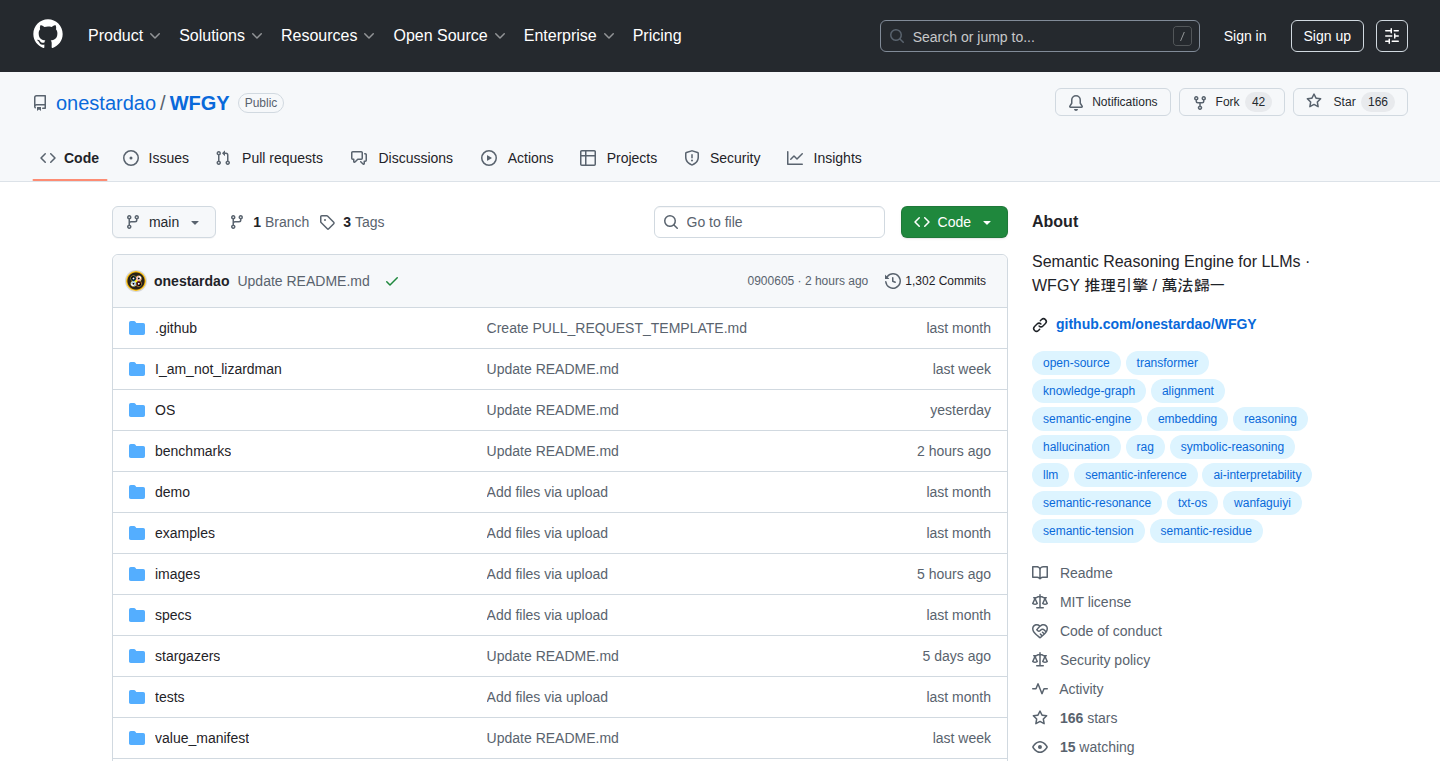
Author
TXTOS
Description
WFGY is a semantic engine that allows your embedding space to drive behavior, acting like a semantic OS. It moves beyond simple information retrieval or summarization, focusing on generating diverse perspectives and coherent outputs based on the meaning of your input. The initial module, the Truth generator, provides 50+ perspectives on any given input with a single button click. So it can help you explore different aspects of a concept. The core innovation lies in its ability to utilize embedding spaces to understand and manipulate meaning, offering a new approach to problem-solving in areas like image processing, game development, and firewall implementations.
Popularity
Points 7
Comments 3
What is this product?
WFGY is a software engine that helps computers understand and work with meaning. It's built on the idea of 'embedding spaces,' which are ways of representing information in a way that allows a computer to understand the relationships between different concepts. The key innovation is that WFGY is not just about finding or summarizing information, but about generating different perspectives and insights from that information. Think of it as a way to deeply understand the core essence of any input. So, it gives you various viewpoints on the same topic. It's like giving you a tool to explore different facets of something.
How to use it?
Developers can use WFGY to build applications that need to understand the meaning behind information, not just keywords. For example, in a research tool, it could provide multiple viewpoints on a paper. In a creative tool, it can generate ideas. In an educational setting, it can explain concepts from different perspectives. Integration is achieved through API calls to the WFGY engine, taking input and generating the coherent outputs. So, as a developer, you can incorporate this semantic understanding engine to make your apps smarter.
Product Core Function
· Truth Generator: This core module takes an input and generates over 50 different perspectives on it. It enables users to explore the different facets and angles of any input. This is useful for brainstorming, exploring multiple points of view on a single topic, and for better understanding the nuances of complex ideas. It allows you to look at the same thing from different angles, enriching the understanding.
· Semantic Processing Engine: At the core, WFGY is a semantic processing engine leveraging 'embedding spaces'. This engine understands the meaning of input data and how different concepts relate to each other. It's designed to go beyond simple keyword matching and is able to produce coherent output based on the relationships between ideas, giving a deep understanding of the context of your input. It can power intelligent applications in various domains.
· Modular Design: WFGY is designed with modularity in mind. This means new capabilities, like image processing, game mechanics, and firewall rules, can be added easily. It is a flexible system that can evolve with the changing needs of developers. This allows the platform to constantly add new features, creating a versatile toolkit for handling various semantic challenges.
Product Usage Case
· Research Tool: A research application utilizes WFGY to analyze academic papers and automatically generate different perspectives on its key findings. It could offer diverse insights that a human researcher might miss, accelerating discovery. So it can help you with your research.
· Creative Writing Assistant: A creative writing tool incorporates WFGY to generate various plots for a story based on a single concept. It can serve as a brainstorming aid for writers to overcome creative blocks. So, it can give you more creative ideas.
· Educational Application: An educational app for history uses WFGY to present the same event from different historical viewpoints. It improves understanding by offering multiple perspectives to students. This empowers learners with a deeper comprehension of complex subjects.
12
Vacation Maximizer - Smart PTO Planner

Author
belchiorb
Description
This project is a smart vacation planner that helps you strategically schedule your Paid Time Off (PTO) around holidays to maximize your consecutive days off. It tackles the problem of figuring out the best time to take vacation days to get the most time away from work while minimizing the number of PTO days used. It lets users customize holiday schedules and account for mandatory vacation days. This is a practical application of algorithmic optimization to personal scheduling.
Popularity
Points 6
Comments 2
What is this product?
It's a tool that analyzes your calendar, considers holidays, and suggests the optimal dates for taking PTO. It uses an algorithm to find the best combination of vacation days that aligns with holidays, allowing you to get the longest possible break. The innovation lies in its ability to automate the planning process, saving you the time and effort of manually figuring out the best vacation dates. So this helps me plan my vacation in a smart and efficient way, saving time and maximizing my time off.
How to use it?
You can input your desired vacation year, customize the holiday calendar (adding or removing holidays), and define any mandatory vacation days. The tool then calculates the optimal PTO schedule, highlighting the best dates to take off. This can be useful for anyone who wants to plan vacations strategically, be it for personal use or for managing a team's vacation schedules. It's integrated by simply using the web interface and inputting the parameters, so the process is straightforward and accessible.
Product Core Function
· Holiday Aware PTO Planning: The core function is the ability to recognize and consider holidays when planning PTO. It identifies the days off and suggests PTO dates that extend your break by leveraging existing holidays. So this helps me to automatically account for holidays, ensuring that I get the most out of my vacation days.
· Customizable Holiday Calendar: The tool allows customization of the holiday calendar, letting users add, remove, or modify holidays specific to their region or company. This flexibility ensures accurate planning tailored to individual needs. So this ensures that my vacation planning reflects my actual holiday schedule.
· Mandatory Vacation Days Handling: It allows users to specify mandatory vacation days, accommodating company policies that require vacation days at specific times. This function is crucial for aligning with employer mandates. So this allows me to take into account my company's mandatory vacation policies when I am planning.
· Algorithmic Optimization: The project utilizes an algorithm to find the best possible PTO schedule, optimizing for the longest consecutive time off while using the fewest PTO days. So this helps me find the optimal vacation schedule with the least effort.
Product Usage Case
· Personal Vacation Planning: A user planning a trip in 2025 can use the tool to identify the best dates for PTO, considering both holidays and personal preferences. The tool would suggest specific days to take off to maximize the time away, allowing for a longer and more enjoyable vacation. So this helps me create a longer vacation by smart scheduling my days off.
· Team Scheduling: A team lead can use the tool to help schedule team vacations, ensuring coverage while maximizing the team's time off. This would help avoid conflicts and ensure adequate staffing during important periods. So this help me manage my team's vacation schedules effectively.
13
AstroDash: An AI-Powered 3D Space Runner

Author
dhruvania
Description
AstroDash is a 3D endless runner game built entirely in the browser within a week using AI tools. The project showcases the power of AI in game development, particularly in scripting, bug fixing, and gameplay optimization. It leverages technologies like Three.js for the 3D environment, demonstrating a rapid development cycle driven by AI-assisted coding.
Popularity
Points 3
Comments 4
What is this product?
AstroDash is a web-based game where you pilot a spaceship, dodging UFOs and laser beams in an endless runner format. It's innovative because it demonstrates how AI tools like Cursor (an AI-powered IDE) and ChatGPT can drastically accelerate game development. AI was used for generating game logic, fixing code errors, and fine-tuning the gameplay experience. So this is a great example of how AI can help create even complex things like games very quickly, showing it's possible to make something playable from scratch in a short amount of time.
How to use it?
You can play AstroDash directly in your web browser without any downloads. The project highlights how developers can use AI tools within their IDEs to rapidly prototype and iterate on game ideas. This involves using AI for code generation, debugging, and optimizing the game's mechanics. You might use it as inspiration for your game projects, thinking about all the cool features and the fact that you can use AI to handle the more complex logic of the game. This allows developers to focus on the creative aspects of game design, the exciting things, instead of being bogged down by the more technical details. So you can use this to learn how to make your own games quickly and efficiently.
Product Core Function
· 3D Environment Rendering: The game utilizes Three.js to create a 3D environment. This allows for an immersive visual experience within the web browser, which is a cool effect. So this allows us to be able to display the game environment in a very interactive and dynamic way.
· AI-Assisted Scripting and Logic: The project leans heavily on AI tools for scripting game logic. This significantly speeds up development by automating code generation and allowing developers to focus on gameplay and design. This means a game is able to come to life much faster.
· Bug Fixing with AI: AI tools are employed to identify and fix bugs in the game's code. This is crucial for maintaining a smooth user experience and reducing the time spent on debugging. So it allows you to focus on the fun part of making a game.
· Gameplay Optimization: AI is used to fine-tune gameplay elements, such as UFO behavior and difficulty balancing. This ensures a challenging yet enjoyable experience for players. This ensures that the game is actually fun to play.
· In-Browser Playability: The game runs directly in the browser, eliminating the need for downloads or installations. This enhances accessibility and makes the game easy to share and play. So, it's very convenient and allows for wider access to the game.
Product Usage Case
· Rapid Game Prototyping: The developer built a playable game in just seven days using AI. This showcases how AI can accelerate the prototyping phase for game developers. This means you can rapidly test ideas and concepts.
· AI-Driven Iteration: The project demonstrates iterative development where AI is used to refine and improve gameplay mechanics. So you can constantly improve your project.
· Learning and Experimentation: The project serves as a learning tool for developers, showcasing how AI tools can be integrated into the game development workflow. It's a great example of learning by doing and creating something you can share with others.
· Web-Based Game Development: The project highlights the feasibility of creating complex 3D games directly within a web browser. So it doesn't need any special hardware or downloads to start playing the game. Just a web browser is enough.
14
MLflow Interactive SHAP Report Generator
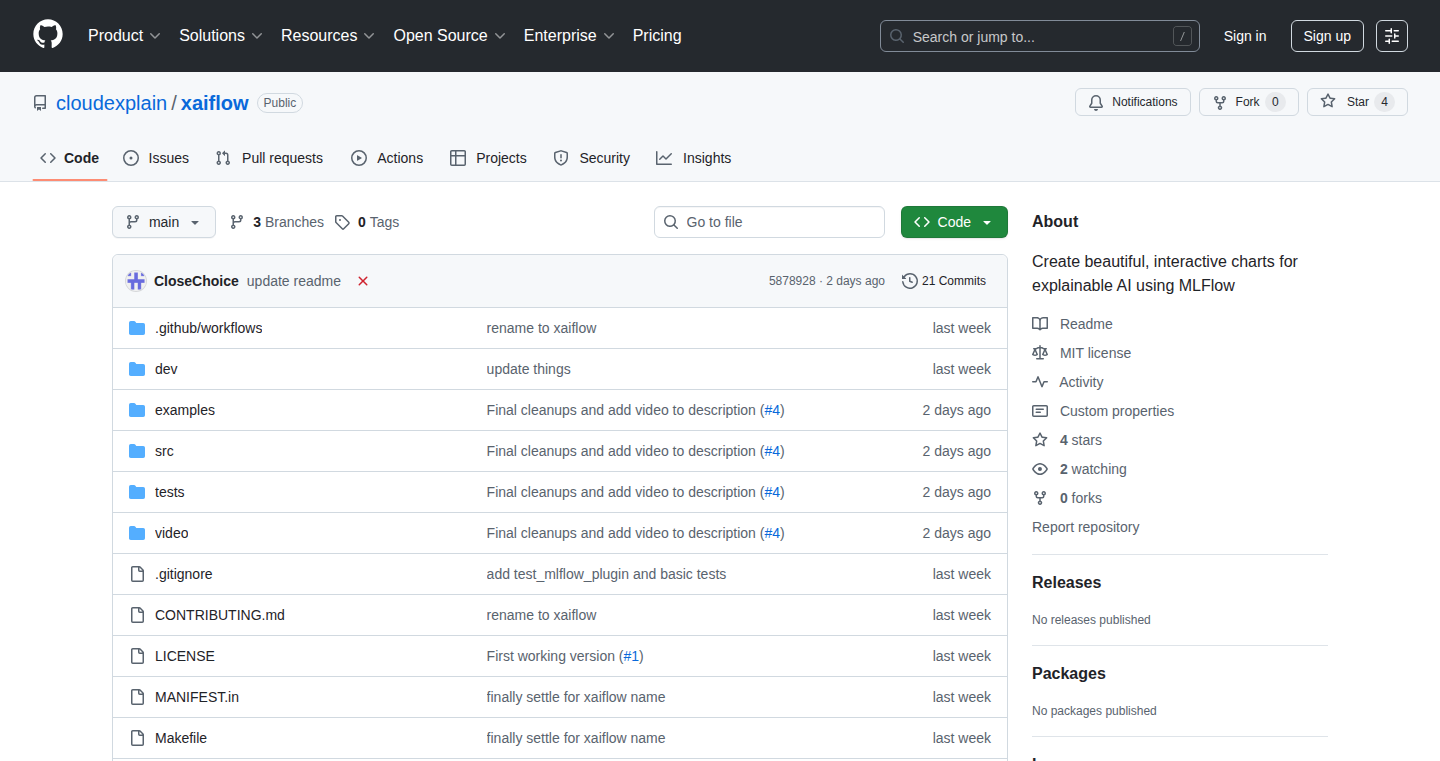
Author
CloseChoice
Description
This project provides an open-source plugin for MLflow, a popular machine learning platform. It generates interactive HTML reports that allow users to explore SHAP (SHapley Additive exPlanations) values, which are used to understand how individual features contribute to a model's predictions. The core innovation is the interactive visualization of SHAP values within the MLflow ecosystem, making model explainability more accessible and actionable.
Popularity
Points 4
Comments 2
What is this product?
This project is a plugin for MLflow that creates interactive HTML reports. These reports visualize SHAP values, helping users understand why their machine learning models make certain predictions. SHAP values explain the contribution of each feature in a dataset. So, this allows you to see how different factors influence your model's decision-making process. This project leverages existing libraries and packages (e.g., SHAP library, web technologies for interactive visualizations) to generate the reports. It's innovative because it tightly integrates the interactive explainability into the MLflow tracking and reporting workflow.
How to use it?
Developers can use this plugin by integrating it into their MLflow tracking pipeline. After training a model and calculating SHAP values, the plugin will generate an interactive HTML report that is then tracked as an artifact within MLflow. This report can be accessed through the MLflow UI, allowing developers to easily explore the feature contributions. The reports can be used to debug models, improve feature engineering, and communicate model insights to stakeholders. You can upload SHAP values as an artifact in your MLflow run, which then can be visualized via the plugin. This improves the interpretability of your model.
Product Core Function
· Interactive SHAP Value Visualization: This is the core feature. It generates interactive visualizations of SHAP values within an HTML report. This allows users to explore how different features impact model predictions in a dynamic and user-friendly manner. So this is extremely valuable because it makes model behavior easier to understand and debug.
· MLflow Integration: Seamless integration with MLflow. The plugin stores the interactive SHAP reports as MLflow artifacts, making them easy to track, version, and share. So this provides a centralized place to analyze and collaborate on your SHAP reports, which is essential in a team setting.
· Feature Contribution Analysis: Displays the contribution of each feature to model predictions. Allows users to identify the most important features and how they influence model outputs. So you can quickly understand which features are most critical for a model's performance and impact.
· Model Explainability Reporting: Generates comprehensive reports that summarize model behavior. These reports facilitate a better understanding of complex models and support model explainability initiatives. So this will help you to adhere to regulations that require explainable AI.
Product Usage Case
· Model Debugging: A data scientist is building a fraud detection model. Using the plugin, they can analyze the SHAP values to understand why the model is flagging certain transactions as fraudulent. By inspecting the feature contributions, they identify an issue with a specific feature and rectify it, improving model accuracy. So this enables faster debugging, saving time and improving model performance.
· Feature Engineering Improvement: A developer is working on a customer churn prediction model. By examining the SHAP values generated by the plugin, they discover that the interaction of two less-used features is a strong predictor of churn. They then focus on improving these features, leading to better churn prediction. So it enables improved feature engineering and therefore improves model performance.
· Stakeholder Communication: A machine learning engineer is presenting the model's performance to a non-technical audience. The interactive SHAP report allows them to visually explain how the model works, using easy-to-understand visualizations to illustrate feature importance. This helps build trust and understanding with stakeholders. So, now non-technical stakeholders can understand and trust your models.
15
CookStrava: Tracking Your Culinary Adventures

Author
cowllin
Description
CookStrava is a clever project that brings the activity tracking concept of Strava, usually used for exercise, to the world of cooking. It allows users to log their cooking sessions, essentially creating a personal diary for their culinary endeavors. The core innovation lies in repurposing the Strava platform's familiar interface to track cooking activities, recipes, and even the time spent in the kitchen. It solves the problem of keeping track of what you cook, when you cook it, and potentially sharing your culinary journey with others. So this is useful because you can easily document your cooking journey, discover your favorite recipes, and see how your cooking skills evolve.
Popularity
Points 2
Comments 4
What is this product?
CookStrava leverages the Strava platform and its associated technologies to log cooking activities. This project utilizes a combination of existing Strava API integrations and likely some level of data manipulation, possibly including the use of natural language processing or image recognition for recipe identification. The innovation here is the adaptation of a well-known fitness tracking platform to a completely different domain – cooking – and the potential for easy data collection and presentation. So it cleverly transforms a platform built for exercise tracking into a cooking log.
How to use it?
The user likely interacts with CookStrava by inputting data about their cooking sessions – perhaps the recipe name, ingredients used, cooking time, and a brief description. This data is then likely processed and visualized within a Strava-like interface, allowing users to track their cooking history, analyze trends, and share their culinary activities. Integration might involve manually entering data, or potentially, using API endpoints or importing data from external sources. So developers can use it to build their own cooking tracking application, visualize their cooking statistics and share them with other people.
Product Core Function
· Cooking Session Logging: This core function allows users to record the details of each cooking event. The value is in creating a detailed log of all culinary activity, enabling users to track their progress, identify patterns, and refine their cooking habits. This is useful for anyone who wants to keep a cooking journal.
· Recipe Organization: This function likely allows users to associate recipes with their cooking sessions, possibly through a database or other organizing mechanism. It facilitates recipe management and easy recall of favorite dishes. This is valuable for users who have a lot of recipes to track and wish to reproduce favorite meals.
· Activity Timeline & Visualization: Similar to Strava, this feature probably visualizes cooking activities over time, providing insights into cooking frequency, popular recipes, and overall culinary trends. It helps users get an at-a-glance view of their cooking habits. So it helps users analyze and appreciate their cooking habits and progress over time.
· Social Sharing (Potential): The possibility of sharing cooking logs with friends and family adds a social element. It can create a community around cooking and facilitate recipe discovery and inspiration. This is useful for cooks who want to connect with other culinary enthusiasts and share their creations.
Product Usage Case
· Personal Recipe Tracker: A home cook uses CookStrava to track every meal they prepare, the time it takes, and any modifications made to the recipe. Over time, they have a detailed history of their cooking habits and preferred recipes.
· Culinary Learning & Improvement: A beginner cook uses CookStrava to track their practice sessions, and identify their weak points and areas of improvement. By analyzing their data, they can experiment with new recipes and find the ones that best suit their taste.
· Recipe Sharing & Inspiration: A user shares their CookStrava cooking logs with friends, leading to recipe suggestions and culinary inspiration within their social circle. This way, they make cooking more social.
16
Limit: Unbreakable Android Content Blocker
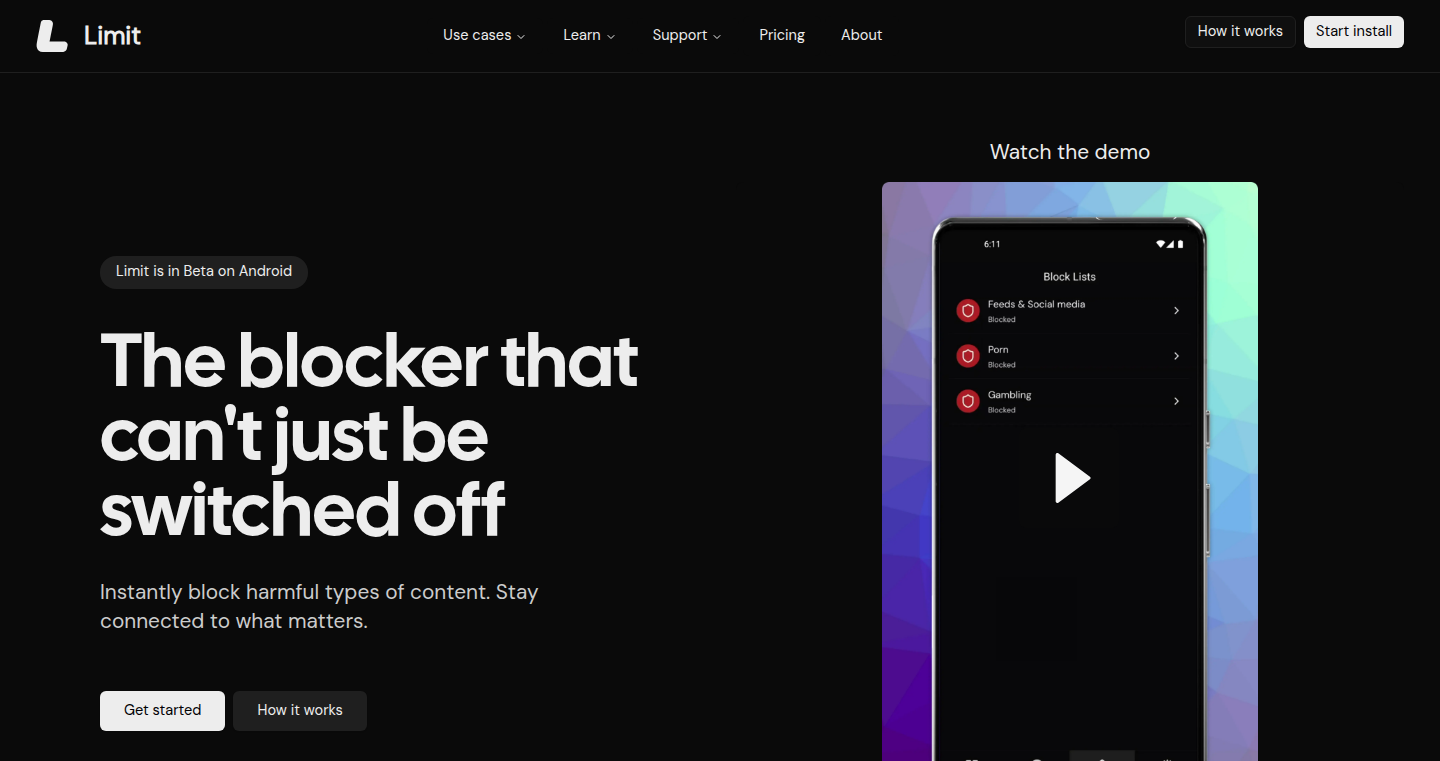
Author
richardgill88
Description
Limit is an Android application and website blocker designed to be exceptionally difficult to bypass. It tackles the common problem of users easily circumventing content restrictions by implementing robust blocking mechanisms. This project is a testament to solving a real-world problem using deep technical understanding. So this allows you to focus on what matters.
Popularity
Points 5
Comments 0
What is this product?
Limit functions by employing advanced techniques to prevent users from disabling the content restrictions. The underlying technology involves deep system integration within the Android operating system, making it significantly harder to bypass than typical blocking apps. This ensures the blocking functionality remains active, effectively restricting access to specific apps and websites. So this helps you manage your time and avoid distractions effectively.
How to use it?
Developers can use Limit as a powerful tool for personal productivity or as a component in parental control solutions. Integration involves downloading the app and configuring the block lists, which include social media, adult content, and gambling websites. Users can define their own custom block lists to meet specific needs. So this gives you total control over your digital environment.
Product Core Function
· Unbypassable Blocking: The core feature is the ability to block content in a way that cannot easily be disabled, even by tech-savvy users. This is achieved through deep integration with the Android system. This feature is valuable because it enforces the content restrictions effectively.
· Pre-configured Block Lists: Includes ready-made lists for social media, adult content, and gambling. This simplifies the setup process, allowing users to get started quickly. So this saves time and makes content blocking easy.
· 'Hands-off' Mode for Parents: Offers a mode designed for parents of teenagers, allowing them to set up content blocking without invading their children's privacy. This feature is valuable because it facilitates responsible internet use within families.
· Custom Block Lists: The application enables you to set up a custom block list, which includes the ability to block any specific apps or websites. So this gives you precise control over what you can access on your device.
· Regular Updates: The app is actively maintained and regularly updated to address any potential weaknesses and adapt to evolving online content. So this ensures the blocking remains effective over time.
Product Usage Case
· Personal Productivity: A developer, struggling with social media distractions, can use Limit to block social media apps during work hours. This improves focus and enhances productivity. So this can boost your work efficiency.
· Parental Control: A parent can use Limit to ensure their child does not access inappropriate websites, without needing to constantly monitor the device. This safeguards against potential online dangers. So this offers a safer digital environment for children.
· Self-Control: Individuals wanting to quit gambling or reduce screen time can utilize Limit to restrict access to related websites and applications, supporting their personal goals. So this helps you achieve your goals by limiting distractions.
· Educational Use: Students can use Limit to block distracting apps and websites during study sessions, helping them focus on their coursework. So this enhances focus during learning.
17
UpworkJobAlertBot
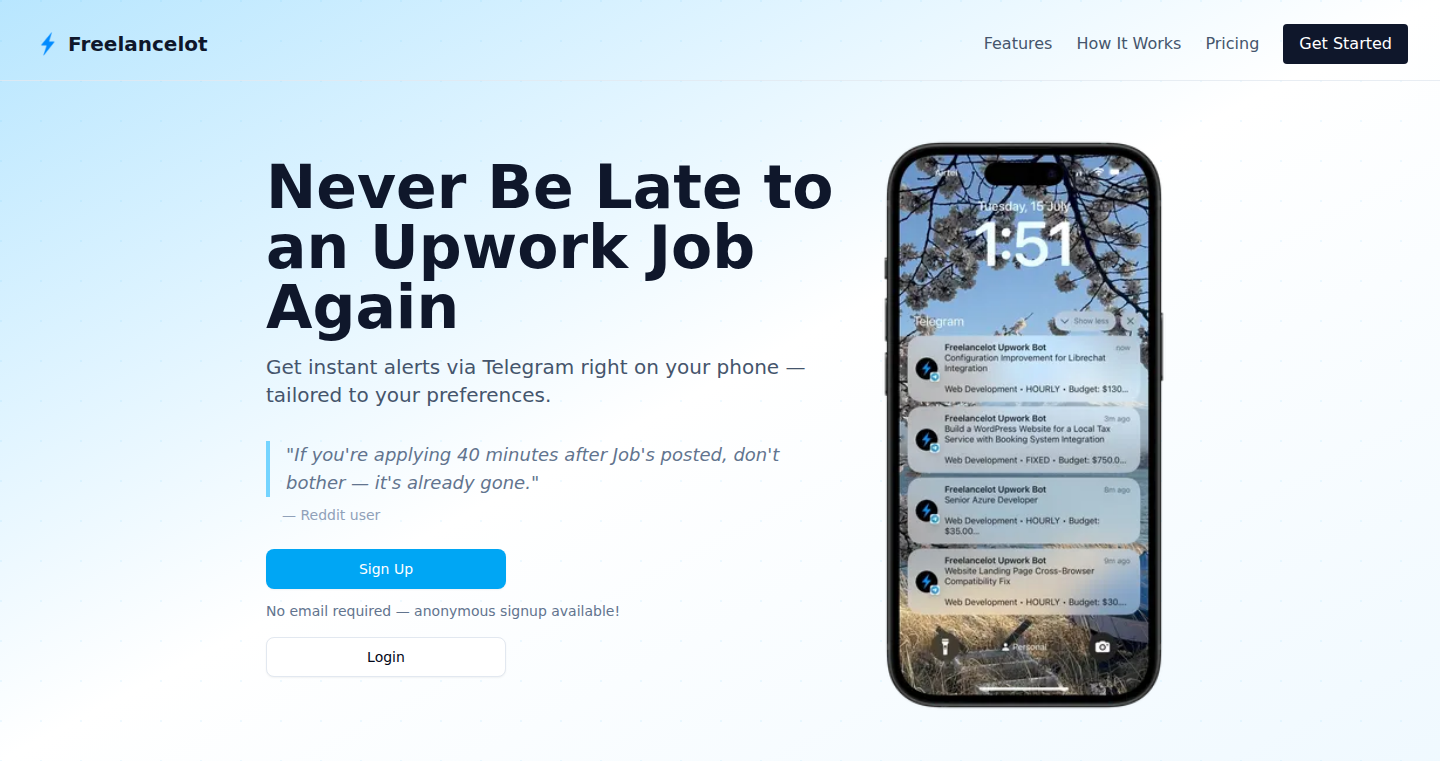
Author
pawannitj
Description
This project is a Telegram bot designed to instantly notify users of new job postings on Upwork that match their specified criteria. It addresses the problem of competitive freelancing on platforms like Upwork by providing real-time job alerts, giving users a competitive edge. The technical innovation lies in its ability to scrape Upwork's website, filter job postings based on user-defined parameters, and deliver instant notifications through Telegram. This eliminates the need for constant manual searching and allows freelancers to quickly apply for relevant jobs.
Popularity
Points 3
Comments 2
What is this product?
This is a Telegram bot that acts as a real-time job search agent for Upwork. It constantly monitors Upwork for new job postings. When a new job matches the user’s defined criteria (e.g., skills, budget, job type), the bot immediately sends an alert via Telegram. This is achieved through web scraping, where the bot programmatically retrieves data from Upwork, and filtering, where the data is processed to match user preferences. So this is like having a personal assistant that keeps you updated on the latest job opportunities.
How to use it?
Users can interact with the bot via Telegram. They can set up filters based on their skills, desired budget, and job type. The bot then continuously monitors Upwork and sends alerts when new matching jobs are posted. Users will receive a notification with job details, and they can then quickly navigate to the Upwork posting to apply. This is very useful for freelancers and those seeking gigs.
Product Core Function
· Real-time Job Monitoring: The bot continuously scrapes Upwork, looking for new job postings. This ensures that users are notified as soon as a relevant job is available. This helps users to be the first to see and apply for a new gig, which is especially useful in a competitive market.
· Customizable Filtering: Users can define specific criteria (e.g., skills, budget, job type) to filter job postings. This reduces information overload and ensures that users only receive notifications about jobs that are relevant to their interests. This saves time and allows users to focus on the best job opportunities.
· Instant Telegram Alerts: The bot delivers job alerts instantly through Telegram. This provides immediate notifications and allows users to quickly access job details and apply. Instant alerts mean you're never late to the party – you can instantly see and apply to a new job.
Product Usage Case
· Freelance Developer: A developer who specializes in Python can set up filters for Python-related jobs. The bot will notify them immediately when such jobs are posted, allowing them to apply quickly and increase their chances of landing projects. This helps secure more projects and builds up a successful freelance career.
· Content Writer: A content writer specializing in technical writing can filter jobs by industry and type, such as blog posts. The bot will alert them of new opportunities, helping them find and get more jobs. This helps you focus on the right job opportunities without wasting time searching manually.
· Virtual Assistant: A virtual assistant can define alerts according to the type of tasks and industries they support, quickly getting notifications of new job postings. This way, virtual assistants don't miss any opportunity to grow their customer base.
18
Bskysrch - Advanced Bluesky Search Engine
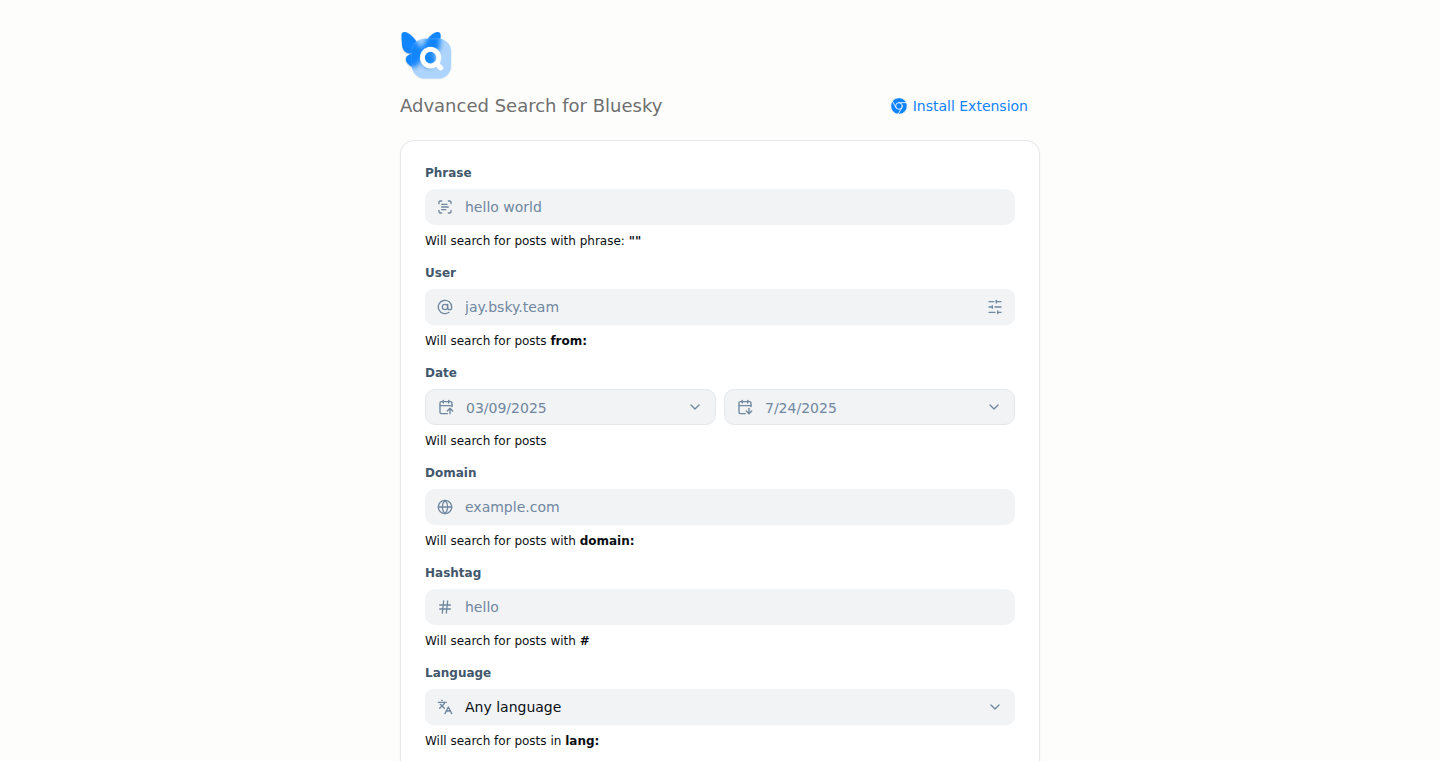
Author
nklswbr
Description
Bskysrch is a custom search engine specifically designed for the Bluesky social media platform. The core innovation lies in providing advanced search functionalities missing from the platform's native search. It allows users to filter posts and profiles based on keywords, usernames (handles), time ranges, and other search operators, offering a more powerful and refined way to find information. This directly addresses the limitations of the basic search functionality and empowers users to explore and discover content on Bluesky more effectively.
Popularity
Points 5
Comments 0
What is this product?
Bskysrch is essentially a specialized search tool built for Bluesky. It goes beyond the simple keyword search available on the platform, allowing for more sophisticated queries. Think of it as Google Search, but specifically for Bluesky and with options tailored to the platform’s data. The innovation comes from building a search engine that understands and indexes the data structure of Bluesky, enabling complex filtering and search operators. This means you can find exactly what you're looking for, quickly and efficiently, instead of sifting through irrelevant results.
How to use it?
Developers can use Bskysrch by integrating it into their own Bluesky-related applications or extensions. For instance, a developer could create a browser extension that utilizes Bskysrch to provide enhanced search capabilities directly within the Bluesky interface. Users can interact with it through a web interface or through APIs, where they can input their search queries and receive targeted results. So, if you're a developer building tools for Bluesky, you could use Bskysrch to enhance the search experience for your users. This could mean a more powerful way to find specific information for news aggregators, analytics tools, or even automated content discovery systems.
Product Core Function
· Keyword Search with Filtering: Allows users to search for posts and profiles using specific keywords, similar to a standard search engine, but with the added ability to filter these results based on various criteria. This is valuable because it helps users narrow down their search and find precisely the content they need. So, if you’re looking for a discussion about a specific technology, you can filter out irrelevant results.
· Handle-Based Search: Enables users to search by Bluesky usernames (handles), which is extremely useful for finding content from specific individuals or accounts. This is valuable for following specific creators or researchers on the platform. So, if you are researching a specific creator, you can quickly see all of their content.
· Time-Based Filtering: Provides the ability to filter search results by time ranges, allowing users to find posts or profiles within a specified timeframe. This is valuable for tracking trends, historical data, or following up on a specific news event. So, if you want to see what people were saying about a specific topic a week ago, you can easily find it.
· Advanced Search Operators: Incorporates more complex search operators, allowing for more refined and specific search queries. This goes beyond simple keyword matching and allows for precise information retrieval. So, if you need to exclude a specific keyword, or include more conditions in your search, you can do that.
· User-friendly interface and/or API: Bskysrch will probably offer an intuitive user interface for searching. In addition, it is designed to facilitate developers to integrate the engine into other projects via API. This feature is very valuable, especially for those who want to develop other apps to extract information on Bluesky.
Product Usage Case
· News Aggregation: A news aggregator can use Bskysrch to search for and curate relevant news stories and discussions on Bluesky, providing users with a focused and up-to-date feed of information. This solves the problem of information overload by filtering the news. If you have a news app, you can easily find news from Bluesky.
· Research Tool: Researchers can use Bskysrch to search for specific topics and discussions, analyze public sentiment, and gather data for their studies. This is valuable because it can help the researchers gain more information easily on Bluesky. So, if you are doing market research, you can collect information on Bluesky easily.
· Social Media Monitoring: Businesses and marketers can use Bskysrch to monitor brand mentions, track product feedback, and analyze customer sentiment on Bluesky. This helps them understand how their brand is perceived and adjust their strategies accordingly. So, if you are running a marketing campaign, you can collect the user's comments on Bluesky easily.
· Content Discovery: Developers can integrate Bskysrch into their Bluesky-related tools to help users discover interesting content, accounts, and discussions based on their interests and preferences. If you are creating an information app, you can let your users discover interesting content on Bluesky.
19
Geo Calculation Toolkit API
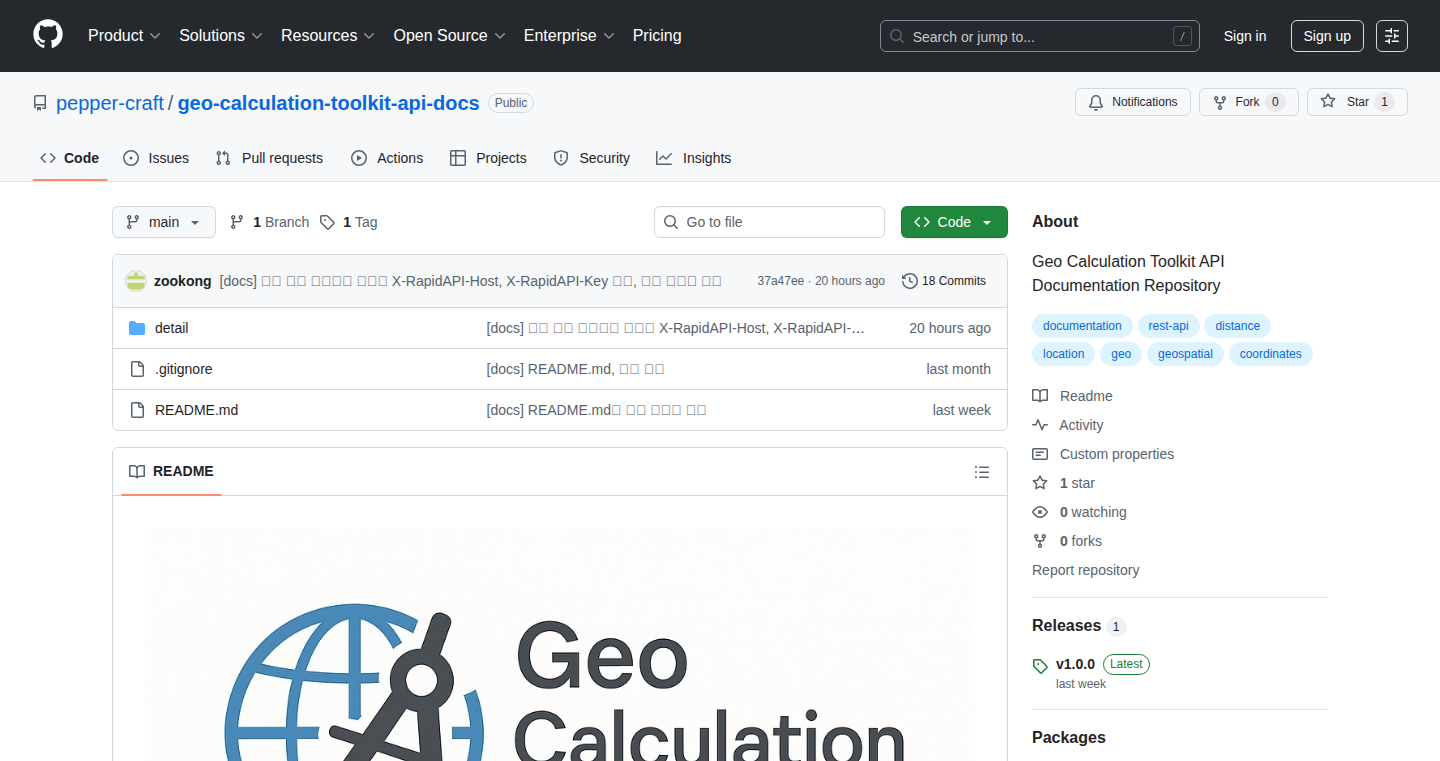
Author
pepper40
Description
This project is a lightweight REST API designed for geospatial calculations. It allows developers to perform common operations like determining distances, checking if a point is inside a shape, and other spatial analyses using coordinates and what the developer calls 'Geo Objects' (shapes like polygons, circles, etc.). The innovation lies in its focus on lightweight, real-time calculations, making it suitable for applications needing quick responses related to location data. So, this helps developers easily incorporate location-based features into their applications without needing to handle large GIS datasets.
Popularity
Points 3
Comments 2
What is this product?
This is an API (Application Programming Interface) that provides a set of tools for performing calculations related to geographic locations. Instead of complex Geographic Information System (GIS) software, it focuses on providing quick, easy-to-use functions for common geospatial tasks. It takes coordinates (like latitude and longitude) and 'Geo Objects' (shapes defined by coordinates) as input, and returns results like distance, area, and whether a point is inside a specific shape. The innovation is the API's simplicity and its focus on real-time, lightweight calculations, targeting applications where speed and ease of integration are crucial. So, if you need to build something that uses location data but don't want the hassle of a full GIS system, this is for you.
How to use it?
Developers can use this API by making simple HTTP requests to specific endpoints (URLs). They send the necessary data (coordinates, shapes) in the request, and the API returns the calculated results in a structured format (like JSON). To test the API, developers can use tools like Postman or curl, including a specific API key in the request header for authentication. This API is designed to be easily integrated into various applications, such as mobile apps, web applications, and backend systems. So, you can easily add location-based features to your apps, like finding the nearest store, checking if a user is within a certain area, or showing the distance between two points.
Product Core Function
· Distance Calculation: Calculates the distance between two sets of coordinates. This is fundamental for any application needing to determine proximity. So, it helps users quickly find the distance between two locations, which is useful for travel planning, delivery services, and location-based games.
· Point-in-Shape Check: Determines whether a given point falls inside a defined shape (polygon, circle, etc.). This is essential for applications that need to define boundaries or geographic areas. So, this enables developers to easily determine if a user is inside a defined area, which is helpful for geofencing, location-based notifications, and targeted advertising.
· Area Calculation: Computes the area of a Geo Object. This helps in understanding the size of a shape or geographic area. So, this is valuable for applications like land surveying, urban planning, and mapping applications where knowing the area of a specific region is important.
· Geospatial Object Creation: Allows the creation and manipulation of Geo Objects like circles, polygons, and polylines. This simplifies the process of working with spatial data and setting up geographic models. So, it simplifies the creation of complex location-based models, which is useful for applications like mapping, GIS, and location-based services.
· Real-time Calculation: The API is designed for speed and responsiveness, making it ideal for real-time applications. So, it provides the ability to get instant results on the location data, for example in a mobile application or a real-time tracking system.
Product Usage Case
· Delivery Service: A food delivery app uses the API to calculate the distance between the customer and the restaurant, and to determine the estimated time of arrival (ETA). The point-in-shape check is used to determine if a user is in the delivery zone, so the app can show the services to the user. So, developers can quickly calculate distances and set up zones.
· Fitness Tracking App: A fitness tracking app utilizes the API to calculate the distance and area covered by a user's run. The point-in-shape feature allows the app to verify a user's location in a certain area. So, the app provides more accurate tracking data, and location data.
· Location-Based Game: A mobile game uses the API to determine if a player is within a certain area, and to calculate the distance to nearby game objects. This provides instant feedback on a player's position, and interactive experience. So, game developers can build more dynamic gameplay mechanics without large GIS system overhead.
· Real Estate Platform: A real estate platform utilizes the API to calculate the area of a property, and the distance to nearby amenities such as schools and parks. This offers users precise location data and allows them to quickly visualize spatial relationships. So, it simplifies the display of location based amenities.
20
K-58: An AI-Powered Story Game

Author
tschillaci
Description
K-58 is a story-driven game where you interact with an AI character named Alex. The game uses multiple AI agents to manage Alex's memory, intimacy, and achievements. This allows for dynamic conversations and a branching narrative, making each interaction unique. The core innovation lies in the real-time AI agent feedback, allowing players to see how the AI "thinks" and influences Alex's responses. It tackles the challenge of creating engaging AI characters in games and pushes the boundaries of interactive storytelling.
Popularity
Points 3
Comments 2
What is this product?
K-58 is a game where you chat with an AI character named Alex. Alex isn't just a script; he's powered by several AI "agents" that have their own responsibilities. One agent remembers what you talk about, another handles how close you are to Alex, and another tracks your achievements in the game. These agents work together to make the conversations feel more realistic and keep the story evolving. So, you are seeing the AI's internal workings in action. This is a big deal because it’s like peeking behind the scenes of how AI creates a story.
How to use it?
You can play K-58 by going to the game and starting a conversation with Alex. You type what you want to say, and Alex responds. The magic happens behind the scenes where the AI agents are analyzing your words and adjusting their responses accordingly. This means you have to use your typing skills, but you can see the game at work behind the scenes (press F1).
Product Core Function
· AI-Driven Dialogue: The core feature is Alex's ability to have unique conversations with the player, driven by AI. This includes remembering past interactions, adapting to the player’s behavior, and tailoring the story based on progress. This is valuable for creating more dynamic and replayable game experiences, making each playthrough unique and customized.
· Real-Time Agent Feedback: Players can see the AI agents "thinking" in real-time. This means you can watch the agents process your words and see how they affect Alex's response. This is useful to see how AI engines work behind the scene and the impact of each instruction.
· Achievement System: The game tracks your achievements and unlocks new lore based on your conversations with Alex. This provides a sense of progress and encourages players to explore different dialogue options. This is valuable for promoting player engagement and prolonging playtime. It creates more incentive to interact and learn.
· Intimacy Agent: The game uses an intimacy agent to gauge how close the player and Alex are. This affects the dialogue and the story. This is valuable because it brings a personal touch to AI, makes them feel more relatable and encourages the user to become more interested in them.
Product Usage Case
· Interactive Fiction Development: Game developers can use the underlying AI framework to create similar interactive story games with different characters and settings. This opens up possibilities for personalized stories.
· AI Chatbot Training: Developers can use the AI framework to train conversational AI for different purposes, like customer service or virtual assistants. The AI can be trained to do specific instructions, and this method helps in its performance.
· Narrative Experimentation: Writers and storytellers can explore the potential of AI in creating interactive narratives, building dynamic plots and character interactions. The tool can give them different responses in their characters to allow for various possible plots, and character development.
21
TIMRUN: Transformer-based Intelligent Workflow Runtime
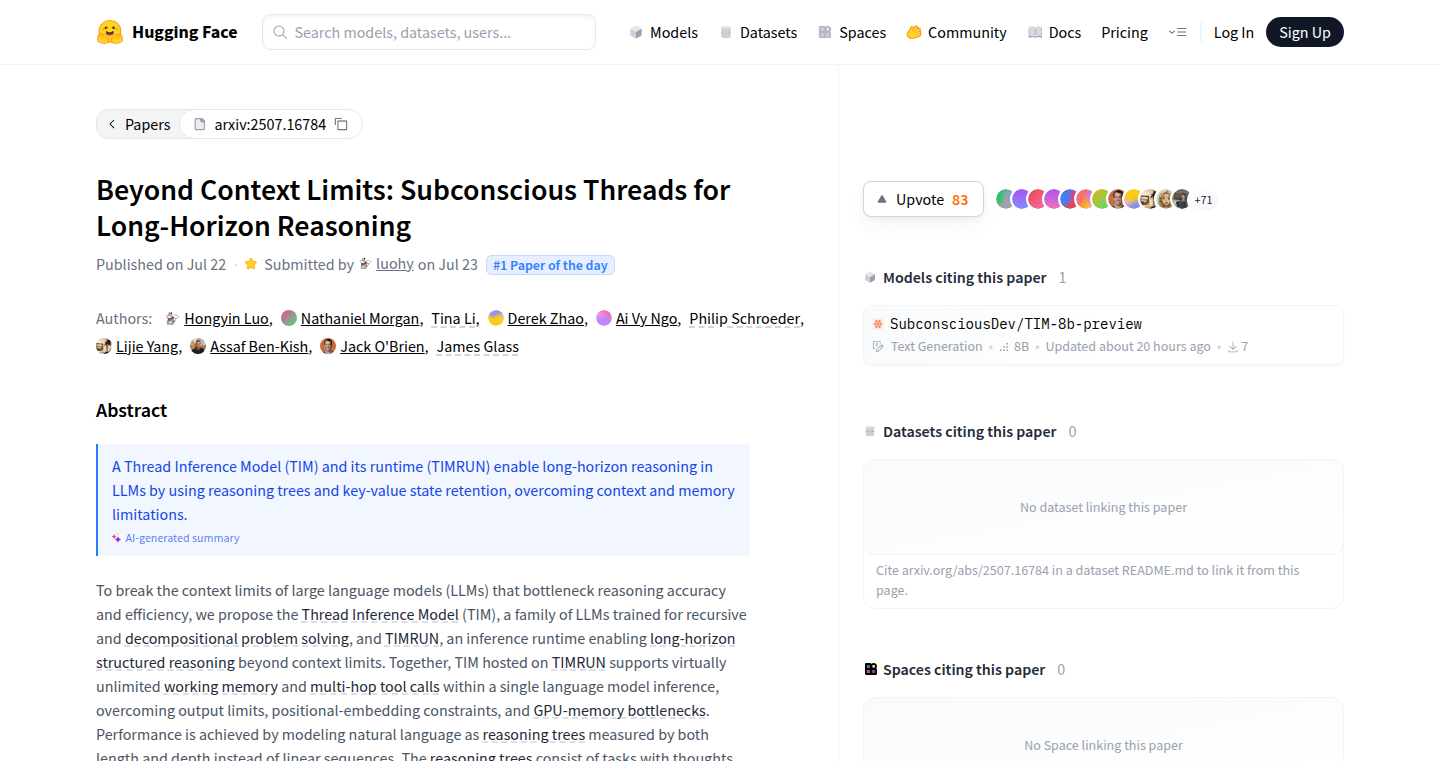
Author
hyluo
Description
TIMRUN is a clever system that uses a special type of AI model called a Transformer to understand and execute complex tasks within a single run. It's like giving a chatbot super-powered reasoning abilities. The key innovation is its ability to handle long and complicated reasoning processes efficiently by selectively focusing on the most important information. This solves the problem of AI 'forgetting' or becoming inefficient when dealing with lengthy instructions or multiple steps.
Popularity
Points 4
Comments 1
What is this product?
TIMRUN is built around the Thread Inference Model (TIM), which is based on the powerful Transformer architecture. Think of a Transformer as a very smart reader that can understand the relationships between different parts of a sentence or, in this case, a task. TIMRUN then uses a special runtime environment to execute the reasoning process. The cool part is that it can 'prune' or discard irrelevant information during the process, allowing it to work on very long and complex tasks without slowing down. So, it’s like having a super-focused, efficient AI assistant. So this is useful because it allows you to build more complex AI applications that can handle intricate workflows, reducing the need for multiple API calls or separate steps. This simplifies development and improves performance.
How to use it?
Developers can use TIMRUN by interacting with an API. This means they can integrate it into their own applications, essentially giving their programs the ability to reason and solve complex problems. For example, you could use it to build a smart assistant that can plan trips, summarize long documents, or automate complex tasks in a series of steps. You can think of it as an intelligent engine that powers other applications. This means developers can build smarter, more responsive applications without needing to rewrite existing code or build complicated logic from scratch.
Product Core Function
· Long-Horizon Reasoning: TIMRUN can handle multi-step tasks and complex workflows, which is something many AI systems struggle with. This is useful because it allows applications to perform more comprehensive tasks, like planning a vacation from start to finish, rather than just booking a flight.
· Context Engineering: TIMRUN understands and uses context effectively, which is critical for intelligent decision-making. This is useful because the AI is better at understanding your needs and making informed decisions, leading to a more personalized and accurate response.
· Context Pruning: The system efficiently manages large amounts of information by focusing only on the most relevant details, improving the efficiency of the reasoning process. This is useful because it prevents the AI from getting bogged down in too much information, leading to faster processing times and better performance.
· Intelligent Workflow Generation: TIMRUN can generate and execute complex workflows, meaning it can take a single instruction and break it down into multiple steps automatically. This is useful because it allows you to automate complex tasks with simple instructions.
Product Usage Case
· Smart Assistants: Integrate TIMRUN into a personal assistant to allow it to plan a complete itinerary, from booking flights and hotels to suggesting local attractions. So this is useful because it reduces the amount of input needed from the user; a single command initiates a complex workflow.
· Document Summarization: Feed a very long document into TIMRUN and ask it to provide a concise summary. So this is useful because it saves you time and helps you grasp the key information quickly without needing to read the whole document.
· Automated Task Management: Use TIMRUN to automate complex tasks like data analysis, where the model can automatically select the necessary tools, process the data, and generate reports. So this is useful because it streamlines your workflow and frees you to focus on higher-level decision-making.
22
Kafka: The AI Employee - Structured Planning for Autonomous Tasks
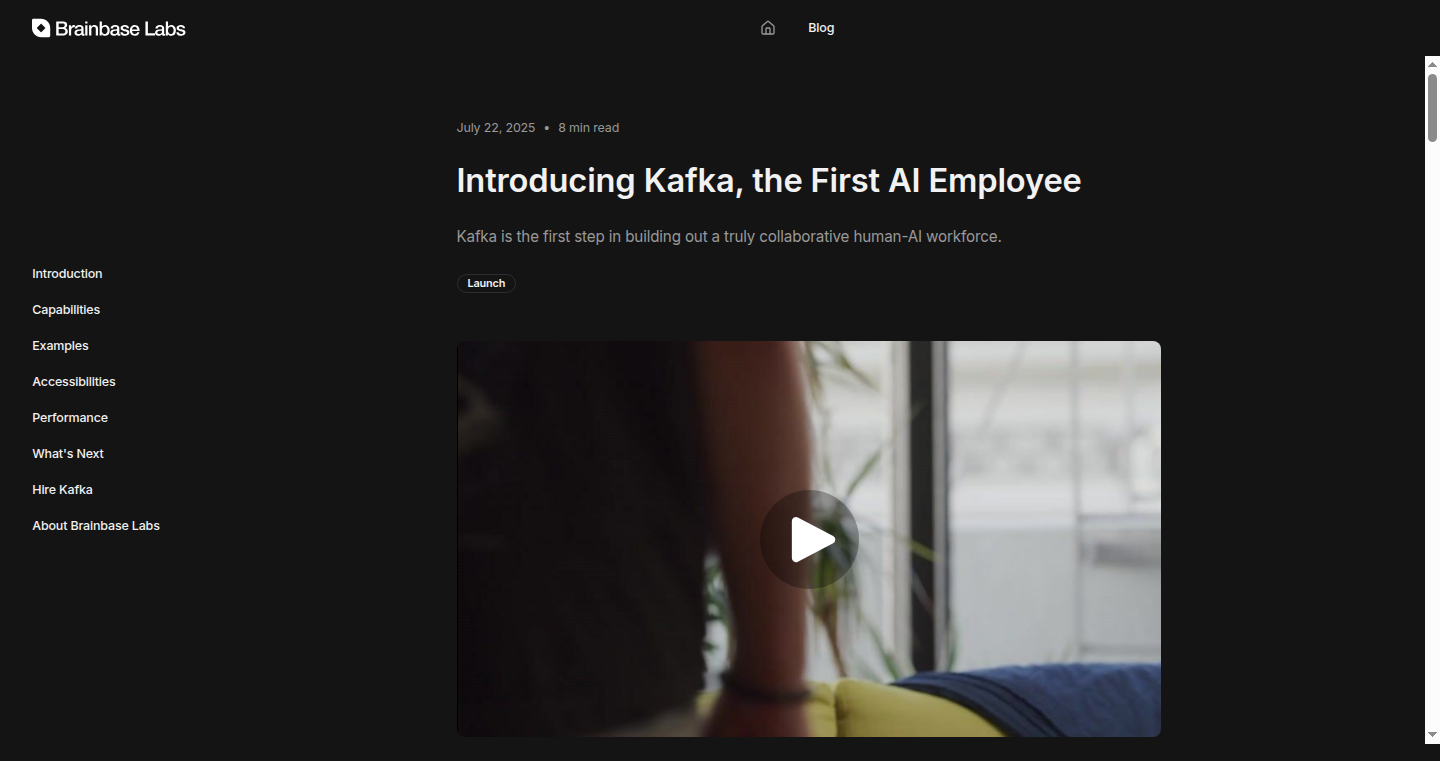
Author
egrigokhan
Description
Kafka is an AI agent designed to function as a virtual employee, equipped with its own communication channels (email, phone, Slack) and a dedicated computer. The core innovation lies in its "structured planning" algorithm, which allows Kafka to perform complex, long-term tasks without losing focus or generating incorrect information (hallucinating). This improves performance on benchmarks like GAIA, bringing AI closer to human-level problem-solving. Essentially, it’s an AI that can act like a regular employee, handling tasks and projects for you.
Popularity
Points 2
Comments 3
What is this product?
Kafka is an AI that acts as a virtual employee. The secret sauce is its "structured planning" approach. Think of it as a highly organized and focused way for the AI to plan and execute tasks. Instead of getting easily confused or going off track, Kafka can break down complex projects into manageable steps, ensuring it stays on course and delivers results. This involves creating a new planning algorithm that helps long-term planning in AI without getting deviated. For example, it can push code to AWS, direct its own commercial using Veo3, and do actual production tasks on Upwork/Fiverr. So this means it can take on complex projects, making it more efficient.
How to use it?
You interact with Kafka like you would with a real employee. You can forward emails to it, call it, or tag it in Slack. This makes integration incredibly easy. Imagine you need to deploy a new software update. You can simply ask Kafka to do it, and it will handle the entire process, from writing the code to pushing it live. In short, you interact with Kafka using existing communication methods, offloading tasks effortlessly.
Product Core Function
· Autonomous Task Execution: Kafka can independently perform tasks like code deployment, content creation, and project management. This frees up developers from repetitive or time-consuming activities. So this means it reduces manual workload.
· Structured Planning: The core algorithm enables long-term planning and problem-solving. It helps Kafka stay focused and execute tasks accurately, even with complex projects. So this means it ensures higher accuracy for task performance.
· Integration with Existing Tools: Kafka works seamlessly with existing communication and development tools such as email, Slack, and AWS. This makes it easy to integrate into existing workflows. So this means it minimizes the learning curve and the adoption friction.
· Performance on GAIA Benchmark: The high score on the GAIA benchmark (77.2%) demonstrates its ability to solve complex, real-world problems, getting closer to human performance (87%). So this means it makes AI’s ability closer to human-level performance.
Product Usage Case
· Software Deployment: A developer needs to release a new version of their application. They could forward an email with instructions to Kafka. Kafka would then access the code, perform the deployment, and notify the developer of the completed action. So this means it automates the deployment process, saving time and effort.
· Marketing Content Generation: A marketing team requires a promotional video. Kafka could be tasked to manage all aspects of the video creation, from generating the script, using Veo3 to direct the commercial, to publishing it on social media. So this means it enables rapid content production.
· Freelance Task Management: A project manager needs to hire a freelancer to do specific work. Kafka can post job requests on Upwork/Fiverr, evaluate the applicants and manage the project's deliverables. So this means it streamlines outsourcing.
23
Apache Fluss: Columnar Streaming Storage for Real-Time Analytics
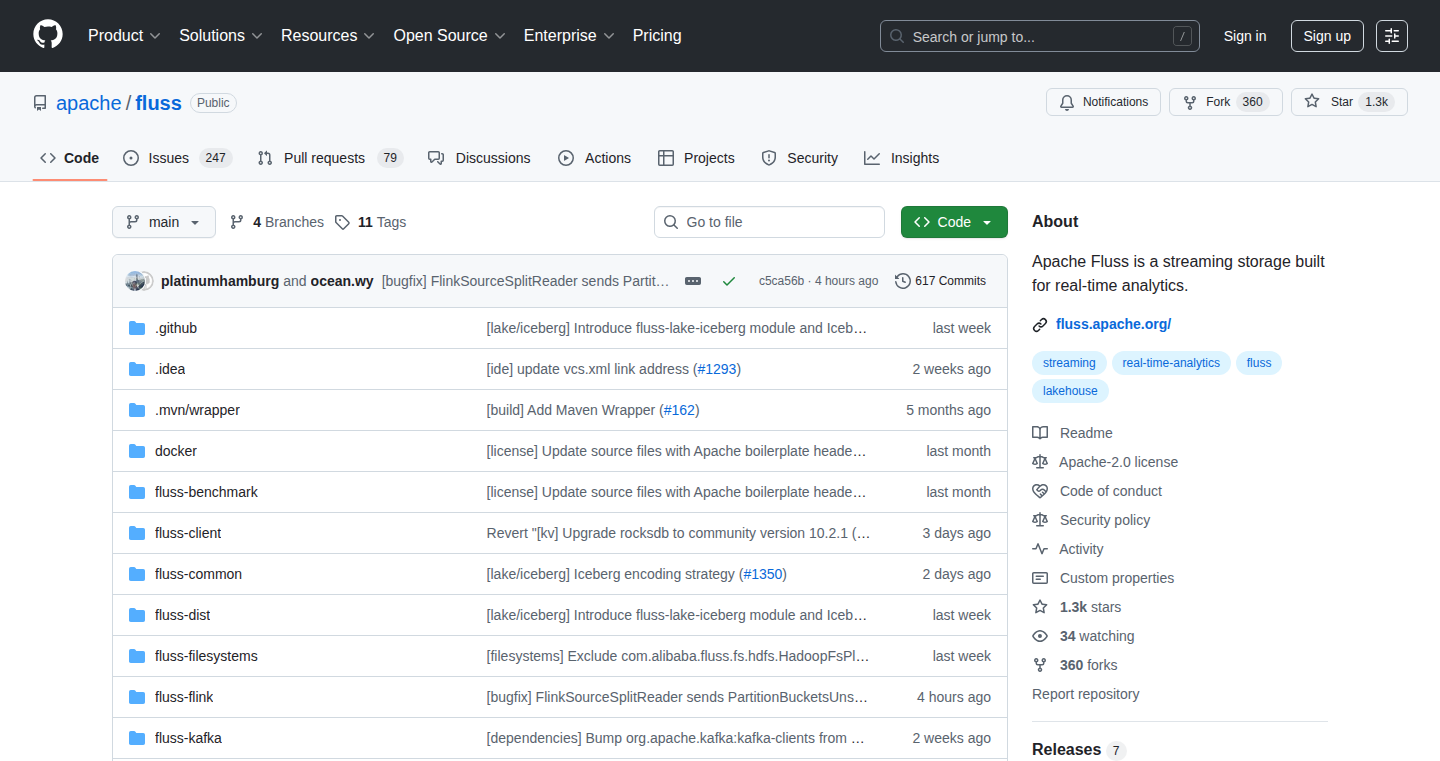
Author
michaelkoepf
Description
Apache Fluss is a groundbreaking streaming storage system designed specifically for real-time data analysis. Its key innovation lies in its columnar storage approach, which is a first in the streaming data world. This design tackles the inefficiencies and high costs associated with traditional row-oriented streaming storage and data lake architectures. It was initially developed within Alibaba and has since been open-sourced and entered the Apache Incubator, indicating its potential and community support. So, it helps you analyze your data in real-time more efficiently and cost-effectively.
Popularity
Points 5
Comments 0
What is this product?
Fluss is a new way of storing and processing streaming data. Instead of storing data row by row (like in traditional databases), it stores data column by column. This 'columnar' approach is optimized for real-time analytics because it allows the system to quickly access only the necessary data for a specific analysis. For instance, if you're only interested in sales numbers, Fluss can quickly retrieve the sales column without reading the entire dataset. The innovation is in applying this columnar storage to *streaming* data, which is data that arrives continuously, like website traffic or sensor readings. So, you can get insights from the data as it's being created.
How to use it?
Developers can integrate Fluss into their real-time data pipelines. This involves ingesting streaming data, storing it in Fluss, and then using it to perform real-time analytics. You would typically use APIs to write data into Fluss, and then query the stored data for analysis. Imagine you're building a system to monitor website performance. You could use Fluss to store incoming data about page views, user actions, and server response times, and then use Fluss's analytical capabilities to instantly identify performance bottlenecks. So, you can use it to build powerful real-time data analysis applications.
Product Core Function
· Columnar Storage: Stores data column by column, enabling efficient querying for analytical purposes. This means you can analyze specific data points faster, which is crucial for real-time insights. So, you can quickly find what you need in a massive amount of data.
· Streaming Data Ingestion: Designed to handle continuous data streams, making it ideal for real-time applications. This means it can ingest data as it arrives, without delay. So, you can react to changes in your data instantly.
· Real-Time Analytics: Enables real-time data analysis, providing immediate insights. This allows you to make decisions based on the most current information. So, you can make decisions faster and with better information.
· Cost and Efficiency Optimization: Aims to reduce the cost and improve the efficiency of data storage and processing compared to traditional systems. This allows for more economical data storage and more efficient processing. So, you can save money and get more done with the same resources.
Product Usage Case
· Real-time Fraud Detection: Fluss can be used to analyze financial transactions in real-time to identify fraudulent activities. By storing and analyzing transaction data as it streams in, businesses can immediately flag suspicious transactions and prevent financial losses. So, businesses can protect themselves from fraud more effectively.
· Website Performance Monitoring: Developers can use Fluss to monitor website performance metrics such as page load times and user activity. By storing and analyzing this data in real-time, developers can quickly identify and resolve performance bottlenecks, improving the user experience. So, developers can build a better website.
· IoT Sensor Data Analysis: Fluss can be used to analyze data from IoT sensors, such as temperature, pressure, and location data. By storing and analyzing this data in real-time, businesses can gain insights into equipment performance, environmental conditions, and more. So, businesses can improve operations and make data-driven decisions.
· Stock Market Analysis: Analyzing real-time stock prices and trading volumes to identify trends and make informed investment decisions. So, investors can make smarter trading decisions.
24
API Radar: Real-time Leaked API Key Detector
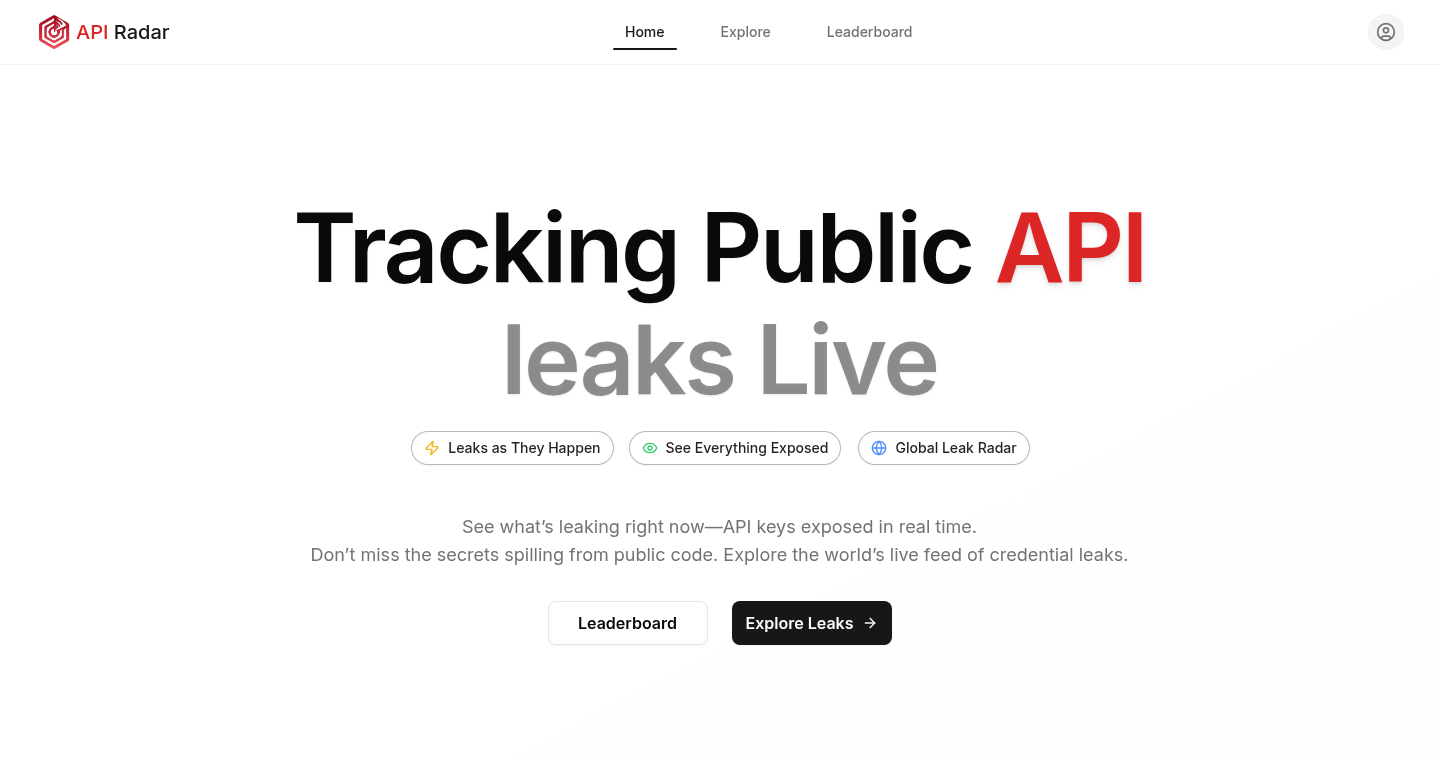
Author
zaim_abbasi
Description
API Radar is a tool that constantly monitors publicly available code on GitHub, looking for exposed API keys (like those from OpenAI, Google, and Claude). It identifies these leaks in real-time, providing context and filtering options. So, instead of hoping your keys are safe, you can proactively find and secure them. This solves the problem of accidental API key exposure, which can lead to unauthorized access and costly bills. This also highlights an innovative use of real-time code scanning and data analysis to maintain cybersecurity posture.
Popularity
Points 3
Comments 2
What is this product?
API Radar works by continuously scanning the commit history of public repositories on GitHub. Think of it as a super-powered keyword search that's always running. When a new commit is made, the tool analyzes the code for patterns that match API keys. If a key is found, the tool flags it, providing information about where it was found and other relevant data. This is innovative because it uses real-time code analysis to detect leaks as they happen, and it's a valuable tool for preventing security breaches. So this is valuable because it immediately alerts you to potential vulnerabilities.
How to use it?
Developers can't directly 'use' API Radar in the traditional sense. It's a monitoring tool that runs in the background. However, the information it provides is invaluable. Developers can use the tool's reports to identify and immediately revoke or rotate compromised API keys. You could integrate this into your DevOps pipeline by setting up alerts to be sent to your team when any new leaks are detected, allowing for automated responses. This way, it becomes a key part of your security workflow, which drastically improves security.
Product Core Function
· Real-time Scanning: Continuously monitors GitHub commits for API keys. Value: Ensures rapid detection of exposed keys, minimizing exposure time. Application: Identify and address leaks quickly to prevent abuse and financial damages.
· Contextual Metadata: Provides additional information about each leak, such as the repository name and commit details. Value: Offers context to quickly identify and resolve the issues, saving time. Application: Expedite the remediation process and better assess the risk of the exposure.
· Filtering: Allows filtering of results to focus on specific types of keys or repositories. Value: Enables users to prioritize alerts and focus on the most critical issues. Application: Streamline monitoring and security efforts.
· Scalable Architecture: The tool is designed to handle a large volume of data, effectively scanning thousands of repositories. Value: Ensures efficiency and supports continuous monitoring. Application: Maintaining a consistent and proactive security posture across the board.
· Ethical Discovery: It only scans public code, avoiding any private or confidential information. Value: Protects user privacy and ensures compliance with ethical standards. Application: Maintain security while respecting developer privacy
Product Usage Case
· A developer accidentally commits their OpenAI API key to a public repository. API Radar immediately detects it, sending an alert. The developer can then revoke the key before any malicious actors use it. This allows for quick reactions to security breaches.
· A company uses API Radar to monitor its open-source projects. The tool identifies an exposed Google Cloud API key in a testing environment. The team can then update the key and implement better security practices. This improves the security of the company's projects.
· A security researcher uses API Radar to identify patterns in leaked API keys. This helps them understand common mistakes developers make when securing their API keys. Using the data, researchers can develop tools that can prevent this type of error in the future. This contributes to a more secure internet for everyone.
25
Noey.ai: Automated Personal Website Generator
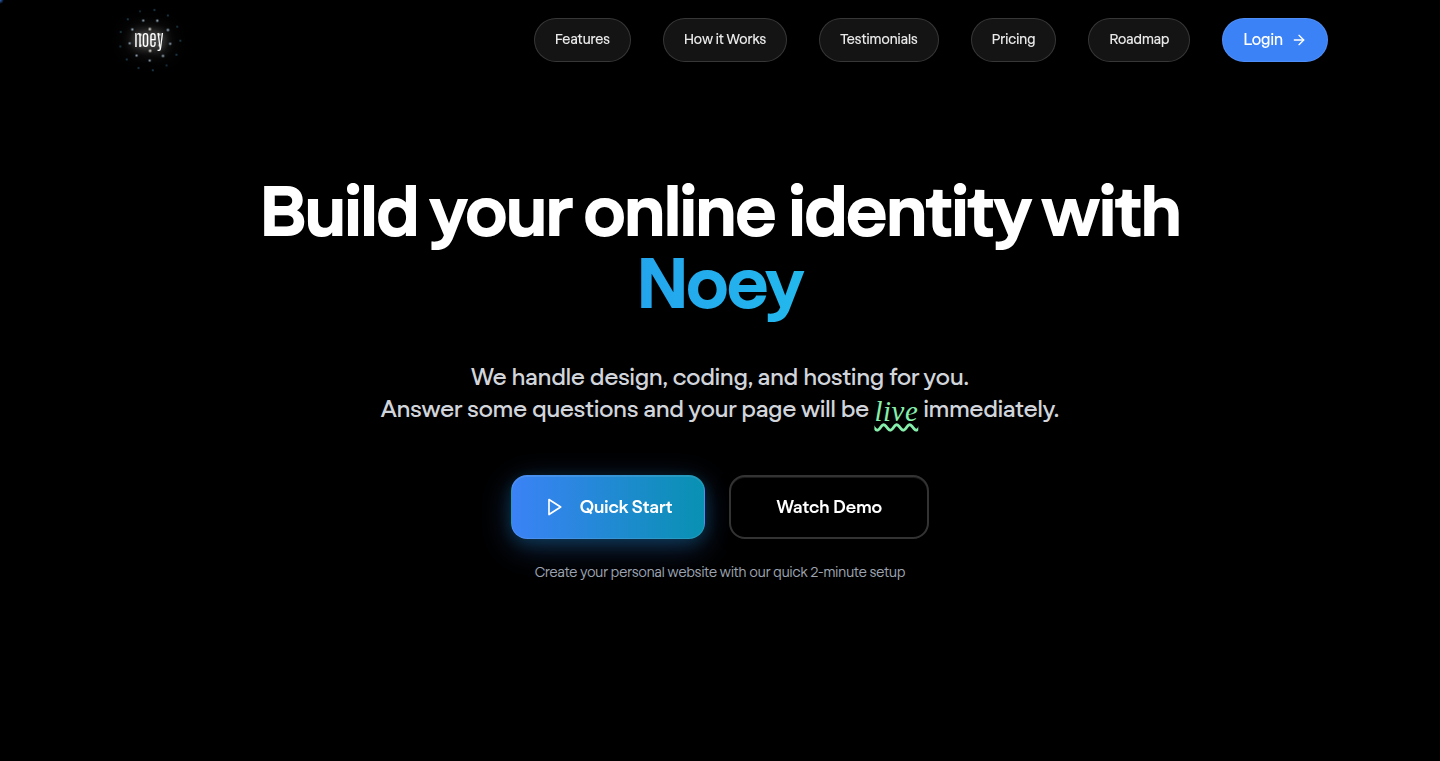
Author
_mad_eye_
Description
Noey.ai simplifies personal website creation. It eliminates the need for manual design, coding, and hosting by generating websites based on a simple questionnaire. This project addresses the common problem of the time and effort required to create a personal website, offering a quick and easy solution. It leverages automation to handle complex tasks, allowing users to have a functional website in minutes. So, this is like a website-in-a-box that anyone can use, saving hours of work.
Popularity
Points 3
Comments 1
What is this product?
Noey.ai uses Artificial Intelligence to generate personal websites. Users provide information via a questionnaire, and the platform automatically designs, codes, and hosts the website. It focuses on one-page websites initially, with plans to include more features. This project’s innovation lies in its automated approach, using AI to drastically reduce the time and technical skill required to build a website. So, it's a smart assistant for your online presence.
How to use it?
Developers can use Noey.ai by answering a few simple questions about their information. They don't need any coding or design skills. The generated website is then hosted, and users can share the link. This is useful for developers who want a quick online presence, a simple portfolio, or an easy-to-update resume. So, it's perfect for those who want to quickly get their name out there.
Product Core Function
· Automated Website Generation: The core function is to create a website from a questionnaire. This uses algorithms and potentially AI to create a design, write the code (HTML, CSS, JavaScript) and manage the hosting. The value here is huge time-saving and no need for coding skills. Application Scenario: Perfect for creating quick portfolios or temporary websites.
· Content Editing: Noey.ai offers text and image editing capabilities. This enables easy customization of the generated website's content. The value here is the ability to adapt the website's message and appearance to the individual's needs without knowing how to code. Application Scenario: Quickly updating a resume online or changing the call to action.
· Hosting: The service includes automatic hosting of the generated websites. This removes the need for users to find and manage their own hosting solutions. The value here is the convenience of having the website live and accessible with no setup. Application Scenario: Eliminates the technical barriers to getting online quickly.
Product Usage Case
· Quick Portfolio Site: A developer needs an online portfolio but has little time. They use Noey.ai to quickly build a single-page website showcasing their projects. The website is up and running in minutes, with minimal effort. This solves the problem of time spent designing and coding a portfolio. Application Scenario: For developers who want to showcase their work to potential clients.
· Personal Resume Page: A developer needs a web-based resume. They input their information into Noey.ai, generating a responsive and professional-looking resume page. This saves them the effort of manually coding an HTML resume or finding a template and customizing it. Application Scenario: To provide a professional representation of their skills and experience to recruiters and potential employers.
· Landing Page for a Side Project: A developer wants to promote a side project. They quickly build a landing page on Noey.ai, providing basic information about their project, images, and contact details. This solves the need for a temporary web presence to test an idea. Application Scenario: To quickly test the market for a new product or service.
26
Traceprompt: Tamper-Proof Logging for LLM Interactions
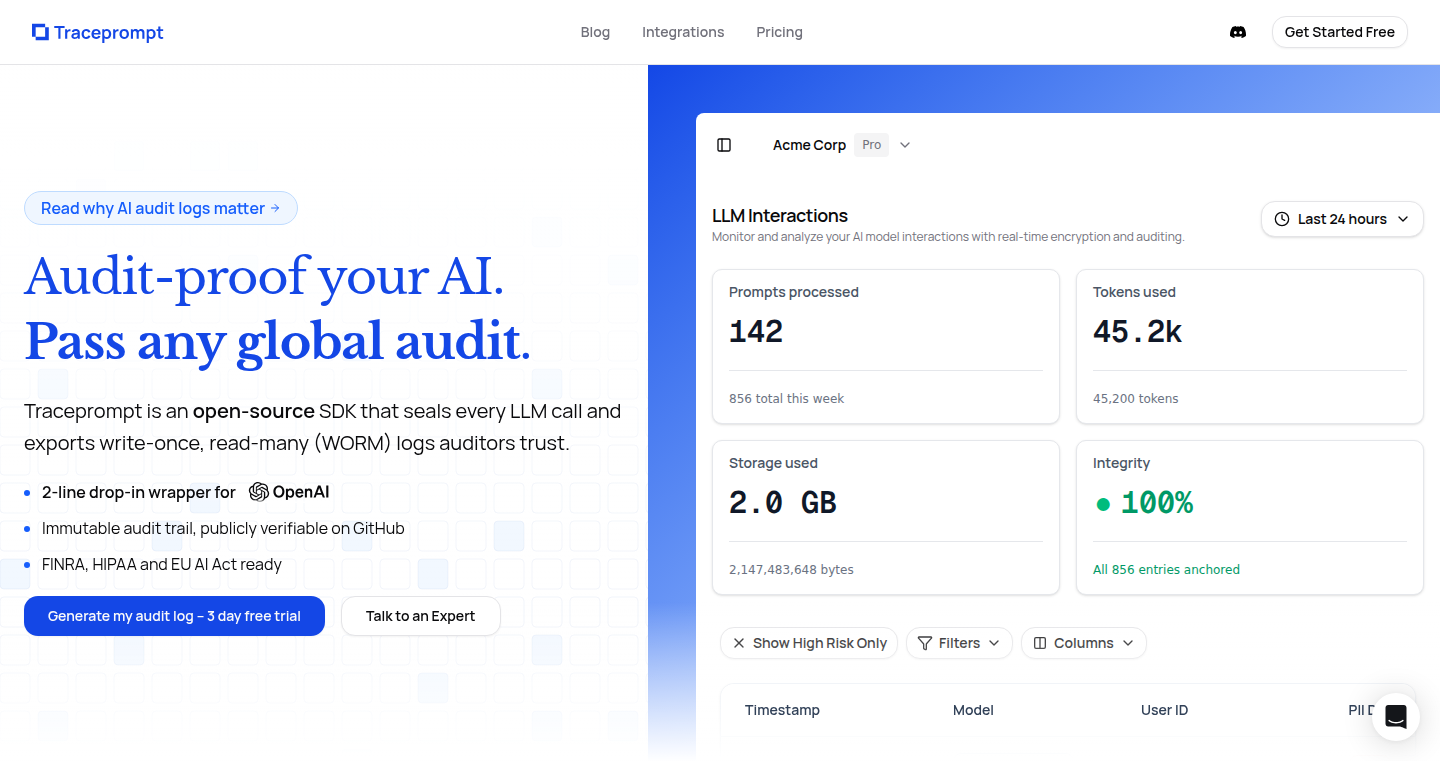
Author
paulmbw
Description
Traceprompt is an open-source SDK designed to create immutable, verifiable logs for interactions with Large Language Models (LLMs). It addresses the critical need for auditability and compliance in applications leveraging LLMs, particularly within regulated industries like finance and healthcare. It encrypts the prompts and responses, ensuring data privacy, and uses a hash-chain mechanism with a public anchor (GitHub) to guarantee the integrity of the logs. This prevents tampering and provides auditable evidence of LLM interactions, which is crucial for meeting regulatory requirements such as HIPAA and the upcoming EU AI Act. So it solves the problem of trust and compliance in AI applications.
Popularity
Points 3
Comments 1
What is this product?
Traceprompt works by wrapping API calls to LLMs (like OpenAI, Anthropic, and Gemini) and encrypting the prompts and responses before they leave your application. It employs 'envelope encryption' and allows you to bring your own keys (BYOK), keeping the encryption keys secure within your Key Management System (KMS) like AWS KMS. To ensure log integrity, it utilizes a 'hash-chain' where each log entry is linked to the previous one via a cryptographic hash. Every five minutes, a 'Merkle root' of the logs is published to GitHub, providing a public anchor to verify the log’s immutability. So what you get is a system that prevents anyone from changing or deleting the logs of LLM interactions.
How to use it?
Developers integrate Traceprompt into their applications that utilize LLMs. This involves wrapping their LLM API calls with Traceprompt’s SDK. Once integrated, all prompts and responses are automatically encrypted and logged. The logs are stored securely, and the integrity of the logs can be independently verified by auditors using the public anchor on GitHub. Developers can generate audit trails for AI interactions in applications. You can integrate it into a chatbot that approves loans or triage application that diagnoses medical issues. So you can prove to regulators and clients you followed the guidelines and protected sensitive data.
Product Core Function
· Prompt and Response Encryption: Traceprompt encrypts all data exchanged with the LLM, protecting the confidentiality of the information. This is vital for adhering to privacy regulations. So this helps prevent data leaks and safeguards user information.
· BYOK (Bring Your Own Key) Support: Developers can retain control over their encryption keys using their own KMS. This enhances security and allows them to comply with specific security policies. So this gives you full control over your data's protection.
· Tamper-Proof Logging: Traceprompt uses hash chaining and a public anchor (GitHub) to ensure the integrity of the logs. Any alteration to the logs can be detected, ensuring accountability. So it gives you confidence that the records are trustworthy.
· SDK for Multiple LLM Providers: The SDK supports major LLM providers like OpenAI, Anthropic, and Gemini, making it versatile. So you can use any LLM service provider you like.
· Compliance Support: Traceprompt helps developers meet the logging and auditability requirements of regulations such as HIPAA and the EU AI Act. So it makes it easier to be compliant with the laws.
· Open Source: It's an open-source SDK, allowing developers to inspect the code, contribute, and customize the solution to their specific needs. So you can ensure it fits your needs perfectly.
Product Usage Case
· Financial Chatbot: A bank uses a chatbot powered by an LLM to handle loan applications. Traceprompt is integrated to log all interactions between the chatbot and users, ensuring all conversations are recorded and encrypted, and preventing any tampering. This allows the bank to meet regulatory requirements for record-keeping and prove compliance during audits. So you are prepared for an audit, because the logs cannot be altered.
· Medical Diagnosis App: A medical application uses an LLM to assist in diagnosing health issues. Traceprompt is implemented to log all prompts and responses, and store it in a secure, verifiable manner. This helps the application maintain patient privacy, and ensures the integrity of the diagnostic process. So medical data will be secured.
· AI-powered Customer Service: A company uses an LLM for customer service interactions. Traceprompt ensures that every interaction is recorded, encrypted and tamper-proof. This creates an auditable trail of customer support. So it helps in identifying training data issues.
27
SQLite AI: Bringing AI Power to Your Local Databases
Author
marcobambini
Description
SQLite AI is an open-source project that transforms SQLite, a lightweight database, into a powerful AI hub. It introduces several modular extensions. SQLite-Vector allows for fast vector search directly within SQLite, ideal for tasks like finding similar items or understanding relationships in data. SQLite-AI integrates with language models to perform AI-assisted queries, summaries, and content generation directly inside the database. SQLite-JS enables JavaScript functions to be defined and run within SQLite, adding custom logic and local customization. SQLite-Sync facilitates local-first synchronization, allowing data to stay in sync across devices without requiring constant internet connection. The project's core innovation lies in seamlessly embedding AI capabilities within a familiar, widely-used database, making AI development accessible across various platforms and resource constraints. So this simplifies AI integration and local data processing.
Popularity
Points 4
Comments 0
What is this product?
SQLite AI provides a set of extensions to enhance SQLite with AI capabilities. At its core, it enables you to perform AI tasks directly within your local SQLite databases. For example, SQLite-Vector allows for vector search, which means you can quickly find similar data points based on their meaning or characteristics. SQLite-AI integrates with language models, letting you ask questions of your data, summarize text, or generate new content, all within the database. SQLite-JS enables you to customize and extend SQLite's functionality using JavaScript, giving developers more control over how their data is processed. SQLite-Sync keeps your data synchronized across different devices, even when offline. So this eliminates the need to move your data to external AI services and keeps your data processing local and fast.
How to use it?
Developers can incorporate SQLite AI by adding the project's extensions to their existing SQLite setup. For SQLite-Vector, developers can index vector embeddings (numerical representations of data) in SQLite and then search for similar items using efficient algorithms. For SQLite-AI, the extensions expose functions that allow you to send queries to language models (like asking a question or creating a summary). SQLite-JS can be used to implement custom logic, such as data validation or pre-processing, directly within the database. SQLite-Sync can handle data synchronization across devices. So, by integrating these extensions, developers can build AI-powered applications without relying on external services, making applications more efficient, private, and versatile.
Product Core Function
· SQLite-Vector: Allows fast vector search within SQLite. This enables developers to build applications that need to find similar items, such as search engines or recommendation systems. So this allows for more efficient and intelligent data retrieval.
· SQLite-AI: Integrates with language models to provide AI-assisted queries, summarization, and content generation within the database. It streamlines AI tasks by bringing AI directly to the data, instead of transferring the data to the AI. So this empowers developers to add AI-powered features such as smart data analysis or automated content creation directly into their applications.
· SQLite-JS: Enables developers to define and run JavaScript functions inside SQLite. This facilitates custom logic and edge scripting within the database, which is useful for local customization or implementing data processing pipelines. So this provides the flexibility to tailor database behavior to the specific needs of an application.
· SQLite-Sync: Provides lightweight local-first synchronization with cloud coordination. This allows data to stay in sync across various devices without the constant need for an internet connection, making the application more accessible and robust. So this ensures data consistency across all your devices, enhancing user experience.
Product Usage Case
· An e-commerce application that uses SQLite-Vector to provide product recommendations. It indexes product features into vectors and enables fast search for similar products based on user preferences. So this creates a more personalized shopping experience and increases sales.
· A mobile application for note-taking, using SQLite-AI to summarize long notes and generate summaries automatically. So this reduces the effort required to review large amounts of information.
· An IoT device that uses SQLite-JS to pre-process sensor data and filter out irrelevant information locally before uploading it to the cloud, saving bandwidth and improving efficiency. So this enhances data management and reduces costs.
· A local-first application that uses SQLite-Sync to keep user data synchronized across multiple devices. Users can access and modify data offline, and the application ensures that all changes are reflected across devices when a connection is available. So this improves the availability of data and ensures a seamless user experience.
28
Gitpatch: Git Push for Patches
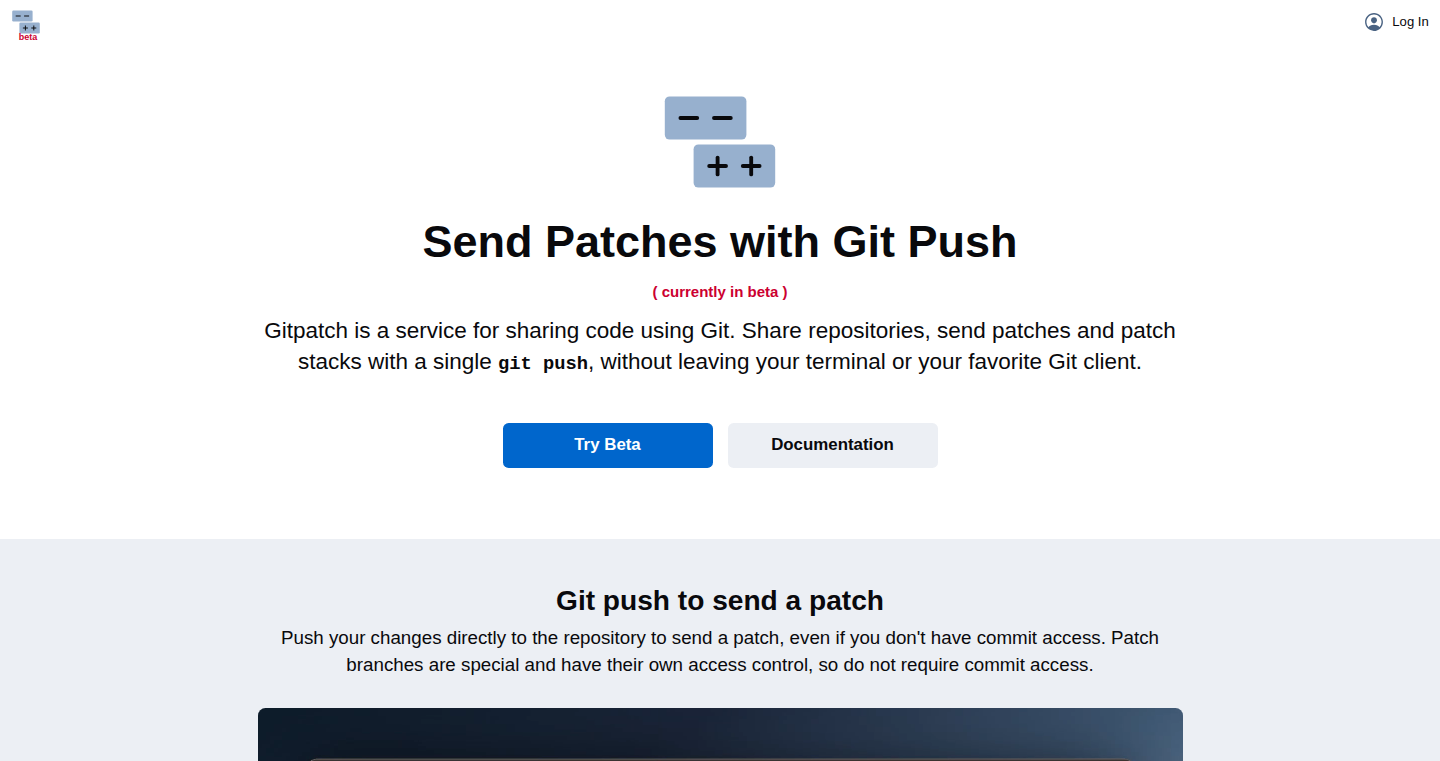
Author
shayief
Description
Gitpatch simplifies sending and applying code changes (patches) using the familiar 'git push' command. It addresses the limitations of existing Git platforms in supporting patch-based workflows, enabling developers to easily share, review, and integrate code modifications. Essentially, it's like using 'git push' to share your changes in a way that's easy to understand and apply. So this is useful for streamlined code sharing and collaboration.
Popularity
Points 4
Comments 0
What is this product?
Gitpatch extends the functionality of Git, allowing developers to send code changes as patches by simply pushing branches to a central repository. It provides a lightweight user interface for reviewing these patches and allows stacking multiple patches on top of each other. The core innovation lies in making the creation, sharing, and application of patches as easy as the standard Git workflow, eliminating the need to manually create and share patch files. So this is useful for those who want a simpler way to share code changes.
How to use it?
Developers can use Gitpatch by creating branches prefixed with 'patch/' (e.g., patch/fix-bug) containing their code changes. They then 'git push' these branches to the Gitpatch-enabled repository. Other developers can then apply the changes locally with a single command. The changes can be viewed via a provided UI, and patches can be stacked on top of each other for more complex changes. So this is useful for easier code sharing and collaboration within a team.
Product Core Function
· Pushing Patches: Allows developers to send code changes as patches using 'git push'. This simplifies the process of sharing changes compared to traditional methods like creating and sharing patch files. It’s like using git push, but for sharing code changes.
· Applying Patches: Enables developers to easily apply received patches locally with a single command. This streamlines the integration of changes into a developer's codebase. It’s useful because it makes incorporating other’s code much simpler.
· Lightweight UI for Review: Provides a user interface for reviewing patches before applying them, allowing developers to see what changes are included. This helps identify potential issues and increases the quality of code reviews. It's useful for making sure the code is correct before implementing it.
· Patch Stacking: Supports stacking multiple patches on top of each other. This makes it easy to manage complex changes that depend on each other. Helpful if changes have dependencies.
Product Usage Case
· Open Source Contribution: A developer working on an open-source project can use Gitpatch to share a fix for a bug. They create a 'patch' branch with the fix, push it, and other contributors can easily apply it. This speeds up contribution and collaboration.
· Code Review Process: In a team setting, developers can use Gitpatch to send and review changes. One developer creates a patch branch, pushes it, a reviewer can view the changes and give feedback, and after approval, the change can be applied. This creates a streamlined review process.
· Feature Development: A developer working on a new feature can create several patches for different parts of the feature. These patches can be stacked and sent to another developer for review or integration. This improves the organization of the changes being made.
29
Magic Canvas: Visual Context Engineering for AI-Powered App Development
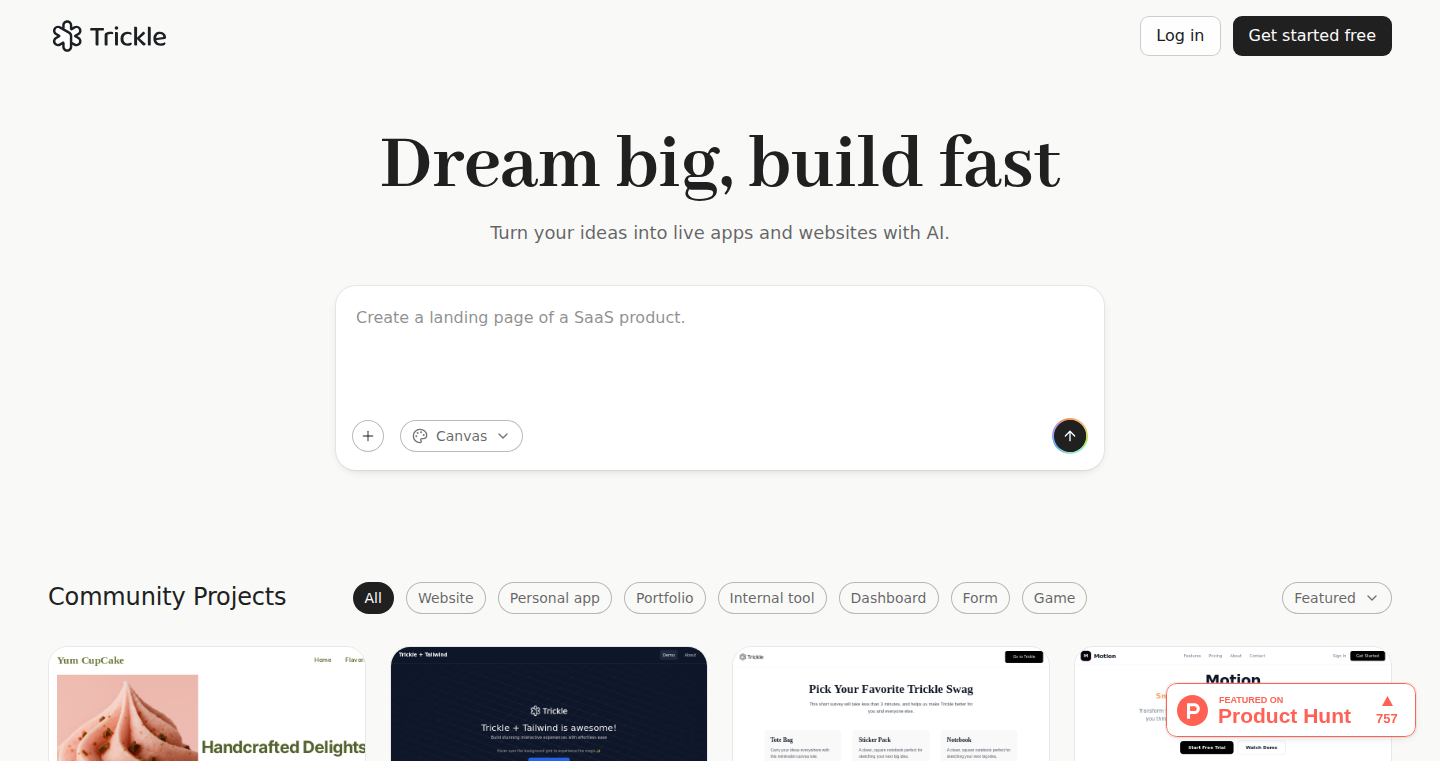
Author
jarodxuming
Description
Magic Canvas is a revolutionary approach to building applications with AI. Instead of relying on text-based prompts and iterative corrections, it provides a visual workspace where developers can directly manipulate the UI elements of their app. The AI agent observes these visual changes – like dragging buttons, resizing sections, or changing colors – and automatically generates the corresponding production-ready code. This drastically improves the AI's understanding of the developer's intent, resulting in more accurate and efficient code generation. So you will be able to build apps faster with this tool.
Popularity
Points 4
Comments 0
What is this product?
Magic Canvas is essentially a visual programming environment that leverages AI. The core idea is to provide the AI with context-rich visual information, unlike traditional text-based prompts. When you visually design the user interface, the AI 'sees' the layout, understands your design choices, and translates them into functional code. The innovation lies in the shift from 'telling' the AI what to do to 'showing' it, which significantly enhances the accuracy and speed of code generation. So you will be able to build apps faster and with more precision.
How to use it?
Developers can use Magic Canvas by designing their app's user interface directly within the visual canvas. They can drag and drop UI elements, resize components, and customize their appearance. As the developer makes these visual modifications, the AI agent continuously analyzes the changes and updates the corresponding code in real-time. This allows for rapid prototyping and iterative design. So you will be able to create your desired interface in the way you want it.
Product Core Function
· Visual UI Design: This allows developers to create their app's interface by dragging and dropping UI elements. This is a much more intuitive way to design an app, compared to writing code from scratch. It lets you quickly prototype and experiment with different layouts. So this helps you get started with creating your app in a visual way.
· AI-Powered Code Generation: The AI agent translates the visual design into actual code. This saves developers a lot of time and effort by automating the coding process. The AI understands the visual changes and generates code for the specific elements. So you can significantly reduce the time to build the app, focusing on the interface design.
· Real-time Code Updates: As the developer modifies the visual design, the corresponding code updates in real-time. This feedback loop allows for faster iteration and reduces the likelihood of errors. The AI agent continuously analyzes the visual changes and keeps the code synchronized. So you can preview your application's functionality as you design.
· Context Engineering: The visual context provides much more information to the AI, enabling it to generate more accurate and relevant code. This approach significantly improves the AI's understanding of the developer's intent, resulting in better results. So this method is more effective than text-based approaches.
Product Usage Case
· Rapid Prototyping for Web Applications: A developer can quickly create the initial design of a website, including navigation menus, forms, and content sections, by using the canvas. The AI agent then automatically generates the HTML, CSS, and JavaScript code. This is useful for startups that want to quickly validate an idea, enabling them to create a basic application that can be tested without all the coding. So you can test out ideas and make changes without having to code every little detail.
· Iterative Design and UI/UX Improvements: Designers and developers can use Magic Canvas to experiment with different UI layouts and design elements. By changing the color or the size of a button, and seeing the code updated instantly, the AI enables faster iterations and a much more effective design process. So it’s possible to rapidly experiment with different interface designs and see the results in real-time.
· Cross-Platform Application Development: Magic Canvas can be used to generate code for different platforms. A developer can design an app's interface and the AI could generate native code for iOS, Android, or other platforms. So you can generate your apps that run on different devices much faster.
30
Textrix: The Open-Source Publishing Editor
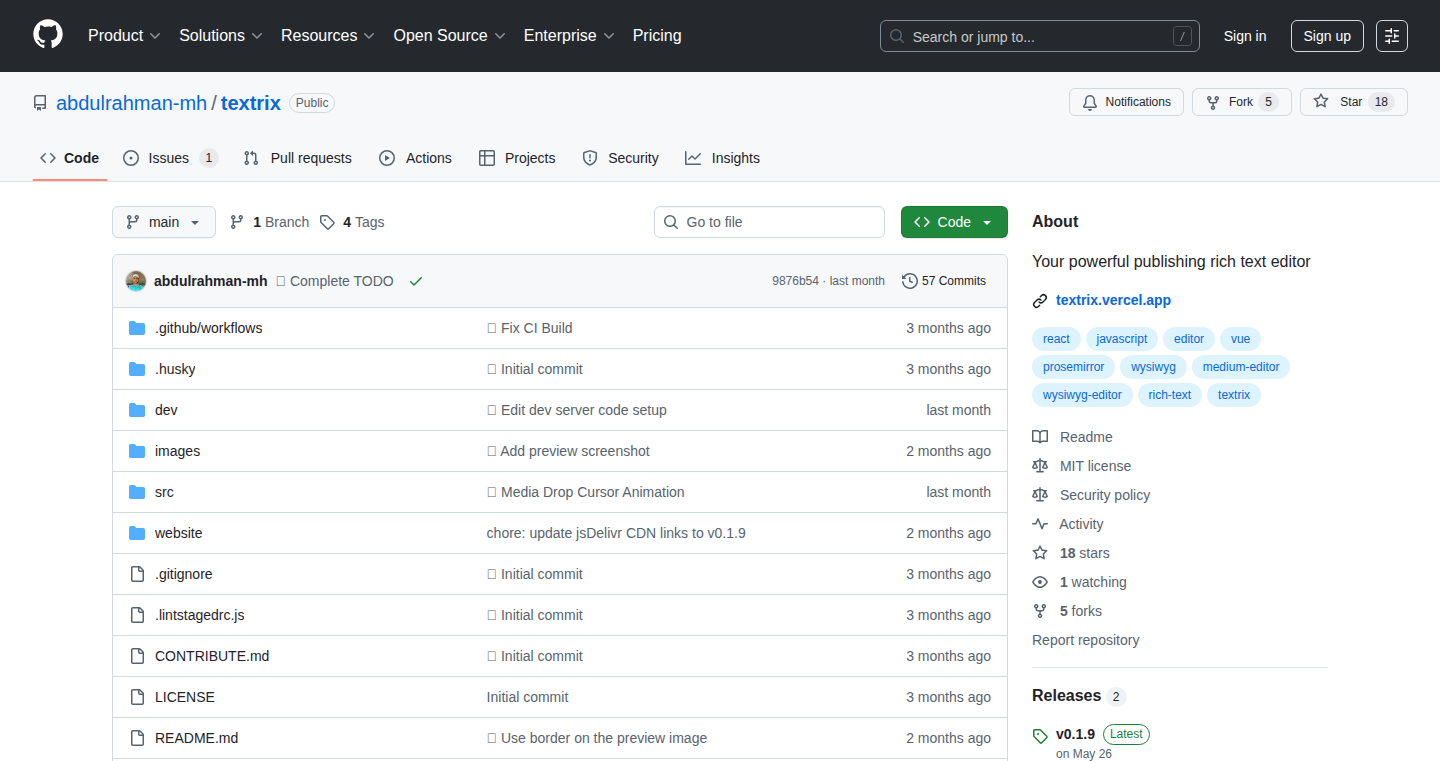
Author
abdulrahman-mh
Description
Textrix is an open-source, Medium.com-inspired editor designed for publishing platforms. The key technical innovation lies in its WYSIWYG (What You See Is What You Get) editing experience, allowing users to format text and embed media directly within the editor, reflecting the final presentation almost instantly. It overcomes the limitations of basic text editors and offers a more user-friendly and visually rich content creation process, simplifying complex publishing workflows and improving the authoring experience.
Popularity
Points 4
Comments 0
What is this product?
Textrix is essentially a website editor built using open-source technology. Its main technology is its real-time preview, making it easy to see how your text will look when it's published, just like you would on a website. It also lets you embed pictures, videos, and other media directly. The innovation lies in the seamless integration of editing and presentation, unlike traditional editors. The editing component is made using Javascript, HTML and CSS making it cross-platform and easily embeddable into existing platforms.
How to use it?
Developers can integrate Textrix into their own publishing platforms or content management systems (CMS). By incorporating a few lines of code, developers can replace rudimentary text input areas with a powerful, feature-rich editor. This simplifies content creation for their users, especially for bloggers, journalists, or anyone publishing online, allowing them to focus on content rather than formatting. The integration usually involves loading the necessary JavaScript libraries and using the editor's API to store and retrieve content.
Product Core Function
· WYSIWYG Editing: The ability to see how your content will look as you write it. This saves time and effort since you do not have to guess how it will be rendered on the final website. So this is useful because you can immediately format your text and see the results.
· Rich Text Formatting: Textrix supports a variety of formatting options such as bold, italics, headings, lists, and more. This allows for professional-looking content creation without the need for complex HTML or CSS knowledge. So this is useful for creating more visually appealing content.
· Media Embedding: The capability to embed images, videos, and other media directly into the text. This enriches the content and makes it more engaging for readers. So this is useful for adding visual aids to content.
· Customizable Interface: Developers can customize the editor's look and feel to match their platform's design. This ensures a consistent user experience. So this is useful for tailoring the editor to the existing brand of a website.
· Open Source and Extensible: As an open-source project, Textrix's code can be easily modified and extended, allowing developers to add custom features or integrate with other tools. So this is useful for developers who want full control over their editor's functionality.
Product Usage Case
· Blog Platforms: Integrate Textrix as the default editor for blog posts, offering writers a user-friendly interface for formatting and media embedding. This allows bloggers to create richer content with little technical skill.
· Content Management Systems (CMS): Replace the default text editor in CMS platforms with Textrix to improve the user experience and provide advanced formatting options for content creators. This will make the website more user friendly for clients.
· Online Documentation Tools: Use Textrix to create structured and visually appealing online documentation for software, with the ability to embed screenshots and videos. This will reduce documentation errors and time needed for training.
· E-commerce Product Descriptions: Allow e-commerce platform users to create detailed and visually engaging product descriptions by integrating Textrix's advanced editing capabilities. This allows the product pages to be more descriptive and professional.
31
Dual-Backend MLP: CPU & GPU Accelerated Neural Network
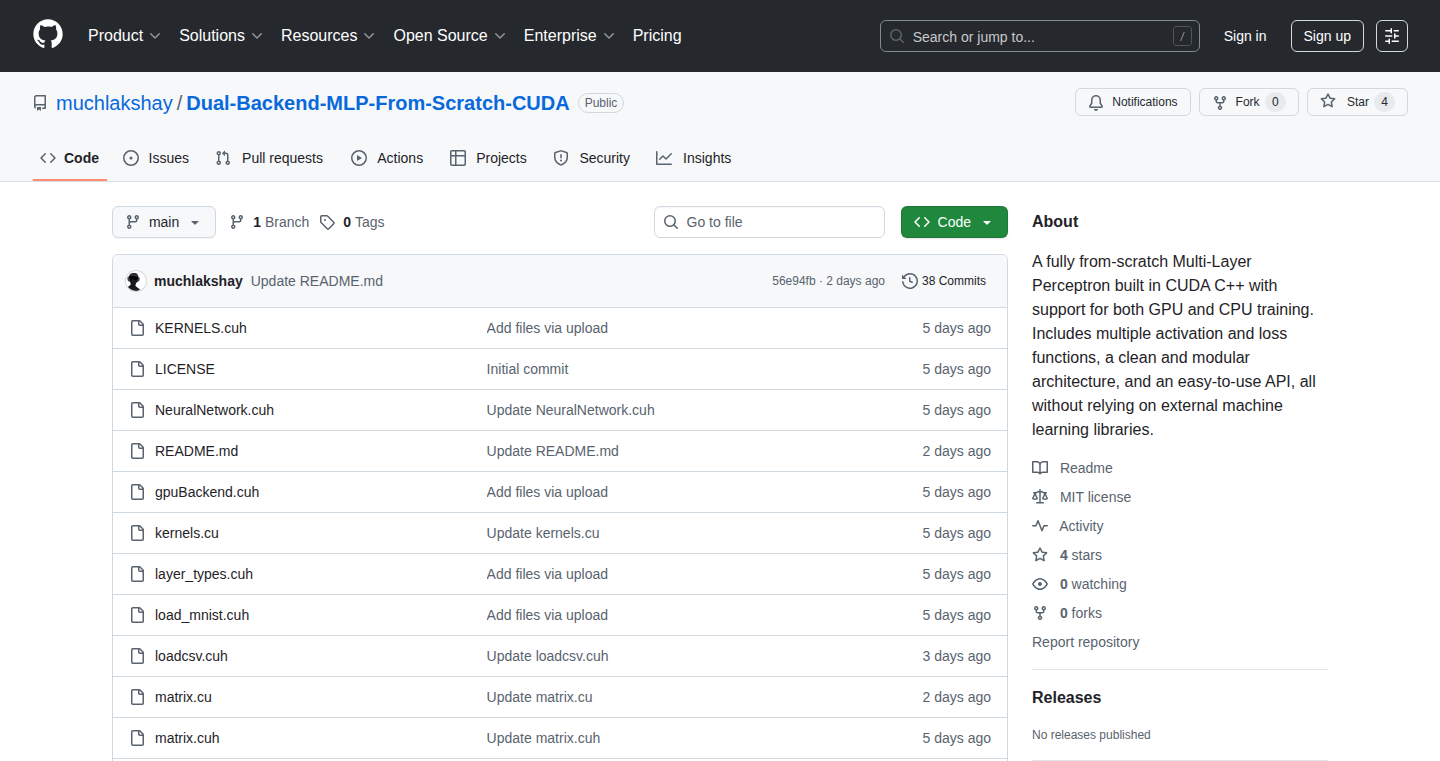
Author
muchlakshay
Description
This project is a Multi-Layer Perceptron (MLP), a fundamental type of neural network, built from scratch by a 15-year-old developer. The innovation lies in its dual-backend design: it can run on both a standard CPU and a powerful GPU (using CUDA). This allows for faster training and experimentation with neural networks, especially for larger datasets. The project emphasizes clarity and modularity over extreme optimization, making it a great learning resource. So this is great for learning how neural networks work and how to leverage the power of GPUs.
Popularity
Points 1
Comments 2
What is this product?
This project implements an MLP from the ground up. The core technology is a neural network architecture. What makes it interesting is that it supports two different ways of running the calculations: on a CPU (using the Eigen library for linear algebra) and on a GPU (using custom CUDA C++ code). CUDA allows for parallel processing, which is critical for speeding up machine learning training. The creator prioritized code clarity, meaning the code is easier to understand and modify. So this is a good way to understand how deep learning models works.
How to use it?
Developers can use this project to understand the inner workings of MLPs and how to implement them in both CPU and GPU environments. It can be a starting point for building more complex neural network architectures or for experimenting with different training techniques. You'd typically integrate it by examining the code and adapting it to your specific needs, like experimenting with different datasets or network structures. So this allows developers to understand the design and implementation of deep learning models at a low level.
Product Core Function
· CPU-based MLP Implementation: This allows for running the neural network on standard computer hardware, making it accessible to anyone with a computer. The value is that it provides a baseline for understanding the computation and the inner workings of the model, perfect for beginners to get started with machine learning. It provides an alternative for those without access to a GPU.
· GPU-based MLP Implementation using CUDA: This allows for much faster training times, especially for large datasets. The value here is the ability to experiment with complex models more efficiently, and accelerate the training process, making the iteration time far less. This is a significant advantage for anyone looking to train models with speed.
· Custom CUDA Matrix Library: The project includes a custom matrix library written in CUDA C++. This is important because it highlights the low-level control needed to optimize performance on a GPU. The value here is the detailed view into the optimization of computation, which is critical for building machine learning models.
· Modular and Well-documented Code: The code is designed to be easy to understand and modify. This is a tremendous benefit for other developers who want to learn or build upon this project. The value is its readability and easy understanding of the code.
Product Usage Case
· Educational Tool: Students and beginners can use the project to learn about the different parts of a neural network and experiment with them. They can easily modify the code and see how changes affect the training process. So this provides a hands-on approach to learning machine learning concepts.
· Performance Comparison: Developers can benchmark the performance of the CPU and GPU implementations and explore the speed improvements offered by GPUs. This teaches the fundamental differences between CPU and GPU performance.
· Customization and Extension: This project can act as a foundation for more complex projects. The ability to extend the functionality, add new layers, or implement different optimization techniques is highly valuable.
· Research and Development: Researchers can use this as a base to test new ideas and research for custom architectures. The easy to modify and understandable code can provide quick iteration cycles, useful in academic research and projects.
32
OfflineCurrencyConvert - iOS App
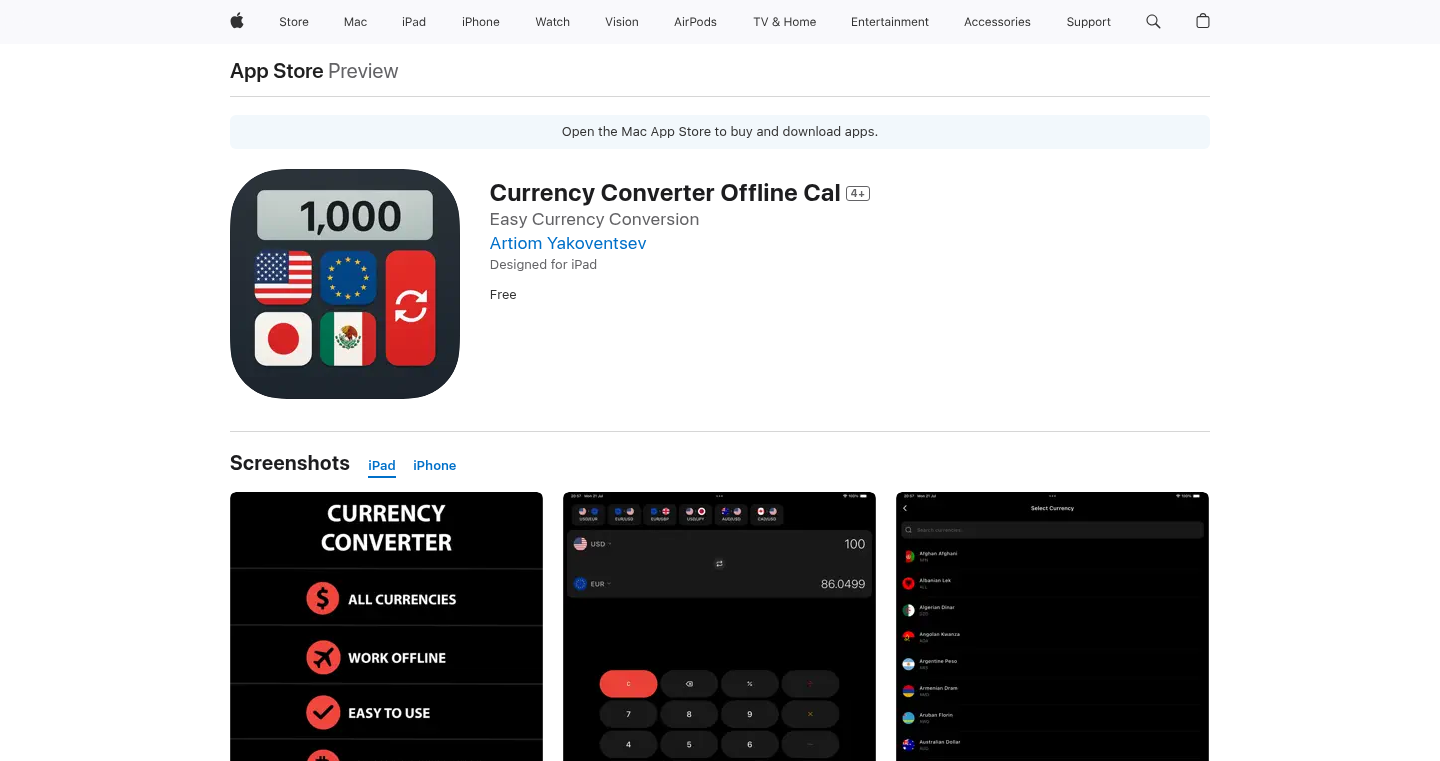
Author
artiomyak
Description
This project is a free iOS app, OfflineCurrencyConvert, that converts currencies without needing an internet connection. The core innovation lies in fetching and storing currency exchange rates locally on the device, providing a seamless experience for users in areas with limited or no network access. This addresses the technical challenge of providing currency conversion functionality when offline.
Popularity
Points 3
Comments 0
What is this product?
OfflineCurrencyConvert is a mobile application for iOS. It retrieves currency exchange rates and stores them on your phone. The app then uses this local data to convert between different currencies, even when you're not connected to the internet. The innovative part is pre-fetching the exchange rates and storing them securely. This solves the problem of needing a real-time internet connection to convert currencies, offering a significant benefit for travelers or anyone in areas with poor network coverage. So this helps me convert money even when there's no Wi-Fi or mobile data.
How to use it?
Developers can leverage this concept by implementing similar offline data storage strategies in their own apps. Imagine an e-commerce app that stores product catalogs offline or a travel app that caches maps. The key is to fetch data when there is a connection, store it locally using secure storage methods like SQLite or Core Data, and then use this stored data to power the application's features. This enables robust functionality even in the absence of a network. You can integrate this by making your own app's data more accessible by storing it in a secure way. So this can help me build more robust apps that work without constant internet access.
Product Core Function
· Offline Currency Conversion: The primary function is converting currencies without an internet connection. This is achieved by periodically downloading and locally storing currency exchange rates, and using the locally cached data to perform conversion calculations. This is useful when traveling abroad or in areas with limited internet connectivity.
· Exchange Rate Updates: The app includes a mechanism for automatically or manually updating the stored exchange rates. It connects to a reliable source for exchange rates and updates the local data storage accordingly. This ensures that the user has access to up-to-date exchange rates, even when offline. This is useful to ensure accurate conversion calculations over time.
· User-Friendly Interface: The app provides a simple and intuitive user interface. This allows users to select currencies, enter amounts, and instantly see the converted values. This makes it easy for anyone to use, regardless of their technical skills. This makes currency conversion simple and accessible to everyone.
Product Usage Case
· Travel App Integration: A travel app could use this model to store map data offline. Before a trip, a user can download map data for their destinations. The app can then function without internet connectivity. This offers a better user experience in foreign countries with limited data or high roaming charges. So I could plan a trip and access maps even when I'm offline.
· E-commerce Product Catalogs: An e-commerce app could pre-load product catalogs when the device is connected to the internet. This way, users can browse product listings, even without a network connection. It improves the app's responsiveness and increases user engagement in areas with poor connectivity. This could enable me to see products even when my connection is unstable.
· Offline News Readers: A news reading app could download and store articles offline. This allows users to read the news during their commute, on flights, or in any environment with limited or no internet access. It improves the usability and accessibility of the news app. This allows me to read articles even when I don't have internet access.
33
Decentralized Microfrontend E2EE Messaging Platform
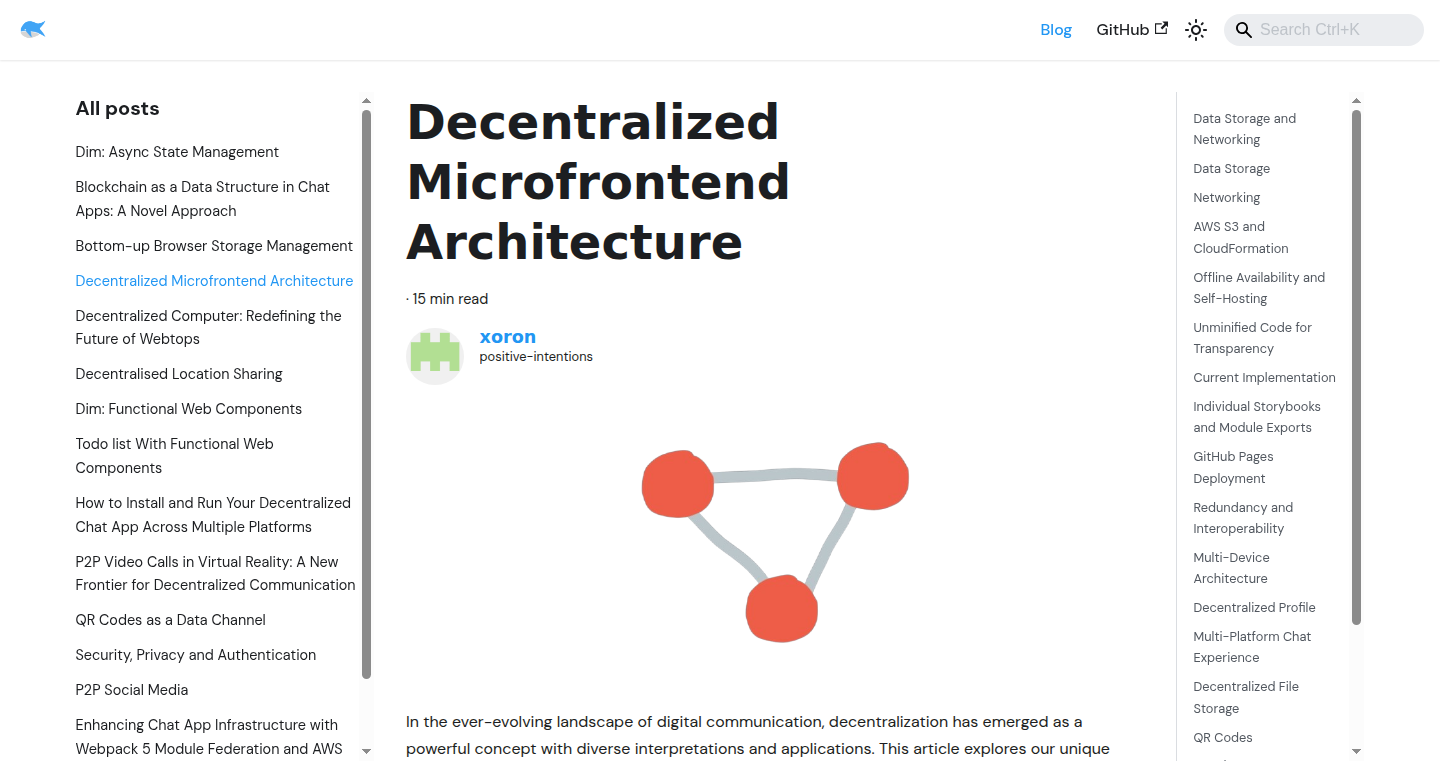
Author
Screen8774
Description
This project is a bold experiment in building an end-to-end encrypted messaging system using a decentralized microfrontend architecture. It breaks down the application into smaller, independent modules, allowing for greater flexibility in development and deployment. The key innovation lies in the use of a P2P framework and cryptography modules to ensure secure communication. It explores the use of static assets as infrastructure and leverages module federation for sharing functionality across different applications, creating a system where updates to core features can be rolled out easily across diverse applications, including Android builds via Tauri. This project highlights a creative approach to address the challenges of building secure, scalable, and maintainable applications. So, it’s like building with Lego blocks but for secure messaging, allowing for easy updates and sharing of code.
Popularity
Points 1
Comments 2
What is this product?
This project builds a secure messaging system using a very modern approach. It's not just a single program; it's split into many small, independent parts (microfrontends). These parts can be updated and changed separately, like individual components in a car. It uses a special way to connect people directly (P2P framework) and keeps messages secret with strong encryption (cryptography modules). The project also experiments with using static files, like images and text, as the foundation for the messaging app's infrastructure. This setup enables building different messaging applications (chat, file transfer) that can easily share common features. So, it’s a modular, secure, and flexible way to build messaging apps, allowing for better control, easier updates, and the flexibility to build different applications based on the same core components.
How to use it?
Developers can use this approach to build secure messaging or any application where security and flexibility are critical. They would create independent modules using technologies like JavaScript. Then, they'd use the P2P framework for direct connections between users and integrate the cryptography modules to encrypt data. Module federation allows these modules to be shared across different applications. The project provides examples of integrating these modules within different applications. So, developers can build secure and adaptable messaging apps by using the provided components and frameworks, and easily upgrade the core system.
Product Core Function
· P2P Framework: Enables direct, secure connections between users without relying on central servers. It's like building a direct line of communication, enhancing privacy and reducing the risk of censorship. So, this means your conversations stay between you and the person you're talking to.
· Cryptography Modules: Provides strong encryption to protect messages from eavesdropping. It's like locking your messages with an unbreakable code. So, your conversations are private and secure.
· Microfrontend Architecture: Divides the application into smaller, independent parts that can be updated and changed separately. It’s like a car, where different parts (engine, wheels) can be improved independently. This improves flexibility, making it easier to fix bugs, add new features, and deploy updates without affecting the whole system. So, this makes it easy to add new features and fix bugs without having to rewrite the whole app.
· Module Federation: Allows sharing of functionality between different microfrontends, like sharing car parts between different car models. This allows developers to reuse code and features across multiple apps, reducing development time and ensuring consistency. So, developers can build different messaging applications (chat, file transfer) that share common features.
· Static Assets as Infrastructure: This is an experimental approach which utilizes static files for the app's infrastructure, providing a different approach to server-side communication. So, this simplifies setup and may offer different advantages.
· Tauri Integration for Android Builds: Allows easy building of the application for Android devices. So, this broadens the reach of the application and improves usability.
Product Usage Case
· Secure Messaging App: Developers can use the microfrontend architecture, P2P framework, and cryptography modules to build a secure messaging app that prioritizes privacy and end-to-end encryption. For example, Signal and Matrix. So, you can create a secure, private messaging service.
· Decentralized File Transfer: The project's architecture supports a decentralized file transfer application, similar to BitTorrent. The P2P Framework and Module Federation are key components here. So, you can securely transfer files without a central server.
· Building a Multi-Platform Chat Application: The architecture is designed to be cross-platform. The provided module can be adapted to support applications built for the web and Android. So, you can build a chat app that works on different devices.
· Sharing Cryptography Libraries Across Applications: The cryptography modules can be used in various applications to ensure end-to-end encryption across different use cases. For example, this can be used in an email client or a secure note-taking app. So, this is a way to reuse secure code and reduce development effort.
34
Website Redesign Navigator
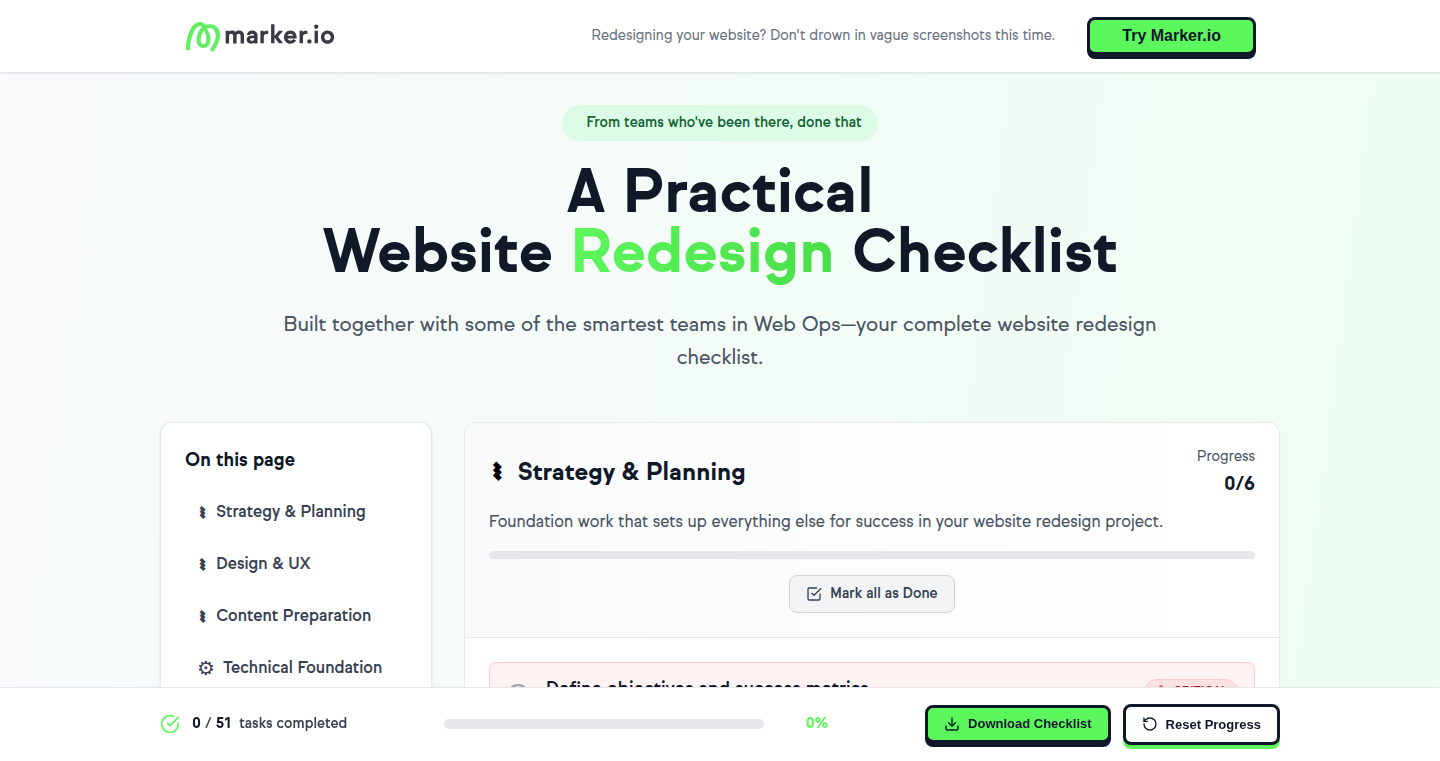
Author
olivierkaisin
Description
A practical checklist tool designed to guide you through the often-overlooked details when redesigning a website. It tackles the common problems of forgotten redirects, missing assets, and metadata gaps that often plague website rebuilds. It is essentially a curated list of tasks and considerations gathered from various web operations teams and agencies, ensuring a comprehensive and practical approach to website redesigns.
Popularity
Points 3
Comments 0
What is this product?
This is essentially a smart checklist for web developers and designers undertaking a website redesign. It's not a complex piece of software, but a well-organized list of tasks and considerations to ensure everything is covered during a website overhaul. The innovation lies in the collaborative nature of its creation and the focus on practical, real-world problems. It streamlines the process by reminding you of crucial details like redirect management and asset migration. So this can save you time and prevent costly errors during your website redesign.
How to use it?
Developers and designers can use this checklist by simply going through each item, checking off tasks as they are completed. It can be integrated into your project management workflow or used as a standalone guide. You can view it, copy the tasks into your project management tool, or even contribute suggestions to improve it. So you can make sure you don't miss anything important during your website redesign.
Product Core Function
· Comprehensive Checklist: Provides a structured list covering all key areas of a website redesign, including redirects, assets, metadata, SEO, and more. Value: Ensures a methodical approach and prevents overlooked issues. Application: Use it as a reference during your website redesign project.
· Collaborative Input: Based on input from other web ops teams and agencies. Value: Benefit from collective experience, reducing the chances of making common mistakes. Application: Leveraging best practices in web development.
· Practical Focus: Addresses real-world problems like broken links and missing assets. Value: Improves the user experience and search engine optimization (SEO). Application: Improves user experience and boosts search rankings.
· Easy to Use: It's a simple checklist format that's easy to understand and follow, whether you are a seasoned developer or just starting. Value: Increases efficiency and reduces the stress of managing a complex project. Application: Streamlines your workflow and saves you time and stress during a website overhaul.
Product Usage Case
· Redesigning a corporate website: The checklist ensures all necessary SEO elements are migrated correctly, preventing loss of search engine ranking, which is vital for generating leads and sales.
· Migrating a blog to a new platform: The checklist helps to identify all redirects, ensuring visitors are seamlessly redirected to new content, providing a better user experience. This helps maintain reader engagement and traffic.
· Launching a new e-commerce site: This tool guarantees that all essential website elements are in place before launch, preventing embarrassing errors and ensuring customers can smoothly navigate the site and complete purchases. This ensures a great initial user experience and maximizes sales.
· Website maintenance and updates: This can be used to ensure every change you make to your website is done correctly, keeping things from breaking and improving your site's performance.
35
Muapi: Lightning-Fast AI Visual Content API
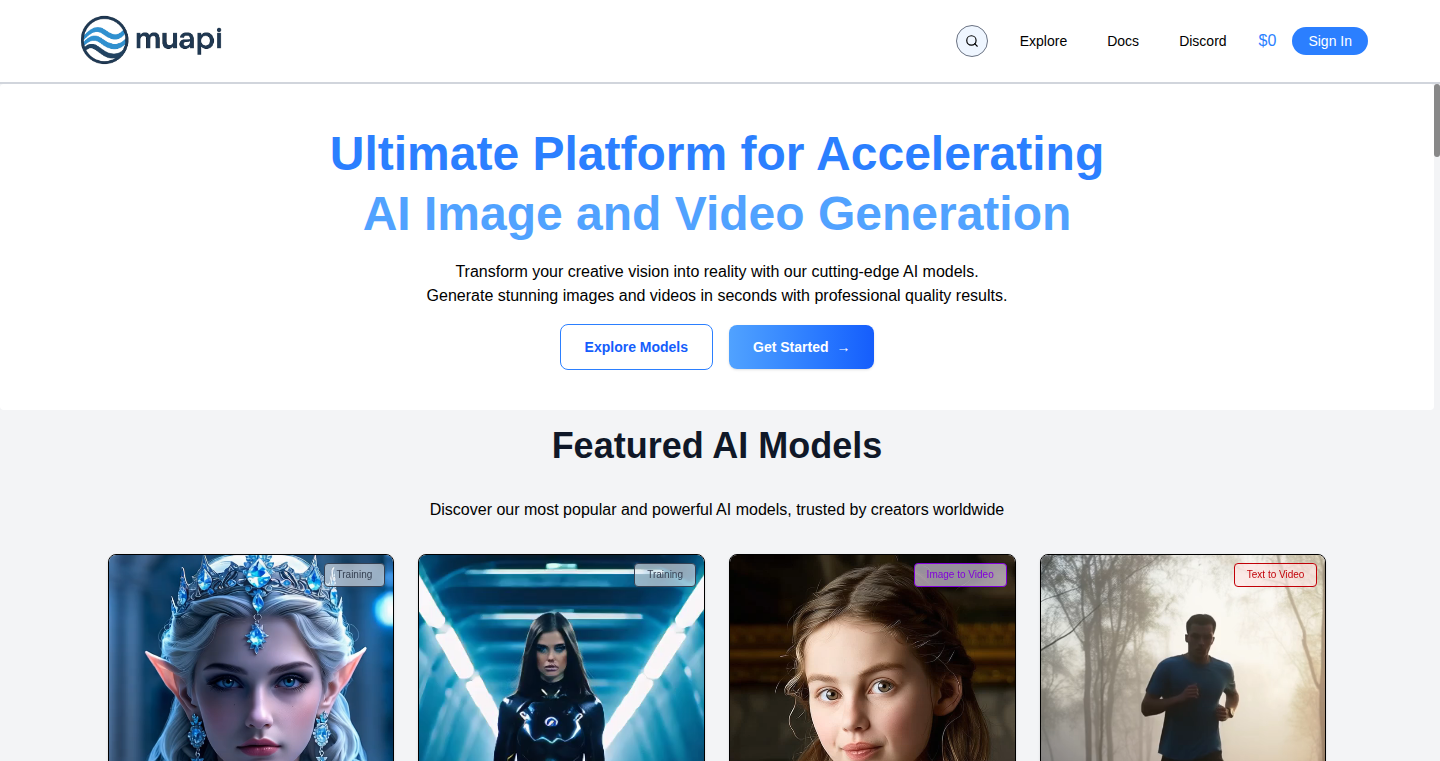
Author
Sunny_Sogra
Description
Muapi is a fully hosted API platform designed for developers to create AI-generated images and videos at incredible speeds. It tackles the complex issue of managing GPUs and infrastructure, allowing developers to focus on building innovative visual applications without worrying about the underlying technology. The core innovation lies in its ability to generate high-resolution images in under 2 seconds and cinematic videos within minutes, leveraging cloud infrastructure for seamless scaling and performance.
Popularity
Points 3
Comments 0
What is this product?
Muapi is an API service that handles the heavy lifting of AI image and video generation. Instead of developers needing to set up and maintain powerful servers (like those with GPUs) themselves, Muapi provides access to this power through simple API calls. This allows developers to quickly integrate AI image and video generation into their own applications. The technical innovation is in optimizing the cloud infrastructure and AI models to achieve exceptional speed and scalability. So this provides significant time savings and eliminates the complexity of managing AI infrastructure.
How to use it?
Developers use Muapi by sending API requests to the platform. For example, they might send a request with a text description of the image they want (a 'prompt'). Muapi's AI models then generate the image and return it to the developer. Developers can integrate Muapi into websites, mobile apps, or any other application where they need to generate visual content dynamically. This significantly simplifies the process of incorporating AI-powered image and video features into any project.
Product Core Function
· Fast Image Generation: Muapi can generate high-resolution images in under 2 seconds. This enables real-time or near real-time image generation for applications like interactive design tools or instant product visualizations. So this allows for a faster and more responsive user experience.
· Rapid Video Generation: Generate cinematic videos in just a few minutes. This makes it easier for developers to create engaging video content for marketing, social media, or even educational purposes. So this greatly reduces the time and resources required to produce video content.
· Scalable Cloud Infrastructure: The platform is built on cloud infrastructure, allowing it to scale automatically to handle varying workloads. This means the service can easily manage a large number of requests without performance degradation. So this ensures the platform is always available and responsive, regardless of user demand.
· No GPU Management: Developers don't need to worry about managing GPUs or the complex setup associated with AI model deployment. Muapi handles all the underlying hardware and software configurations. So this simplifies the development process and reduces the entry barrier for using AI.
Product Usage Case
· E-commerce Product Visualizations: E-commerce businesses can use Muapi to generate product images from text descriptions. This allows them to quickly create different product variations, test different product visuals, and personalize the shopping experience. This helps businesses improve sales and engagement with their customers.
· Interactive Design Tools: Designers can integrate Muapi into their design tools to allow users to generate images from text prompts or style preferences. This can significantly speed up the design process and enable creative experimentation. So this allows designers to generate visual content faster and enhance their creative workflow.
· Social Media Content Creation: Social media managers can use Muapi to create engaging visual content for their platforms. They can generate images or short videos based on text descriptions or trends. This gives them the power to create engaging and relevant content faster.
· Educational Content: Educators can create illustrative images and videos for educational materials, enriching the learning experience. It can visually communicate complex concepts making learning more accessible and engaging. So this provides a way to create compelling visual aids for improved learning outcomes.
36
JeopardyMaker - AI-Powered Jeopardy Game Generator

Author
ronittsainii
Description
This project allows users to instantly create Jeopardy games using Artificial Intelligence. The core innovation lies in the 'AutoGen' feature, which leverages AI to generate questions and answers based on a given topic and subtopic. This significantly reduces the manual effort required to create a Jeopardy game, which used to take considerable time. It tackles the problem of content creation by automating the process using AI, thus making it accessible and efficient for anyone.
Popularity
Points 3
Comments 0
What is this product?
It's a web application that uses AI to automatically generate Jeopardy games. You provide a topic, like 'History' or 'Software Development', and a subtopic, like 'American Revolution' or 'JavaScript Frameworks'. The AI then creates a full Jeopardy game with categories, questions, and answers. The magic happens behind the scenes where the AI analyzes the topic and subtopic, pulling information from its vast knowledge base and formulating the content in a game-ready format. So, this is like having an instant Jeopardy game creator at your fingertips, powered by the latest AI technology.
How to use it?
Developers and educators can use this tool through a web interface. You'd visit the website, sign up, and then use the 'AutoGen' feature. You simply enter the topic and subtopic, and the AI handles the rest. The generated game can then be used for educational purposes, entertainment, or even as a learning tool. It’s a simple process - input the information, get the game. Easy peasy!
Product Core Function
· Automated Jeopardy Game Generation: This is the core function, allowing users to create full Jeopardy games from a simple topic and subtopic input. This is extremely useful for teachers who want to quickly create review games or anyone who wants to create a fun quiz without spending hours creating the content. So this saves a ton of time and effort.
· Topic and Subtopic Input: Allows for flexible control over game content by allowing users to define the subject matter with granular control. It is valuable because it is possible to tailor game content based on audience and learning objectives. For instance, use it to generate games related to a specific history period.
· AI-Powered Content Creation: The use of AI to generate questions and answers automates content creation, allowing for rapid creation of games covering a variety of subjects. This provides the value of fast, diverse content generation – very useful for covering niche topics or generating many different games quickly.
Product Usage Case
· Educational Use: Teachers can quickly create review games for students on various subjects, such as Math, History, or Science. Students can learn by actively playing and engaging with content. So, a teacher can create a game on the American Revolution in minutes, instead of spending hours manually creating the questions.
· Corporate Training: Trainers can use it to create quizzes and knowledge checks for employee training, which can be engaging and more effective than traditional presentations. For instance, you can create a game to test employees on company policy in a fun and engaging way. So, it enhances engagement in training.
· Personal Entertainment: Anyone can create Jeopardy games on any topic for fun or for parties. It enables the ability to create customized trivia games for family gatherings, or as an engaging way to learn something new. So, it offers a fun and customizable learning or entertainment experience.
37
HNS: Terminal-Based Local Speech-to-Text
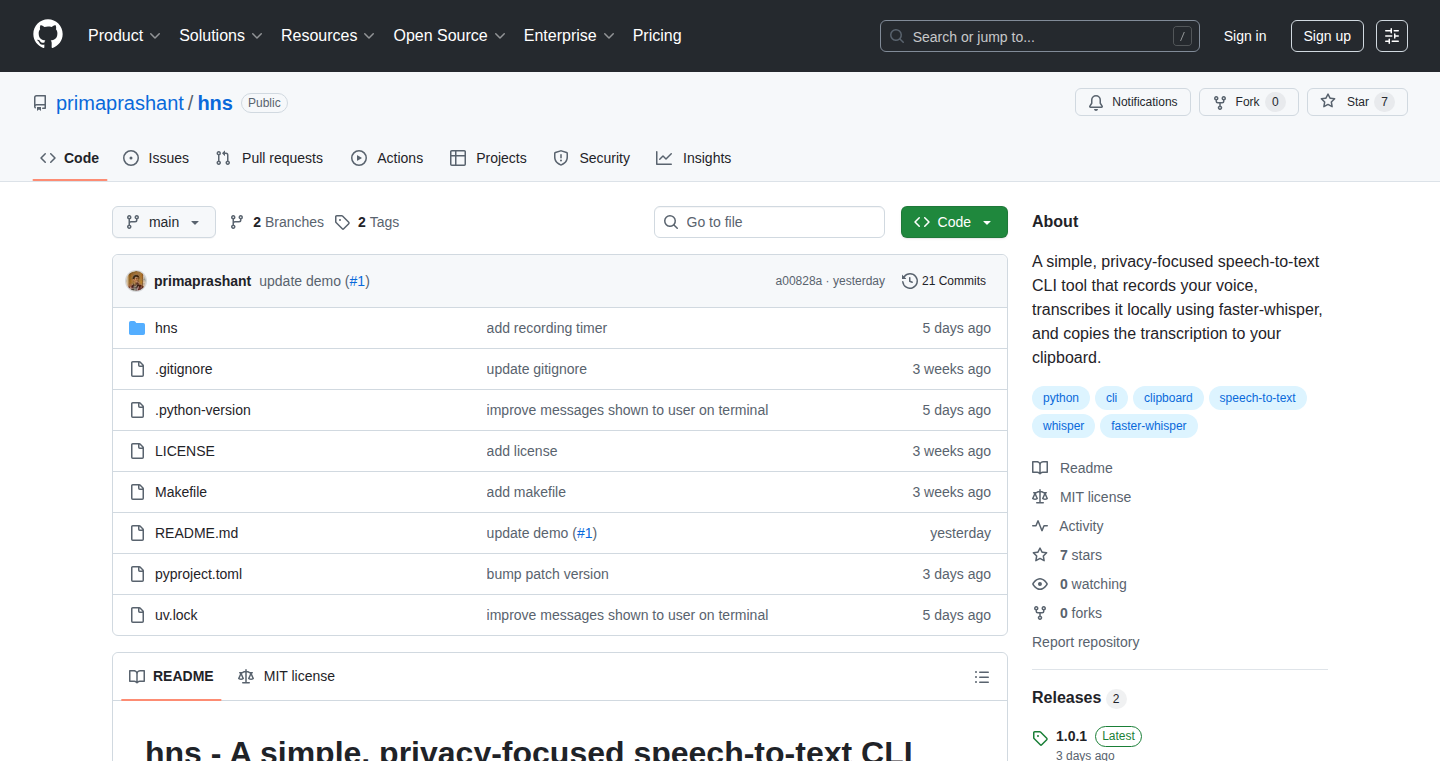
Author
primaprashant
Description
This project is a command-line tool that lets you record your voice, convert it into text locally on your computer, and then copies the text to your clipboard. The clever part? It uses a super-efficient speech-to-text engine called 'faster-whisper' to perform the transcription right on your machine, so your audio data never leaves your control. So, instead of typing long notes, you can simply speak them and paste the transcribed text where you need it. This solves the problem of needing to transcribe audio quickly and privately.
Popularity
Points 3
Comments 0
What is this product?
HNS is a simple command-line tool. When you run it, it starts recording your voice. After you're done, it uses the 'faster-whisper' library (which is a faster version of the famous Whisper speech recognition model) to transcribe your speech into text. Finally, it puts the transcribed text in your computer's clipboard, ready to be pasted anywhere. So, this is all about turning your spoken words into text in a privacy-focused and quick way.
How to use it?
Developers can use HNS by installing it using `uv tool install hns` or `pipx install hns`. Then, you just type `hns` in your terminal, speak your mind, and the transcribed text is instantly available. You can paste it into coding notes, Slack messages, or any text editor. Think of it as a personal voice-activated note-taking tool directly integrated into your workflow.
Product Core Function
· Voice Recording and Transcription: The core function is recording your voice and converting it into text. This leverages the power of speech recognition technology to save time and effort compared to manual typing. (So what? This makes note-taking, brainstorming, and dictation far more efficient.)
· Local Processing with Faster-Whisper: The project uses 'faster-whisper', meaning the transcription happens on your computer, not on a remote server. This enhances privacy and speeds up the process since your data doesn't need to travel over the internet. (So what? Your spoken words are safe, and the transcription is quick.)
· Clipboard Integration: Automatically copies the transcribed text to your clipboard. This provides seamless integration with any application that accepts text input, making it incredibly easy to incorporate your voice notes into your documents or communication. (So what? You can immediately paste your voice notes wherever you need them.)
· Terminal-Based Interaction: The tool works directly in the terminal, which makes it ideal for developers already working in a terminal environment. It reduces the need to switch between different applications. (So what? Easy to use for developers. This streamlines the note taking process, reducing context switching.)
Product Usage Case
· Note-Taking for Coding: A developer can use HNS to quickly dictate code comments or document the logic of their code directly into their code editor. This speeds up documentation and reduces the friction associated with writing code comments manually. (So what? Quickly document your code using voice.)
· Brainstorming Sessions: During brainstorming, a developer can speak ideas and have them transcribed instantly in a text file or notes app, allowing for a more free-flowing and less distracting process. (So what? Capture your thoughts seamlessly in the heat of the moment.)
· Creating Meeting Summaries: Developers can use HNS to transcribe meetings, quickly converting the spoken discussion into a text summary to easily share with colleagues or for personal review. (So what? Automate the meeting notes generation and make it easily shareable.)
· Voice-Driven Documentation: Quickly create documentation or write articles by speaking and having the text ready to paste directly into a documentation tool or text editor. (So what? Write technical documentation faster.)
38
SpatialSense: North Finding via Auditory Navigation
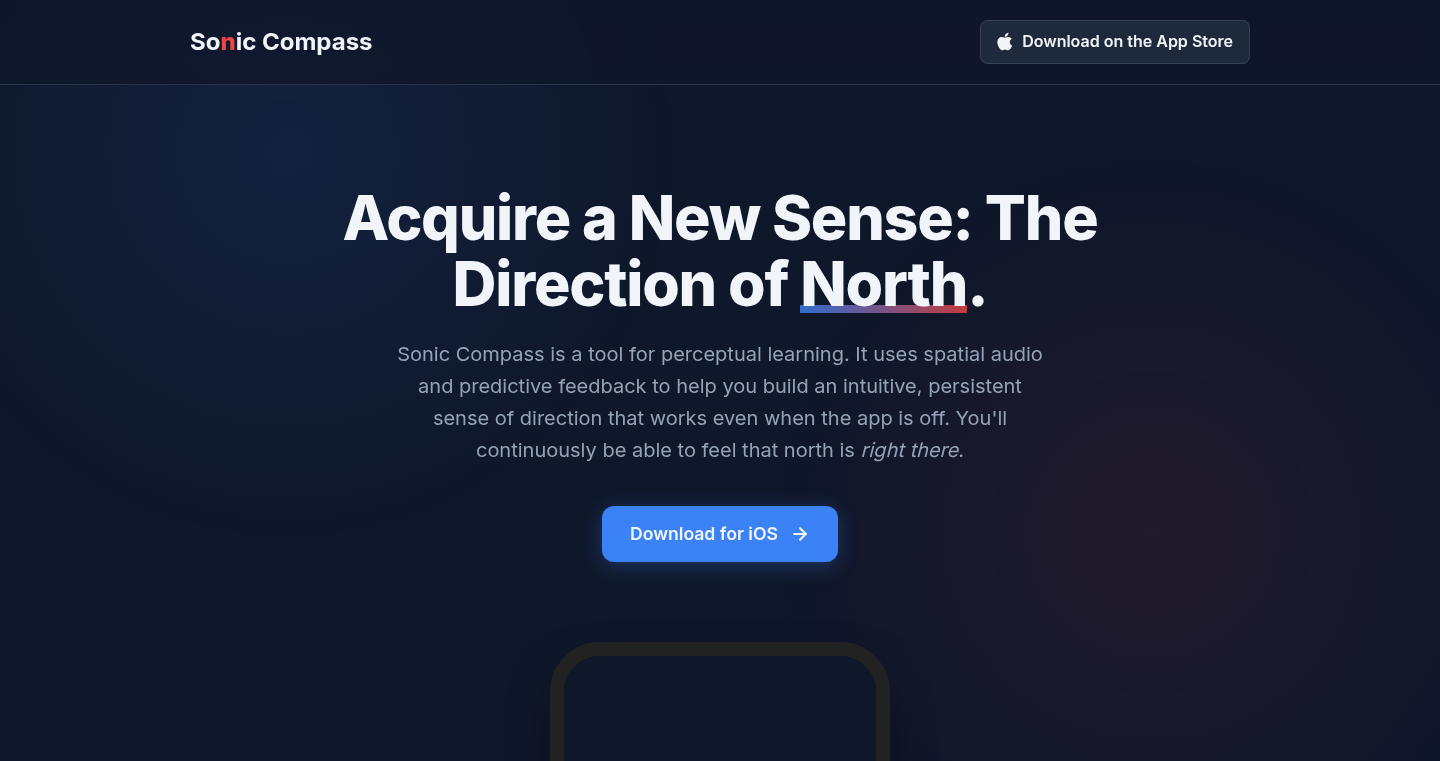
Author
ms0
Description
SpatialSense is an application that leverages spatial audio to help users develop an intuitive understanding of the north direction. It uses a device's built-in sensors (like a compass) to translate heading information into directional audio cues, effectively turning your ears into a compass. The core innovation lies in its approach to spatial awareness – instead of relying on visual cues, it uses sound, potentially benefiting users in situations where visual information is limited or distracting. It addresses the challenge of orientation without visual aids.
Popularity
Points 2
Comments 1
What is this product?
SpatialSense works by utilizing the phone's internal compass to determine the user's orientation. This information is then used to generate spatial audio – sounds that appear to come from different directions. For example, a gentle tone might consistently emanate from the north, allowing the user to intuitively learn where north is. The innovative aspect is the use of spatial audio for orientation, creating a more accessible and potentially more immersive experience compared to traditional compass apps. This means it's using your ears to 'see' the north, much like how bats navigate using sound.
How to use it?
Developers can use SpatialSense as a starting point for creating other applications related to spatial awareness, particularly for visually impaired users or in scenarios where visual focus is undesirable. The core logic can be adapted to other sensors like GPS for building location-based audio experiences. The SDK/framework could be integrated into augmented reality (AR) or virtual reality (VR) applications to provide auditory cues in a more immersive manner. Think of it as a building block for audio-focused navigation or spatial understanding applications.
Product Core Function
· Spatial Audio Processing: The app takes compass data and generates audio cues, creating an intuitive sense of direction. This lets developers create tools that utilize sound for navigation or user guidance. The value is a new interface for conveying information and its application could be in game audio design or augmented reality.
· Compass Data Integration: This feature leverages the phone's built-in compass to determine orientation. It means you can build applications that react to device rotation and provide directional information. This allows developers to make applications responsive to user movement and provides a valuable feature for outdoor navigation or orientation-based games.
· User-Friendly Interface: SpatialSense likely offers a simplified interface for easy interaction. Developers can study how to design intuitive interactions and audio-based feedback. This is valuable for creating accessible applications, such as audio-based navigation systems for the visually impaired. For example, you can apply this to interactive museum guides.
Product Usage Case
· Blind Navigation System: Develop an app that guides visually impaired users, using audio cues to indicate direction and landmarks. This is a simple way to enhance the accessibility of mobile applications.
· Audio-Based Games: Create games where players rely on sound for navigation, enhancing immersion and gameplay. The advantage is a new mechanic for game designers who aim to make engaging experiences.
· AR/VR Spatial Cues: Integrate spatial audio cues into AR/VR applications to provide users with directional information. This gives developers new tools to create an immersive environment. For instance, you can show a direction indicator in AR games using sounds.
39
CalOverlap: Time Overlap Finder
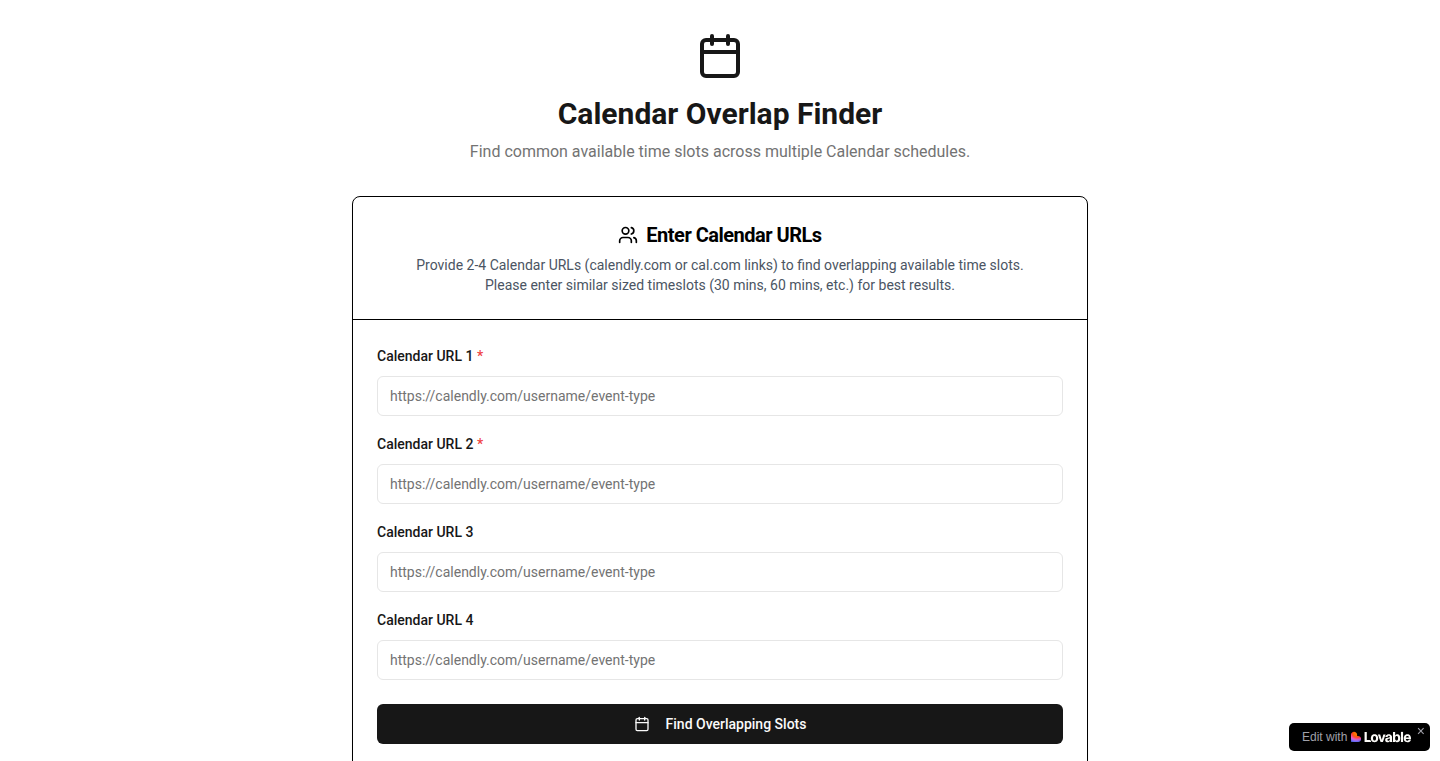
Author
vladimirbaranov
Description
CalOverlap is a web tool designed to simplify group scheduling by identifying overlapping availability across multiple calendar links, like Calendly and Cal.com. It addresses the common issue of coordinating meetings when everyone uses different scheduling tools. Instead of manually comparing calendars, CalOverlap lets users input calendar links and instantly shows the best times for everyone. The tool operates entirely within the user's browser, ensuring privacy by not storing any calendar information.
Popularity
Points 3
Comments 0
What is this product?
CalOverlap is a web application that solves the headache of scheduling meetings across multiple calendar platforms. It works by taking calendar links (like from Calendly or Cal.com) as input and then analyzing the availability information to find the times when everyone is free. The technology behind it involves parsing the data from these calendar links (this happens entirely in your web browser, no data is sent to any server). This approach is a lightweight solution that provides an immediate answer to the scheduling problem. So, if you're tired of endless email chains to find a meeting time, this is your solution.
How to use it?
Users interact with CalOverlap by simply pasting the scheduling links (from Calendly, Cal.com, etc.) into the tool's interface. The application then processes this information locally and displays the overlapping available time slots. The results are presented in a clear and easy-to-read format, highlighting the best times for everyone. This tool can be used in any scenario where you need to coordinate schedules across different calendar platforms, such as planning meetings with clients, coordinating team calls, or setting up appointments with multiple stakeholders. You can access it directly via a web browser without any installation or registration required.
Product Core Function
· Calendar Link Input: The core function allows users to input calendar links from different platforms. This is the entry point for all the data.
· Availability Parsing: This is the key technology – CalOverlap parses the availability information from the provided calendar links. It's how the tool understands when people are free or busy. This process is done directly within the user's web browser, protecting user's privacy.
· Overlap Detection: This function takes the parsed availability data and identifies the time slots when all participants are available. It uses algorithms to compare the free/busy times across different calendars.
· Time Slot Display: CalOverlap then presents the overlapping time slots to the user, making it easy to identify the best meeting times. This ensures that users can quickly see when everyone is free.
Product Usage Case
· Project Coordination: A project manager is organizing a meeting with team members who use different calendar systems (Google Calendar, Outlook, etc.). The project manager uses CalOverlap to input each team member's scheduling link and finds the best time for the meeting, eliminating the need for manual calendar comparisons and email chains. This helps to speed up the team's alignment and project execution.
· Client Meetings: A sales representative needs to schedule a call with multiple clients who use different calendar services. By using CalOverlap, the representative can quickly identify available time slots that suit everyone, making the scheduling process efficient and professional. This saves time and improves the client experience.
· Team Collaboration: A team is looking to coordinate a recurring meeting, and team members have various work styles and calendar setups. CalOverlap helps to find the best regular meeting times, creating a schedule that maximizes attendance and ease of use. It can also be used for scheduling interviews with candidates who provide a public calendar link.
40
BizFlow: Open-Source Business Management System
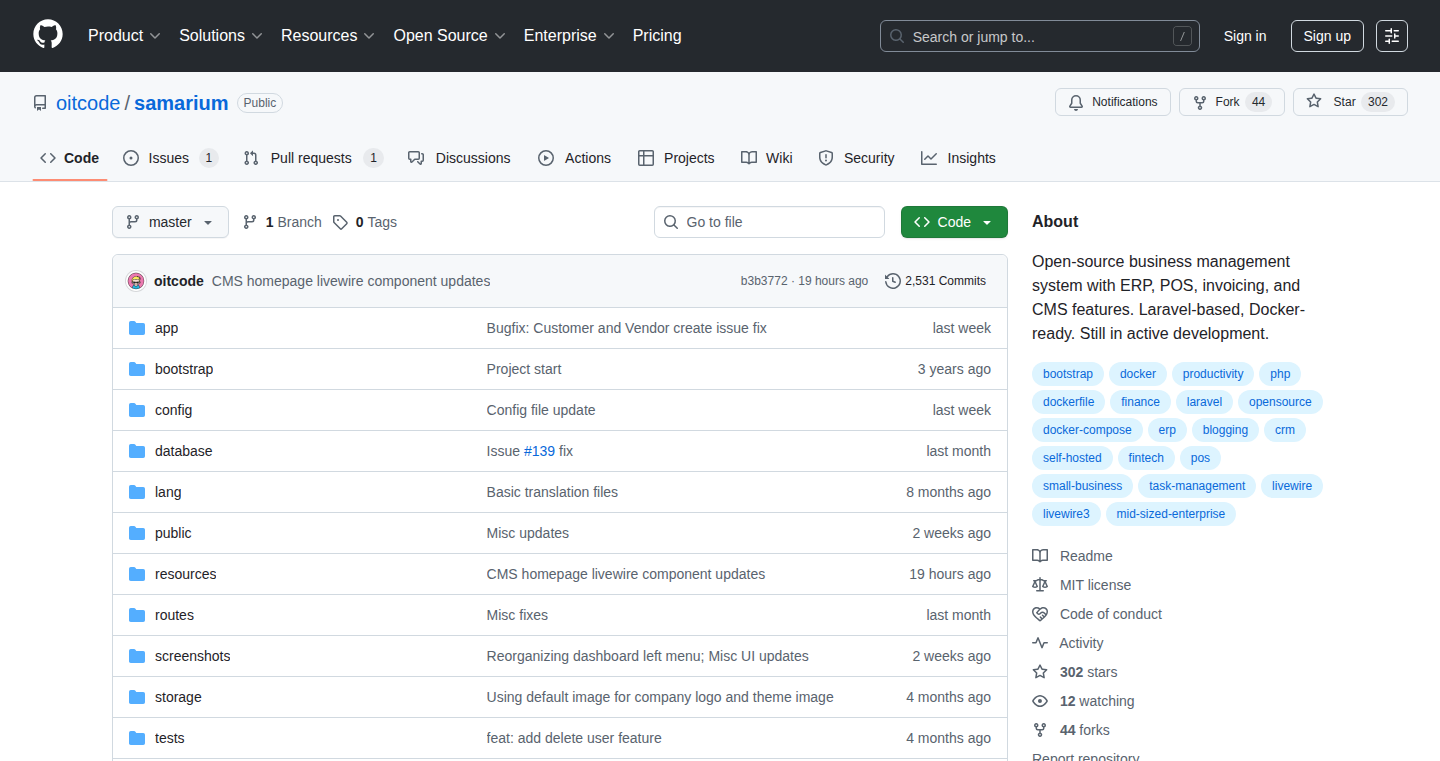
Author
zaza12
Description
BizFlow is an open-source business management tool designed for small businesses. It provides a suite of features like CRM, project management, and invoicing, all integrated into a single platform. The core innovation lies in its modular design, allowing users to pick and choose features based on their needs, and its open-source nature promotes community contributions and customization. This approach tackles the fragmented nature of business management tools often found in the market, offering a flexible and cost-effective solution. So, this offers a centralized hub for managing all business operations, reducing reliance on multiple tools and potentially lowering costs.
Popularity
Points 3
Comments 0
What is this product?
BizFlow is essentially a digital command center for small businesses. Instead of juggling different software for customer relationship management (CRM), project tracking, and billing, it consolidates these functions. Its innovation stems from being open-source, meaning the code is publicly available for modification and improvement. It also has a modular architecture. Think of it like LEGO bricks: you only use the features you need, minimizing complexity and unnecessary expenses. So, this lets businesses tailor the software to their specific requirements and benefit from community-driven enhancements.
How to use it?
Developers can deploy BizFlow on their own servers or use it as a starting point for building customized business solutions. They can contribute to the project, adding features or fixing bugs, thanks to the open-source license. It offers API integration, allowing developers to connect to other tools and services. For example, a developer could integrate it with a specific payment gateway or create custom reports. So, this empowers developers to create highly tailored solutions for their clients or for their own business needs.
Product Core Function
· CRM (Customer Relationship Management): Manages customer interactions and data, including contact information, interactions history, and sales pipelines. Value: Improves customer engagement and streamlines sales processes. Application: Tracking customer leads, managing support tickets, and analyzing sales performance.
· Project Management: Allows developers to manage tasks, deadlines, and resources for business projects. Value: Improves project efficiency and reduces project risks. Application: Planning and tracking software development projects, marketing campaigns, or other business initiatives.
· Invoicing: Automates the creation and sending of invoices and manages payment tracking. Value: Improves financial management efficiency and reduces the risk of payment delays. Application: Sending invoices to clients, tracking payment status, and generating financial reports.
· Modular Design: Allows users to enable only those modules they need. Value: Reduces complexity and lowers the cost by focusing on essential features. Application: Enables businesses to scale functionalities without unnecessary features.
Product Usage Case
· A freelance developer could use BizFlow to manage clients, track projects, and send invoices all in one place, replacing multiple tools and streamlining workflow. So, this simplifies project management and ensures efficient business operations.
· A small marketing agency can customize BizFlow by integrating it with specific marketing automation tools, tailoring its CRM to their specific needs and improving client relationship management. So, this provides tailored solutions to meet unique business demands.
· A software startup can deploy BizFlow on their own servers, customizing it with features and functionality, optimizing project workflows and integrating it with their codebase, thereby accelerating development cycles and improving team productivity. So, this supports rapid iteration and customized development.
41
ProdE: Contextual AI for Multi-Repo Codebases
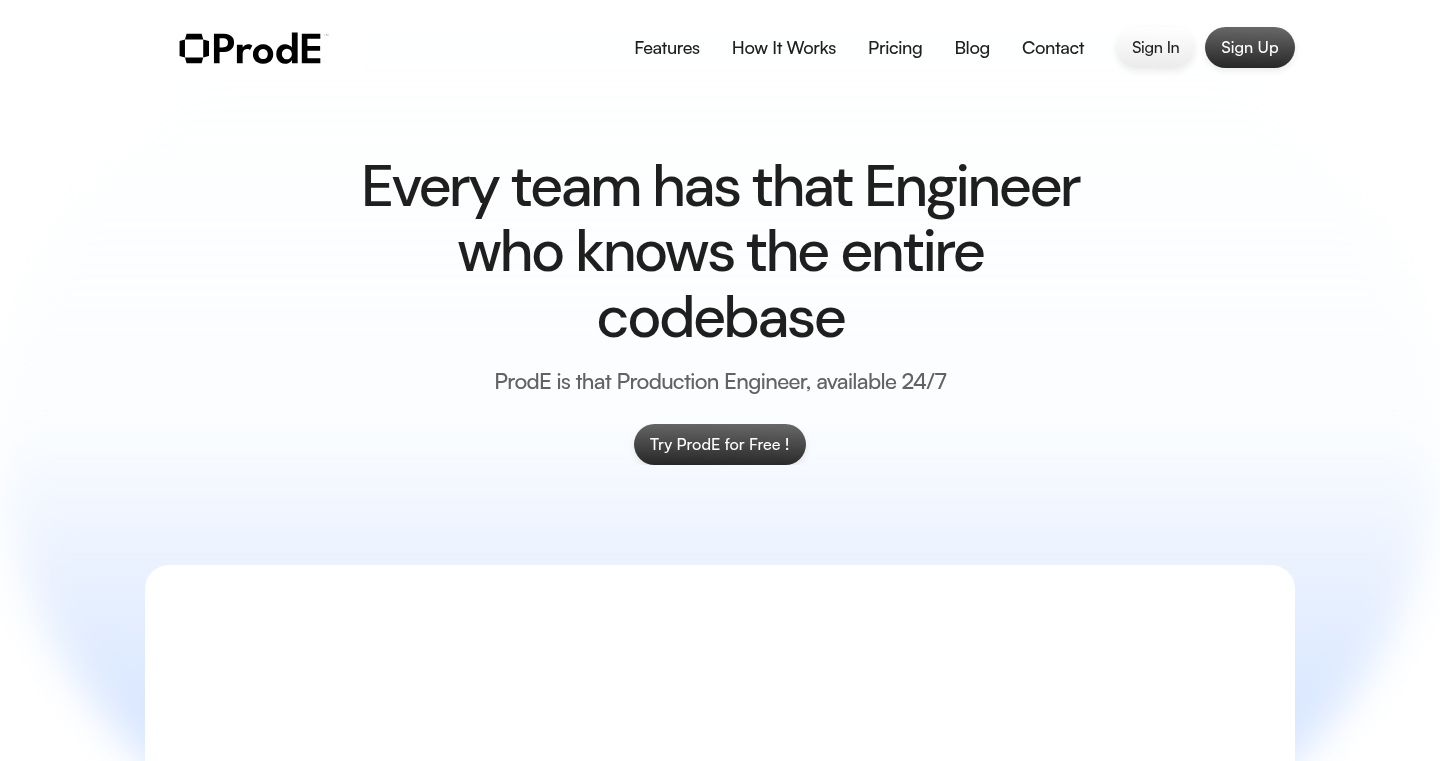
Author
curious_nile
Description
ProdE is a tool that helps AI coding tools understand the code in your project, especially when your code is spread across multiple different repositories. It provides context to the AI, so it can help you write and understand code more effectively. This solves a common problem where AI can't access all the information needed to help with complex projects, making it more useful for real-world software development.
Popularity
Points 2
Comments 1
What is this product?
ProdE works by building an index of all your code, including code from different repositories. This index provides the AI with a complete picture of your project. The AI uses this context to better understand your code, suggest improvements, and even help you write new code. The innovation lies in its ability to link disparate codebases seamlessly for the AI, overcoming the limitation of traditional AI coding tools that often struggle with large, distributed projects. So this provides more accurate and helpful suggestions from AI code assistants.
How to use it?
Developers can use ProdE by integrating it with their AI coding tools or IDEs. First, you'd set up ProdE to index your code repositories. Then, you'd point your AI tool to ProdE's index. From there, your AI will use the complete codebase index provided by ProdE to help you. This is particularly useful when you're working on projects that rely on multiple interconnected components, or when you need to quickly understand how different parts of the code interact. So, it streamlines your coding process by giving the AI the information it needs, saving you time and frustration.
Product Core Function
· Multi-Repository Indexing: ProdE indexes code across different repositories, creating a unified context for AI. This is valuable because it allows the AI to understand the relationships between different parts of your project, even if they are stored in separate locations. So this helps you find bugs and dependencies that span different repositories.
· Contextual Code Understanding: By providing a comprehensive code index, ProdE enables AI to better understand the context of your code, leading to more accurate code completion and suggestion. This helps you write code faster and with fewer errors, because the AI knows the context. So it boosts your productivity while coding.
· Enhanced Code Navigation: ProdE can help you navigate your codebase by providing the AI with the information needed to quickly locate and understand specific code sections. This allows you to quickly find the source code you need when working on your project. So this simplifies the process of debugging and refactoring, saving time and effort.
· AI-Powered Code Generation: The enhanced context allows AI to generate more relevant and accurate code suggestions, especially for complex, multi-repo projects. So it helps you to write the code more effectively.
Product Usage Case
· Scenario: Developing a large-scale web application with microservices. ProdE helps the AI understand how different microservices interact, allowing it to provide more relevant code suggestions and identify potential issues in your architectural design. So it provides the tools needed to ensure your services work together.
· Scenario: Maintaining a software project with many dependencies across multiple GitHub repositories. ProdE enables the AI to quickly identify dependencies between components, suggest code changes that align with existing patterns, and help with refactoring. So, it reduces the time spent on the project.
42
SlackAIAnalyst: Self-Hosted AI-Powered Analyst for Slack
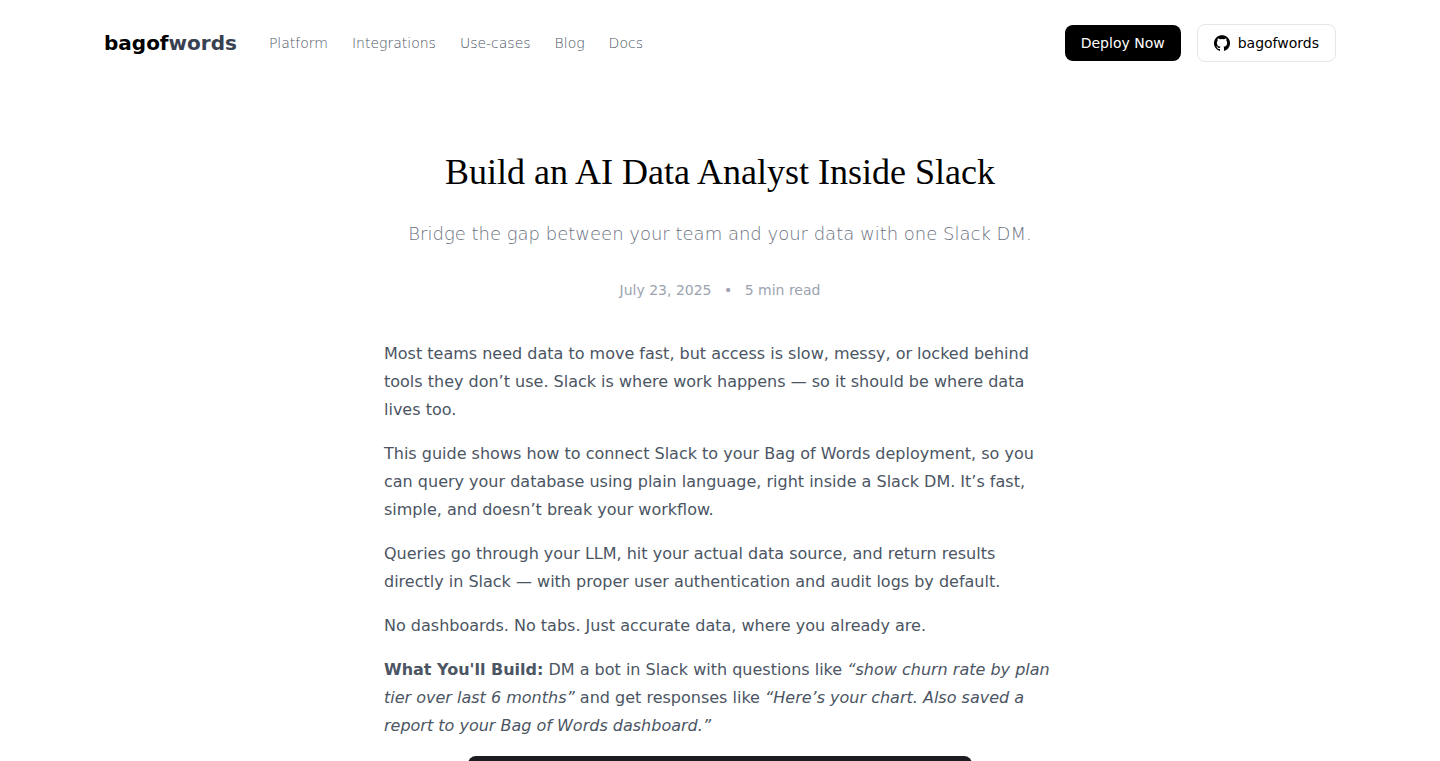
Author
y14
Description
SlackAIAnalyst is an open-source project that brings AI analysis directly into your Slack workspace. It uses a Large Language Model (LLM) and Python to allow you to ask questions about data, receive summaries, and perform analyses all within Slack. The core innovation is its self-hosted nature, giving users complete control over their data and preventing reliance on external services. It solves the problem of needing to switch between different tools for data analysis and allows for a more streamlined workflow within Slack. It also prioritizes data privacy by keeping everything on your own infrastructure. So, this is useful because you can analyze your data and get insights without leaving Slack and without sending your information to a third party.
Popularity
Points 3
Comments 0
What is this product?
SlackAIAnalyst is essentially a bot you can install in your Slack. It is built using a powerful AI called a Large Language Model (LLM) and coded in Python. This LLM can understand your questions, analyze data, and give you answers, all within your Slack channels. The innovation is that it runs on your own computers (self-hosted), so you keep complete control over your data. It is like having a smart assistant that can look at spreadsheets, text documents, or other data sources and explain the information to you. So, this is useful if you need to quickly get insights from your data without using external tools.
How to use it?
Developers can integrate this project into their Slack workspace by setting up a Python environment, installing the necessary libraries, and configuring the AI model. They will need to have their own server or computer to run the project. Then, they can interact with the bot in Slack by asking questions or providing the bot with data, the bot responds with the requested analysis. For example, you could upload a CSV file to the bot and ask it to summarize it, or ask the bot to explain a complex technical document. So, this is useful because you can easily customize the project to fit your specific needs.
Product Core Function
· Data Summarization: The bot can take large amounts of text or tabular data and summarize it, giving you the key takeaways. This saves you time from manually reading through data. Useful for summarizing meeting minutes, research papers, or sales reports. So, this is useful because you can quickly understand important information from large datasets.
· Question Answering: You can ask the bot specific questions about your data and it will provide answers based on the analysis. This is a great way to get information quickly without needing to manually process the data yourself. Use this for asking questions about your sales numbers, project status, or customer feedback. So, this is useful because you get quick answers to your specific queries.
· Trend Identification: The bot can analyze data to identify trends and patterns. It helps you see what's changing, where your focus should be, and make more informed decisions. Use this to identify growth trends in your sales data or see which products are performing well. So, this is useful because you can uncover insights that may have been missed otherwise.
· Self-Hosting and Privacy: Since the project is self-hosted, your data doesn't leave your control. The user's data stays private, helping ensure data security. Use this in areas where data privacy is extremely important. So, this is useful for organizations handling sensitive data that need to keep it completely secure.
Product Usage Case
· Technical Documentation Analysis: A software development team uses SlackAIAnalyst to quickly understand new technical documents and answer questions about code or system architecture directly within Slack. This saves them time by not having to switch to other tools. This is especially useful when onboarding new team members. So, this is useful because developers can better understand technical documentation and improve the speed of software development.
· Sales Reporting and Analysis: A sales team uses SlackAIAnalyst to upload their sales data and ask questions about performance metrics, like "What were our best-selling products last quarter?" The bot provides summaries, identifies top-performing products, and forecasts potential growth. So, this is useful because sales teams get real-time analysis and insights.
· Customer Feedback Summarization: A product team uses SlackAIAnalyst to analyze customer feedback from various sources, identifying common issues and feature requests. This helps them prioritize product improvements and understand customer needs. This allows teams to make data-driven decisions about improving product features. So, this is useful because it gives product teams faster access to customer insights.
43
Vivoldi: The Privacy-Focused & Feature-Rich URL Shortener
Author
hlyhfhl
Description
Vivoldi is a URL shortening service designed to give marketers, developers, and content creators more control over their short links. It addresses the common limitations of existing shorteners by offering features like real-time analytics, QR code generation, custom domains, password protection, and mobile deep linking. The core innovation lies in its focus on both functionality and privacy, allowing users to track link performance and manage their online presence more effectively.
Popularity
Points 2
Comments 1
What is this product?
Vivoldi is a web-based tool that takes long URLs and turns them into shorter, more manageable links. Its technical core involves a database that stores the original long URL and its associated short link alias. When someone clicks a short link, Vivoldi's server receives the request, looks up the long URL in its database, and redirects the user there. The innovative part is the added layer of features: real-time analytics (tracking how many clicks a link gets, where they come from), QR code generation (turning links into scannable codes), custom domain support (using your own domain name for your short links), and advanced control options like password protection and expiration dates. So what is the benefit? You can better understand your audience and manage links more effectively.
How to use it?
Developers can use Vivoldi through its web interface or potentially through an API (if one is offered, though it's not explicitly mentioned in the Show HN post). You paste in a long URL, customize a short alias (like 'vivoldi.com/myproduct'), and Vivoldi generates the short link and provides the related QR code and detailed analytics. Integration involves simply replacing long URLs in your marketing campaigns, social media posts, or mobile apps with the Vivoldi-generated short links. For instance, a developer could use it to shorten links to app downloads or product landing pages, then track how many clicks are coming from different sources. So you can easily manage your online content and track its performance, which can guide better marketing campaigns.
Product Core Function
· URL Shortening: This is the fundamental function. It takes a long, unwieldy URL and generates a shorter, more user-friendly version. This is technically achieved through a redirection service, where clicking the short link triggers a redirect to the original URL. Its application scenario is wide – sharing links on social media, print materials, or anywhere brevity is valuable. So this makes links easier to share and remember.
· Real-time Click Analytics: Vivoldi tracks how many times a short link is clicked, where the clicks are coming from (location, device), and potentially other details. This is achieved by logging each click request on the server and storing the relevant information. This allows users to measure the effectiveness of their links and track their audience. So you can get valuable insights into your audience's behavior.
· QR Code Generation: Vivoldi automatically generates a QR code for each short link. This is done by encoding the short link URL into a QR code image. This makes it easy to share links offline or in print materials, as people can scan the code with their smartphones. So you can get a fast and easy way to share the URL.
· Custom Domains: Users can use their own domain names for their short links (e.g., 'go.mycompany.com' instead of 'vivoldi.com/xyz'). This involves configuring DNS settings to point the custom domain to Vivoldi's servers. It improves branding and makes the links look more professional. So your brand is front and center, and it's more trustworthy.
· Link Management Features (Expiration, Password Protection, Fallback Links): These are advanced controls for managing links. Expiration automatically disables a link after a set time. Password protection requires a password to access the original URL. Fallback links redirect users to a different URL if the original link is broken. These features are implemented using server-side logic to check and redirect based on the user's configuration. These are great features for time-sensitive information or secure content. So you have more control over your links and prevent them from going to the wrong places.
· Mobile Deep Linking: The ability to open links directly into mobile apps (e.g., opening an Instagram post directly in the Instagram app). This is usually achieved by creating specific link formats or using app-specific URLs. It is useful for mobile app marketing, making the experience smoother for users. So users have a better user experience.
Product Usage Case
· A marketing team creates a short link using Vivoldi for a product promotion. They then share the link across social media and email campaigns. By using Vivoldi’s analytics, they can track how many clicks each platform is generating and optimize their marketing strategy accordingly. It is extremely useful for marketing measurement.
· A developer wants to share a link to download their mobile app. Using Vivoldi, they create a short link and a QR code, which is then printed on a flyer. They can monitor the number of downloads and the location of the users by viewing the analytics. So you can better understand user behavior.
· A content creator wants to make a password-protected link for premium content, such as a paid webinar or a digital download. This is done by configuring the Vivoldi link with a password, protecting the content from unauthorized access. So your valuable content is secure.
· A company uses custom domains to shorten links for all internal and external communications, enhancing their brand visibility and professionalism. So you can improve branding.
44
Confessional.dev: Anonymous Sins for Product Makers
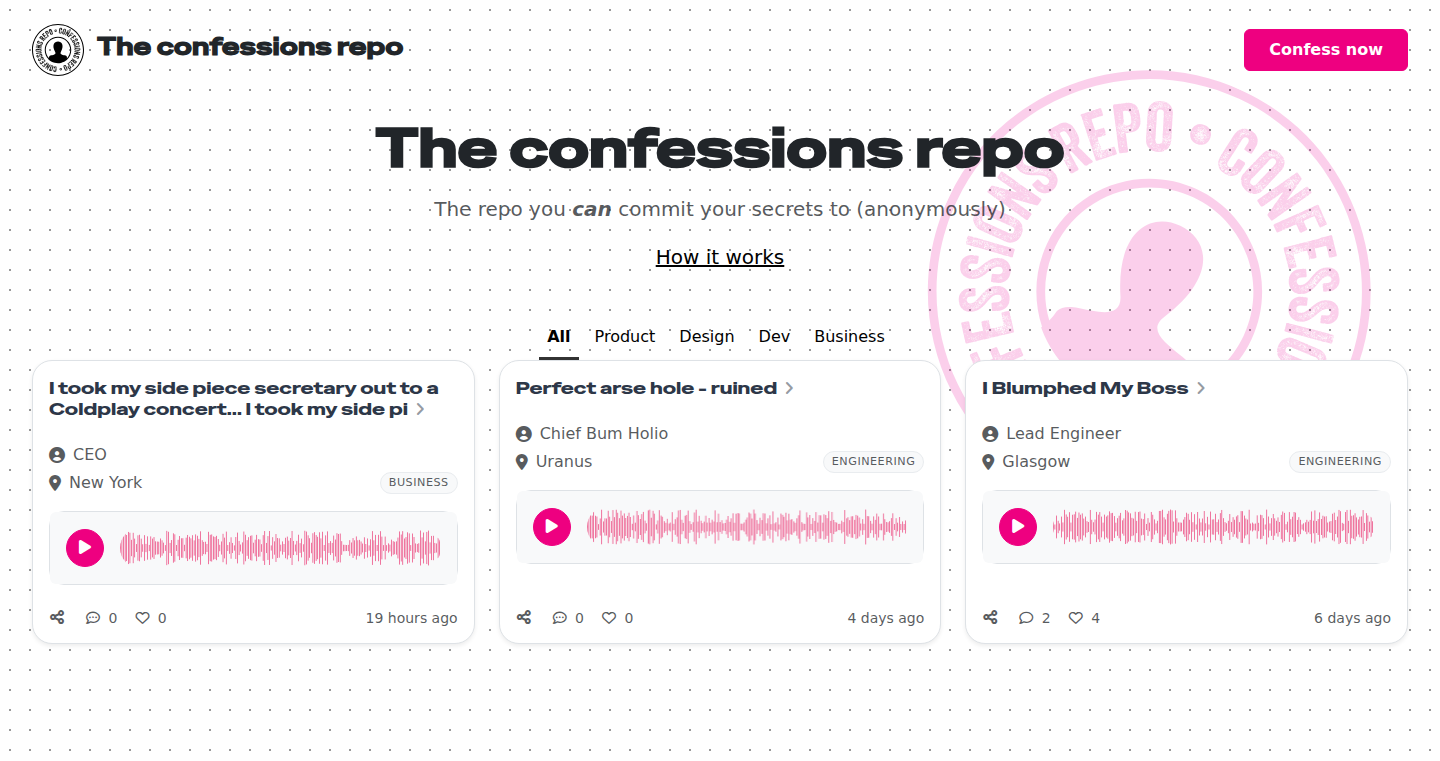
Author
gigamick
Description
This project is a simple web platform where product makers can anonymously confess their professional 'sins'. It's a fun experiment built with no account requirements, prioritizing ease of use and minimal friction. The core technical innovation lies in its simplicity: a bare-bones, ephemeral confession box with no user accounts or complex features, emphasizing quick expression and content sharing. It addresses the problem of providing a low-stakes, anonymous space for product people to vent and share experiences, fostering a sense of community through shared confessions.
Popularity
Points 3
Comments 0
What is this product?
Confessional.dev is essentially an anonymous message board tailored for product makers. It allows users to quickly post their 'sins' (e.g., mistakes, regrets, or humorous observations) without needing to create an account. The simplicity of the system, focusing on immediate content submission, is its technological core. It leverages minimal backend infrastructure to store and display these confessions, making it lightweight and easy to scale. So, it's a simple, quick, and anonymous platform for sharing professional product-related experiences.
How to use it?
Product makers can directly access the website and type in their confessions. There are no usernames or passwords to remember. Just type your thoughts and submit. Developers could use it as a model for creating similar anonymous feedback systems within their teams or for specific communities. The integration is as simple as accessing a website; there is nothing complex to integrate. This showcases the ease of building a simple, focused application that can be widely accessible.
Product Core Function
· Anonymous confession submission: Allows users to post their thoughts without revealing their identity. This is valuable because it encourages open and honest sharing, which might not happen in a non-anonymous setting. Imagine you could vent about your work with zero risk. That's the power of this feature.
· Ephemeral content display: The website likely displays confessions for a limited time, ensuring the platform does not become overly saturated with old content. This is beneficial because it keeps the content fresh and engaging, while also promoting a sense of urgency and ephemerality. This means what's on the site feels important, as it won't be there forever, which makes people pay attention.
· No account required: The absence of user accounts removes a major barrier to entry, making it easy for users to participate immediately. This is a key feature as it reduces friction and encourages casual use. This is super helpful because you can get instant feedback, share ideas, or just vent, and there's nothing to sign up for.
· Minimalist design: The simple interface and focus on core functionality are crucial. A clean design promotes ease of use and prevents the platform from being bogged down with unnecessary features. A clear focus on a singular experience: venting. So that’s what it does best.
Product Usage Case
· Building an internal team confession platform: A company could adopt this model to create an anonymous space for employees to voice concerns or share feedback. The team could use the same open source technologies to build it themselves.
· Creating an industry-specific anonymous forum: Developers could adapt the concept to create confession platforms for different industries (e.g., developers, designers, marketers) to facilitate discussions and sharing of experiences within these specialized communities.
· Rapid prototyping for quick feedback collection: Developers can use this basic framework to quickly test the waters when collecting feedback or opinions in a time crunch for a particular group. You could get real-time insights without user registration, which is incredibly useful for getting an idea of what people are really thinking.
45
SparkJSON: Local Text-to-JSON Transformer with GitHub Spark
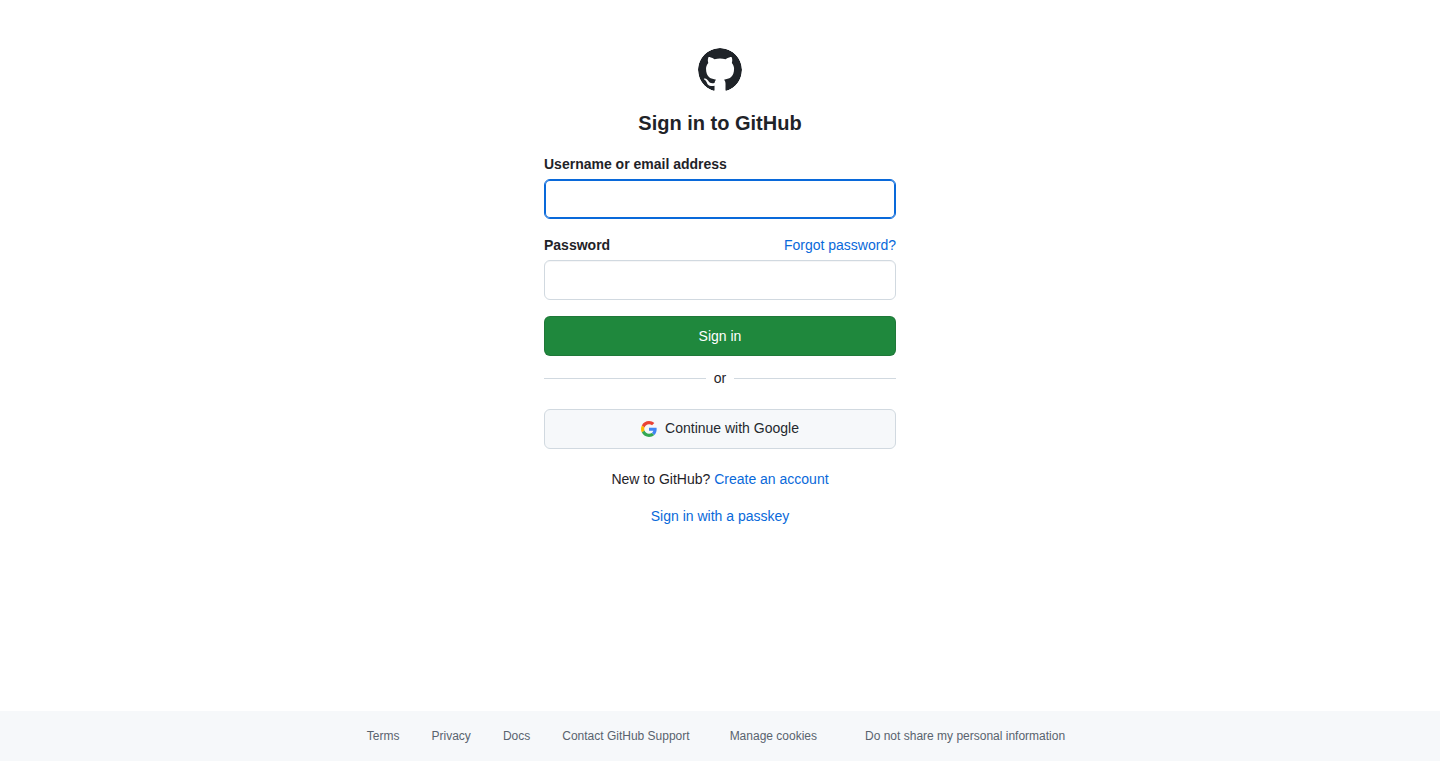
Author
tarasyarema
Description
SparkJSON is a local command-line tool that converts unstructured text data into structured JSON format, leveraging GitHub Spark for its underlying computational engine. The innovation lies in its ability to process text directly on a local machine, avoiding the need for cloud-based solutions or complex configurations. It simplifies the transformation process, making it accessible for developers of all skill levels, especially those working with data that doesn't warrant a full-blown big data setup. So this allows you to easily structure your unstructured text data and work with it efficiently. It helps quickly convert text logs, configuration files, or any other text-based input into a usable JSON format, saving valuable time and effort.
Popularity
Points 2
Comments 1
What is this product?
SparkJSON transforms text into JSON. It does this locally, meaning no internet connection or complicated setups are required. It uses a powerful engine (GitHub Spark) to quickly convert the text. Imagine you have a messy text file, and you want a nicely organized JSON file. SparkJSON makes that happen. The main innovation is the ease of use and the local processing capability. Instead of relying on external services or complicated scripts, you just run a command, and you get JSON output. So it's like having a smart assistant right on your computer that helps you structure your text data without sending it anywhere.
How to use it?
Developers can use SparkJSON through the command line. You'd provide the text file as input, and SparkJSON outputs the JSON version. You could integrate it into your data processing pipelines, scripting workflows, or debugging tools. For example, you can parse web server logs, config files, or any text-based data. Imagine you're building a website and your server logs are in a text format. You can use SparkJSON to convert those logs to a structured JSON format and analyze them for errors or usage patterns. So this tool becomes handy when you need to quickly structure your unstructured text data, and automate repetitive data conversion tasks.
Product Core Function
· Text-to-JSON Conversion: This core function is the ability to transform any text input into a JSON output. This is valuable because it allows developers to easily structure unstructured data, making it easier to work with in programming applications. Imagine converting a log file, a configuration file, or a set of search results into JSON format, where each data element can be easily parsed and utilized in your application. So, this is immediately useful for any developer working with data.
· Local Processing: SparkJSON performs the transformation locally, without the need for cloud services or internet connectivity. This is beneficial for sensitive data, offline environments, and situations where the speed of data processing is crucial. Think of a developer analyzing internal logs, or a security professional processing security audits. So, if your data needs to stay local, this is essential.
· Command-line Interface: Offers a simple command line interface that makes it easy to use and integrate into existing workflows. This allows for scripting and automation of the conversion process. It can integrate into scripts or build pipelines. For example, you can feed the output of other commands directly into it. This ease of use makes it a simple, quick way to parse and prepare data for analysis or consumption by another program. So, it's great for building automated data pipelines and workflows.
· GitHub Spark Integration (Underlying Engine): Uses GitHub Spark which provides efficient processing and is designed for performance and scaling within the local machine. This means your text-to-JSON conversion is fast. So, you can work with larger datasets or perform conversions without performance bottlenecks.
Product Usage Case
· Log Analysis: A developer has text-based web server logs and needs to analyze errors. SparkJSON converts the logs to JSON, making them easily searchable and analyzable with tools like jq or Python. You can quickly filter by error codes, timestamps, or request URLs. So you can get insights from your server logs without complex scripting.
· Configuration File Parsing: A developer is working on a system that uses many configuration files. The developer uses SparkJSON to convert those text-based config files to JSON, allowing them to easily parse them with scripts and automate configuration changes. So, instead of manually editing, you can automate many configuration tasks.
· Data Scraping and Processing: A developer scrapes data from a website that provides data in text format. SparkJSON helps to convert this raw text into JSON format so that the data can be used in APIs or the developer's applications. So, quickly process and organize the scraped data for further analysis and utilization.
· Automated Data Migration: A developer is migrating data from legacy systems that export data in a text format. SparkJSON converts the text data into JSON, then easily importable to the new system. So, you can quickly and reliably transform your old data and migrate to modern systems without data loss.
46
Jina: AI-Powered Synthetic Users for App Testing
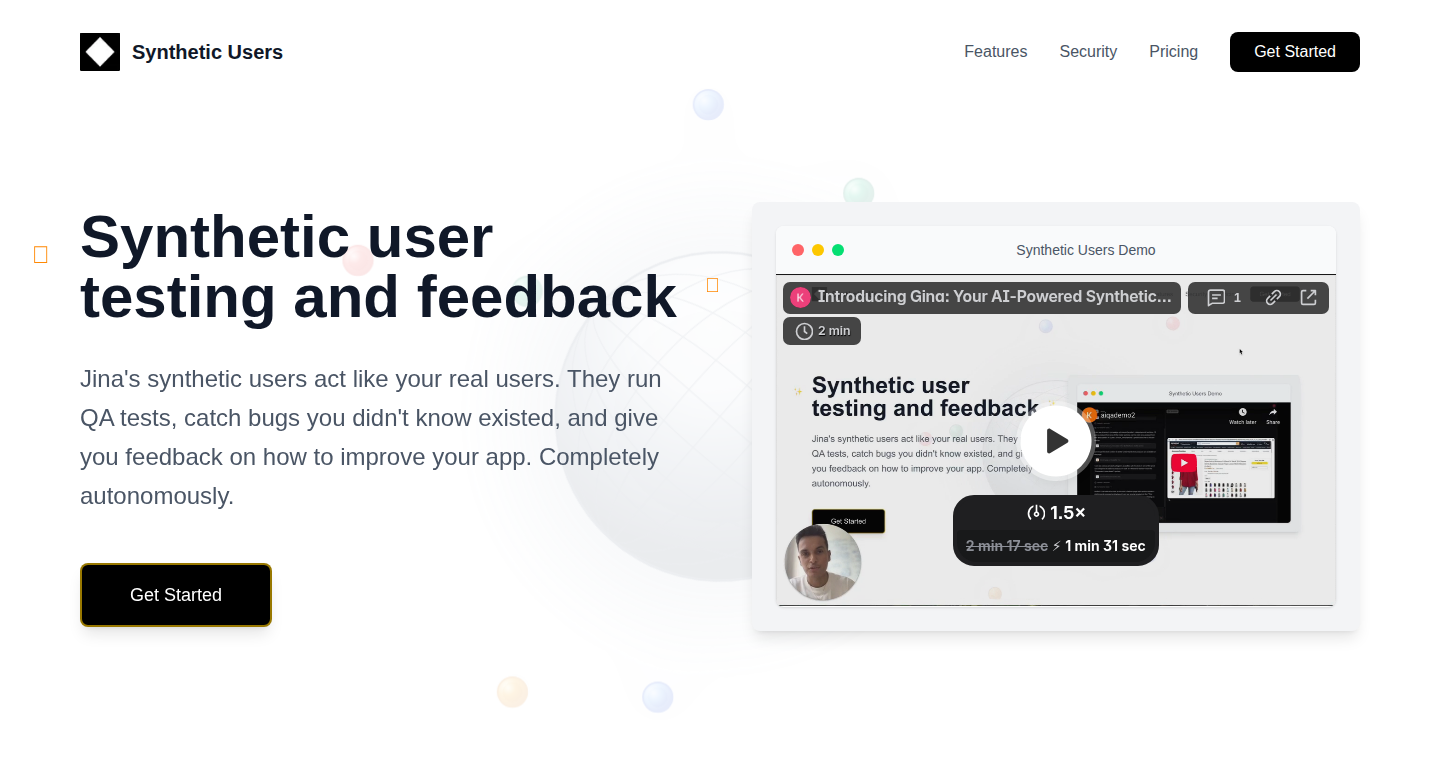
Author
fearlessboi
Description
Jina leverages the power of artificial intelligence to create synthetic users that can test your application, identify bugs, and provide valuable feedback. It goes beyond traditional testing by simulating real user behavior, allowing developers to catch issues from a user's perspective and improve overall application quality. The core innovation lies in its ability to generate test cases from simple prompts, eliminating the need for extensive manual test creation and maintenance. Jina allows you to effectively test your application by embodying a user's persona, exploring your app in a way that mimics real-world usage and exposing potential bugs that might otherwise be missed.
Popularity
Points 2
Comments 1
What is this product?
Jina uses AI to create 'synthetic users' – essentially digital personas that can interact with your application. You give Jina a simple instruction (a prompt), and it generates test cases, explores your app, and identifies problems, just like a real user would. This is different from traditional testing because it understands how a user would actually interact with the app. So, it helps find problems that you might not find with regular testing. The innovative part is that it takes a simple description and turns it into actionable tests, saving you time and effort.
How to use it?
Developers can integrate Jina into their existing testing workflows. You provide Jina with a prompt that describes the user's desired action or scenario, for example, "A user tries to reset their password and receives a verification code." Jina will then generate a test case that simulates this action. You can then analyze the results to identify any bugs or areas for improvement. This is particularly useful for continuous integration and continuous delivery (CI/CD) pipelines, allowing for automated testing and feedback with minimal manual intervention.
Product Core Function
· Prompt-to-Test Generation: Jina can translate simple instructions (prompts) into comprehensive test cases. This significantly reduces the time and effort needed to create and maintain test suites. This is useful because it makes testing quicker and easier.
· Synthetic User Emulation: Jina creates digital users that can mimic actual user behavior, offering a more realistic testing environment compared to traditional methods. So, you can find those tricky bugs that might slip through other tests.
· Automated Bug Detection: Jina automatically identifies bugs and issues within the application based on the synthetic user's interactions, and offers suggestions to resolve. Because it provides useful information to improve the quality of your software.
· User Persona Modeling: Jina can take on a user's persona, allowing developers to test their app as that user would. Allows the developer to see the user experience firsthand and solve UX issues.
· Feedback and Reporting: Jina provides detailed reports and feedback on the app's performance and user experience, helping developers to identify and address areas for improvement.
Product Usage Case
· Testing E-commerce Platforms: A developer could use Jina to test a product search function. The prompt might be "A user searches for 'red shoes' and filters by size 8." Jina would then run the search and filters, verifying the results. So, you ensure a user can quickly find what they want.
· Validating User Authentication: A developer could use Jina to simulate the login and registration process. For example, "A new user signs up with a valid email and password, then logs in." Jina would test the user's ability to successfully register, receive verification emails, and log into the app. This ensures the security and functionality of your authentication system.
· Testing Complex Workflows: Consider a complex app with multiple steps, like a financial application. Developers can test the entire user journey, such as "A user transfers money from their savings account to their checking account." Jina will guide the user through the process, verifying each step and checking for errors. By using this, you test your software by simulating complex user journeys.
· Mobile App Testing: Jina can be used to test mobile apps on various devices and operating systems. It can automatically navigate different screens, interact with UI elements, and simulate user gestures. So, it ensures that your app works flawlessly across different devices and platforms.
47
Marchat: Terminal-Based Real-Time Group Chat
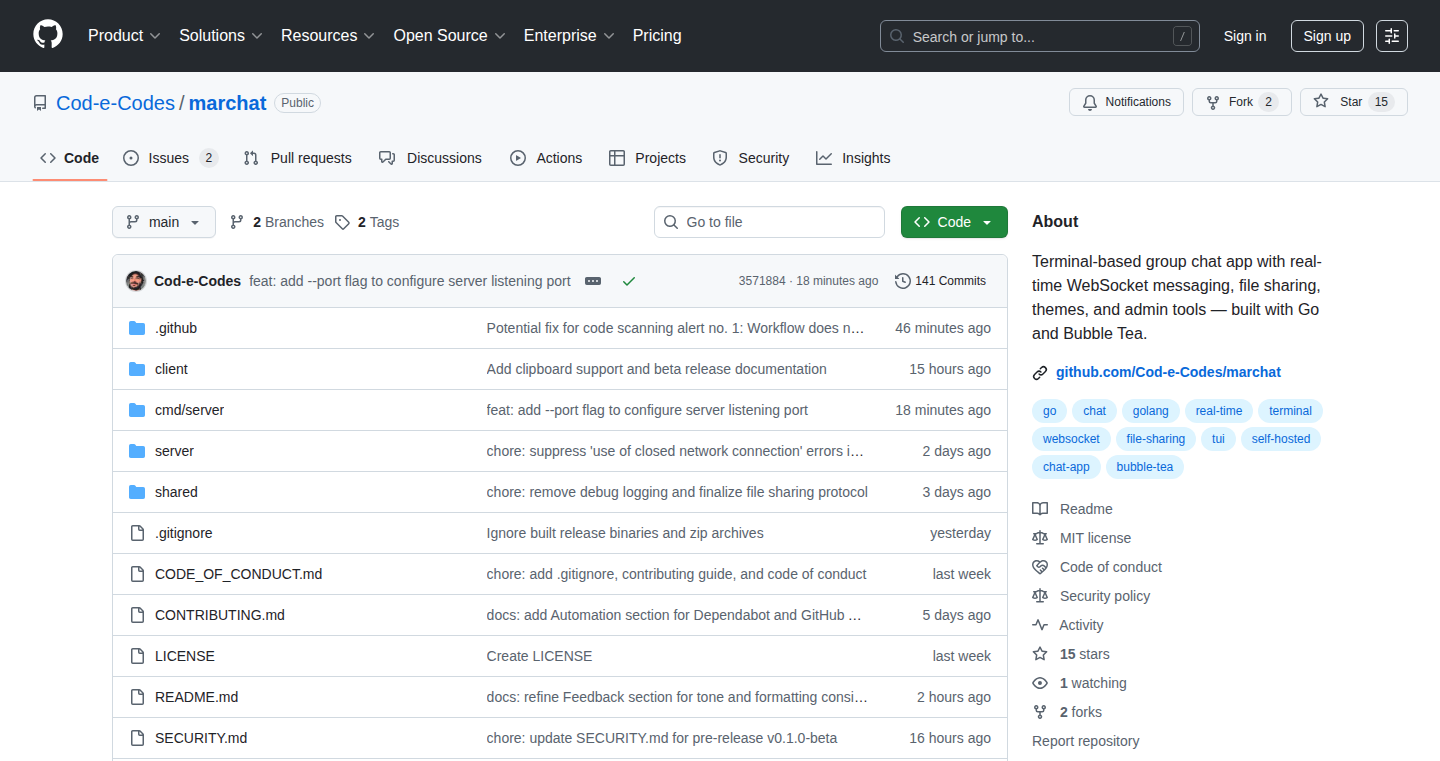
Author
Cod-e-Codes
Description
Marchat is a group chat application that runs entirely in your terminal, built with Go. It leverages the Bubble Tea UI library for a visually appealing terminal interface and a WebSocket backend for real-time communication. The project focuses on being lightweight, self-hostable, and accessible directly from the command line. This offers a unique approach to group chat, emphasizing simplicity and control for users, solving the need for a chat experience that's independent from web browsers and dedicated applications.
Popularity
Points 3
Comments 0
What is this product?
Marchat is like a chat room, but it lives inside your terminal. It uses a programming language called Go to handle the backend, making it fast and efficient. The interface, built with Bubble Tea, lets you see everything and interact with the chat right in your terminal window. It uses WebSockets, a technology that allows for instant updates and real-time communication, so you can see messages as soon as they are sent. The project distinguishes itself by offering a lightweight, terminal-first experience, which is perfect for developers and tech enthusiasts. So what's the point? It gives you a chat tool that doesn't rely on web browsers or dedicated apps, putting you in control.
How to use it?
Developers can use Marchat by downloading and running it in their terminal. You can set it up on your own server (self-hosting), giving you full control over your chat data. You can configure the chat using a JSON file to customize settings like the theme. Think about setting up a chat room for your development team, or using it for project collaboration right in the terminal. Its features like file sharing and admin tools make it a versatile option. So what's the point? Use it for quick communication, collaboration, and a more direct way to communicate within your development environment.
Product Core Function
· Group Chat with Theming: This enables multiple users to communicate in real-time, and the theming allows for customizing the appearance of the chat window (colors, fonts, etc.) to improve readability and personal preferences. Application: Team communication, brainstorming sessions, or any collaborative environment where you want an easily accessible chat solution.
· JSON-Based Configuration: This means that you can customize the chat settings by editing a JSON file. This includes things like server settings, theme, and user permissions. Application: Easily personalize the chat application without code changes, making it suitable for different users and setups.
· File Sharing: This functionality permits users to send and receive files within the chat, eliminating the need to separately share files via email or other tools. Application: Quick file exchange during collaborations, exchanging code snippets, or sharing documentation, all within the chat.
· Admin Tools: This provides administrators with control over the chat, letting them manage users, moderate content, and maintain the chat's health. Application: This can be used for managing users, handling issues, or keeping the chat functional, providing a reliable communication channel.
Product Usage Case
· Development Team Collaboration: A team of developers can use Marchat for quick code reviews, discussing issues, sharing debugging output, and coordinating development efforts directly from their terminals. So what's the point? Quick and easy communication without switching tools.
· Self-Hosted Chat Server for a Small Community: A tech community can set up Marchat on their own server. This allows them to have a chat space where they control their data, and have a lightweight, terminal-based communication tool. So what's the point? Control over the chat environment and data privacy.
· Integrating Chat into a DevOps Workflow: System administrators or DevOps engineers could use Marchat to monitor server activity, send alerts, and communicate about system events from the command line. So what's the point? Streamlined communication and real-time notifications within their existing workflow.
48
LightLayer: Voice-First AI Code Review
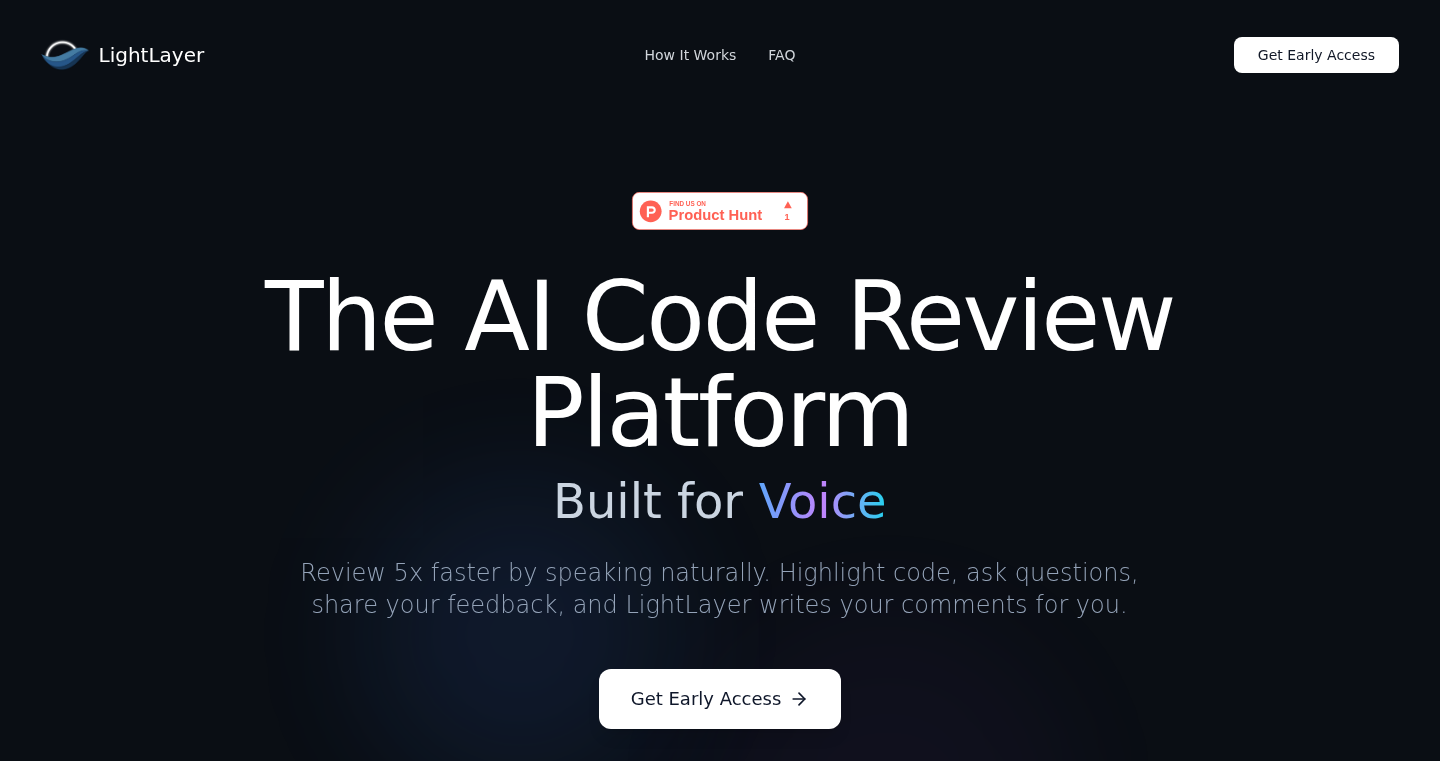
Author
changisaac
Description
LightLayer is a revolutionary code review platform that utilizes voice and AI to speed up the code review process. It leverages voice-based interaction and AI to mimic a real-time walkthrough of the code with the author, allowing engineers to review code up to 5x faster. This addresses the growing bottleneck in software development where reviewing and understanding code often takes more time than writing it. The platform integrates AI to answer questions and draft comments in real-time, making the review process more efficient and collaborative.
Popularity
Points 3
Comments 0
What is this product?
LightLayer is a voice-controlled platform that uses Artificial Intelligence to help developers review code. Instead of reading lines of code and typing comments, you can talk to LightLayer. The platform employs AI to understand your questions and suggest improvements, making the code review process faster and more intuitive. It’s like having a conversation with the code author, but the AI handles the grunt work. So, it helps you quickly understand what the code does, identify potential issues, and provide feedback without getting lost in endless lines of text. So what's in it for me? It drastically cuts down the time you spend reviewing code, freeing you up to focus on more important tasks like building and innovating.
How to use it?
Developers can use LightLayer by integrating it with their existing code repositories. When a pull request is opened, the reviewer can interact with LightLayer using voice commands. LightLayer will then analyze the code, answer questions about the code's functionality, and generate comments based on the reviewer's input. The platform integrates with code hosting platforms like GitHub and GitLab. Developers can also sign up on the LightLayer website and then, install a browser extension or integrate with a code editor. This allows for seamless integration into the existing development workflow. So, it’s a simple process; talk to LightLayer, get instant feedback, and improve your code with ease.
Product Core Function
· Voice-based Code Navigation: Allows developers to navigate through code using voice commands, similar to a conversation. This speeds up the process of understanding the code's structure and logic. It's useful in any code review situation, especially for large codebases where manual navigation takes a long time.
· AI-Powered Code Understanding: Utilizes AI to provide explanations of code sections and their functionality. This is very useful when you need to quickly grasp what a piece of code does. If your team is new and not all members know the system, it is even more useful
· Real-time Comment Generation: Generates comments and suggestions based on the reviewer's questions and feedback. This saves time and ensures that the comments are relevant and precise. Think of it when you are reviewing a pull request, and you don't know how to explain a thing. The AI will assist you.
Product Usage Case
· Scenario: A software engineer is reviewing a new feature implemented by a team member. They use LightLayer to quickly understand the new code by asking questions about specific functions and logic. The AI generates comments suggesting improvements to the code, saving time and ensuring the feature is well-documented. This is a common scenario when a developer is asked to do a code review.
· Scenario: A team is working on a large project, and new developers are joining. LightLayer enables them to quickly understand the existing codebase through voice commands and AI-powered explanations, accelerating their onboarding process. This is useful for onboarding new developers or for cross-team collaborations where developers need to understand code written by others.
· Scenario: During a code review, a developer struggles to understand a complex algorithm. Using LightLayer, they can ask specific questions about the algorithm, and the AI provides explanations and suggests improvements. This helps the developer to understand, improve and maintain their code
49
BatchRenameOCR: A PDF Batch Renaming Tool with OCR Capabilities

Author
Neuronree
Description
BatchRenameOCR is a command-line tool designed to automatically rename a large batch of PDF files based on their content. It utilizes Optical Character Recognition (OCR) to extract text from each PDF, effectively allowing users to rename PDFs by their content instead of their filenames. This addresses the common problem of having PDFs with generic or meaningless names, making it difficult to quickly identify and organize documents. The tool's innovation lies in its ability to automate the process of extracting and using text from within PDF files for renaming purposes. So, this means if you have a bunch of PDFs with filenames like 'document_001.pdf' and you want to rename them based on the text inside (e.g., the title or author), this tool does the job automatically.
Popularity
Points 1
Comments 1
What is this product?
BatchRenameOCR uses a combination of technologies. First, it uses a library called Tesseract OCR to 'read' the text inside the PDF files, converting the images of text into actual text characters. Then, it uses a regular expression engine to extract relevant information (like document titles or author names) from the extracted text. Finally, it renames the PDF files based on the extracted text, providing a way to bulk rename documents based on their content. The key innovation is the automation of this process – previously, one would have to manually open each PDF, read the content, and rename the file. This tool streamlines the process substantially.
How to use it?
Developers would typically use BatchRenameOCR through the command line. They would install the tool (potentially with package managers like `pip` if written in Python), then use command-line arguments to specify the directory containing the PDF files, define rules for extracting text, and configure the renaming scheme. For example, the command might look like `batchrenameocr -d /path/to/pdfs -p 'title: (.+)' -f '{title}.pdf'`, which extracts the title from the PDF content and renames the files using the extracted title. This is useful for organizing scanned documents, scientific papers, or any PDFs where the original filenames are not descriptive. So, you can integrate this into scripts or workflows to automate document management.
Product Core Function
· OCR-based Text Extraction: The core function uses OCR to read the text content of PDF files. This is valuable because it allows the tool to 'understand' the content of the PDFs, regardless of their original filenames, making it suitable for scanning paper documents and digital PDFs alike. So, this allows the tool to work with a wide range of PDF formats.
· Regular Expression-based Information Extraction: After extracting text with OCR, the tool uses regular expressions to identify and isolate important information (e.g., document titles, dates, authors). This enables the tool to filter and extract exactly the needed information. So, you gain precise control over what information to use for renaming.
· Batch Renaming: This function takes extracted information and renames multiple PDF files in a single operation. It streamlines the tedious process of renaming files manually. So, this saves a significant amount of time when dealing with large document collections.
· Command-Line Interface: Provides a user-friendly command-line interface for ease of use and integration with other tools and scripts. This is valuable for automating repetitive tasks and creating custom workflows. So, it lets you integrate the tool seamlessly into your existing automation processes.
Product Usage Case
· Academic Research: A researcher has a large collection of PDFs of research papers, but all the filenames are generic (e.g., 'paper1.pdf', 'paper2.pdf'). Using BatchRenameOCR, they could extract the paper titles and rename the files accordingly, enabling easy searching and organization. So, it improves organization and searchability in academic work.
· Document Management: A company receives scanned invoices and contracts without descriptive filenames. BatchRenameOCR can extract key information (invoice numbers, contract dates) and rename the files automatically. So, it streamlines document archiving and retrieval.
· Digitization Projects: In digitizing old archives, where file names are meaningless, BatchRenameOCR helps automatically rename the scanned documents based on their textual content, making them easily searchable. So, it makes scanned archives more accessible.
50
PTS (Pivotal Token Search): Unveiling LLM Reasoning with Thought Anchors
Author
codelion
Description
PTS is an open-source library designed to help us understand how large language models (LLMs) like GPT-3 or similar ones actually "think" when solving problems. It focuses on identifying the key steps – or "thought anchors" – within an LLM's reasoning process that are crucial for getting the right answer. Think of it as a tool that pinpoints the most important sentences in a model's thought process. It uses a technique called counterfactual analysis to see what happens if a specific step is removed, helping us understand the impact of each step. It provides semantic embeddings for clustering analysis and systematic failure mode categorization.
Popularity
Points 2
Comments 0
What is this product?
PTS is a library that helps analyze the reasoning process of large language models. It does this by identifying the most impactful sentences, called “thought anchors,” in the model’s reasoning chain. It uses a technique of removing a part of the thought process (counterfactual analysis) to see how much this hurts the final result. This reveals the steps that really matter. It also provides extra information, like semantic embeddings, so you can analyze the data further. It's all about understanding *why* an LLM gets to a certain answer and where it might be going wrong.
How to use it?
Developers use PTS by first specifying the LLM they want to analyze and the type of problem they're interested in, like math problems. The library then generates reasoning traces from the LLM. It analyzes these traces and identifies the "thought anchors." The output can then be analyzed to understand the model's reasoning strategy, identify patterns, and pinpoint potential weaknesses. The quick start involves running a command-line interface to generate thought anchors and then exporting the data for detailed analysis. For example, one could run `pts run --model="your-model" --dataset="gsm8k" --generate-thought-anchors` and then `pts export --format="thought_anchors" --output-path="analysis.jsonl".
Product Core Function
· Generates chain-of-thought reasoning traces: This means the library tracks the step-by-step thinking process of an LLM. This is like recording the LLM's rough work when solving a problem. This helps developers understand exactly what steps the LLM takes. So this is useful for understanding exactly how the LLM solves a problem and what its thought process looks like.
· Uses counterfactual analysis to measure impact: It uses a technique where it temporarily removes a part of the reasoning process to see how it impacts the final answer. This helps determine which parts are most important and influential. This is useful for understanding which parts of the LLM's thought process are the most important. It helps find the core building blocks of its logic.
· Identifies critical sentences that make-or-break task completion: The library identifies the most critical sentences (the thought anchors) that significantly impact the LLM's ability to complete a task correctly. This is useful for finding the crucial parts of the reasoning process. This helps to pinpoint exactly where an LLM may be making critical errors and why.
· Exports semantic embeddings for clustering analysis: PTS provides a way to represent the meaning of sentences (embeddings) that allow you to group similar reasoning steps together. This gives you a better understanding of the types of reasoning the LLM is doing. This helps visualize the different types of reasoning that the model uses. This helps the developer in finding patterns in the LLM’s reasoning, and what are the main ideas behind its answers.
· Provides systematic failure mode categorization: The library helps categorize why an LLM might fail at a task. It helps pinpoint recurring issues in the LLM’s thought process. This is useful for identifying and understanding common pitfalls in the LLM’s reasoning strategy. This makes it easier to improve the LLM's performance by addressing specific weaknesses.
Product Usage Case
· Comparing reasoning architectures of different LLMs: Used to compare the reasoning styles of different LLMs (e.g., Qwen3-0.6B vs. DeepSeek-R1-Distill-1.5B) on math problems, revealing that they employ distinct reasoning approaches – one using concentrated reasoning and the other distributed. So this is useful for selecting the right model for the job, and making the choice between models more data-driven.
· Understanding Model's Reasoning Strategy: By identifying thought anchors, developers can understand how the LLM approaches problems, providing insights into its internal logic and decision-making process. So this is useful for building trust in the model's output because you can see why it is arriving at those answers.
· Debugging and Improving LLMs: Developers can use PTS to pinpoint areas where an LLM struggles, enabling targeted improvements to its architecture, training data, or prompting strategies. So this is useful for fixing problems and improving the reliability of the LLM.
· Creating Explainable AI (XAI) systems: The insights generated by PTS can be used to make LLM's reasoning process more transparent and explainable to users, increasing the trustworthiness of AI systems. So this is useful for helping users understand why the LLM does what it does, increasing the utility of the LLM.
· Researching LLM Behavior: The library provides researchers with a powerful tool to study the inner workings of LLMs, contributing to a deeper understanding of their capabilities and limitations. So this is useful for understanding how LLMs actually work, accelerating the field of AI.
51
SaveTo: Chat-Based Smart Bookmark System
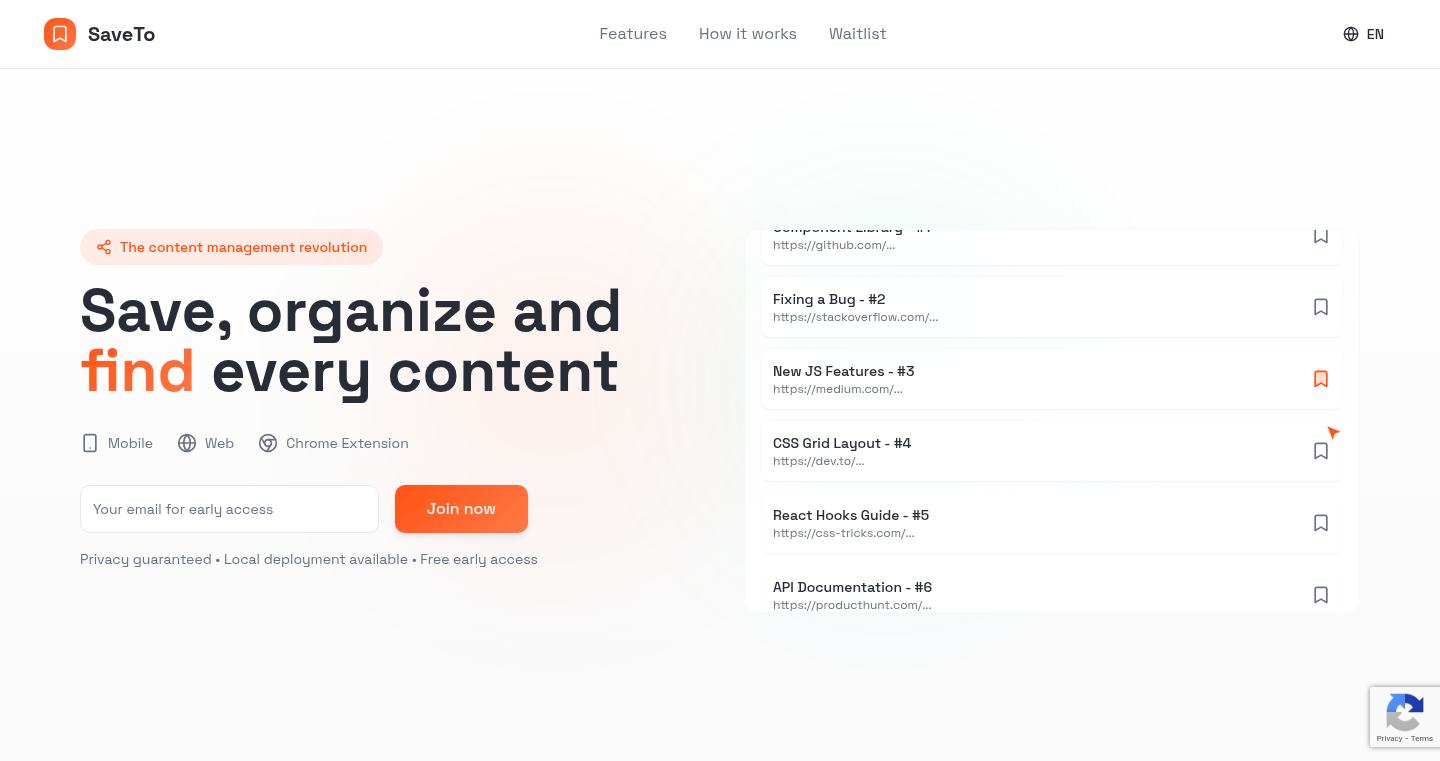
Author
MicheleLacorte
Description
SaveTo is a cross-platform application designed to solve the common problem of forgotten bookmarks. It allows users to save links and texts through a simple chat interface, making retrieval easy even if you forget the website name or where you saved it. The innovation lies in its chat-based retrieval system, which makes accessing saved information much more intuitive and accessible compared to traditional bookmarking tools. This addresses the frustration of lost information and streamlines knowledge management.
Popularity
Points 2
Comments 0
What is this product?
SaveTo is a system that lets you save links and text snippets via chat. Instead of relying on remembering website names or navigating complex folders, you can retrieve your saved content simply by chatting with the app. It uses a smart search algorithm to find what you need, even if you don’t remember the exact details. So, if you're tired of losing important links, this simplifies how you keep track of information.
How to use it?
Developers can integrate SaveTo into their workflow by saving useful documentation links, code snippets, or any relevant information directly through chat. This can be achieved by using its API or through direct messaging interfaces (if supported). This means less time spent searching and more time coding. For example, share a link of a coding problem via chat and SaveTo keeps track of the context in an easy-to-search manner.
Product Core Function
· Chat-Based Saving: Allows saving links and text directly via a chat interface. This simplifies the initial saving process. So this means you don't need to open up a separate bookmarking tool and you can save important links with ease, allowing you to focus on the task at hand.
· Smart Search: Enables retrieval of saved content using keywords or partial information, without needing to remember the exact website name or URL. This removes the hassle of sifting through countless bookmarks. So this helps you quickly find saved information without precise recall.
· Cross-Platform Compatibility: Works across different platforms. This provides flexibility and accessibility regardless of the device used. So this ensures you can access your bookmarks from anywhere, whether it's your phone, tablet, or computer.
· Contextual Understanding (Implied): It probably analyzes the content being saved, attempting to understand the context of the content to provide more intelligent search results (though this is speculation based on the description). This improves the relevancy of search results. So this means the application can better understand your data, improving search results and accuracy
Product Usage Case
· Developer Documentation Management: A developer can save links to important documentation pages as they encounter them. Then, when needed, a simple search for a related term retrieves the relevant document, significantly speeding up research and development. So this greatly streamlines finding and using documentation.
· Code Snippet Storage: Developers can save useful code snippets with brief descriptions via chat. When faced with a similar problem in the future, a search for the relevant keywords will return the code snippet. So this boosts code reusability and reduces development time by removing the need to look the code from scratch.
· Team Knowledge Sharing: A development team can use SaveTo to collaboratively share important links and information. This centralized repository fosters a more informed and efficient team environment. So this can improve team collaboration and makes sure important resources are easily accessed by everyone.
52
RewriteBar v2.13.2: The Intelligent Code Snippet Transformer
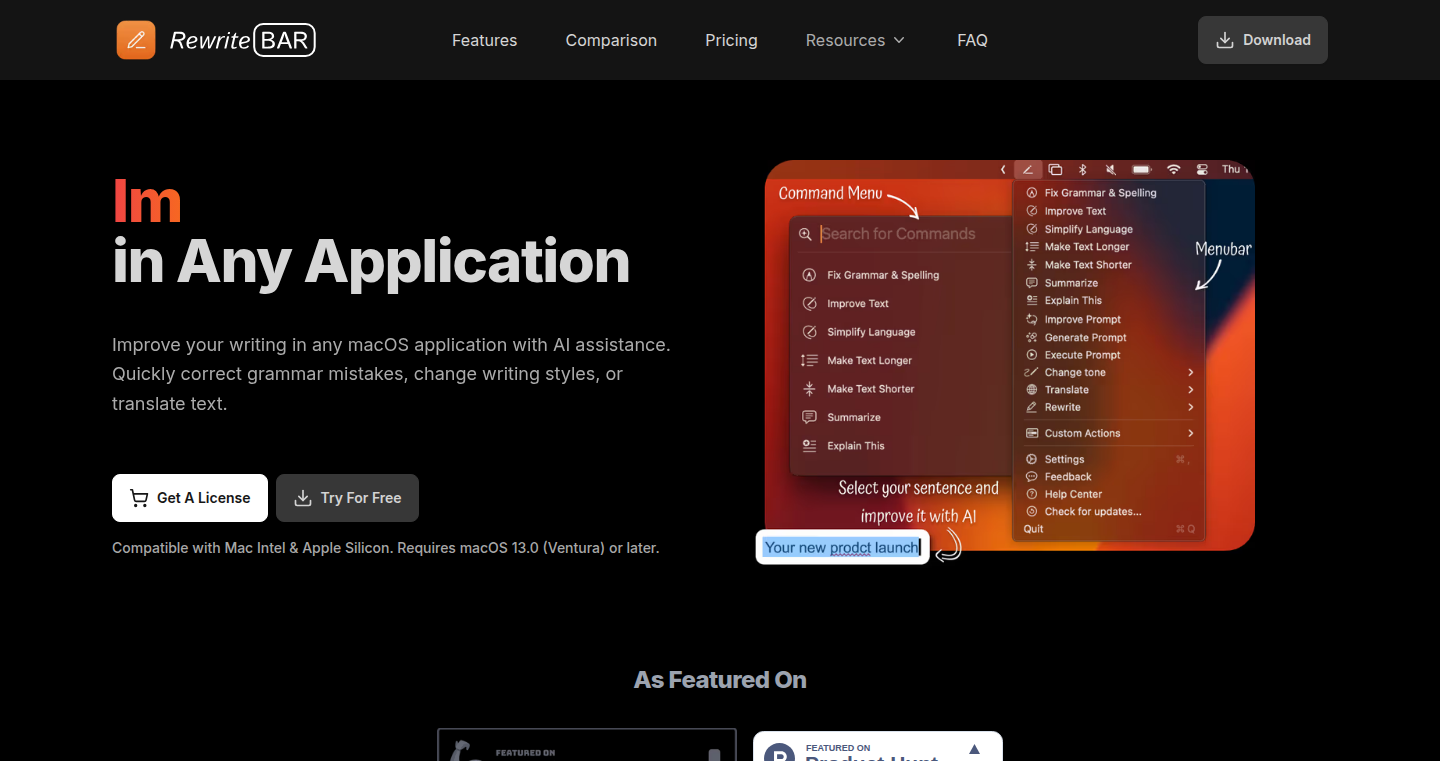
Author
m4thias
Description
RewriteBar v2.13.2 is a browser extension designed to streamline the code review process and code snippet management. It allows developers to easily manage and apply code transformations, facilitating faster and more efficient coding. The key innovation lies in its ability to integrate with different code review tools and provide a centralized, easy-to-use interface for managing code snippets, translating across multiple coding languages and applying them directly within the browser. This addresses the common problem of repetitive coding tasks and the need for consistent code style across a project, saving time and improving overall code quality. So this means you can save time and ensure consistent code style.
Popularity
Points 1
Comments 1
What is this product?
RewriteBar is essentially a smart assistant for your browser when you are coding or reviewing code. Think of it as a mini code compiler inside your web browser. It takes code snippets, and allows you to make changes such as converting between different languages or applying common fixes or improvements automatically. It integrates with the popular development tools so that it can work in the workflow you're already familiar with. The innovation is the quick management of different languages and the automation of repetitive tasks. So this gives you a way to customize and automate code snippets for efficiency
How to use it?
Developers use RewriteBar by installing it as a browser extension. Once installed, they can input code snippets, define transformation rules (e.g., converting Python to JavaScript), and apply these transformations directly within the browser. The extension then interacts with popular code review tools to automatically format and fix code. This enables developers to quickly adapt code, ensuring a consistent code style. For example, if you are reviewing a pull request from a team member in Python, and your project is primarily in JavaScript, RewriteBar can quickly translate the code for you. This makes code reviews faster and easier. So, with this tool, you can quickly translate and refactor the codes.
Product Core Function
· Code Snippet Management: The core of RewriteBar's functionality is its ability to store and manage code snippets. Developers can save frequently used code blocks and re-use them across multiple projects. The value is reducing the need to constantly re-write the same code. This saves a significant amount of development time.
· Code Transformation: RewriteBar offers built-in code transformation features, enabling developers to convert code between different programming languages or apply automated code style fixes. This is especially helpful when collaborating on multi-language projects, allowing for consistent code formatting. This tool lets you easily convert between languages, and apply style guidelines.
· Integration with Code Review Tools: The extension provides integration with common code review platforms, allowing developers to apply code transformations and fixes during the code review process. This enables faster and more efficient code reviews, making the review process more effective.
· Customizable Rules: Developers can create custom transformation rules. This allows the user to adapt RewriteBar's functions to specific coding standards or requirements. The custom rules allow for highly specific and automated fixes or changes, tailoring the tool for your own needs.
Product Usage Case
· Cross-Language Projects: When working on a project that utilizes both Python and JavaScript, a developer can use RewriteBar to convert code snippets between these two languages. This enables the developer to review the code and ensure consistent style.
· Code Review Automation: In a collaborative project, the tool can automatically format and enforce coding style guidelines during the code review. This guarantees that all code in the project adheres to the same coding standards. The advantage is the code quality and consistency are improved.
· Rapid Prototyping: Developers can use RewriteBar to quickly generate code prototypes. By applying code transformation rules to generic code templates, they can create functioning code quickly.
· Legacy Code Maintenance: When working with older codebases, developers can use RewriteBar to apply automated code fixes and modern formatting guidelines, improving readability and maintainability.
53
GitBreakout: A Breakout Game Driven by GitHub Contributions
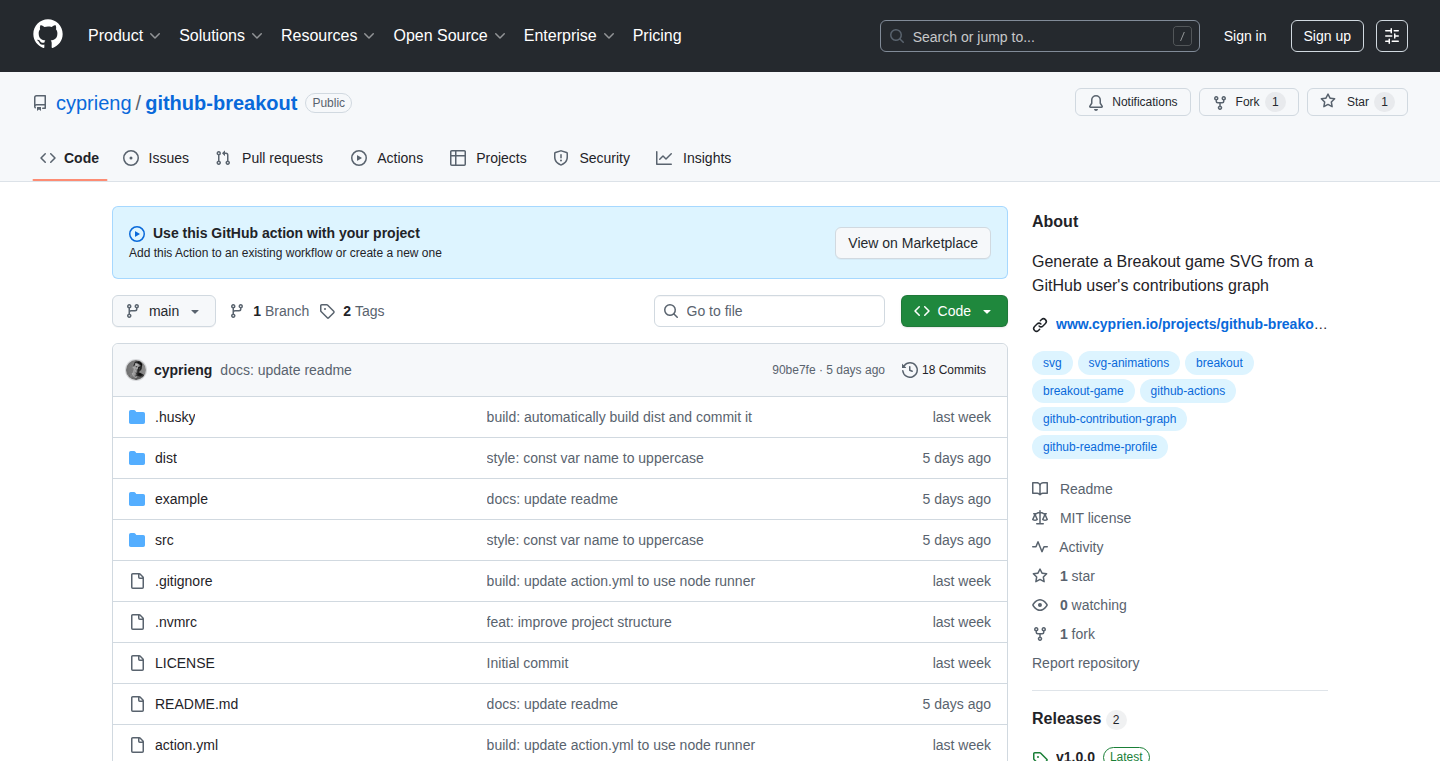
Author
cyprien_g
Description
GitBreakout is a unique implementation of the classic Breakout game, where the game's bricks are generated and positioned based on a user's GitHub contribution graph. This project offers a creative and visual representation of a developer's activity, translating their code contributions into an interactive gaming experience. The innovative aspect lies in the use of GitHub's API to fetch contribution data and dynamically render game elements. This project addresses the challenge of visualizing developer activity in a fun and engaging way.
Popularity
Points 2
Comments 0
What is this product?
GitBreakout is a Breakout game, a classic arcade game, reimagined with a twist. Instead of pre-defined levels, the bricks in the game are created and arranged based on your contribution history on GitHub. Your past coding activity directly impacts the game's layout. It fetches your GitHub contribution data using their API, interprets this data, and uses it to populate the game board with bricks. The more active you are on GitHub, the more complex and challenging the level becomes. So, this is a playful way to visualize and interact with your coding contributions.
How to use it?
To use GitBreakout, you'd typically visit a web interface or use a command-line tool (depending on the specific implementation). You'd likely need to authorize the application to access your GitHub profile. After authorization, the game analyzes your contribution graph and generates a Breakout level accordingly. You can then play the game using your keyboard or mouse. You could integrate it into a personal website to show off your activity, or even use it as a fun way to visualize team contributions. For example, you can use GitHub API keys and integrate the game inside a CI/CD pipeline, building a game version every time a new push occurs.
Product Core Function
· GitHub Contribution Data Fetching: The core function is to access and retrieve the user's contribution data from the GitHub API. This allows the game to understand the user's coding activity. This is valuable because it directly links game elements to real-world actions.
· Data Interpretation and Brick Generation: The project interprets the retrieved contribution data, converting it into parameters to generate bricks on the game board. This is an innovative approach because it turns abstract data into a tangible game element, providing a new way to interact with coding statistics.
· Dynamic Level Creation: Based on the user's contribution history, the game dynamically creates levels. This creates a personalized gaming experience and visualizes the developer's activity through game progress.
· User Interface (UI) and Game Logic: This includes all the standard Breakout game features, such as ball and paddle controls, collision detection, and scoring. This delivers the familiar game experience.
· Interactive Visualization: By mapping coding activity to gameplay, it visualizes the developer's activity on a game board. This makes the abstract concept of coding contributions tangible and engaging.
Product Usage Case
· Personal Portfolio Visualization: A developer could integrate GitBreakout into their personal portfolio to showcase their GitHub activity. The game provides an interactive and visually appealing way to demonstrate their coding contributions to potential employers or collaborators. So, this shows off your skills in a fun and engaging way.
· Team Project Activity Tracker: Teams could use this game as a creative team dashboard to track project activity in a visual way. The more active the team is on the project, the more complex the game becomes, thus visualizing team performance. So, it is a fun approach to monitor project activity.
· Educational Tool for Git and GitHub: Students learning Git and GitHub could use GitBreakout to visualize their contributions. They can immediately see how each commit affects the gameplay, aiding understanding and encouraging practice. So, it's a fun way to learn about coding and collaboration.
· Gamification of Code Contribution: The game can be used as a way to gamify the process of code contributions, encouraging developers to contribute more frequently. So, it adds fun and motivation to code.
54
Kidsafe360 - Privacy-Focused Mobile Tracker for Parental Control

Author
its_me123
Description
Kidsafe360 is a free mobile tracking app designed for parental control, allowing parents to monitor their child's phone activity. It stands out by prioritizing privacy, offering features like call history monitoring, location tracking, WhatsApp activity logging, and photo access. This is built specifically for Android devices. This project demonstrates a focus on user privacy while still providing comprehensive monitoring capabilities, a challenge in modern mobile app development.
Popularity
Points 2
Comments 0
What is this product?
Kidsafe360 works by installing an app on the child's Android phone. It then securely transmits data like call logs, location data, WhatsApp messages, and photos back to the parent's device. The app utilizes Android's accessibility services and background location tracking capabilities. The innovation lies in its attempt to balance comprehensive tracking with a strong emphasis on data privacy, which is often a complex undertaking. So this is helpful if you want to have visibility into your child's phone usage, while also trying to maintain a level of data protection.
How to use it?
Parents would install the app on their child's Android phone and link it to their own account, probably on their own phone. The app would require certain permissions to access the relevant data (like contacts and location). After the initial setup, parents can access the collected data through a user-friendly interface, probably on their own phone or a web dashboard. This can be integrated in families concerned with children's mobile phone usage, by using this application parents get the ability to monitor usage, and help keep their children safe online and offline.
Product Core Function
· Call History Monitoring: This feature allows parents to see incoming and outgoing calls, and call duration. This is valuable because it allows parents to see with whom their child is communicating. If the child has conversations with someone unknown, parents can be aware of it.
· Location Tracking: The app provides real-time location tracking, allowing parents to see where their child is at any given time. Useful for ensuring the child’s safety and knowing when the child arrives to school. This offers peace of mind and can be helpful in emergencies.
· WhatsApp Activity Logging: This logs messages from the WhatsApp, offering insights into the child's social interactions on the platform. Useful for protecting children from cyberbullying or other inappropriate online behavior.
· Photo Access: The app also grants access to the photos stored on the child's phone. Parents can review the photos to ensure the child isn’t exposed to inappropriate content. Helpful for understanding what media the child is interacting with.
Product Usage Case
· A parent wants to monitor their child's online activity to protect them from cyberbullying. They can use Kidsafe360 to monitor WhatsApp messages and identify any potential issues. Helps the parent to take timely action.
· A family is concerned about a child's safety and wants to know their location at all times. Kidsafe360 can provide real-time location tracking, giving the parents peace of mind. Helps to ensure child’s safety.
· A parent suspects their child is communicating with someone they shouldn't be. They can use Kidsafe360 to review call history to confirm their suspicions. Helps the parent to intervene if necessary.
55
OpenITPlan: Web-Based IT Maintenance Plan Generator
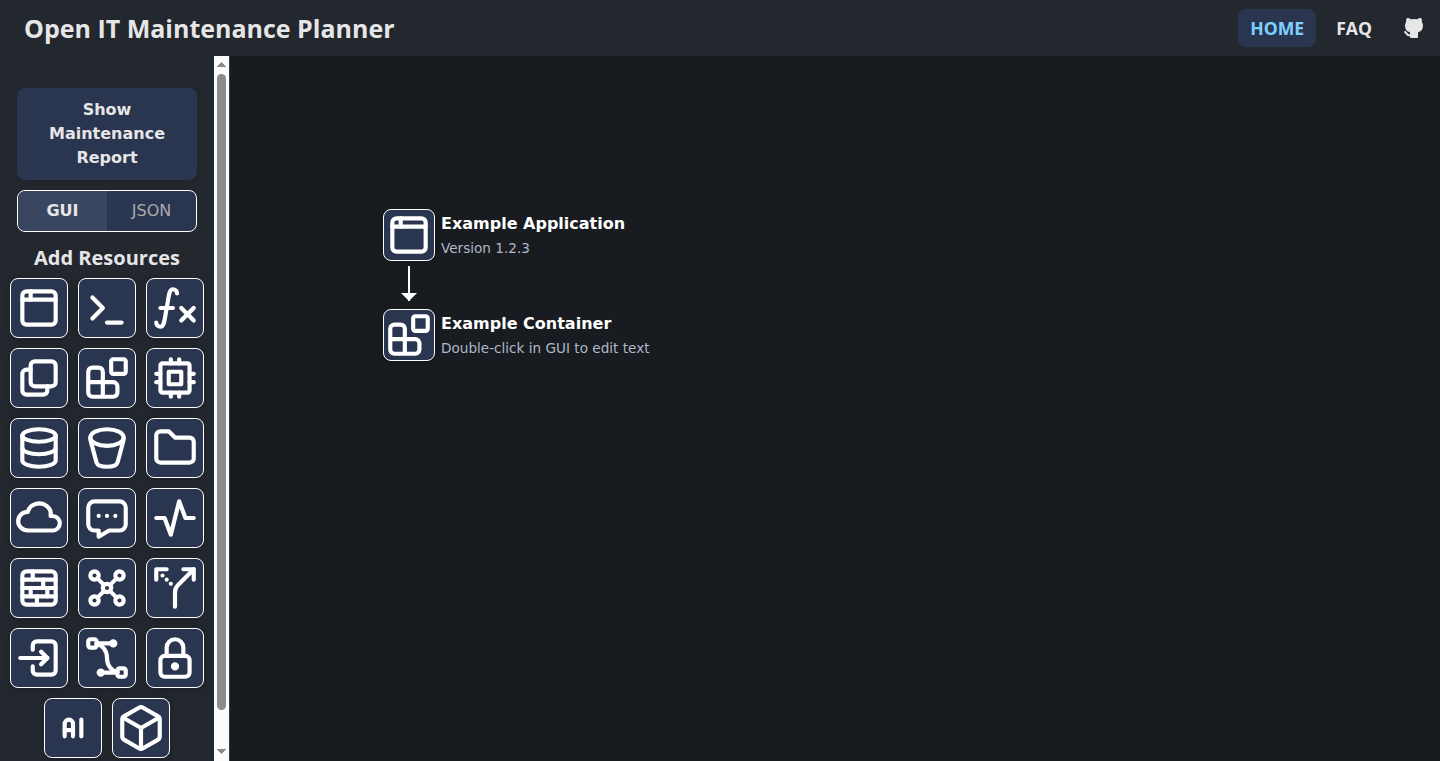
Author
spmvg
Description
OpenITPlan is a web-based tool that automatically generates IT maintenance plans. It leverages a structured approach to define tasks and schedules, making IT management more proactive and less reactive. The key innovation lies in its ability to streamline and automate the creation of complex maintenance schedules, reducing the manual effort and improving IT infrastructure's reliability.
Popularity
Points 2
Comments 0
What is this product?
OpenITPlan is a web application that simplifies IT maintenance. It works by taking your IT infrastructure components as input, and using pre-defined best practices, it suggests a maintenance schedule, including tasks and their frequency. The core technology is based on a task-scheduling algorithm combined with a knowledge base of common IT maintenance procedures. This is a departure from ad-hoc maintenance and enables a more consistent and manageable approach. So this lets you schedule your IT work and avoid chaos.
How to use it?
Developers can use OpenITPlan by entering their IT infrastructure details, such as servers, network devices, and software. The tool then generates a maintenance plan that can be exported or integrated into existing IT management systems. Developers could also contribute to the underlying knowledge base, customizing maintenance tasks to fit their specific environments. For example, integrate it with your monitoring dashboard or use the generated schedule to trigger automated scripts. So this makes your IT management easier and more organized.
Product Core Function
· Automated Task Generation: Based on the provided IT assets, the tool generates a set of maintenance tasks. Value: Reduces manual planning and ensures no critical tasks are missed. Application: Helps teams create comprehensive checklists.
· Schedule Optimization: The system provides a schedule for tasks. Value: Avoids overlaps, and provides a clear timeline. Application: Improves the overall efficiency and organization of IT operations.
· Customizable Templates: The tool allows users to customize templates for different IT components. Value: Makes the tool adaptable to different IT environments. Application: Improves ability to handle diverse IT infrastructure setups.
Product Usage Case
· Scenario 1: A small business with limited IT staff. By using OpenITPlan, the business can create a proactive maintenance schedule, ensuring that servers and network devices are regularly updated and secured, which reduces the risk of downtime and data loss. Result: Reduced IT problems.
· Scenario 2: A software development company needs to maintain a large cloud infrastructure. The development team can use OpenITPlan to ensure all servers, databases, and application services are maintained. The team can focus on their core product. Result: A more reliable infrastructure.
56
TableVision: AI-Powered Image to Excel Conversion

Author
jacksonLiu89
Description
TableVision is a weekend project by jacksonLiu89 that leverages Google's Gemini AI to convert images containing tables, including handwritten ones, into clean Excel or CSV files. This tackles the tedious and time-consuming task of manually extracting data from images, offering a free and convenient solution. The core innovation lies in its AI-powered image analysis and table extraction capabilities.
Popularity
Points 2
Comments 0
What is this product?
TableVision uses a powerful AI model (Gemini) to understand the structure of tables within images. It analyzes the image, identifies the table's rows, columns, and cell contents, and then outputs the data in a structured format like Excel or CSV. The main innovation is the ability to accurately process even handwritten tables, making it incredibly versatile. So this is useful because it automatically extracts data from image tables, saving you hours of manual work.
How to use it?
Developers can use TableVision through a web interface to upload image files. You upload the image, the AI processes it, and you get the downloadable Excel or CSV file. You don't need to be a programmer to use it. It's perfect for anyone needing to quickly extract data from image-based tables. So this is useful because it's easy to use – just upload and download.
Product Core Function
· Image to Excel/CSV Conversion: The core function. It takes an image containing a table and transforms it into a structured data file (Excel/CSV). This is useful for quickly getting data from scanned documents, screenshots, or handwritten notes into a usable format. So this is useful because it removes the need for manual data entry.
· Handwritten Table Support: One of the key strengths. The AI is trained to recognize and interpret handwritten text within tables. This dramatically expands the usability of the tool, allowing conversion of even less-structured input. So this is useful because it allows you to process all kinds of table images, including those that are not perfectly clear.
· Batch Processing: The ability to convert multiple images at once, significantly improving efficiency when dealing with large datasets. This is useful for users who have a large number of images to convert. So this is useful because it saves time by processing several images at once.
· Merging Images: The option to merge multiple images into a single Excel file, or keep them separate. This improves flexibility and customization based on user need. So this is useful because it provides flexibility for how you want to organize your data.
Product Usage Case
· Extracting Financial Data: A financial analyst receives scanned reports with tables. Using TableVision, they can quickly convert these image tables into Excel spreadsheets for analysis. This saves time and reduces errors from manual data entry. So this is useful because it saves time and reduces errors.
· Converting Handwritten Notes: A researcher has handwritten data tables from experiments. They use TableVision to convert them into a digital format for analysis and sharing. So this is useful because it eliminates the need to retype the data.
· Processing Invoices and Receipts: Businesses can convert scanned invoices or receipts containing tables into CSV files for accounting and data analysis. So this is useful because it automates data entry from physical documents.
· Academic Research: A student uses TableVision to extract data from published research papers that contain tables in image format, importing them to analyze data for thesis or project. So this is useful because it provides instant access to data for study.
57
FormFiller: Realistic Test Data Generator
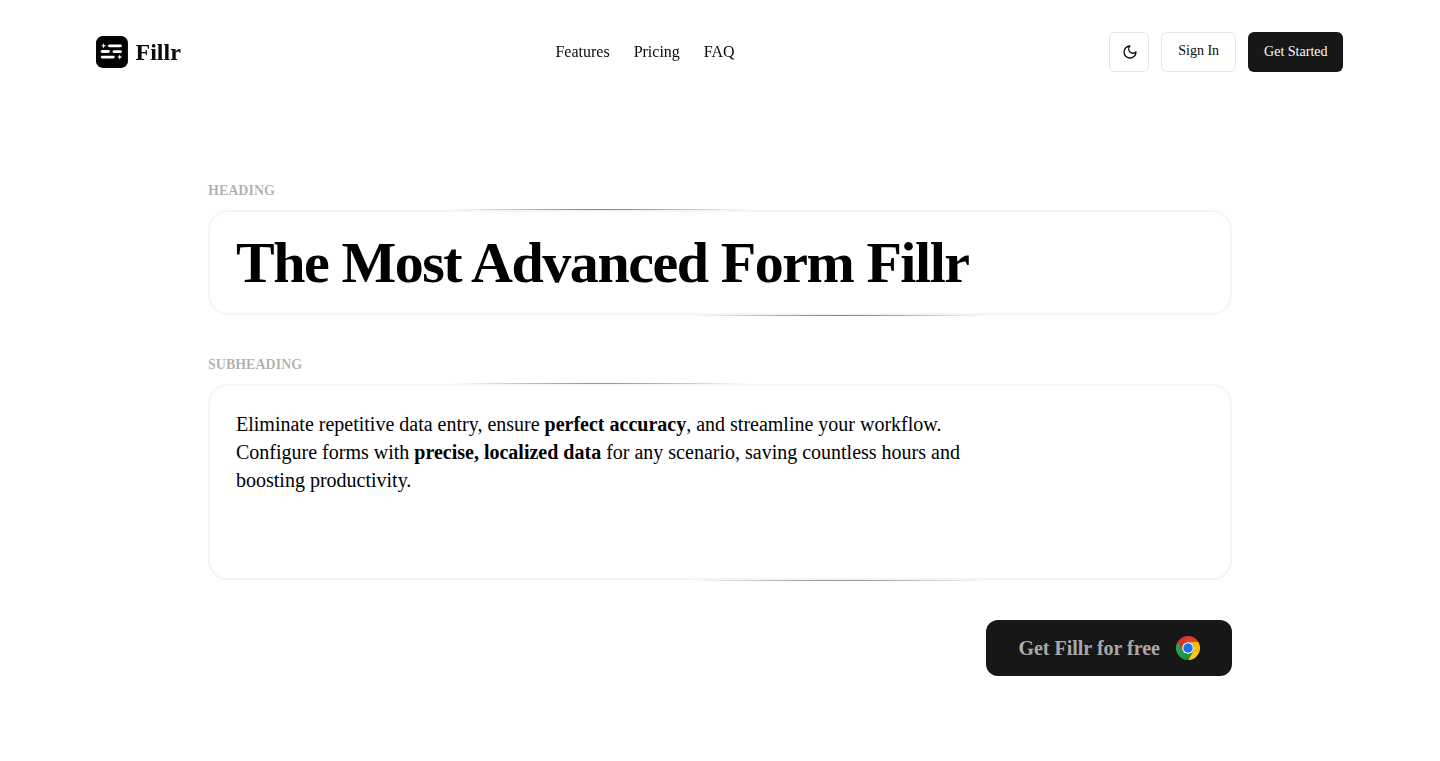
Author
amineinai
Description
FormFiller is a tool that automatically fills out web forms with realistic and believable test data. It addresses the common problem of needing diverse and representative data for software testing. The innovation lies in its ability to generate data that mimics real-world patterns, making testing more effective and reliable.
Popularity
Points 2
Comments 0
What is this product?
FormFiller is like a smart robot that fills out online forms for you. Instead of using generic or predictable test data, it creates data that looks and feels real. It does this by learning from existing data patterns and using that knowledge to generate realistic names, addresses, phone numbers, and more. This is an innovation because it significantly improves the quality of software testing, catching bugs that might be missed by simple or repetitive test data. So this is useful because it ensures the software behaves correctly in different scenarios.
How to use it?
Developers can use FormFiller in their testing pipelines. After installing it, they can specify the form fields they want to populate and the type of data they need (e.g., names, email addresses, dates). FormFiller then automatically generates and injects the realistic data into the form. You can integrate it into your existing test framework, making the testing process much more efficient and reliable. So this is useful because it provides a seamless way to test web applications with high-quality data.
Product Core Function
· Realistic Data Generation: This core functionality generates data that closely resembles real-world data. This is valuable because it helps developers identify bugs related to data validation, formatting, and edge cases that might be missed with basic test data. Application scenario: When testing e-commerce websites, you can create numerous test users with various details to check if the payment process works smoothly.
· Customizable Data Types: The ability to specify the type of data to be generated (e.g., name, address, email, phone number) allows for highly targeted testing. This is valuable as it provides flexibility in testing different aspects of an application. Application scenario: When testing form validation of a contact page, you can define what type of data (e.g. valid email addresses or phone numbers) to input to check whether the submission is successful.
· Pattern Learning: The tool likely utilizes pattern learning algorithms to understand the characteristics of realistic data. This is valuable because it makes the generated data more diverse and representative. Application scenario: While creating test accounts for a social media application, you can check whether the application correctly accepts the registration of different profiles and user behaviour.
Product Usage Case
· Testing Web Forms: Developers can use FormFiller to test the input fields of any web form, ensuring that the application handles different data formats and values correctly. For instance, testing an account signup form, including creating multiple different accounts. This is useful because it catches validation errors and prevents data corruption.
· Automated Testing Pipelines: FormFiller can be integrated into automated testing pipelines. This means developers can set up continuous testing that generates realistic data every time the code changes. The automated testing prevents regressions. This is useful because it streamlines the testing process, improves test coverage, and reduces the risk of errors going unnoticed.
· Data Mocking: In situations where real data is not available or private, FormFiller can create realistic data to mock the data. This is useful because it helps developers build and test applications without relying on sensitive data. Application scenario: While developing a new feature for a web application, instead of using production data, you can generate appropriate test data for your development.
58
Agilepitch: CRM Supercharger
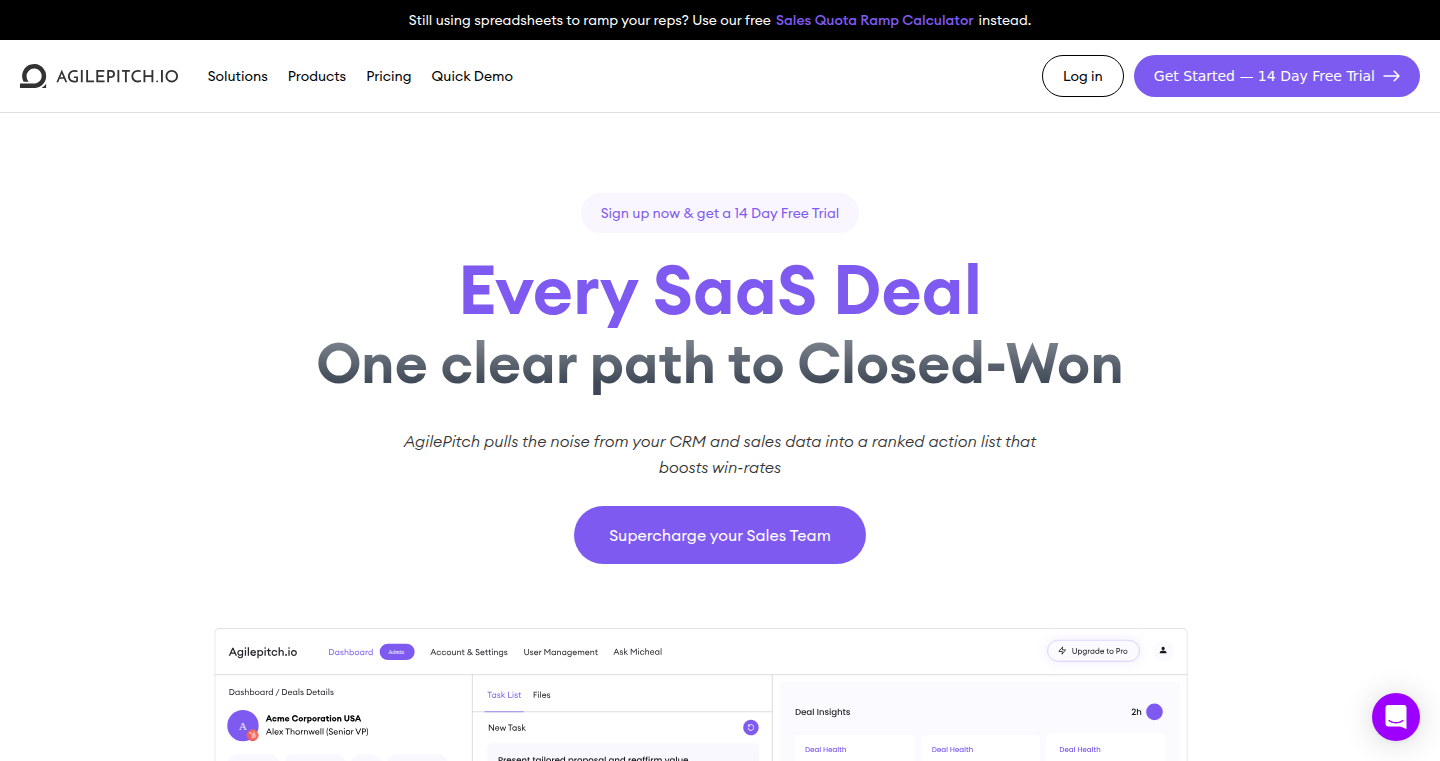
Author
james_kelly
Description
Agilepitch aims to be a 'Superhuman' for Customer Relationship Management (CRM) systems. It leverages intelligent automation to streamline CRM interactions, saving users time and improving efficiency. The core innovation lies in its AI-powered features like automated data entry, smart email suggestions, and prioritized task management, solving the pain points of tedious manual CRM tasks and enhancing productivity.
Popularity
Points 2
Comments 0
What is this product?
Agilepitch is a tool designed to make CRM usage more efficient and less time-consuming. It employs artificial intelligence to automate tasks, provide intelligent suggestions, and prioritize user actions within a CRM system. Think of it as an AI assistant for your CRM. The innovative aspect lies in the seamless integration of AI to handle repetitive actions, predict user needs, and prioritize critical activities, allowing users to focus on core business functions instead of administrative overhead.
How to use it?
Developers would use Agilepitch by integrating it with their existing CRM platforms, such as Salesforce or HubSpot. This integration can be achieved via API calls or dedicated plugins. Once integrated, users can leverage Agilepitch's features: it can automatically populate CRM data from emails, generate email suggestions based on context, and prioritize tasks based on deadlines and urgency. This enables developers to build integrations or create extensions that enhance CRM workflows and boost user productivity.
Product Core Function
· Automated Data Entry: Automatically populates CRM records from email conversations, eliminating manual data input. So this saves you time and reduces errors.
· Smart Email Suggestions: Generates email drafts based on context and CRM data, helping users compose effective and personalized messages. So this helps you write better emails, faster.
· Prioritized Task Management: Organizes and prioritizes tasks based on deadlines and urgency, ensuring that users focus on the most important activities. So this keeps you organized and on track with your work.
· Real-time Activity Tracking: Monitors user interactions and CRM data changes in real-time, providing insights and alerts. So this gives you better visibility into your team's performance and activities.
Product Usage Case
· Sales Team Automation: A sales team can integrate Agilepitch to automatically log email conversations and meeting notes in the CRM system, freeing up their time to focus on closing deals. So this helps sales teams close more deals.
· Customer Support Enhancement: Customer support representatives can use Agilepitch to receive email suggestions and quickly access relevant customer information, improving response times and customer satisfaction. So this helps support teams provide better customer service.
· Marketing Campaign Management: Marketing teams can leverage Agilepitch to automate data entry for lead generation, personalize email campaigns, and track performance metrics, optimizing marketing efforts. So this helps marketers improve their campaigns.
· Project Management Integration: Project managers can connect Agilepitch to their CRM and automatically update project statuses, tasks, and deadlines based on CRM interactions. So this keeps project teams on track and provides better communication.
59
Overbooked: The Context Machine for LLMs
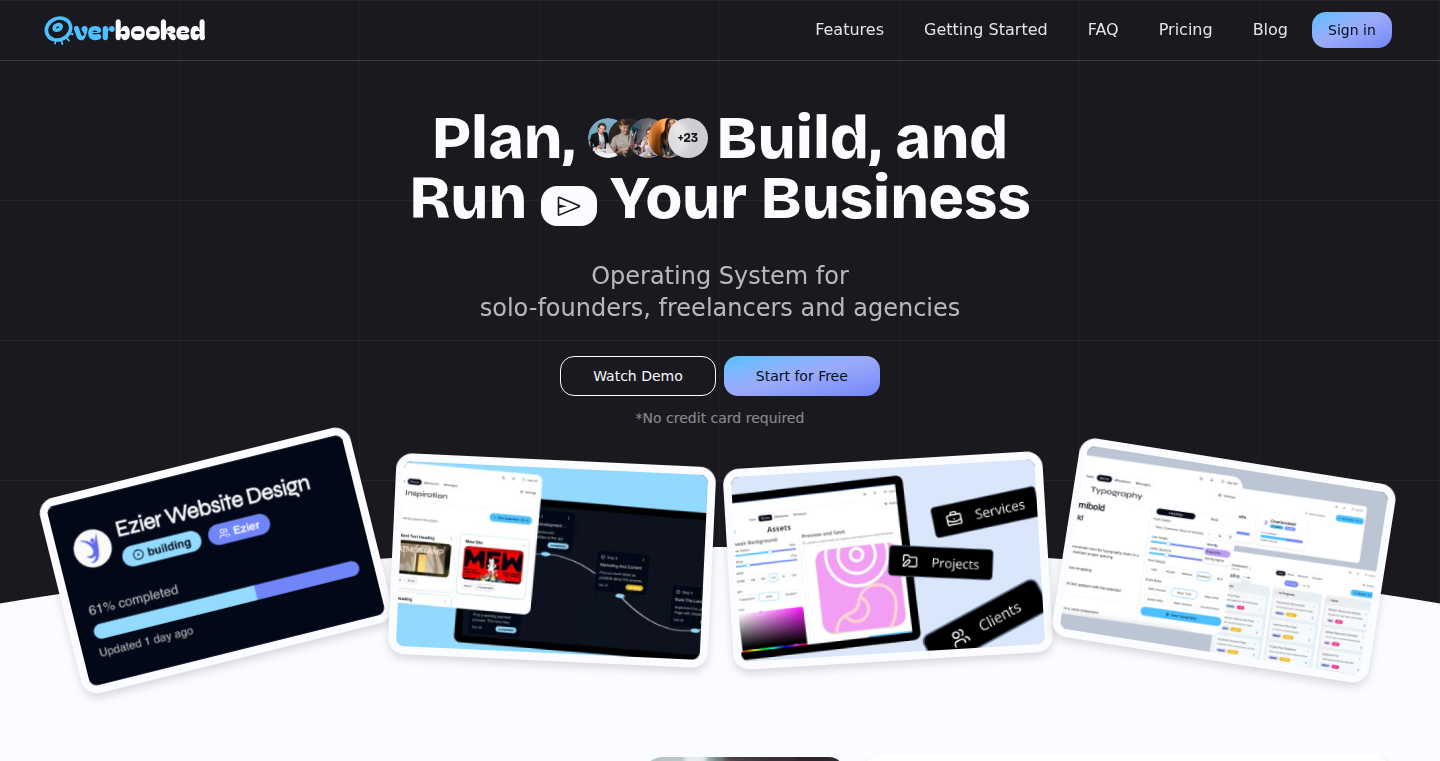
Author
ezierco
Description
Overbooked is a tool that helps you provide better context to Large Language Models (LLMs) like ChatGPT, leading to more accurate and useful outputs. It combines structured data with AI agent tools, allowing you to connect it with your coding environment (like VS Code) or use it within the app's chat window. This helps LLMs understand your projects better and generate things like code, documents, and marketing materials more effectively.
Popularity
Points 2
Comments 0
What is this product?
Overbooked is essentially a 'context machine'. It works by giving LLMs a clearer understanding of your project through structured data and specialized tools. When you give an LLM a task, Overbooked can provide it with the relevant project information, like code repositories, project documents, or even your calendar. This means the LLM can generate better outputs, be it code suggestions, article drafts, or project plans. The core innovation lies in providing the *right* context at the *right* time for AI agents to work effectively.
How to use it?
You can use Overbooked in two main ways. First, integrate it with your code editor (like Cursor). This allows your AI-powered coding assistant to access project information directly, like accessing the code in different repositories. Second, use the Overbooked app's chat window. Here, you can brainstorm ideas with your team, generate articles, or even manage your calendar, all powered by the context-rich LLM.
Product Core Function
· Cross-repo context: This allows you to connect your project across different repositories (e.g., frontend and backend). You can ask the AI to make changes in multiple places at once, making updates more streamlined. This is super useful if you have a large project built on multiple parts.
· Delegating tasks and preventing 'hallucinations': You can give LLMs clear, structured tasks and break them down into smaller, manageable steps. This makes sure the AI agent stays on track, reducing errors and getting you the right output. It’s like giving the AI a detailed project plan.
· Initializing and structuring new projects: Overbooked can generate project documents (like plans and tech stacks), branding materials (like color palettes), and even help you set up the initial structure of a new project. It speeds up the setup process, allowing you to focus on the core work.
· Brainstorming in group chat: Within Overbooked, you can brainstorm with your team. Everyone can tag the Overbooked app to ask questions and gather information from the internet. This facilitates team collaboration and makes sure everyone's on the same page.
· Generate long-form articles or social media posts: You can use Overbooked to research, draft and generate long-form content. This can save time and effort in content creation.
· Talk to your calendar: You can integrate your calendar with Overbooked, allowing you to create reminders and manage your schedule using natural language. This simplifies time management and keeps you organized.
Product Usage Case
· Code generation: Imagine you want to add a new feature in your project. With Overbooked connected to your IDE, you can ask the AI to generate the necessary code, taking into account the existing code structure, in order to add the new feature. You're basically having an AI assistant write your code for you.
· Project documentation: You need a PRD (Product Requirements Document) for your new feature. With Overbooked, you can get the AI to generate the document automatically, based on the project context you've already provided. You'll get a head start on planning without having to write from scratch.
· Content creation: You need to write an article about your product. You can use Overbooked to have the AI research, write, and format the article. It simplifies content creation, so you can have your article ready without spending a lot of time.
· Project planning: Need to brainstorm ideas with your team. Overbooked's group chat allows for real-time collaboration, using the AI to find information and help generate tasks, documents and ideas.
· Meeting management: You can use Overbooked to have the AI make reminders about your meetings. The AI can also summarize the key points discussed in the meeting, freeing you to do other things.
· Create social media marketing content: Quickly generate different social media posts about a certain topic related to your project. This saves time and allows your team to test different approaches.
60
AI-Powered Landscape Designer: Instant Garden Makeovers

Author
lcorinst
Description
This project leverages the power of Artificial Intelligence (AI) to transform photos of your outdoor (or indoor) spaces into stunning landscape design ideas. It allows users to upload a picture, describe their vision (e.g., add a patio, incorporate a specific style), and the AI generates design suggestions instantly. The innovation lies in the ease of use and the ability to quickly visualize different landscaping possibilities, eliminating the need for expensive consultations or time-consuming trial and error.
Popularity
Points 2
Comments 0
What is this product?
This is a web-based application that uses AI to generate landscaping designs. You upload a photo of your space, tell the AI what you want (e.g., a deck, a specific garden style), and it provides design ideas. The AI analyzes the photo, understands your requests, and generates realistic visualizations. So, it's like having a digital landscape architect at your fingertips. The underlying technology likely involves image recognition, natural language processing (to understand your requests), and generative AI models trained on a vast dataset of landscaping designs.
How to use it?
You can use this tool by visiting the website and following the simple steps: Upload a photo of your space, describe your desired changes (e.g., "add a fire pit and seating area"), and choose a design style. The application then generates design ideas that you can download and use as inspiration or share with a professional landscaper. This is particularly useful for anyone planning a home improvement project, looking for inspiration, or wanting to experiment with different design options without the financial commitment of hiring a designer. It can be easily integrated into your home improvement planning process, saving time and potentially money.
Product Core Function
· Image Upload: Upload a photo of your backyard, garden, or even interior space. This is the foundation for the AI to analyze and understand the existing environment. So, it is very useful because it serves as the canvas for the landscaping design, giving the AI a real-world starting point. The value here is ease of use - it eliminates the need for complex measurements or detailed site surveys.
· Text-Based Input for Design Preferences: Describe your desired landscaping features and style using simple text prompts. This allows users to communicate their vision to the AI without any technical expertise. So, it is very useful because users can easily input their ideas like “add a vegetable garden” or “create a zen garden.” This makes the tool accessible to everyone, regardless of design experience.
· Style Selection: Choose from a range of pre-defined design styles, such as Zen, Cottage, or Tropical. This provides a quick and easy way to guide the AI’s design generation process. So, it is very useful because it helps to quickly narrow down the design options and tailor the results to specific aesthetic preferences. It's a shortcut for finding the style you like.
· Instant Design Generation: The AI generates design ideas almost instantly based on the photo, text prompts, and style selection. This provides immediate feedback and allows for rapid iteration and experimentation. So, it is very useful because it allows users to quickly visualize different design options, saving time and effort. It also encourages exploration and creativity in the design process.
· Downloadable Designs: Download the AI-generated design ideas. So, it is very useful because it gives users concrete results that they can use as inspiration, share with others, or present to a professional landscape designer. It turns the digital designs into actionable plans.
Product Usage Case
· Homeowners planning a backyard renovation: Upload a photo of the current backyard, describe desired features (like a patio and a BBQ area), and the AI generates design ideas that visualize the changes. So, this helps to avoid costly mistakes by providing a visual preview before starting the actual project.
· Individuals seeking landscaping inspiration: Upload a photo of their existing garden and explore different design styles (e.g., Mediterranean, modern). The AI instantly provides a variety of design options. So, this allows for exploring different design directions and styles without needing to consult expensive landscape architects.
· Real estate agents showcasing property potential: Use the tool to visualize potential improvements for a property, such as adding a deck or improving the curb appeal. So, this makes it easier to attract buyers and increase property value. Visuals are very important for real estate listings.
· Landscape design students: Use the tool as a source of inspiration, generating ideas and exploring different design possibilities for their projects. So, this accelerates their learning and creativity in the field.
61
Mitte - The AI-Powered Creative Forge
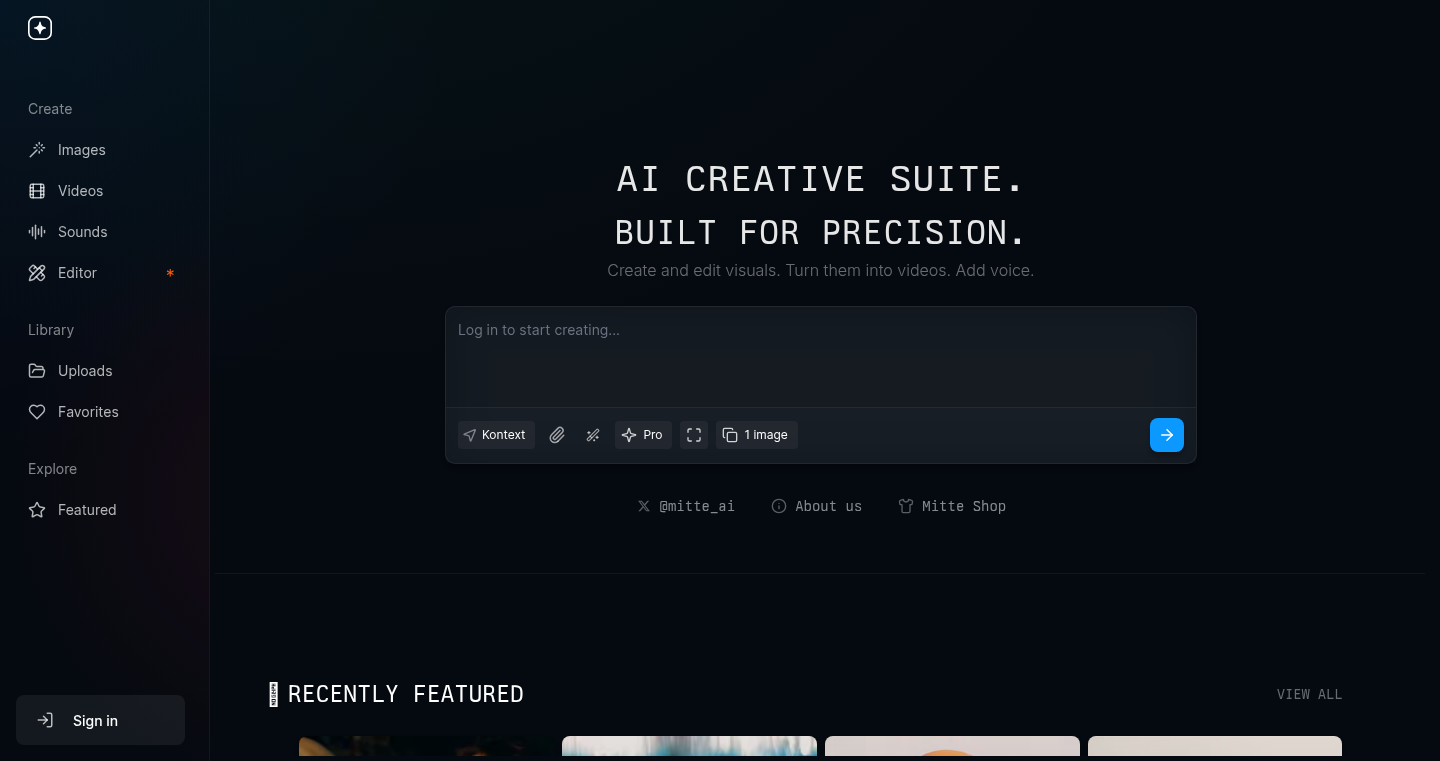
url
Author
akoculu
Description
Mitte is an AI creative suite designed to streamline content creation. It uses artificial intelligence to assist with various creative tasks, potentially including text generation, image creation, and idea generation. This project focuses on the practical application of AI to boost creative workflows, offering a glimpse into how AI can become a powerful tool for creators. It tackles the problem of time-consuming and often repetitive tasks in creative fields, allowing users to focus on higher-level conceptualization.
Popularity
Points 2
Comments 0
What is this product?
Mitte leverages AI models to aid in the creative process. The exact technical implementation is likely a combination of different AI techniques, such as natural language processing (NLP) for text-based tasks, and potentially generative adversarial networks (GANs) or diffusion models for image generation. The innovation lies in the integration of these AI models into a unified suite, offering a user-friendly interface that simplifies complex AI functionalities. So this helps you to have an AI assistant for your creative needs.
How to use it?
Developers could potentially use Mitte's APIs or SDKs (if available) to integrate its AI-powered features into their own applications or workflows. For example, a developer could integrate text generation capabilities into a content management system, or image generation functionalities into a design tool. It can be used in any creative environment. So you can automate the creative processes within your own platform.
Product Core Function
· AI-Powered Text Generation: This feature allows users to generate text content based on prompts, potentially including articles, scripts, or marketing copy. The technical value lies in leveraging NLP models to automate and accelerate the content creation process. Application: Generating draft articles, product descriptions, or social media posts.
· AI-Driven Image Generation: This function utilizes AI to create images based on text prompts or other inputs. The technical value resides in the ability to quickly produce visual assets without needing traditional design skills or resources. Application: Creating illustrations, visual mockups, or social media visuals.
· Idea Generation and Brainstorming: AI algorithms can analyze existing data and provide new ideas, concepts, and creative directions based on user input. The technical value is in using AI to spark creativity and overcome creative blocks. Application: Generating ideas for product concepts, marketing campaigns, or design projects.
· Creative Workflow Automation: Streamlining of repetitive creative processes, such as content reformatting or image resizing, using automated AI techniques. Technical value: reducing manual labor in creative tasks. Application: speeding up the content production pipeline, making creators much more productive.
Product Usage Case
· Content Creation for Websites: A developer can use Mitte's text generation features to automatically create articles or product descriptions for a website, reducing the time and effort needed to populate content. It helps you quickly fill the contents.
· Social Media Marketing: A marketing team can employ Mitte's image generation capabilities to create engaging visuals for social media campaigns, allowing them to produce a higher volume of content and achieve faster results. It helps increase the effectiveness of marketing campaigns.
· Rapid Prototyping: Designers and product developers can use Mitte's idea generation to quickly brainstorm new product ideas or design concepts, speeding up the prototyping phase. It empowers rapid innovation.
· Personalized Content Creation: Combining Mitte with user data, it's possible to create personalized content based on specific user preferences or needs. This approach has potential across different creative fields.
· Game Development: Imagine using AI to quickly generate environmental assets, textures, and level designs within a game engine. This significantly accelerates the development process, allowing for rapid prototyping and experimentation. So this is a huge boost for game developers.
62
AnkiTTS: Audio Augmentation for Anki Flashcards using ElevenLabs
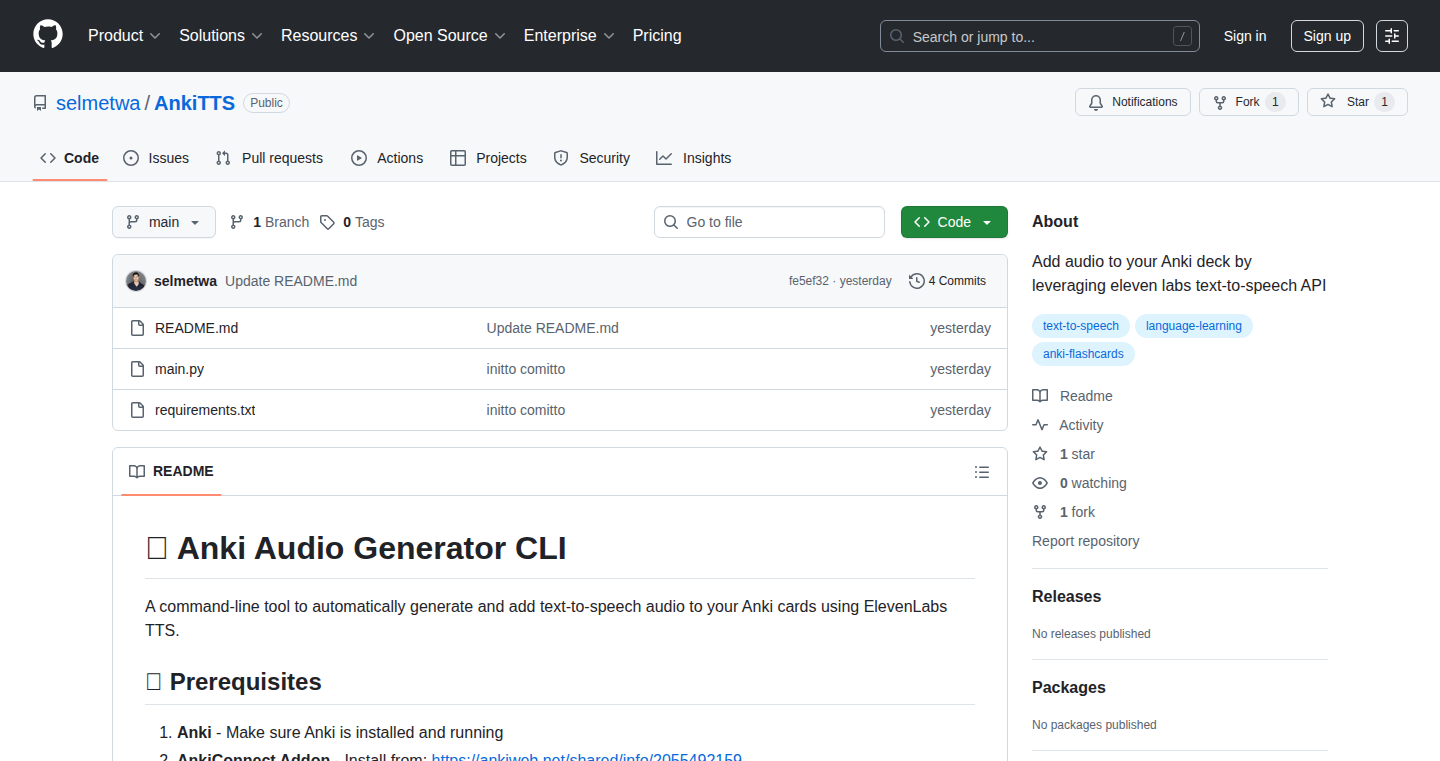
Author
selmetwa
Description
AnkiTTS is a command-line tool that automatically adds audio to your Anki flashcards using text-to-speech (TTS) technology from ElevenLabs. It tackles the problem of tedious manual audio recording for language learning or other subjects requiring auditory reinforcement. It simplifies the process by generating high-quality audio for your flashcards, saving time and improving the learning experience. So, this helps me learn faster and better by letting the app speak the flashcards to me!
Popularity
Points 2
Comments 0
What is this product?
AnkiTTS works by taking your Anki flashcards (which usually contain text) and feeding the text to ElevenLabs' TTS engine. ElevenLabs then generates audio files of the spoken text. AnkiTTS then integrates these audio files into your flashcards, making your learning process more auditory. The innovation lies in automating this process and integrating high-quality TTS into a commonly used flashcard platform. So, it automates the time-consuming task of adding audio to flashcards, offering a more effective and enjoyable learning method.
How to use it?
Developers use AnkiTTS via the command line. You'll need an ElevenLabs API key and an Anki deck. You specify which fields in your Anki cards contain the text you want to convert to audio. The tool then processes the deck, generating audio for each card and embedding the audio into the cards. You can use it in any situation where you are creating flashcards and want to incorporate audio pronunciation. This means, for example, that language learners can greatly benefit from AnkiTTS. You can then use these audio-enhanced flashcards within Anki, like any other deck. So, I can easily add audio to my flashcards without manually recording each one!
Product Core Function
· Text-to-Speech Generation: AnkiTTS integrates with ElevenLabs' API to convert text from your Anki flashcards into natural-sounding audio, utilizing advanced TTS capabilities. This is useful for those wanting to hear the content of their flashcards, improving comprehension and retention.
· Anki Deck Integration: AnkiTTS automatically adds the generated audio to your Anki flashcards, ensuring seamless integration with your existing flashcard workflow. So, this means less manual work, and more effective flashcards.
· Command-Line Interface: The tool operates via a command-line interface, providing a flexible and scriptable way to process your flashcards and generate audio in bulk. Developers can automate the process, making it easy to update entire decks. For me, this makes the entire workflow very customizable, and fast!
· ElevenLabs API Integration: Leverages ElevenLabs' cutting-edge text-to-speech technology to generate high-quality, human-like audio, improving the quality of the generated audio over traditional TTS systems. This leads to better pronunciation and engagement for the listener.
Product Usage Case
· Language Learning: A language learner creates flashcards with words or phrases. With AnkiTTS, they can automatically generate audio pronunciations for these words and phrases. This is useful because the learner can then hear the words spoken correctly, aiding in pronunciation and listening comprehension.
· Vocabulary building for technical terms: A student studying for a technical exam creates flashcards with complex terminology. AnkiTTS converts the text into audio, allowing the student to hear the correct pronunciation of the technical terms, which is useful in memorization.
· Content Creation for Podcasts or Tutorials: A content creator uses AnkiTTS to prepare audio snippets for podcasts or video tutorials. The flashcards serve as a script, and AnkiTTS turns the text into voiceovers quickly. This is a quick way to produce polished audio content.
63
Symbol.so: Unicode Symbol Customizer & Exporter
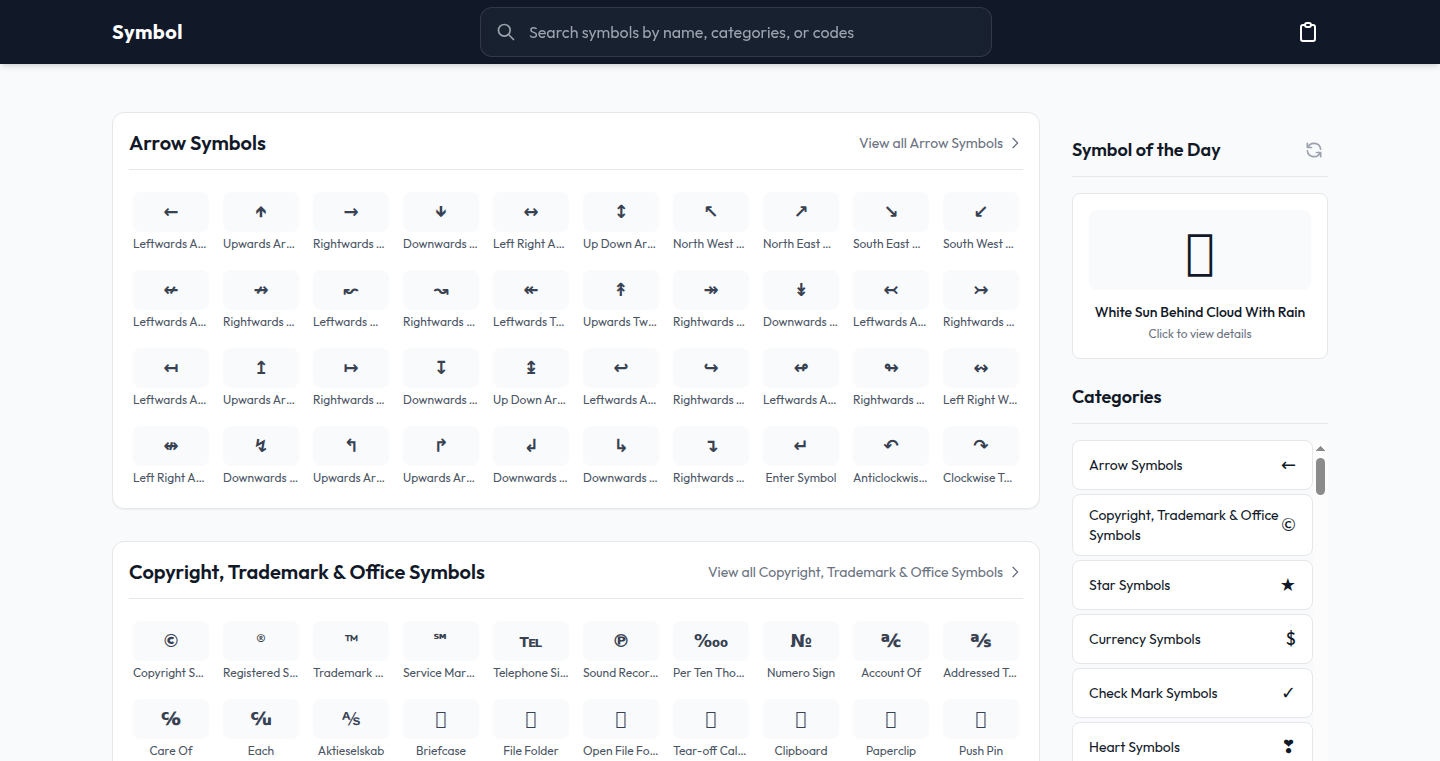
Author
liquid99
Description
Symbol.so is a web-based tool that lets you easily customize and export Unicode symbols. It addresses the common problem of finding, customizing, and using these symbols in various formats (SVG, PNG, HTML, CSS). The innovation lies in its user-friendly interface and direct export functionality, simplifying a previously tedious process.
Popularity
Points 2
Comments 0
What is this product?
Symbol.so is a web app that acts like a symbol toolbox. It allows you to search for Unicode symbols across many categories, customize their appearance (though the original post doesn't specify the degree of customization), and then export them as scalable vector graphics (SVG) or raster images (PNG). The core innovation is its ease of use and the ability to quickly generate the various code snippets (HTML, CSS) developers need to incorporate these symbols into their websites or applications. So it's great for anyone building websites or apps that want to add symbols. This is achieved using HTML, CSS, and JavaScript to build the front-end interface, coupled with server-side logic (likely using a framework) to handle symbol selection, customization, and image format conversion.
How to use it?
Developers use Symbol.so by first finding a symbol. Then they might customize its color or size (this depends on the actual capabilities of the implemented version). Afterwards they can copy the generated SVG/PNG or the associated HTML/CSS code snippet directly into their project. This is useful for icon creation, adding visual cues, and enhancing the user interface. For example, you could use a heart symbol in your HTML with some CSS styling for your website. So if you need custom icons in your web projects, this is a good tool for you.
Product Core Function
· Symbol Search and Discovery: Allows users to easily browse and search through thousands of Unicode symbols categorized by type. The value is in accelerating the symbol finding process, eliminating the need to manually sift through Unicode tables or rely on external tools. Use case: Quickly locate a specific symbol for a project without extensive research.
· Customization (if applicable): The ability to modify the appearance of the symbols (color, size, etc.) is valuable. Use case: Adapting symbols to fit a project's visual style, creating branded icons, or ensuring accessibility by adjusting contrast.
· SVG/PNG Export: Enables the output of symbols in vector (SVG) and raster (PNG) formats. The value is that SVG is a scalable vector graphic that is great for crisp, high resolution rendering while PNG provides image compatibility. Use case: Integrate symbols into various contexts, from web design (SVG for responsive display) to print (PNG for image elements).
Product Usage Case
· Web Design: A web developer uses Symbol.so to find and customize a checkmark symbol. They then export it as an SVG and incorporate it into a bulleted list on their website, creating a more visually appealing and user-friendly interface. So if you're building a website, it's easy to add icons.
· User Interface Development: A mobile app developer uses Symbol.so to create a custom notification icon using Unicode symbols. They export it as a PNG and add it to their application, providing clear and understandable visual cues for users. So this is perfect for app development.
· Graphic Design: A graphic designer uses Symbol.so to find a unique star symbol and incorporates it into a logo. They export it as an SVG, ensuring the logo remains scalable and of high quality, regardless of size. So this helps create professional-looking designs.
64
Unified AI Gateway: Unleashing Unlimited AI Access
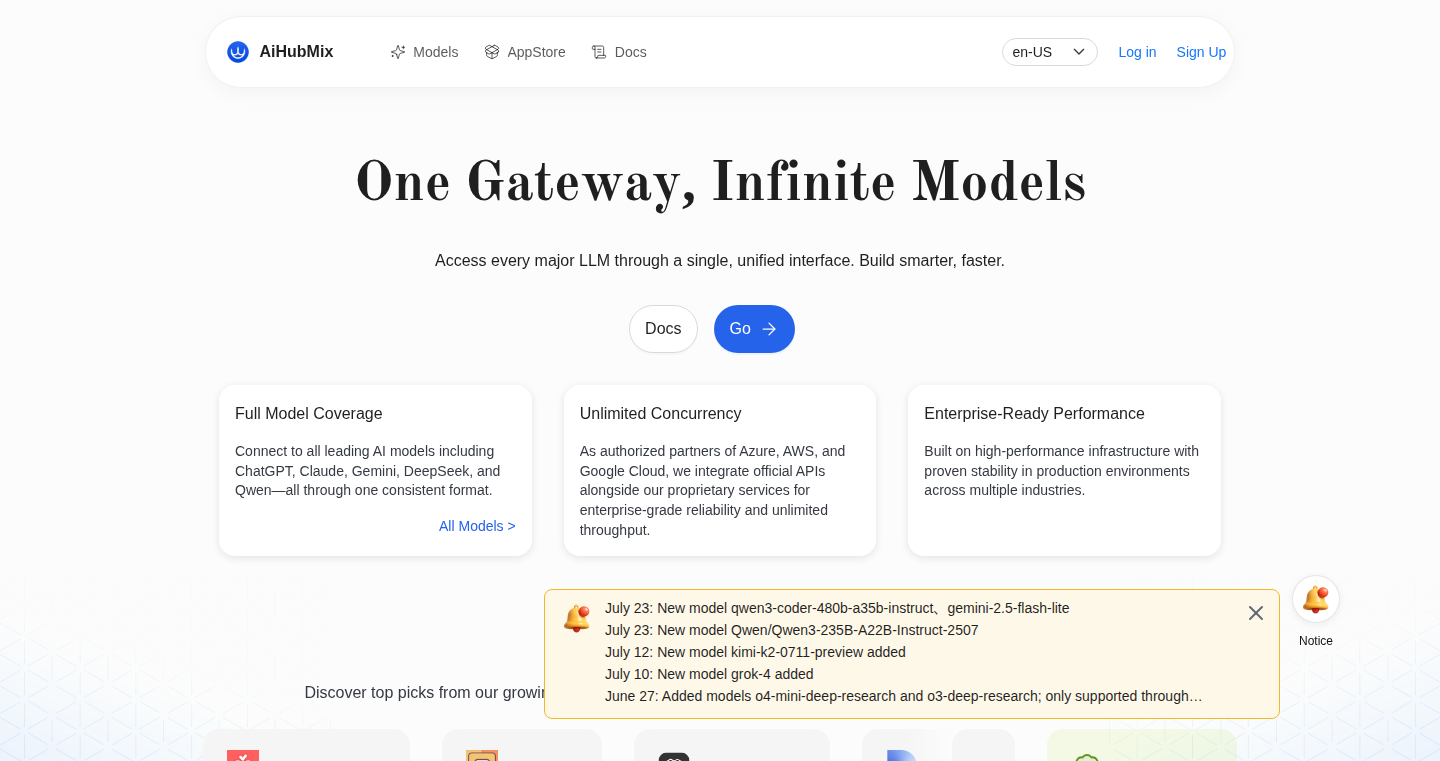
Author
akakenl
Description
This project is an API aggregation service that offers a single point of access to multiple Large Language Models (LLMs) and image generation models. The core innovation is providing unlimited concurrent usage of these models without the need to individually register with each provider or worry about access limitations. It tackles the problem of fragmented AI model access, simplifying the developer experience and removing barriers to rapid experimentation and deployment.
Popularity
Points 2
Comments 0
What is this product?
It's a central hub for AI models. Think of it as a universal remote for AI services. Instead of signing up for each AI provider separately, you use this one service. It hides the complexities of different APIs, rate limits, and access restrictions, allowing developers to focus on building AI-powered applications without the hassle. So this simplifies your AI development workflow.
How to use it?
Developers interact with the service through a single API. You send your requests to the Unified AI Gateway, and it intelligently routes them to the appropriate AI model, handling authentication and rate limits behind the scenes. This makes integration incredibly easy. Use cases include integrating AI models into existing applications, building new AI-powered tools, or simply experimenting with different models without the overhead of managing multiple accounts. So this offers a simple way to utilize many AI models.
Product Core Function
· Unified API Endpoint: It provides a single point of entry for accessing various LLMs and image generation models. This simplifies integration and reduces the learning curve. So this makes it easy to work with many AI models.
· Unlimited Concurrency: It removes the typical access limitations imposed by AI model providers, allowing for high-volume usage. This is valuable for applications that require heavy AI processing, such as chatbots or content generation platforms. So this lets your AI applications scale without limits.
· Simplified Authentication: It handles the authentication process with various AI providers, shielding developers from the complexities of API keys and access controls. This reduces the operational burden. So this simplifies authentication and lets you get started faster.
· Model Agnostic: The design is intended to support various models. Developers aren't locked into a single provider, and can seamlessly switch between models based on performance, cost, or feature sets. So this provides flexibility and allows you to pick the best model for the job.
· Cost Optimization: It potentially aggregates usage across providers, providing cost savings compared to using individual model APIs, making your projects more affordable.
· Real-Time Monitoring and Management: The service includes monitoring capabilities so users can track usage and model performance. This is important for optimizing AI applications and managing costs effectively. So this provides insights into the performance and cost of your AI applications.
Product Usage Case
· A small startup builds a customer support chatbot. They integrate with multiple LLMs through the service, allowing the chatbot to intelligently answer questions, translate languages, and provide context-aware responses. So this speeds up the development and integration of AI features.
· A content creation platform integrates with multiple image generation models to allow users to automatically create images for blog posts and social media. The service handles the behind-the-scenes complexity of managing the different APIs. So this allows you to build automated content creation tools.
· An AI research team is experimenting with different LLMs to explore novel use cases. They use the service to quickly test and compare different models without the hassle of setting up multiple accounts and dealing with rate limits. So this speeds up AI experimentation and innovation.
· A company with existing applications integrates with multiple LLMs to add a new set of features. So this lets you add AI to your applications with little technical effort.
65
Health Data Explorer: An Apple Health Data Analysis Server
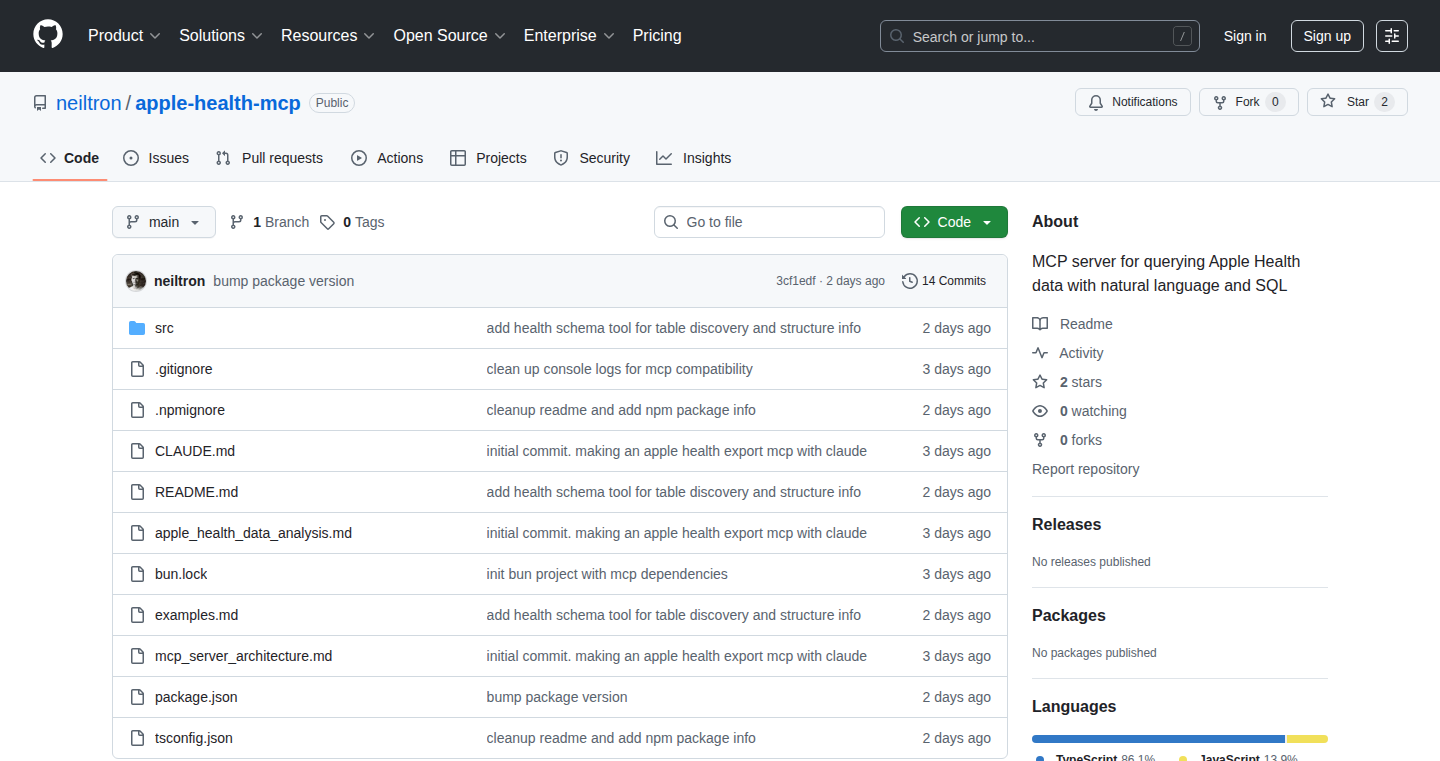
Author
_neil
Description
This project is a server that allows you to chat with and analyze your Apple Health data. It addresses the problem of manually accessing and interpreting health metrics by providing an easy-to-use interface. It uses a combination of an iOS app to export data to CSV and DuckDB, a fast in-memory database, for data processing and analysis. This approach allows users to gain insights from their health data, which can then be used for personal fitness tracking and goal setting. So, this simplifies the process of understanding your health data.
Popularity
Points 2
Comments 0
What is this product?
This project is essentially a 'translator' for your Apple Health data. It takes the data from your iPhone (exported as a CSV file) and uses DuckDB, a special database designed for quick analysis, to process and understand it. This allows you to ask questions about your health data, like how many steps you took last week or your average heart rate during workouts. The innovation here is simplifying the access to and analysis of Apple Health data, bridging the gap between raw data and actionable insights. So, this lets you actually use the data that your Apple Watch and iPhone collect.
How to use it?
Developers can use this server by first getting their Apple Health data exported as CSV files from an iOS app. The server then ingests these CSV files and allows users to query the data through its chat interface. You could integrate this server into your own personal trainer tools or other fitness applications. By using the server, you can automate weekly check-ins, track workout goals, and create a custom experience based on sensor data. So, this lets you build fitness apps that are smarter.
Product Core Function
· Data Import: The core function involves importing health data from CSV files, which are exported from an iOS app. This is the starting point for all analysis. So, this gives you a place to load and organize your health data.
· Data Storage and Processing: It uses DuckDB to store and process the health data efficiently. DuckDB's speed is key to quickly analyzing large datasets. So, this makes it easy to run complex queries on your data.
· Querying through Chat: The server allows users to interact with their data by chatting with it. This conversational interface simplifies complex data analysis, making it accessible to a wider audience. So, this lets you ask questions and get answers about your health data without needing to be a data expert.
· Data Visualization: Though not explicitly mentioned, a natural extension would be to visualize data based on the queries. This can provide quick insights. So, this allows you to spot trends and understand your health data more easily.
Product Usage Case
· Personal Fitness Tracking: Use it to track your workout goals by integrating the data with a personal trainer tool. You can use the data to track your progress over time. So, this lets you create a custom fitness plan.
· Weekly Health Check-ins: Build an automated system that combines health data with weekly check-ins, providing a data-driven analysis of your health and fitness. So, this helps you stay on track with your fitness goals.
· Custom Health Insights: Develop applications to provide personalized insights based on your health data, like identifying correlations between sleep patterns and exercise performance. So, this can give you a more personalized health experience.
· Data-driven Health Dashboards: Create interactive dashboards to display health data visualizations. You can monitor and analyze various health metrics over time. So, this gives you a single source of truth for your health data.
66
Zams: Intelligent AI Sales Agents

Author
nddave
Description
Zams is a platform for building AI agents that automate repetitive sales tasks. Instead of using clunky "if-this-then-that" workflows, you describe what you want the agent to do in plain English, and it handles tasks like updating your CRM, following up on deals, researching leads, and forecasting sales across tools like Slack, Notion, HubSpot, and Salesforce. The core innovation lies in the use of intelligent agents that understand natural language commands, enabling them to perform actions autonomously. This reduces the need for manual effort and complex workflow configurations.
Popularity
Points 2
Comments 0
What is this product?
Zams allows you to create AI agents that act as virtual sales assistants. Instead of setting up complicated rules, you simply tell the agent what to do in everyday language. The agent then uses its AI brain to interact with your different sales tools, like Slack, Notion, and your CRM, to get the job done. This innovation simplifies the process of automating sales tasks by moving away from rigid, rule-based systems to a more flexible, intelligent approach, making automation much easier and more adaptable to changing needs. So, it's like having a smart assistant that learns your sales process and handles the tedious parts for you.
How to use it?
Developers can use Zams by describing their desired automation tasks in plain English. They can integrate the agents with various tools like Slack for on-demand commands or set them up to run in the background, automatically processing information and taking actions based on a schedule or context. This eliminates the need to write code or manage complex workflows manually. For example, if you want an agent to update a deal in Salesforce based on a Slack conversation, you just tell it in simple terms, and it handles the integration. So, you can focus on selling instead of building complex integrations.
Product Core Function
· Natural Language Understanding: The agent can understand your requests written in plain English, allowing you to simply tell it what you want to do, without needing to learn any coding or scripting language. This makes automation accessible to anyone on your sales team. So, you can just talk to it like you would to a human assistant.
· Cross-Platform Integration: Zams seamlessly integrates with various sales tools, including Slack, Notion, HubSpot, and Salesforce. This ensures the agent can access the information and perform tasks across all the systems your sales team uses. So, you don't have to worry about manually transferring data between platforms.
· Automated Task Execution: The agents can perform a wide range of sales-related tasks, such as updating CRM records, sending follow-up emails, researching leads, and forecasting sales. This frees up your sales team to focus on higher-value activities. So, it helps reduce the time spent on administrative tasks.
· Command and Ambient Agent Modes: Zams offers two operating modes: command agents triggered on demand and ambient agents that run continuously in the background. This provides flexibility in how you use the agents to automate your sales tasks, from responding to specific requests to continuously monitoring and optimizing your sales pipeline. So, the agents work the way your sales team does.
· Contextual Awareness: Ambient agents can use context from documents, emails, and dashboards to make decisions. They can analyze data and respond accordingly. This enhances the agent's decision-making capabilities, making it more helpful. So, the agents become smarter over time as they learn your business.
Product Usage Case
· Automated CRM Updates: A sales team can use Zams to automatically update their CRM (e.g., Salesforce) with information from Slack conversations or email interactions. When a deal progresses, the agent automatically updates the deal status. So, it ensures your CRM is always up-to-date without manual data entry.
· Deal Follow-Up Automation: The agent can automatically send follow-up emails based on deal stage and time passed, freeing up sales reps to focus on closing deals. The agent could be configured to send customized emails based on specific triggers or predefined schedules. So, you won’t forget to follow up on important deals.
· Lead Research: Agents can research and enrich lead information from various sources, integrating this data into your CRM. When a new lead comes in, the agent can gather the necessary information to build out the profile of the lead automatically. So, you get a head start on building strong customer relations.
· Sales Forecasting: The ambient agents can analyze sales data and build a sales forecast based on the sales pipeline. It uses data from the CRM, sales activities, and customer interactions to provide insights. So, you have more time to focus on business objectives.
67
LookAwaySync: Screen Break Integration for iPhone
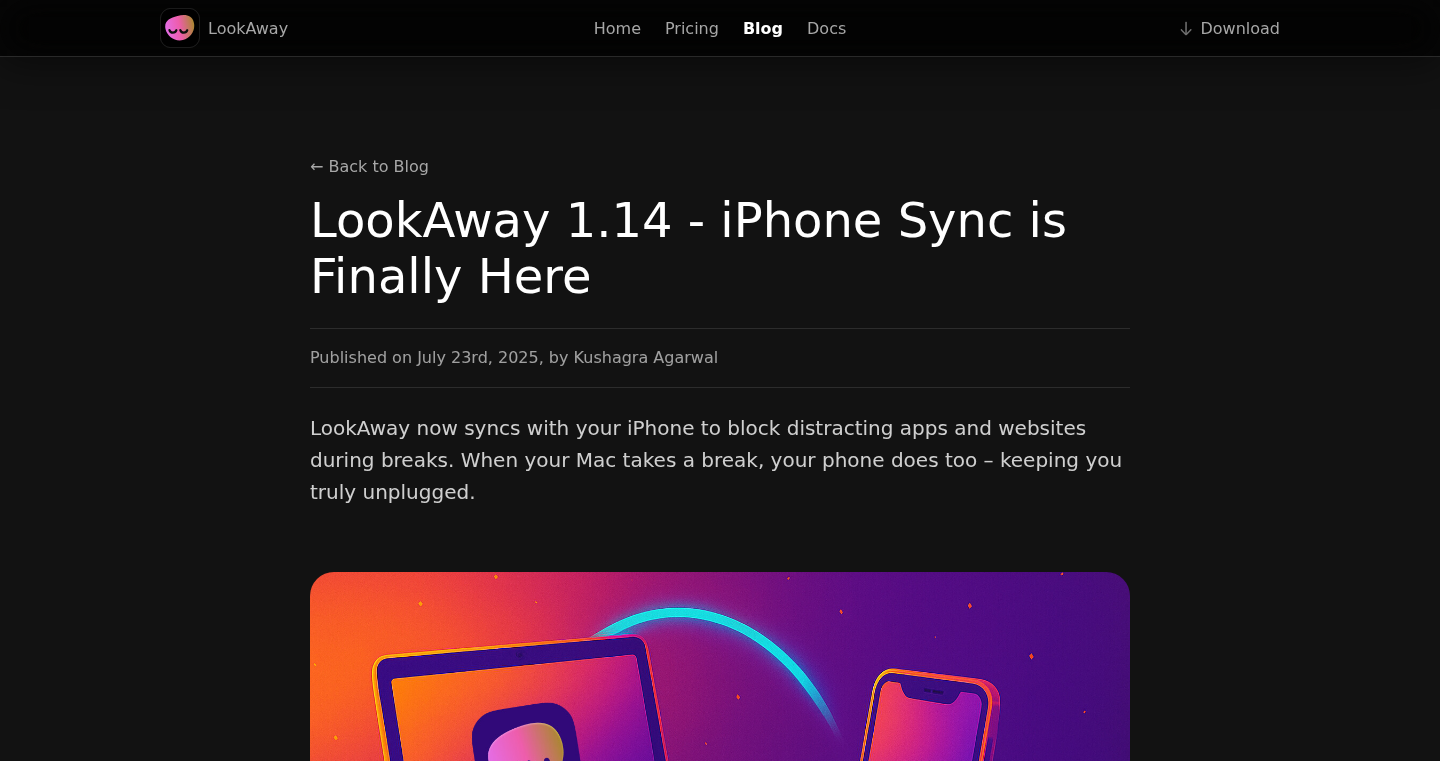
Author
_kush
Description
This project, LookAway Now Syncs Screen Breaks with iPhone, tackles the problem of integrating screen break reminders across devices. It allows users to synchronize the screen break functionality of the LookAway app with their iPhone's features. The innovation lies in leveraging a combination of background processes and potentially external APIs to monitor user activity and schedule screen breaks, thereby improving user well-being by promoting regular eye rests. This project demonstrates a creative approach to cross-platform integration, offering a solution for users who want a seamless experience in managing their digital wellness.
Popularity
Points 2
Comments 0
What is this product?
This project synchronizes the screen break feature in an app (LookAway) with an iPhone. The core technology involves detecting when the user is actively using their computer, and then coordinating with the iPhone to trigger a screen break notification. It's likely utilizing techniques such as background processing to constantly monitor for activity, and possibly using webhooks or other communication channels to send signals between the computer and the iPhone. This helps prevent eye strain and improves productivity. So this uses smart tech to take care of you!
How to use it?
Developers can integrate this by reviewing the code that handles the synchronization. They may need to modify the program to allow for different trigger conditions or integration with other apps. The use case is clear: if you have an app that provides screen breaks, this code will help you synchronize these breaks with your user's iPhone. It would be useful in any scenario where your users interact with devices that support screen breaks, such as a focus app or a productivity tool. So if you're building a screen-break solution, this is a great starting point.
Product Core Function
· Screen activity monitoring: This functionality allows the software to constantly track user activity. It watches what the user is doing. This is valuable because it accurately determines when the user is actively working on the computer and thus needs screen breaks. This provides accurate break timing.
· Cross-platform communication: The ability to communicate between the computer and iPhone is crucial to its function. The project must be able to signal the iPhone when it's time for a break. This enables seamless synchronization. So this means your devices can work together.
· Screen break scheduling: This allows the app to schedule breaks. This is crucial because it makes sure that the user gets the correct type and frequency of breaks. This adds a level of automation to the process.
· User interface/notification: The system is set up to notify the user when it is time to take a break. This feature is essential as it gives the user a cue. It adds to the user experience.
Product Usage Case
· A focus app developer integrates this synchronization logic. They can keep track of user productivity by utilizing screen time and screen breaks. This syncs the break system across multiple devices. This adds a strong value proposition.
· A developer creates a personal productivity tool that makes the user more focused by making use of automated screen break reminders and synchronized alerts. The tool reminds the user to rest their eyes and helps maintain focus.
· An open-source developer wants to build a cross-platform screen break service. They utilize the underlying technology of synchronizing across devices and extend the project to accommodate additional device support. This adds a layer of flexibility.
68
Problem Spotter: Reddit Community Growth Explorer

Author
vadimkomis
Description
Problem Spotter is a tool designed to help you find and analyze communities on Reddit, focusing on their growth patterns. It tackles the challenge of manual Reddit exploration for market research and community validation. The innovation lies in providing effective search capabilities, coupled with subscriber growth tracking and audience overlap analysis, solving the limitations of existing tools. So, it allows you to quickly understand the trending communities and audience behavior on Reddit, which is extremely useful for anyone working on community building or market research.
Popularity
Points 2
Comments 0
What is this product?
This project is like a search engine and analytics dashboard specifically for Reddit. It lets you search for communities based on topics or keywords. What makes it unique is that it tracks how many people are joining these communities each month, showing you their growth. It also helps you see which communities have similar audiences. This is built by scraping and analyzing data from Reddit, presenting it in a user-friendly way. So, if you want to find communities that are growing, or if you want to understand the audiences in a niche, this tool helps you to do so.
How to use it?
Developers can use Problem Spotter to gather market insights, validate product ideas, or identify potential audiences for their projects. You can search for communities related to your product or service, analyze their growth to assess interest, and understand the overlap between different communities to target your audience more effectively. This tool integrates easily with any market research or community building process. So, developers can use this tool to identify opportunities, validate their assumptions, and refine their approach.
Product Core Function
· Keyword-based Search: Allows you to search for Reddit communities using keywords or topics. This helps in finding relevant communities quickly. So, you can easily find communities related to your specific interests or business.
· Monthly Subscriber Growth Tracking: Tracks the number of subscribers in each community over time, visualizing the growth trends. This allows users to identify growing communities and understand the popularity of different topics. So, you can identify communities that are experiencing rapid growth, indicating strong interest.
· Audience Overlap Analysis: Analyzes the overlap between audiences of different communities. This helps in understanding the audience connections. So, you can discover related communities that share similar audiences, useful for identifying new target markets or partnerships.
Product Usage Case
· Market Research for a New SaaS Product: A developer is launching a new project management SaaS. They use Problem Spotter to search for relevant communities on Reddit to identify their target audience. By tracking the growth of these communities, they can determine which ones are gaining traction and understand the interest in the niche, helping them with market validation. So, the developer can make data-driven decisions based on actual audience demand.
· Community Building for an Open Source Project: A developer building an open-source project can use Problem Spotter to search for communities related to the project's technology and track their growth. This can help them find the most active and engaged communities, providing insights into what kind of content to produce and how to reach the right audience. So, the developer can enhance their community building strategy by targeting the most receptive audiences.
· Identifying Potential Partnership Opportunities: A company can use Problem Spotter to analyze audience overlaps between different subreddits to see if there are any communities with a strong cross-section of users who would be a good fit for partnerships. So, by seeing which communities share similar audiences, they can create successful collaborations.
69
YT-Transcript Saver: A Chrome Extension for Time-Stamped YouTube Transcripts
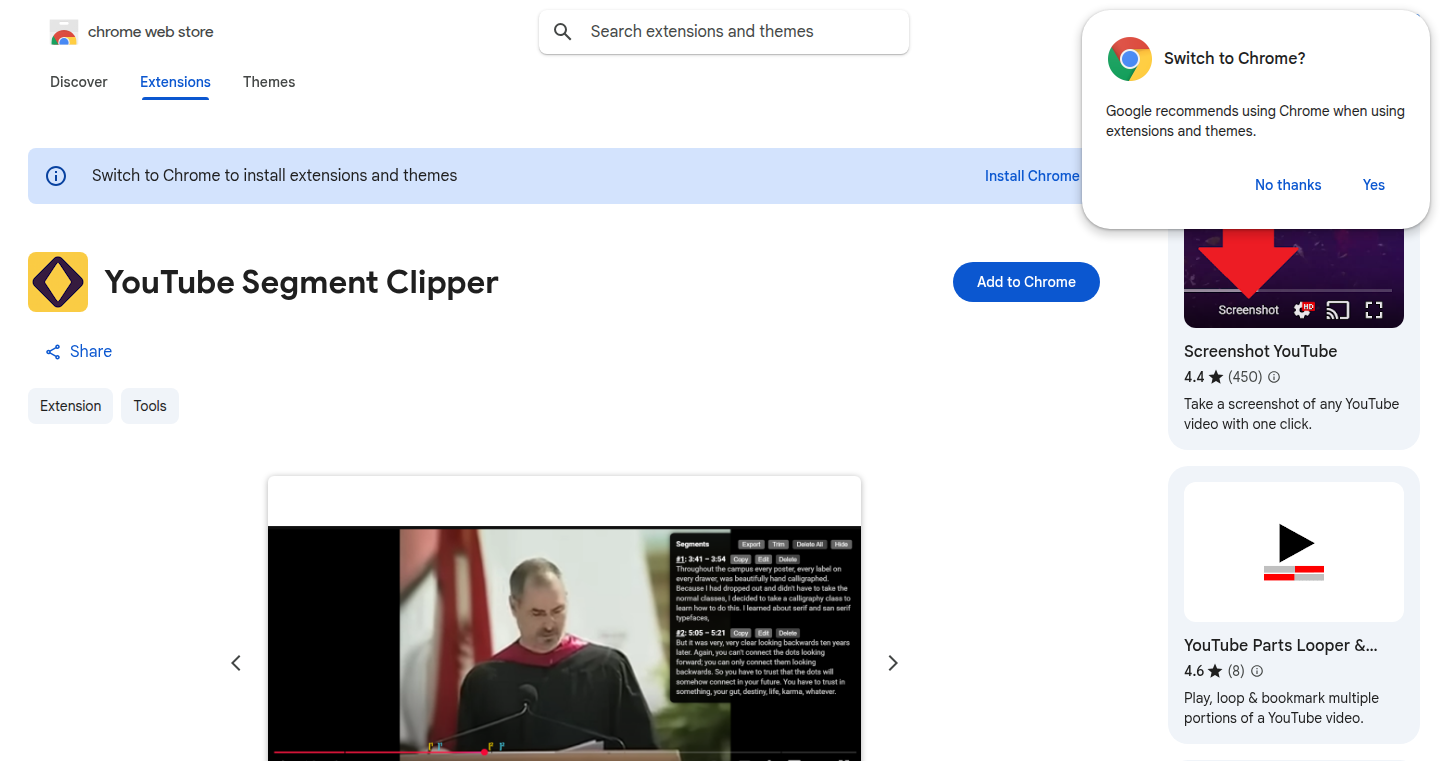
url
Author
f_k
Description
This Chrome extension lets you save specific moments from YouTube videos along with their corresponding transcript text. It addresses the problem of needing to quickly reference and share particular segments of long videos. It cleverly combines the power of YouTube's existing transcript data with a user-friendly interface to create a more efficient way to consume and share video content.
Popularity
Points 2
Comments 0
What is this product?
This extension works by integrating directly with YouTube. When you're watching a video, it allows you to click a button to save the current timestamp along with the text from the transcript at that moment. Think of it like creating bookmarks, but instead of just the time, you also get the relevant text. This is innovative because it leverages readily available transcript data to enhance the user experience, making it much easier to revisit and share specific information from videos. So this is useful because you no longer need to manually write down timestamps or copy and paste large portions of text. It makes it very easy to extract what is useful in a video.
How to use it?
After installing the extension, a new button appears on YouTube video pages. While the video is playing, simply click this button at the desired time. The extension automatically grabs the timestamp and the transcript text. Saved snippets can be easily accessed and shared. Developers can use it by installing the extension in their browser. This extension integrates seamlessly with the YouTube interface, eliminating the need for any complex setup. This approach enhances the user's ability to collaborate and reference specific video content. So this is useful because it's extremely simple to use and doesn't require extra steps like signing up for a service or copying the link to other services.
Product Core Function
· Timestamp and Transcript Capture: Captures the exact time and transcript text, enabling precise referencing of video segments. This has value because it removes the need to manually search or rewind the video to find the content you need.
· User-Friendly Interface Integration: Seamlessly integrates with the YouTube interface, providing quick access to the timestamp-saving function. This has value because it simplifies the user experience, making it straightforward to capture and save important video moments.
· Snippet Management and Sharing: Enables the management, organization, and sharing of saved video snippets, which improves team and individual work. This is useful because this function enables collaborative discussion and quick reference of key video data in discussions.
Product Usage Case
· Educational Settings: Students can quickly capture and share important moments from online lectures for later review and study. This is useful because it streamlines the learning process and encourages active note-taking.
· Research and Analysis: Researchers and analysts can use it to save specific segments of video interviews or presentations, adding context for their findings. This is useful because it increases the efficiency and accuracy of the research process.
· Collaborative Project Management: Project teams can share specific video clips and discussions with teammates, creating a shared context for discussion. This is useful because it facilitates team communication and ensures everyone is on the same page when discussing video material.
70
DrinkMe - The Minimalist Video Compressor
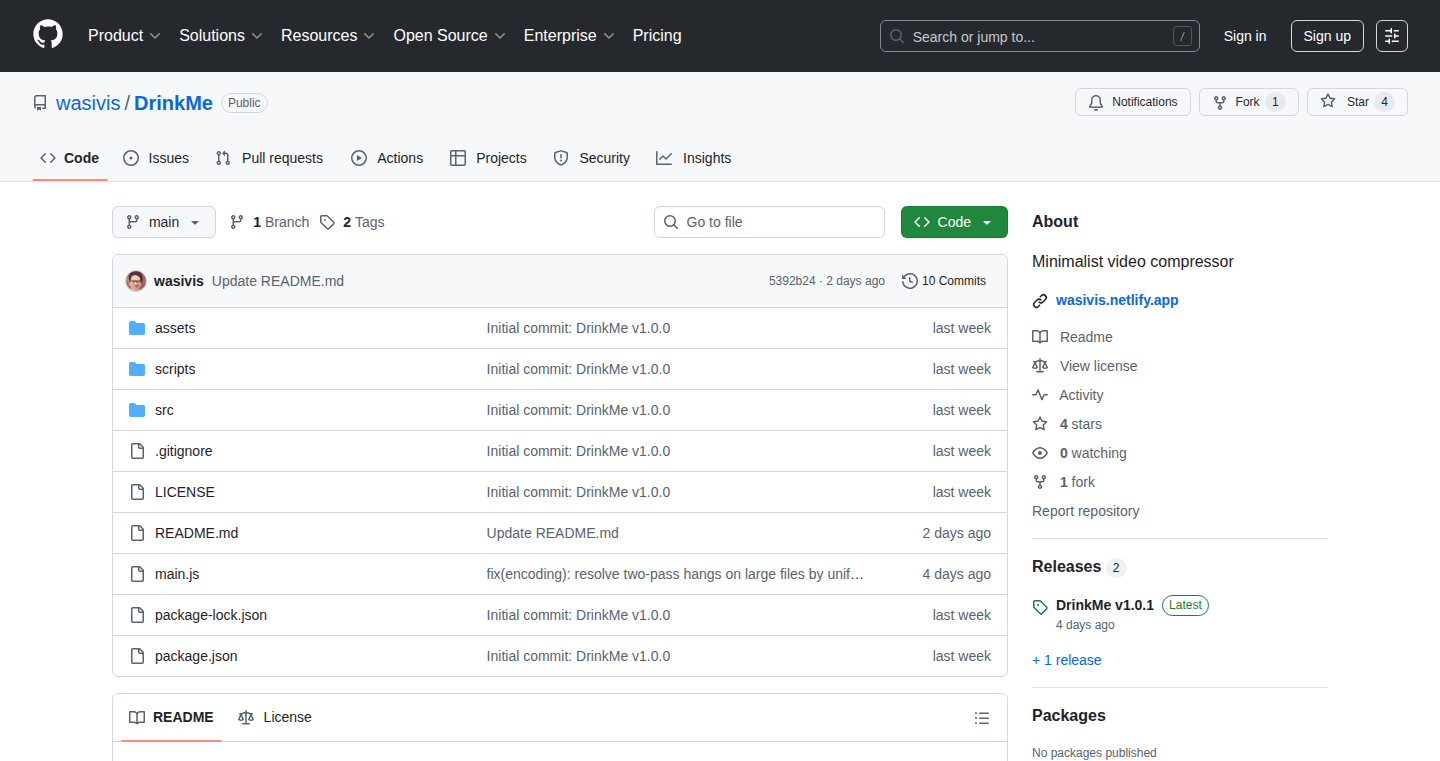
Author
wasivis
Description
DrinkMe is a desktop application built with ElectronJs, designed to simplify video compression for everyone. It tackles the challenge of complex command-line tools like FFmpeg and Handbrake by offering a user-friendly interface. It utilizes a two-pass FFmpeg encoding process to efficiently compress videos, intelligently estimating the final file size based on various factors like video duration, resolution, quality, and initial size. The aim is to reduce video file sizes by around 80-85% without significant loss of quality, making it easy for non-technical users to save space and share videos more easily.
Popularity
Points 2
Comments 0
What is this product?
DrinkMe is a simplified video compressor, think of it as a user-friendly version of powerful tools like FFmpeg. It uses FFmpeg behind the scenes, but hides the complicated settings. It takes your video and shrinks it down, aiming to save space while keeping the video looking good. It smartly analyzes your video to figure out the best way to compress it. So, it's all about making video compression easier for everyone.
How to use it?
Developers who want to integrate video compression into their applications or workflow can use DrinkMe as inspiration. While the application itself is not designed to be directly integrated as a library, the underlying principles and approaches used (ElectronJs, FFmpeg integration, user-friendly interface design) can be valuable. For instance, if you're building a video editing tool or a platform that handles user-uploaded videos, you can learn from DrinkMe's design to create a similar compression feature. You might study how it handles FFmpeg calls, how it estimates the final file size, or how it provides a clean user experience. This can save you time and effort by leveraging the lessons learned by the creator.
Product Core Function
· Two-pass FFmpeg Encoding: This is the core technology used for compressing the video. It analyzes the video in two steps to achieve better compression rates and video quality. So this gives users a more efficient way to reduce video file size without sacrificing too much quality.
· Dynamic Size Estimation: DrinkMe predicts the final size of the compressed video before the process is complete. This helps the user to see how much space will be saved and make a decision on whether to compress it or not. So, the user can have some insights on the potential reduction and make informed decisions.
· ElectronJs Based Desktop Application: Build on ElectronJs, which gives users cross-platform compatibility without complicated configuration. So, it simplifies cross-platform development, making it easy to use the compressor regardless of what operating system they are using.
· Minimalist User Interface: By providing a simple and easy-to-use interface, the user experience has been improved by eliminating all the complicated options and settings. So, it makes video compression accessible to a wider audience, including people who are not technically inclined.
Product Usage Case
· Video archiving: You have a lot of videos and want to save storage space. You can compress your video collection using DrinkMe, reducing the overall file size. This frees up storage space without noticeably reducing video quality. So, it helps in the long term to save on storage costs.
· Sharing videos online: You want to share your video on social media or send it via email, but the file is too large. DrinkMe can help you compress the video before uploading it, ensuring faster upload times and easier sharing. So, it makes it easier to share videos with friends or post online.
· Building Video editing apps: Developers can learn how the tool encapsulates complex command-line tools (FFmpeg) within an easy-to-use UI. They can take notes on creating applications for non-technical users to access features like video compression. So, it provides a blueprint for building simple, user-friendly video processing tools.
71
ETHShot: Ultra-Simple Blockchain Jackpot Game
Author
cranberryturkey
Description
ETHShot is a tiny decentralized application (dApp) built on the Ethereum testnet. It's a simple game where users can take a 'shot' at winning a jackpot by paying a small amount of test ETH. The core innovation lies in its simplicity: a smart contract written in under 80 lines of code manages the game logic, showcasing how complex functionalities can be achieved with minimal code in the blockchain environment.
Popularity
Points 2
Comments 0
What is this product?
ETHShot is a blockchain-based lottery. When you play, you send a tiny amount of test cryptocurrency (ETH) to a smart contract. This contract randomly selects a winner with a 1% chance. If you win, you get the entire pot. It's built on the Ethereum testnet, which means it uses fake money so you can play around without risking real money. The core technology is a smart contract, which is essentially a set of rules that live on the blockchain and automatically execute when certain conditions are met. The innovative aspect is its simplicity: the game's logic, including random number generation and payout, is written in a concise, easy-to-understand code, demonstrating how much can be achieved with minimal code in blockchain development. So what's the point? It's a fun way to learn about blockchain technology and dApp development without any real-world financial risk.
How to use it?
Developers can use ETHShot as a starting point for understanding smart contract development, specifically for games or applications with lottery-like mechanics. The source code, which is publicly available on GitHub, can be studied to learn how to implement random number generation, handle cryptocurrency transactions, and manage game state within a smart contract. It also provides a model for building simple decentralized applications (dApps) with a user-friendly interface. So, you can learn how to build your own blockchain lottery or game, customize the rules, and integrate it into your existing projects.
Product Core Function
· Smart Contract for Jackpot Mechanics: This feature implements the core game logic, including receiving payments, random winner selection, and distributing the jackpot. The value is that it demonstrates a simple, secure, and transparent way to manage funds and randomness on the blockchain. It helps in building similar applications with financial elements. So this is a good example to understand how to build a decentralized lottery or any application that requires random selection and payout mechanisms on the blockchain.
· Testnet Integration: Built on the Ethereum testnets (Sepolia/Goerli). The value is that it allows developers and users to experiment with the application without spending real money. This reduces the barrier to entry and promotes experimentation and learning. So it enables safe testing and debugging of blockchain applications before deploying them on the mainnet, saving time and resources.
· Simple User Interface (Svelte Front-end): The front-end, written in plain Svelte, provides an easy-to-use interface for users to interact with the game. The value is that it simplifies the user experience and allows users to easily understand the game's rules and how to participate. So it shows a basic example of creating a user-friendly interface for decentralized applications, improving the user experience.
· Open Source Code: The entire project's code is available on GitHub. The value is that it allows developers to learn from, modify, and contribute to the project. This fosters collaboration and accelerates innovation in the blockchain space. So, you can copy the code to understand how it works and modify it to create your own blockchain games or applications.
Product Usage Case
· Learning Smart Contract Development: Developers new to blockchain can study the ETHShot smart contract to understand fundamental concepts like handling transactions, managing state, and random number generation. For example, by examining the contract code, developers can learn how to build a basic lottery system. So, it is a great educational resource for those wanting to explore smart contracts.
· Building Simple dApps: The project demonstrates how to build simple decentralized applications with minimal code and a user-friendly interface. Developers can adapt the core logic to create other similar applications, such as simple prediction markets or donation platforms. So, it is a valuable template for small dApps.
· Rapid Prototyping: Developers can use the existing code as a template to quickly prototype ideas for other blockchain-based games or applications. This allows for faster experimentation and iteration. So, it can save time in building new blockchain products by providing a functional starting point.
72
NameGen: Startup Name Combinator with Domain Availability
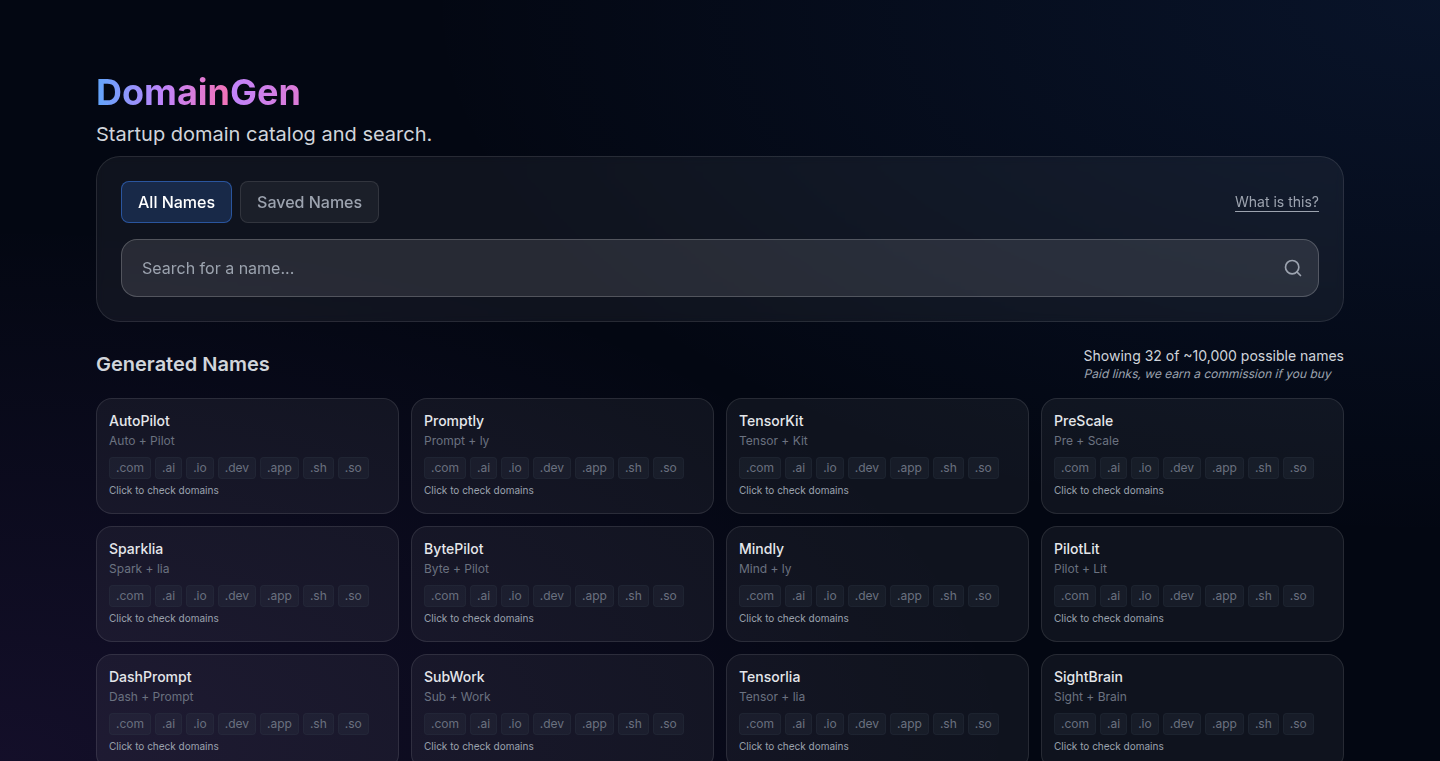
Author
Areibman
Description
NameGen is a tool that helps you generate startup names by combining common words found in successful startup names. It then checks the availability of domain names on Namecheap. The innovation lies in automating the process of name generation and domain lookup, addressing the common problem of finding a unique and available name for a new business. This reduces the time and effort spent on brainstorming and manually checking domain availability.
Popularity
Points 2
Comments 0
What is this product?
This is a web application that takes a list of popular words used in startup names (like 'base,' 'loop,' 'layer,' or 'stack') and combines them in various ways. It then checks if those combinations have available domain names on Namecheap. Think of it as a smart name generator for your company. The core idea is to help you quickly find a good name and verify if the domain name is free. So you don't have to manually try out different names and search for them.
How to use it?
You would go to the NameGen website, likely enter the words you want to combine, and the tool will give you a list of name suggestions along with their domain availability. You could then register those available domains directly. Use cases include when you are starting a company, or when you're rebranding an existing product. So, as a developer or a company builder, you would use it to save time and find a perfect name faster.
Product Core Function
· Name Generation: This function creates potential startup names by combining a predefined list of words. This is useful because it allows you to explore a variety of name options quickly. For example, it can generate names like "base loop" or "layer stack". So this gives you a lot of ideas fast.
· Domain Availability Check: After generating names, the tool checks if the corresponding domain names are available for purchase on Namecheap. This is valuable because it automates a time-consuming process. So this helps you know if your name is actually available for use.
· User Interface: The web application provides a user-friendly interface for generating and checking names. This makes the tool easy to use even if you are not a technical expert. So this makes it a great tool for anyone to use.
Product Usage Case
· Startup Name Brainstorming: A startup founder needs a name and uses NameGen to find options by combining different words. This helps them quickly come up with several potential names instead of manually brainstorming. So you can come up with new ideas quickly.
· Rebranding a Product: A company is changing the name of its product. They use NameGen to suggest new names and see if the domain names are available. This allows them to find a suitable name without manually searching. So you save a lot of time when rebranding.
· Side Project Naming: A developer wants to launch a side project and needs a catchy name. They use NameGen to discover a unique name and check its availability, simplifying the process. So you can quickly find a cool name for your projects.
73
Coder.ninja - Project & Coder Discovery Platform
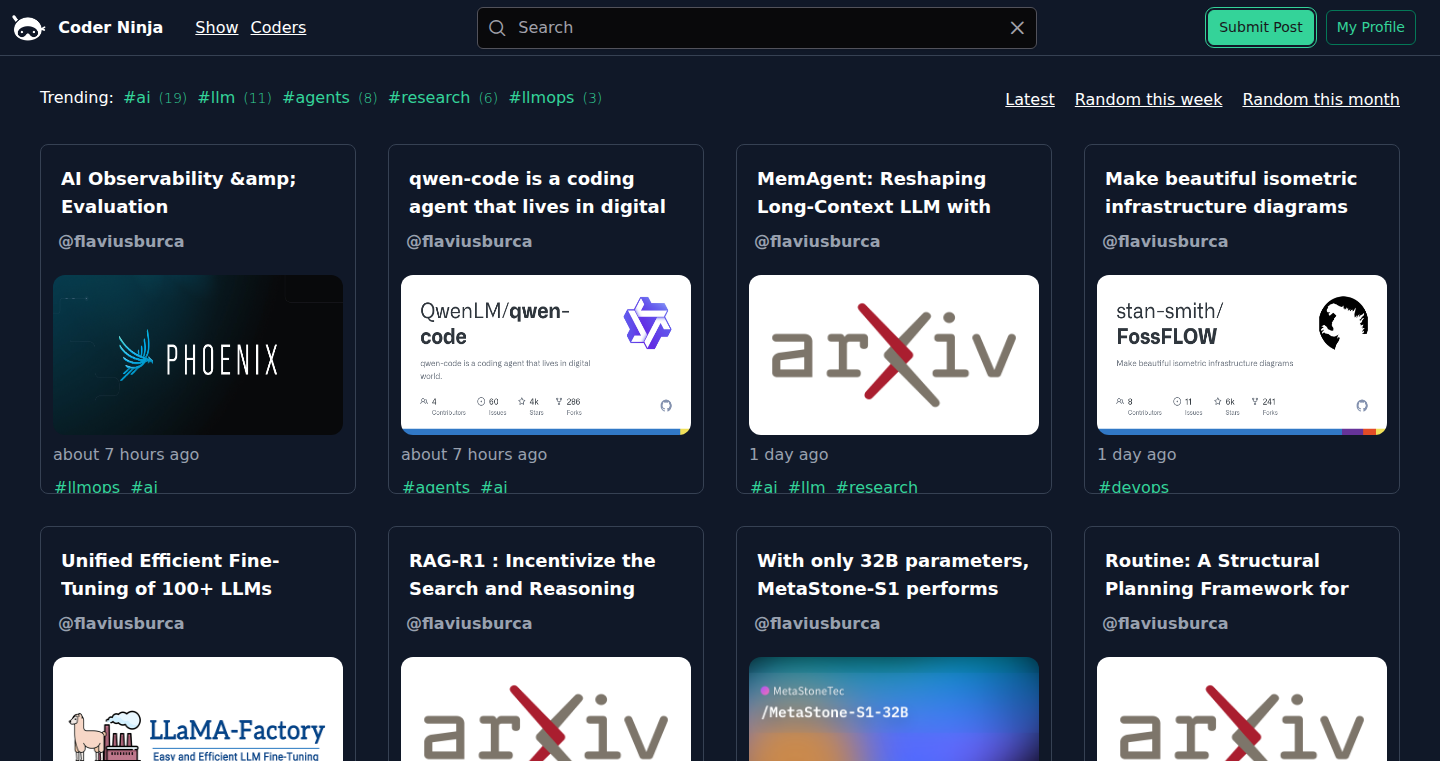
Author
ethx64
Description
Coder.ninja is a platform designed to help developers discover outstanding open-source projects and connect with skilled coders. It leverages a curated approach, potentially using algorithms or community input, to surface high-quality projects and developers, offering a focused alternative to broader platforms. The technical innovation lies in its curated approach to project discovery and developer networking, which helps filter out noise and connect users with relevant, high-quality resources. It tackles the problem of information overload in the vast world of open-source projects and developer communities.
Popularity
Points 1
Comments 0
What is this product?
This project acts as a specialized search engine and social network for developers and open-source projects. Instead of general purpose search, it prioritizes quality over quantity. It likely uses a combination of techniques such as project categorization, developer profiles, and perhaps even manual curation to ensure high-quality results. This means it provides a more focused and efficient way to find the right tools and connect with the right people. The innovation is in creating a curated, high-signal environment, in contrast to the unfiltered firehose of information on many other platforms.
How to use it?
Developers can use Coder.ninja in several ways: to find specific projects that solve their problems, to discover tools and libraries to integrate into their own work, or to connect with developers who possess specific skills. Integrations would likely involve browsing the platform, exploring projects and profiles, and connecting directly with the creators or contributors. For example, a developer looking for a new data visualization library might search Coder.ninja and find a curated list of excellent options, saving significant time compared to searching through generic search results.
Product Core Function
· Curated Project Discovery: This is the core function. It sifts through numerous projects to highlight those with high quality and relevance. This saves developers time and effort in finding suitable solutions. The user could utilize this function when starting a new project and need to find related open source tools. It helps solve the issue of information overload.
· Developer Profiling & Networking: Providing a way for developers to showcase their skills and connect with each other. Helps match developers with projects and projects with developers, enabling collaboration and efficient team formation. Developers looking for specific skill sets could quickly identify potential collaborators.
· Project Categorization and Tagging: Categorizing projects by functionality or technology. Helps users quickly narrow down their searches and find solutions that fit their needs. A developer wanting to find a specific Machine Learning library can leverage this functionality.
· Community Feedback and Rating (potential feature): Allows users to rate and provide feedback on projects and developers. Helps to validate project quality and identify the best developers. This can be very valuable for developers looking for reliable and production-ready solutions.
Product Usage Case
· A software engineer is starting a new web application project and needs a reliable JavaScript framework. Instead of spending hours searching and testing different frameworks, they can use Coder.ninja to find a curated list of recommended frameworks, saving considerable time and effort.
· A team of developers needs to find experts in a specific programming language, like Python. They can use the platform to search for and connect with skilled developers, accelerating the project's progress.
· An open-source project maintainer wants to promote their project and attract contributors. They can list their project on the platform to get visibility to a relevant audience, which can foster community building and feature contribution.
74
NextDevKit: Universal Next.js SaaS Template
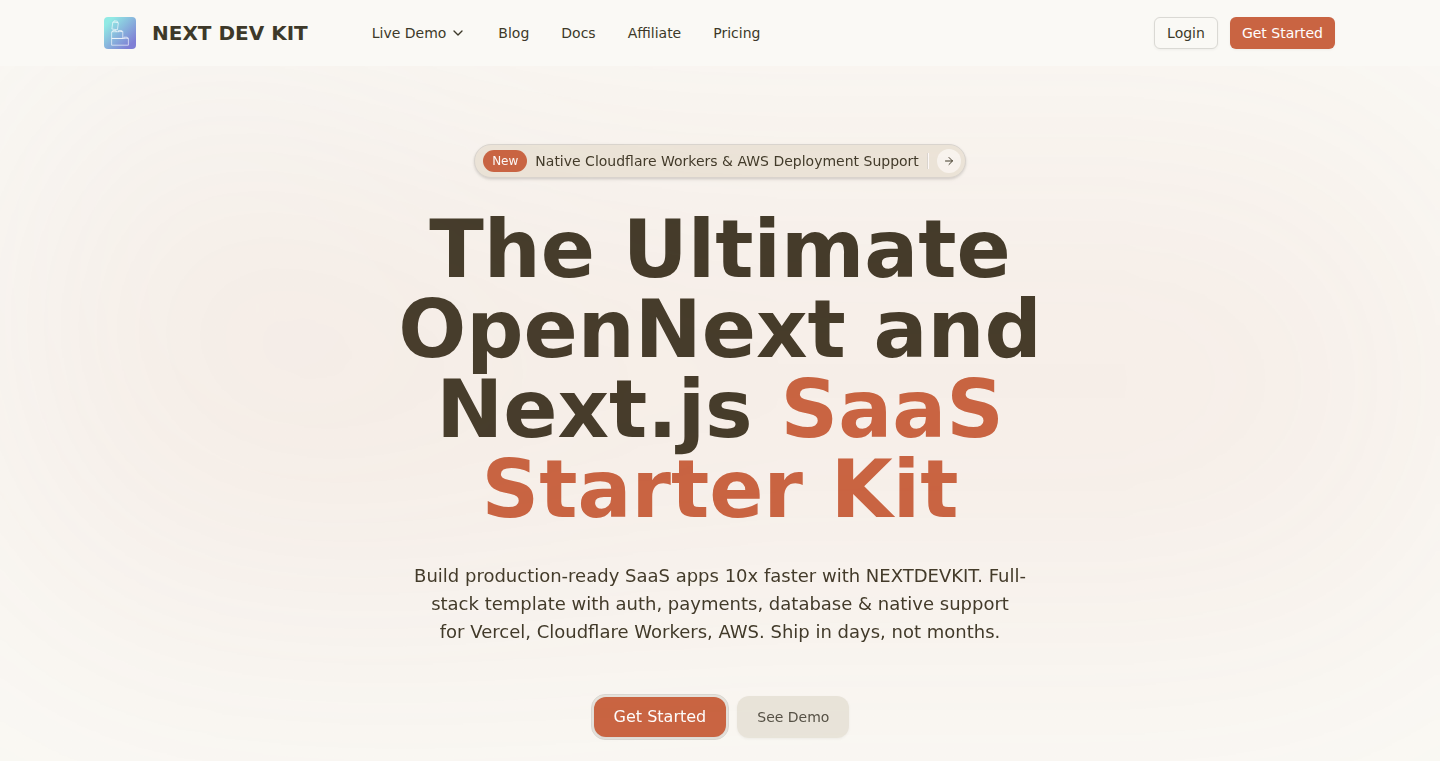
Author
guangzhengli
Description
NextDevKit is a pre-built template for creating Software as a Service (SaaS) applications using Next.js. The core innovation is its ability to deploy seamlessly across multiple platforms: Vercel, Cloudflare Workers, and AWS. This addresses the common problem of Next.js templates being limited to a single deployment environment, offering developers flexibility and cost-effectiveness.
Popularity
Points 1
Comments 0
What is this product?
NextDevKit is a comprehensive starting point for SaaS projects built with Next.js. It provides a ready-to-go infrastructure with features like user authentication, payment integration, database support, and email services. The key innovation lies in its deployment flexibility. It leverages technologies like OpenNext for Cloudflare Workers compatibility and SST (Serverless Stack Toolkit) for streamlined AWS deployments. The template allows you to choose the best hosting solution based on your project's needs and budget. So this helps you deploy your SaaS application on different platforms without rewriting the code.
How to use it?
Developers can use NextDevKit by cloning the template and customizing it to fit their SaaS application's specific requirements. This includes modifying the UI, integrating their business logic, and connecting to their preferred services (e.g., Stripe for payments). Deployment is straightforward, with pre-configured scripts for Vercel, Cloudflare Workers, and AWS. You can select the deployment platform you like and then use its deployment tool. For example, if you want to use Vercel, you can deploy it by connecting to your Vercel account, and then the service will guide you how to deploy your app. The integration is usually simple, since it is already configured in NextDevKit. So this means you don't need to set up things from scratch, and saves you a lot of time and effort.
Product Core Function
· Authentication (Better Auth): Provides a secure and easy-to-use system for user registration, login, and management. So this allows you to build your user management system quickly.
· Payments (Stripe): Integrates with Stripe to handle payment processing, subscriptions, and billing. So this lets you take money from customers easily.
· Database (Drizzle ORM): Offers a database abstraction layer, making it easier to interact with various database systems (e.g., D1, RDS). So this simplifies how you store and retrieve data for your application.
· Email (Resend): Integrates with an email sending service for transactional emails (e.g., welcome emails, password resets). So this enables you to send email without much work.
· File storage (S3/R2): Integrates with cloud storage services for storing and serving files. So this allows users to upload and manage files easily.
· Blog & docs (FumaDocs): Includes a blog and documentation system for creating content. So this helps you create your documents and post without much work.
· i18n support: Provides internationalization support for multiple languages. So this allows you to make your SaaS application global.
· GDPR-compliant analytics: Integrates with a privacy-focused analytics solution. So this allows you to analyze your app's data without worrying about the regulations.
Product Usage Case
· Developing a SaaS application requiring scalability and cost-efficiency: Deploying on Cloudflare Workers using OpenNext allows for significant cost savings compared to Vercel, especially for smaller projects. So this lets you save money on hosting costs without compromising performance.
· Building an enterprise-grade SaaS application with high availability and compliance requirements: Leveraging AWS with SST enables deployment to AWS with RDS, Lambda, and CloudFront, providing robust infrastructure and security features. So this allows you to create a secure and reliable application.
· Creating a multi-platform SaaS product, targeting different customer needs: Deploying the same codebase on Vercel for rapid prototyping, Cloudflare Workers for budget-conscious users, and AWS for enterprise clients. So this provides options for your customers to choose the best option for their needs.
75
BoyDogNames.net: An AI-Powered Dog Name Generator

Author
droidHZ
Description
BoyDogNames.net is a website designed to help new dog owners quickly find a suitable name for their male dog. It leverages a searchable and filterable database of over 40,000 names categorized by style (classic, funny, etc.). The site incorporates AI for personalized name suggestions based on the dog's story or photo (coming soon), and allows users to vote and favorite names to evolve the list. The project is built with Next.js, Supabase, Replicate/OpenRouter for AI, and deployed on Vercel, emphasizing speed with static and on-demand API calls. This project is a practical application of single-keyword micro sites for SEO and fast product validation.
Popularity
Points 1
Comments 0
What is this product?
This project is a website that helps new dog owners find names for their male dogs. It uses a large database of names, making it easy to search and filter. The interesting part is the future integration of AI to suggest names based on the dog's characteristics or the owner's preferences. It's built using modern web technologies like Next.js for the website, Supabase for storing the names, and Replicate/OpenRouter to use AI models for generating names. This project addresses the common problem of choosing a dog name, making it easier and more fun. So what's cool? Using AI to make the name selection process more personalized and relevant.
How to use it?
Dog owners can visit the website and browse or search through the list of boy dog names. They can filter by style (e.g., classic, funny). As the AI feature rolls out, users will be able to upload a photo of their dog or describe their dog to receive tailored name suggestions. The core value here is providing a fast and user-friendly way to find a suitable dog name. For developers, the site showcases a practical application of modern web development techniques, SEO strategies for niche markets, and integration of AI tools. This would enable them to create similar websites or integrate this technology into their own projects.
Product Core Function
· Searchable and Filterable Name Database: Provides a user-friendly interface to browse a vast collection of dog names, categorized by style. This allows users to quickly narrow down their choices based on their preferences. The value here is an easy and accessible way to find a name matching the dog's personality or the owner's style.
· AI-Assisted Name Suggestions: (Coming Soon) Uses AI to generate personalized name recommendations based on the dog's image or description. This provides a unique and tailored experience. This allows the user to receive name suggestions tailored to their dog's unique features and history.
· User Voting/Favorite System: Enables users to vote and favorite names, helping to curate a list of popular names over time. This keeps the list relevant and allows user participation in refining it. This ensures that the website's list remains up-to-date and reflects current name trends and preferences.
Product Usage Case
· Niche Website Creation: Developers can replicate this project to build websites for other niche markets, such as cat names, baby names, or even brand names. This project demonstrates a proven model for finding a specific audience with a targeted solution, leveraging SEO strategies to increase visibility.
· AI Integration: Developers can learn from how AI is integrated to improve the user experience, for example, providing personalized recommendations. It showcases how AI can be used creatively, not just to perform complex tasks but to add real value in a small but important application.
· Fast Product Validation: Developers can learn how to quickly build and launch a website to validate a product idea using modern web development frameworks and tools. This project emphasizes the importance of fast prototyping and iterating based on user feedback.
76
OpenReview Paper Quality Analysis
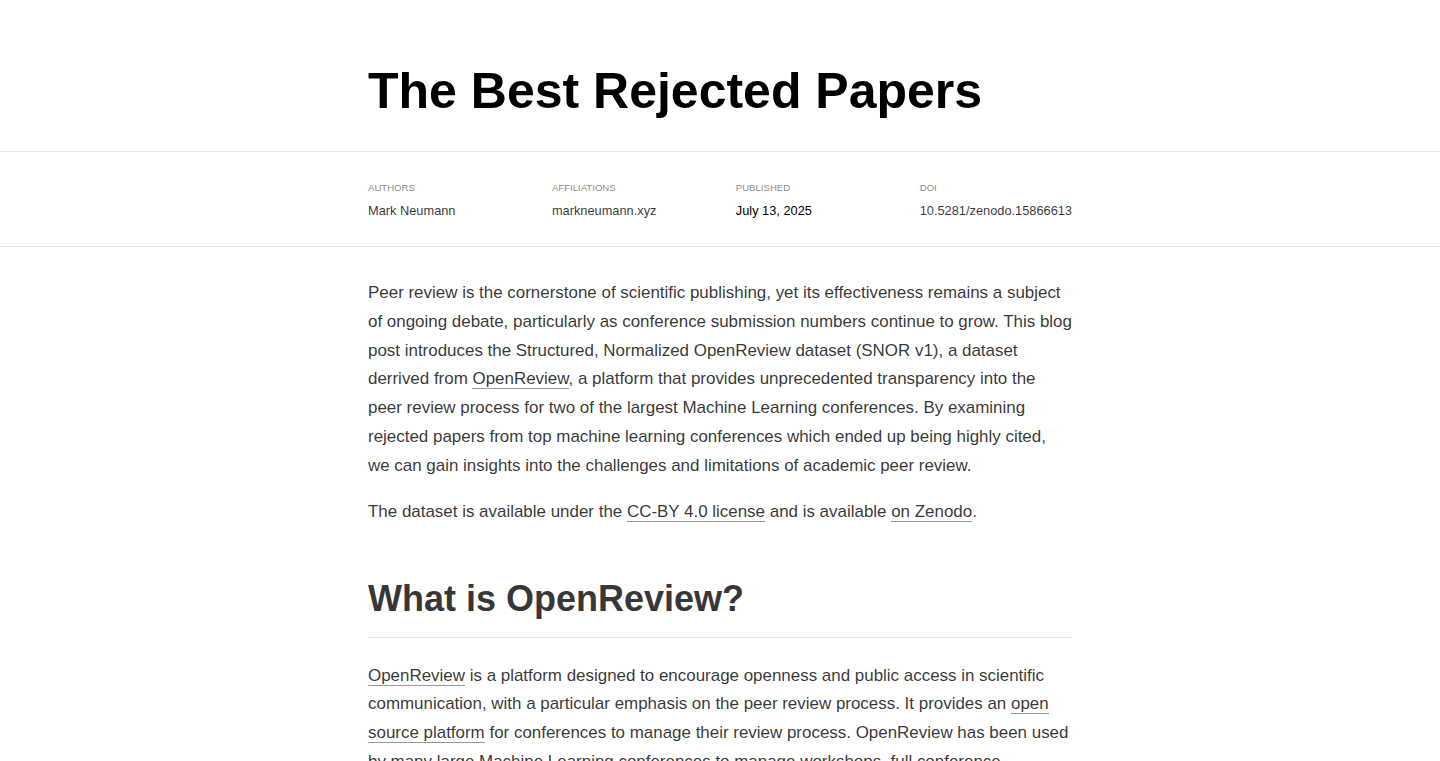
Author
deneutoy
Description
This project analyzes the quality of peer review in the academic field of Machine Learning, by linking open review papers on OpenReview.net to academic databases like Semantic Scholar. It involves processing and analyzing a large dataset of reviews and papers, including ~40,000 linked papers and ~400,000 structured review comments. The goal is to understand the peer review process and identify high-quality research, even if initially rejected. The creator highlights "Best Rejected Papers" from ML conferences, demonstrating the project's ability to uncover valuable research contributions. So this tells you what makes a good research paper and how it's evaluated by others.
Popularity
Points 1
Comments 0
What is this product?
This project explores the peer review process in Machine Learning. It uses publicly available data from OpenReview.net, a platform for conference reviewing, and connects papers with academic databases. It's like building a search engine for the quality of research reviews. It collects data of papers and the reviews of those papers and then tries to find a pattern to determine which papers are considered valuable. This project creates a dataset and analysis tools for better understanding how research is evaluated. So this project is a guide to the quality of research.
How to use it?
Researchers and developers can use this project to analyze review data, and evaluate research papers and improve their own research. They can examine the datasets to discover new findings and gain insights. Think of it as a tool to help you understand the quality of academic research. Developers can use the datasets and analysis tools to understand how successful research works. It involves accessing the data, which is used to create more powerful research.
Product Core Function
· Linking OpenReview papers to academic graphs (Semantic Scholar): This links paper reviews to other academic databases, giving a wider view of how papers are evaluated. This increases the ways papers can be discovered and allows for a better understanding of the impact of a certain paper. So this helps you find valuable research.
· Compiling a dataset of structured review comments: It collects and organizes review comments to better understand the review process. It gives a way to study and use reviews more efficiently. So this helps in the analysis of research reviews.
· Identifying "Best Rejected Papers": Analyzing the dataset to find high-quality papers that were initially rejected. This shows the project's ability to find and highlight valuable research. This offers a way to find good papers that might otherwise be missed. So this helps you find valuable research even if it was initially rejected.
· Analysis of peer review quality over time: This means studying how the review process changes over time. The value is it allows researchers to assess the effectiveness and trends in peer review. So this tells you what's important in good research over time.
Product Usage Case
· Identifying influential papers that were initially rejected from ML conferences: This highlights the ability to find important research that was almost missed. This shows how the analysis can pinpoint valuable work. So this can tell you about overlooked research.
· Analyzing the characteristics of high-quality reviews: Understanding what makes a good review can help improve the peer review process. It can help researchers and developers know how to create better reviews. So this can tell you how to give a good research review.
· Creating datasets for further research: The project provides a valuable dataset that other researchers can use. Researchers can use the dataset to study different aspects of the paper review process. So this makes future studies about paper reviews easier to perform.
77
Prismy: In-Context Webapp Translation Editor
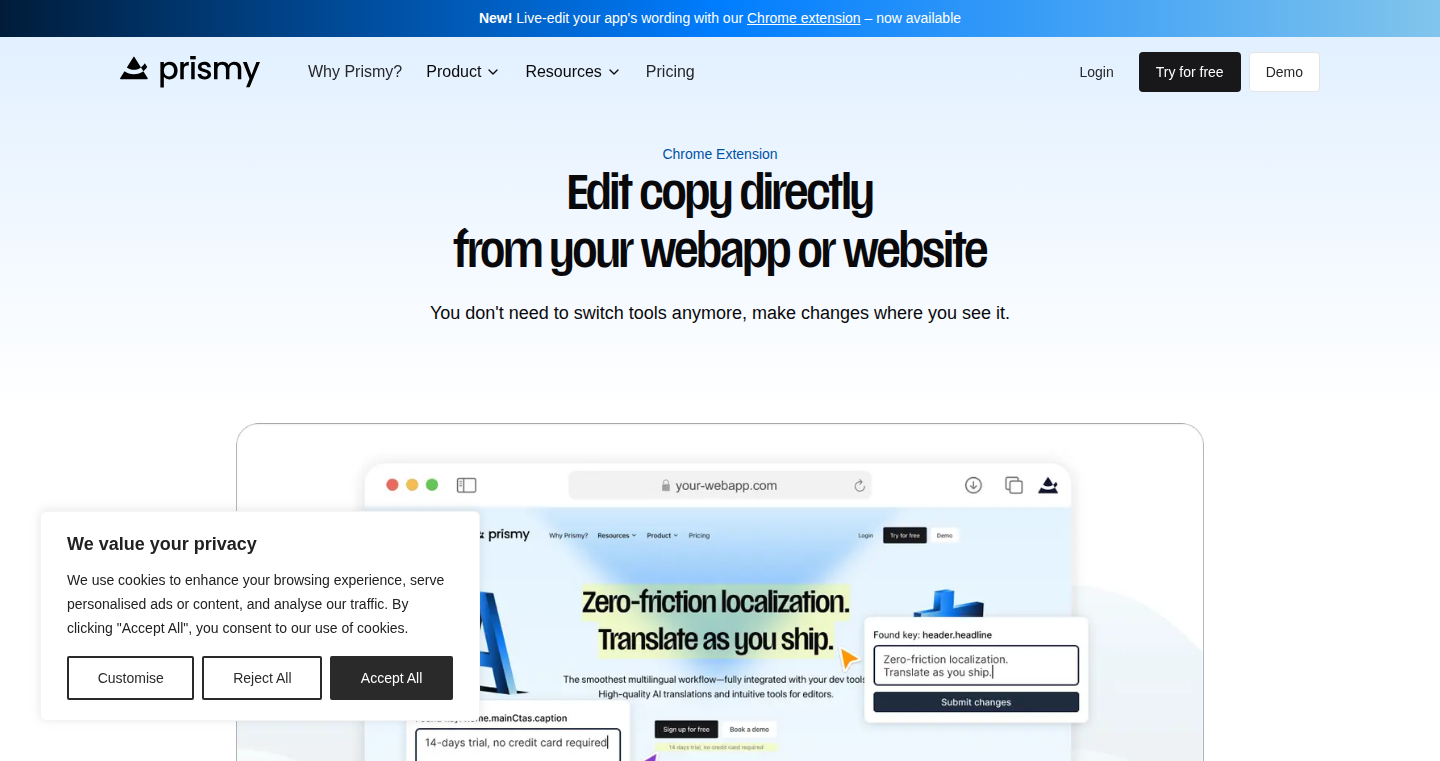
Author
allard_eric
Description
Prismy is a Chrome extension that lets you edit the text on your website directly, in real time. Instead of developers getting constant requests to change wording and having to jump between different tools to find and update the text, anyone on the team can now simply click on the text they want to change on the live website. The extension then handles the backend by suggesting and submitting the changes as pull requests. This tackles a common problem in web development: the slow and cumbersome process of updating website text, which often involves developers and takes a lot of time. So, for developers, this saves time and improves efficiency. For non-developers, it gives them the ability to make these changes themselves. In short, it’s like having a live editing tool for your website text.
Popularity
Points 1
Comments 0
What is this product?
Prismy is a Chrome extension. It allows anyone to directly edit the text displayed on a website, like changing a button label or updating a paragraph. The core of Prismy is its ability to identify the internationalization (i18n) keys associated with the text you're seeing on the page. It uses a combination of techniques like DOM manipulation (inspecting the website's structure) and pattern matching to link the displayed text to its corresponding key. When you click on the text, Prismy highlights it and lets you edit it directly. The changes are then managed as pull requests, streamlining the workflow for updating website text. The main innovation is how it combines a user-friendly interface with a smart backend that automates the process of finding, updating, and submitting text changes. So this means, instead of developers manually finding the right code to change, anyone can edit the text on the site and it will handle how to update it in the system.
How to use it?
Install the Chrome extension and navigate to your web application. When you spot a text that needs changing, simply click on it. Prismy will present an interface to edit the text. You can then preview the changes in real-time. After you're happy with the changes, Prismy will allow you to submit them. These changes will be suggested as pull requests to make sure your developer team reviews them. You can integrate it with your translation management system so the changes are done directly within the system. So, you can use it by just clicking on the text you want to change.
Product Core Function
· In-Context Editing: When you're browsing your website, you can just click on any text to edit it directly. Value: Allows instant updates without code changes. Application: Ideal for quick wording adjustments or content fixes.
· Real-Time Preview: See how the changes look immediately on your live website. Value: Removes the guesswork from editing and confirms the final result. Application: Ensure the text looks good, and it is in context, before submitting it.
· Automated Pull Request Generation: After editing, Prismy creates a pull request. Value: Streamlines the workflow for merging changes into the main codebase. Application: Improves the review and approval process and gives developers a structured process for handling text updates.
· Context Switching Elimination: Avoids the need to open multiple tabs or tools to locate and modify the text. Value: Increases efficiency and reduces development time. Application: Useful for teams that handle frequent website text updates.
Product Usage Case
· Content Updates: A marketing team needs to adjust the call-to-action button text on a landing page. They click on the button text, edit it directly in the context of the page, and submit the change. Value: Faster content iteration. The team sees the changes in real time and does not depend on a developer.
· Internationalization: A product team needs to update a phrase in a different language. They can click on the text in the translated version of the website, edit it, and confirm the change in context. Value: Easier multilingual content management. The process is more efficient when handling internationalization content.
· A/B Testing: A marketing team wants to quickly test different wording options for a headline. They can use Prismy to edit the headline, see how each option looks, and quickly submit the best version. Value: Allows for more effective and rapid testing. No need to involve developers or wait for deployments.
78
StoryMotion: Motion Graphics Creation with Excalidraw

Author
chunza2542
Description
StoryMotion is a tool that transforms the popular whiteboard drawing tool Excalidraw into a powerful motion graphics creator. It allows users to sketch out ideas visually, add animated effects, and export the result as a video. This project addresses the need for a simple, yet effective way to create animated explanations, tutorials, and other motion graphics without needing complex video editing software. The core innovation lies in using Excalidraw's intuitive drawing interface as the foundation, combined with an animated effects timeline, making motion graphics creation accessible and user-friendly. So it allows you to create animated explanations much easier.
Popularity
Points 1
Comments 0
What is this product?
StoryMotion leverages Excalidraw's drawing capabilities to provide an easy-to-use interface for creating motion graphics. It allows users to draw diagrams, add text, and then animate those elements using a timeline editor. The underlying technology uses JavaScript and likely web technologies (HTML, CSS) to render the drawings and animations. It builds upon Excalidraw's existing functionality by adding features like multi-scene support, Google Fonts integration, and keyboard shortcuts for faster creation. The key innovation is combining the simplicity of Excalidraw with the power of animation, making it easier than ever to create dynamic visuals. So this is for people who want to create animations without needing complex video editing tools.
How to use it?
Developers can use StoryMotion by accessing the web application and sketching their ideas using the familiar Excalidraw interface. They can then add animations to individual elements and adjust their timing using the timeline editor. Finally, they can export the finished result as a video file for use in various platforms. This is especially useful for anyone who needs to quickly create animated explainers for their products, tutorials, or educational content. StoryMotion integrates with the Excalidraw interface, which makes it easy to learn. So you can easily create animated explanations.
Product Core Function
· Sketching and Drawing: StoryMotion builds on Excalidraw, allowing users to create visual elements like diagrams, text, and shapes. This enables users to quickly sketch out their ideas visually. So this gives you a quick and intuitive way to visually represent your ideas.
· Animated Effects: Users can assign animated effects (e.g., fade-in, move, scale) to the elements on the canvas. This adds dynamism to the drawings, making them more engaging. So you can create animations to help your audience pay attention to your content.
· Timeline Editor: The timeline editor allows users to control the timing and sequence of the animated effects. This gives precise control over the animation's flow and how elements appear on screen. So this allows you to control how and when the animations play.
· Multi-scene Support: Users can create multiple scenes to structure their motion graphics. This allows users to break down their content and maintain organization, like slides in Keynote. So this allows you to create more complex animated videos.
· Export to Video: The project exports the animation as a video file compatible with various video editing software. This facilitates further editing and integration into various media. So this allows you to integrate your animations with other media.
Product Usage Case
· Educational Videos: Educators can use StoryMotion to create engaging animated explainers for lessons or tutorials. For example, a teacher can draw a diagram of the water cycle and animate the different stages. So you can create interactive and animated lessons, which helps student learning and understanding.
· Product Demos: Businesses can use StoryMotion to create animated product demos. This involves illustrating features of the product and animating the user interface to demonstrate the product's functions. So you can quickly and effectively showcase your products.
· Explainer Videos: Content creators can use StoryMotion to create animated explainers for a variety of topics. For example, an author can illustrate the plot of a book. So this makes complex topics easier to understand.
· Social Media Content: Users can create short animated clips for social media. This is useful for marketing or sharing information in a visually appealing way. So this makes your content more eye-catching.
79
UGMM-NN: Gaussian Mixture Neuron Network
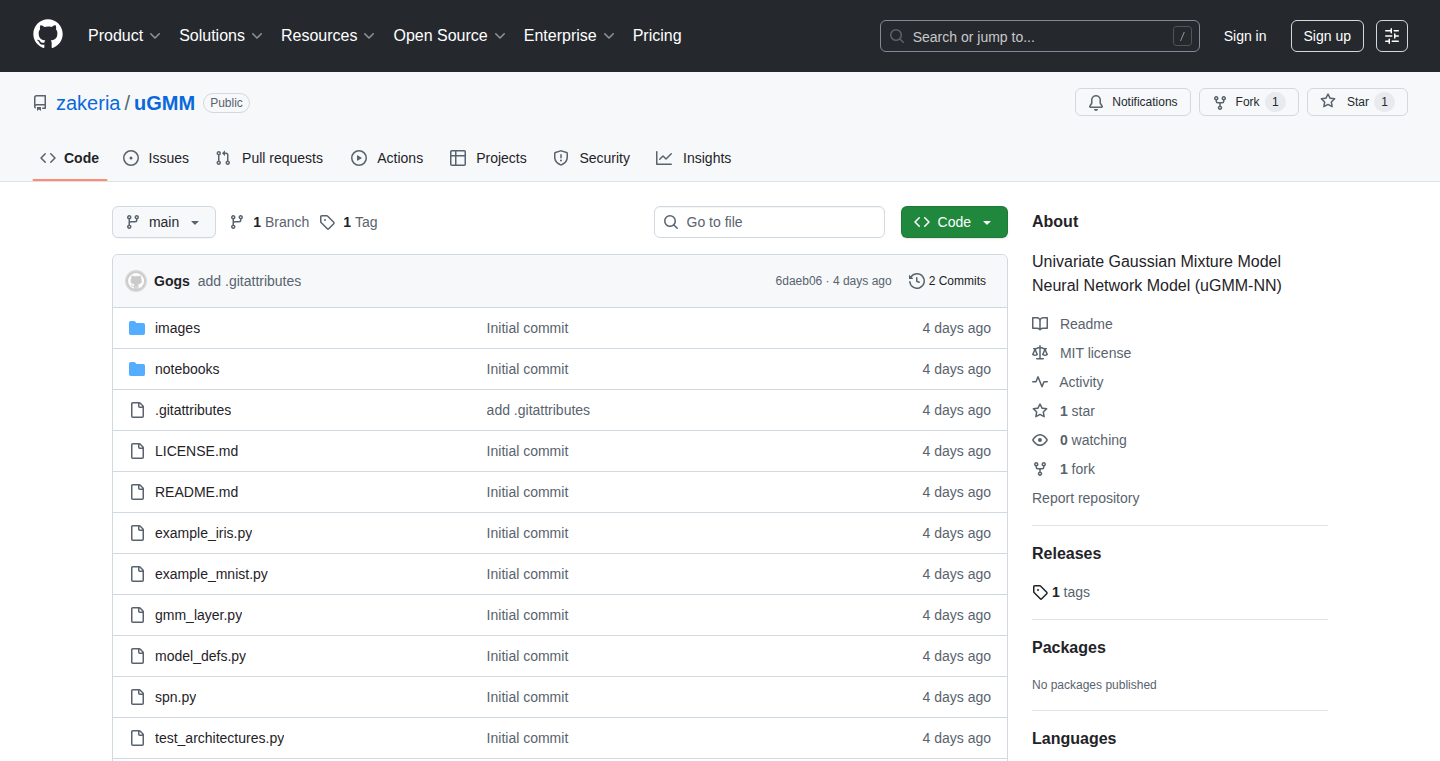
Author
zakeria
Description
This project introduces a novel neural network architecture called UGMM-NN, which uses a special type of neuron: the univariate Gaussian mixture neuron (UGMM). Instead of the typical single number (activation) from a regular neuron, UGMM neurons output a probability distribution (a mixture of Gaussians). This allows the network to model uncertainty and complex data distributions more effectively, potentially leading to better performance in tasks like anomaly detection or probabilistic modeling. The innovation lies in the neuron design and the resulting ability to represent uncertainty directly within the network's calculations, addressing the common problem of networks being overly confident in their predictions.
Popularity
Points 1
Comments 0
What is this product?
UGMM-NN is a type of neural network that's different from the standard kind. The key difference is the type of neuron it uses. Instead of just spitting out a single number, each neuron in UGMM-NN produces a probability distribution. Think of it like a prediction with a 'maybe' part – it doesn't just say what it thinks is right, but also how sure it is. This is done using a mixture of Gaussian distributions, a mathematical trick to handle different possibilities within the neuron's output. This allows the network to better deal with uncertain data and potentially give more accurate and reliable results.
How to use it?
Developers would use UGMM-NN by integrating it into their machine learning pipelines, much like they would with other neural networks. The implementation likely involves using frameworks like TensorFlow or PyTorch, customizing the network architecture by defining the layers and connections using UGMM neurons. Typical use cases would include scenarios where the model's confidence and uncertainty are crucial, for example, financial modeling, medical diagnosis support, and fraud detection. The output being a probability distribution, requires specific training data to handle uncertainty. For instance, in fraud detection, instead of only predicting 'fraud' or 'not fraud', it gives a likelihood distribution over these two possibilities. So it gives you a more informative assessment of the risk.
Product Core Function
· Gaussian Mixture Neuron: The core function is the use of Gaussian mixture neurons. This means each neuron's output is a probability distribution instead of a single number. This is valuable because it lets the network represent uncertainty, essential for tasks where predicting a range of possibilities is more useful than a single point prediction. Application: medical diagnostics, financial risk analysis. So what? You get a more nuanced prediction. Your models become smarter.
· Probabilistic Modeling: UGMM-NN is designed for probabilistic modeling. The network directly models probability distributions, which makes it naturally suited for tasks involving uncertainty and risk assessment. Application: climate modeling, weather forecasting. So what? You can use the model to assess risk.
· Uncertainty Quantification: Because of the probabilistic outputs, UGMM-NN can quantify the uncertainty in its predictions. This is crucial in high-stakes applications where knowing how confident the model is in its predictions is as important as the predictions themselves. Application: autonomous driving, where understanding the range of possible outcomes can improve safety. So what? You can make safer, better decisions based on the confidence of your model's predictions.
Product Usage Case
· Anomaly Detection in Industrial Systems: A developer uses UGMM-NN to build a system for detecting anomalies in sensor data from a factory. The probabilistic output allows the system to flag potential equipment failures with an associated confidence level. This helps engineers prioritize maintenance and prevent costly downtime. So what? You’re notified of potential problems, with a measure of their likelihood, allowing for proactive action.
· Financial Risk Assessment: A financial analyst uses UGMM-NN to model market volatility and predict future price movements. The network’s ability to represent uncertainty helps in estimating the range of possible outcomes, enabling better risk management. So what? You can make more informed financial decisions.
· Medical Diagnosis Support: A team uses UGMM-NN to build a tool to assist in diagnosing diseases, where outputs from UGMM-NN give probabilities of different diseases, assisting medical professionals. This probabilistic output can help doctors in making more informed decisions when the data is complicated. So what? This increases accuracy for medical professionals.
80
LondonStreetText: Text Search for London Street View Panoramas
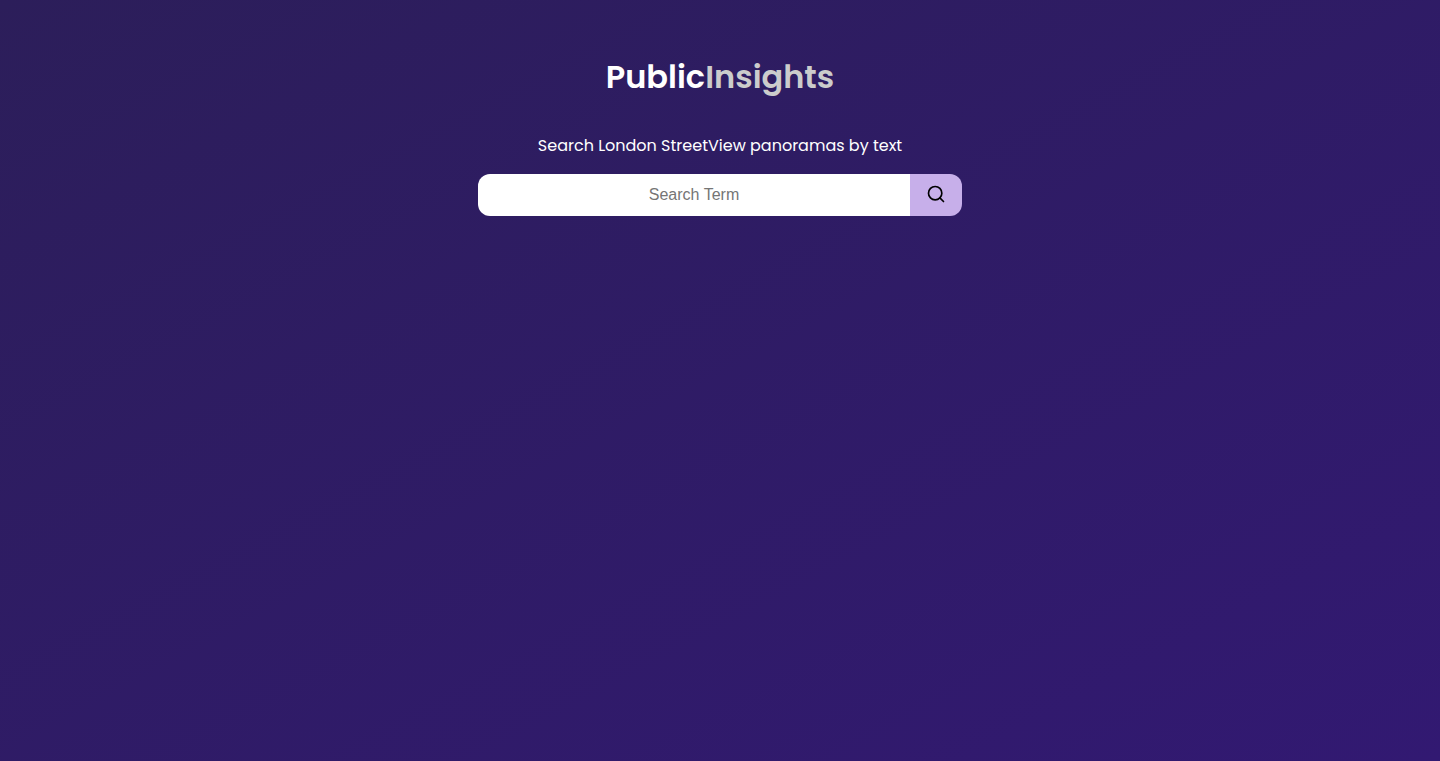
Author
dfworks
Description
LondonStreetText lets you search for text within Google Street View images in London. It's like a search engine specifically for the text you find on shop signs, posters, and even graffiti! It uses clever image recognition techniques to find and identify text in the Street View images, making it possible to find specific words or phrases across a huge dataset of street scenes. The innovation lies in applying Optical Character Recognition (OCR) on a massive scale across street view data.
Popularity
Points 1
Comments 0
What is this product?
LondonStreetText is a search tool that uses advanced image analysis. It scans Google Street View images for London and extracts the text it finds. The core is OCR which converts images of text into searchable text, enabling users to find specific words or phrases. So you can find all the 'Open' signs in London, or maybe the name of a particular shop. This is useful because it gives you access to the hidden information embedded in the visual world. It's a technical implementation of the idea in All Text in NYC, but for London, and uses clever automation to search through all Street View images.
How to use it?
Developers can use LondonStreetText to build applications that interact with real-world text data. For example, integrate it into a location-based application that informs users of local businesses. Or, use it to create a visual archive of how text changes over time. So, you can create a system to analyze business names, advertisements, or even changes in public messaging over the years. Accessing the service could be through an API. The user would send a search query, and LondonStreetText would return the locations and images where that text was found. This allows developers to incorporate real-world text data into their projects easily.
Product Core Function
· Text Extraction from Street View Images: This core function uses OCR to scan and extract text from the millions of Street View images. This is valuable because it converts visual information (text in images) into a searchable, usable format. So it enables you to query for specific text instead of just viewing the image.
· Geographic Indexing: LondonStreetText links the extracted text to the specific location within London where it was found. This gives developers the ability to build location-aware applications. It provides the exact location of a particular sign or piece of text on a map, which is great for urban planning or creating location-based apps.
· Search Functionality: Users can search for specific words or phrases, and the tool returns results including images and the location. This enables easy exploration of the text content in London's street view, which is very useful for researchers, market analysis, or just curious users.
Product Usage Case
· Market Research: A market research company could use LondonStreetText to find out what types of businesses are advertising in certain areas of London. By searching for keywords like 'restaurant' or 'coffee shop', they can get a picture of local business trends.
· Urban Planning: Urban planners could use the tool to track changes in signage and public messaging over time, or gather data about the types of businesses in a particular neighborhood. This helps them understand how the city is evolving.
· Historical Research: Historians or researchers could use this to explore how storefronts, signs, and advertisements have changed over time. You could find the names of long-gone shops or explore how the aesthetic of London's streets has changed, helping to build a visual archive of the city.
81
ReceiptIQ Pro: AI-Powered Receipt Scanner & Budgeting Tool
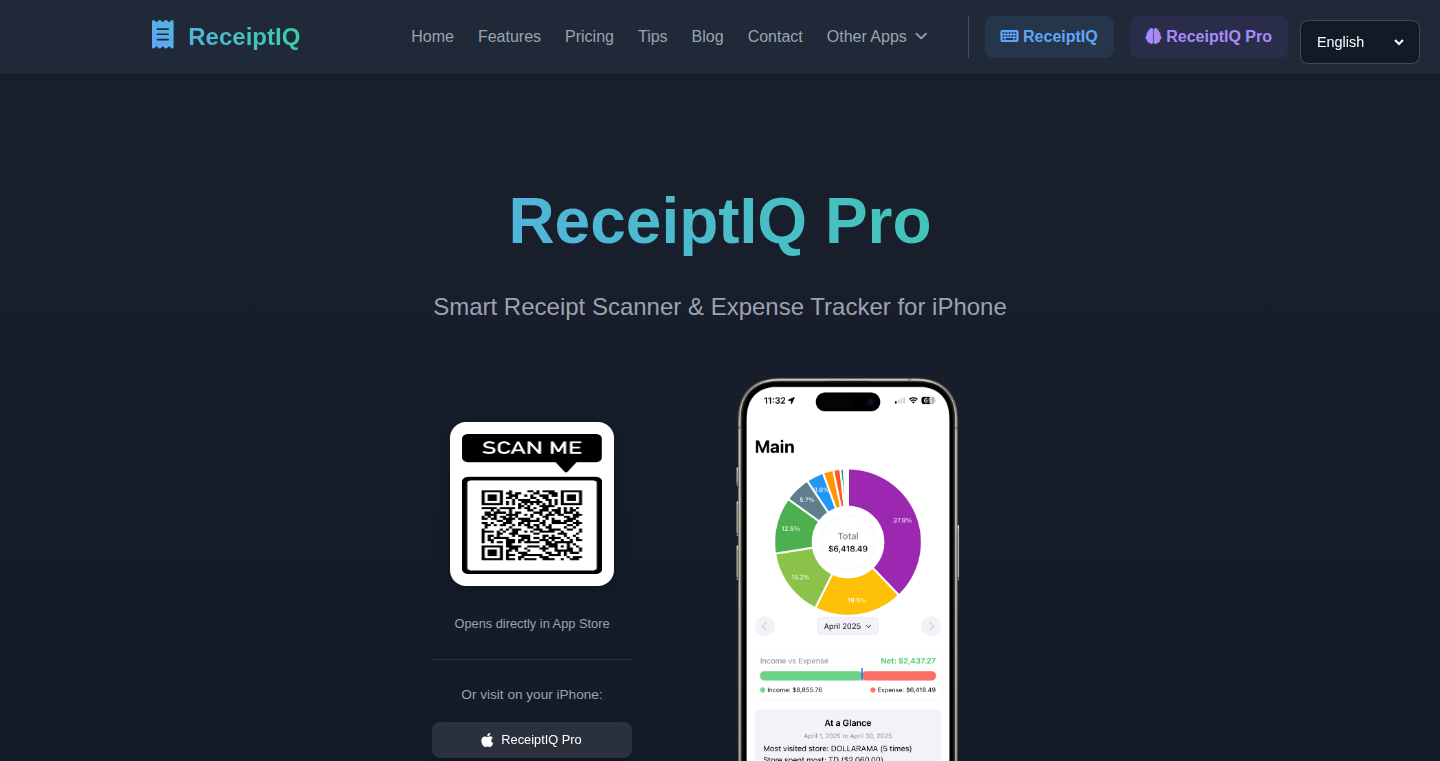
Author
nichliu
Description
ReceiptIQ Pro is an iOS app that uses Artificial Intelligence (AI) to automatically scan receipts, categorize purchases, and generate spending reports. It solves the common problem of manually tracking expenses by leveraging on-device Optical Character Recognition (OCR) and AI for item recognition. The app allows users to create budgets, track bills, and export data without needing an internet connection, offering a privacy-focused solution for personal finance management.
Popularity
Points 1
Comments 0
What is this product?
ReceiptIQ Pro uses AI to read the text from your receipts (OCR), like a digital eye. Then, it analyzes the text and figures out what you bought and how much you spent. This is all done on your phone for speed and privacy. The app then organizes this information into helpful charts and budgets, showing you where your money is going. So, instead of manually entering every item, the app automates the whole process, saving you time and effort. It provides a detailed view of your spending habits by automating the process of extracting data from receipts, offering a more efficient way to manage finances.
How to use it?
Developers can integrate similar AI-powered receipt scanning capabilities into their own iOS apps to enhance expense tracking or build custom financial tools. The core technology includes the use of Apple's Vision framework for OCR and the developer's own machine learning model for item categorization. This can be used in apps that need to process text from images, allowing for automatic data extraction and analysis. For example, a developer building a business expense app could use this to automatically extract item details from expense reports.
Product Core Function
· AI-powered receipt scanning: Automatically reads and extracts data from receipts using OCR and AI. This saves users from manually entering each item, making expense tracking faster and easier. So, this can save you a lot of time and ensure accuracy.
· Automated categorization: The app intelligently categorizes items based on the extracted data, allowing for organized spending analysis. This provides users with a clear understanding of their spending habits. So, you can easily see where your money is going and how you're spending it.
· Budgeting and reporting: Generates spending charts, creates budgets, and allows data export. This empowers users to manage their finances effectively. So, you can easily set budgets and track your spending habits.
· Offline functionality: Operates completely offline, with iCloud backup and restore as an option. This ensures user privacy and data security. So, your financial data is always safe and accessible, even without an internet connection.
· Additional features: Includes warranty reminders, bill tracking, and income logging. This adds more value and functionality to the app. So, you can manage more than just receipts, and your finances are managed in one app.
Product Usage Case
· Financial tracking app: A developer creates an app that tracks and analyzes user spending. The app uses ReceiptIQ Pro's technology to automatically scan receipts, categorize expenses, and generate detailed reports. This eliminates manual data entry and provides a seamless user experience. So, your app can offer expense tracking without the user having to type everything.
· Business expense management tool: A company builds an app for employees to track business expenses. The app integrates receipt scanning, making it easier for employees to submit expense reports. The app can automatically read receipt data. So, managing expenses becomes simpler and less time-consuming.
· Personal finance dashboard: A developer builds a personal finance dashboard that aggregates data from different sources. By integrating ReceiptIQ Pro's receipt scanning, the dashboard can automatically add spending data, giving users a complete view of their finances. So, you can build a complete financial overview easily.
82
Palworld Breeding Calculator: Breeding Path Optimizer
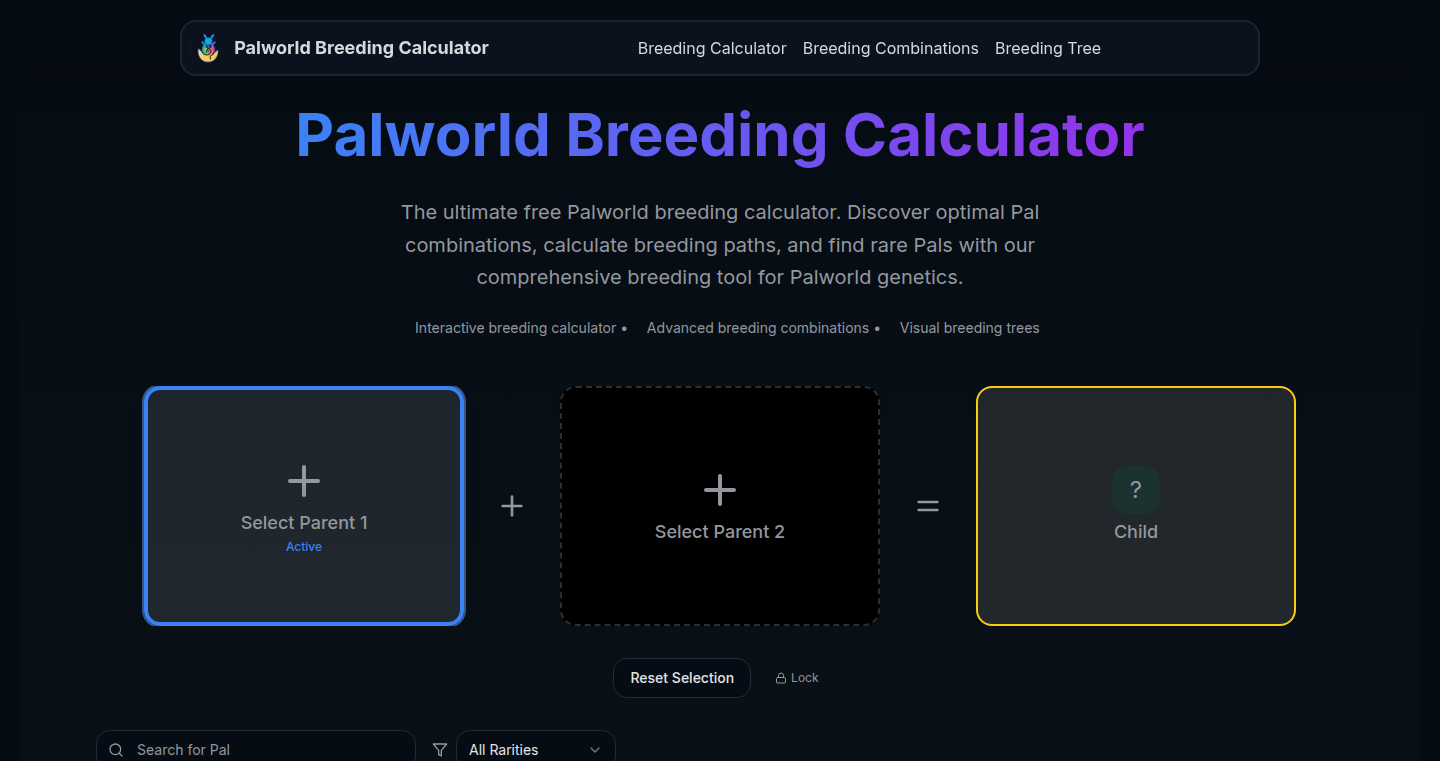
Author
droidHZ
Description
This tool helps players of Palworld plan their creature breeding efficiently. It uses advanced algorithms, like shortest-path search, to determine the quickest breeding routes. It tackles the complex problem of Palworld's breeding mechanics, providing an intuitive interface for both forward and reverse lookups. The core innovation lies in treating breeding as a graph problem, allowing for optimal breeding strategies.
Popularity
Points 1
Comments 0
What is this product?
This is a breeding calculator for the game Palworld. It works by taking the game's breeding combinations, mapping them into a graph structure. When you want a specific creature, the calculator uses a 'shortest path' algorithm (like Dijkstra or Breadth-First Search) to find the fewest breeding steps to get it. It offers several features, including a visual breeding tree and a combination browser. The technical innovation here is transforming a complex breeding system into a problem that can be solved with efficient graph algorithms.
How to use it?
Players input their desired creature or the parents they have. The calculator will either show the child creatures, or calculate the shortest breeding path to the target creature, along with a visual tree of the breeding steps. The tool is accessed through a web browser, making it easy to use on any device. For developers, it's a great example of how to use graph theory and search algorithms to solve complex problems. The project leverages Next.js for the front end, and precomputed indices for fast data access.
Product Core Function
· Forward Calculation: Given two parent creatures, the tool instantly displays the resulting child creature. This provides a quick lookup function, saving time and effort.
· Reverse Lookup: Input a target creature, and the tool lists all possible parent combinations. This helps players discover breeding options.
· Shortest-Step Planner: The tool calculates the shortest breeding path to achieve a desired creature. It uses graph algorithms to optimize breeding strategies, making the breeding process more efficient.
· Breeding Tree Visualizer: This feature presents an interactive tree of breeding combinations, allowing players to visualize the breeding routes at a glance. It helps in understanding the breeding steps and planning better.
· Combination Browser: Allows users to search and filter all possible parent-child combinations. This is useful for exploring breeding possibilities and discovering new combinations.
Product Usage Case
· In a game where breeding combinations are complex, this tool drastically reduces the time spent planning and experimenting. The 'shortest path' feature is crucial for players who want to maximize their breeding efficiency, and obtain specific rare creatures faster.
· Game developers creating complex breeding mechanics can draw inspiration from this project. The project demonstrates how to turn complex game mechanics into solvable algorithmic problems, optimizing the player experience.
· The project showcases the power of applying graph algorithms in unexpected contexts. Developers can use the project as a template to solve optimization problems in other games or complex system planning in other applications.
83
Dealerlytix: AI-Powered Inventory Intelligence
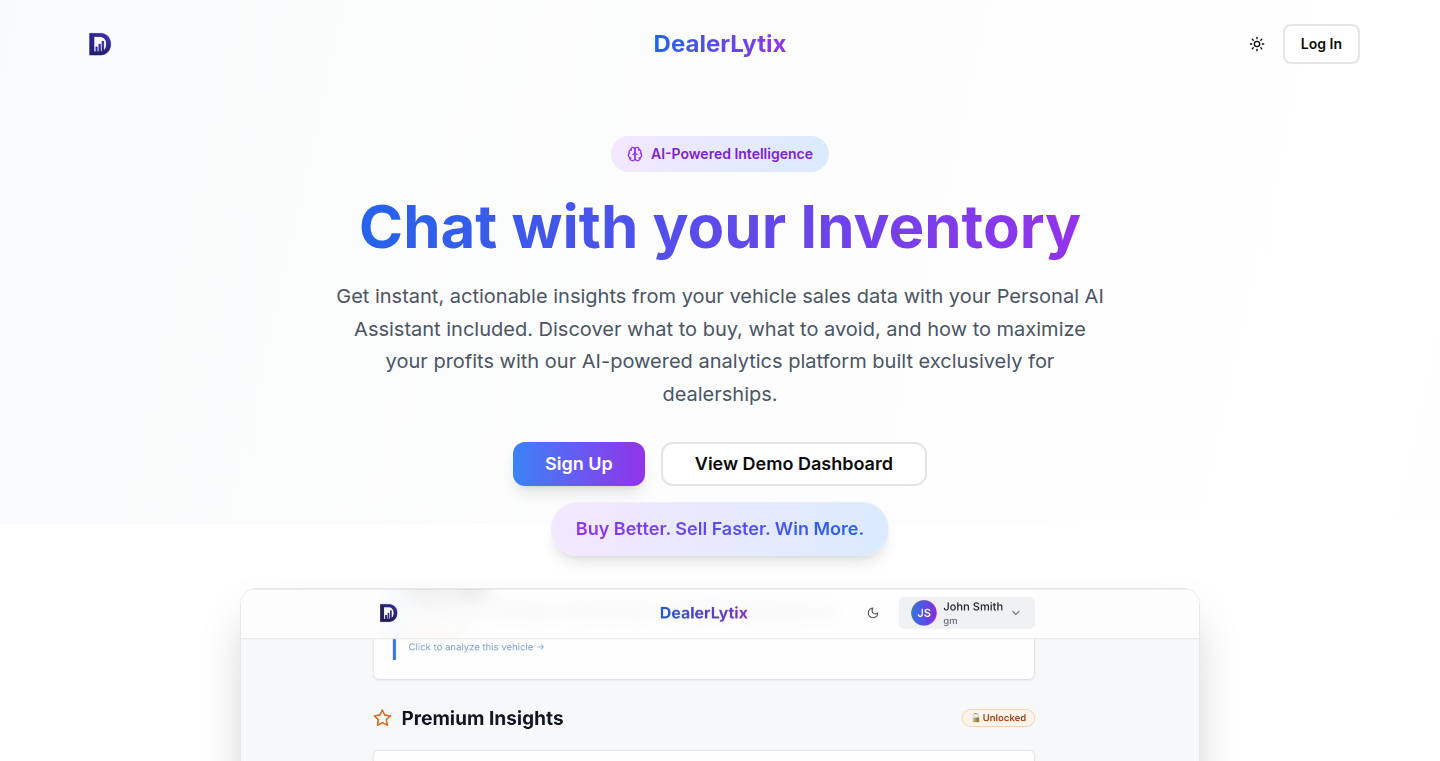
Author
nubani
Description
Dealerlytix is a Software as a Service (SaaS) platform designed for car dealerships, leveraging Artificial Intelligence (AI) to optimize their vehicle buying, pricing, and selling strategies. It tackles the common problem of dealerships relying on intuition or basic tools for inventory management. The core innovation lies in its ability to analyze a dealership's historical data to predict sale speed, profit margins, and optimal pricing before acquiring a vehicle. This allows dealers to make data-driven decisions, improving profitability and reducing inventory holding times.
Popularity
Points 1
Comments 0
What is this product?
Dealerlytix uses AI to analyze a dealership's past performance data, predicting the future sales performance of vehicles. This involves several AI models that assess factors like make, model, trim, color, and historical pricing. It's like having a crystal ball that tells you which cars will sell quickly and at what price, helping dealers avoid buying cars that will sit on the lot for too long. So this is helpful because it lets dealers make informed decisions.
How to use it?
Dealerships can integrate Dealerlytix by connecting it to their existing inventory management systems. This data feed allows the AI to learn the dealership's specific market and performance trends. Users can then use Dealerlytix's dashboards and tools to get AI-driven insights. They can ask questions like "Which SUVs under $30k sell the fastest?" or "What's the optimal price for this specific vehicle?" This integration is straightforward; so this is helpful because it gives you quick access to insights.
Product Core Function
· AI Vehicle Scoring: Predicts sale speed, profit margin, and optimal price before acquisition. This is valuable because it helps dealerships avoid costly mistakes in inventory selection, ensuring they acquire vehicles that will generate the highest profit.
· Smart Inventory Assistant: Allows users to ask questions about their inventory and receive data-driven answers. This provides easy access to crucial information, such as fastest-selling vehicles or profitable segments within the dealership's specific market.
· Lifecycle Tracking: Provides repricing history, profit snapshots, color trends, and seasonal performance analytics. This helps dealers understand how their inventory performs over time, enabling better pricing strategies and informed decisions regarding vehicle lifecycle management.
Product Usage Case
· A used car dealership struggling to manage its SUV inventory can use Dealerlytix to identify the specific models, trim levels, and price points that have historically sold quickly and profitably within their local market. This information can then be used to prioritize the acquisition of these high-demand vehicles, maximizing sales and revenue.
· A dealership aiming to optimize its pricing strategy can use Dealerlytix to compare the profit margins achieved on different colors of a specific model, to see if certain colors are more attractive to customers, thereby allowing the dealer to adjust the pricing strategy based on the specific performance of the inventory.
· A dealership can use Dealerlytix to track the performance of its inventory throughout the year, by viewing seasonal trend of different vehicle models, allowing the dealership to decide if its time to acquire more of certain type of vehicle or reducing the inventory of the vehicles that are no longer in demand.
84
Zest: Collaborative AI Agents for Slack

Author
kakaly040390
Description
Zest enables the creation and deployment of AI agents directly within Slack, transforming the way teams interact with and leverage AI. These agents automate complex workflows, from lead enrichment and task management to content generation and proactive assistance. The core innovation lies in its collaborative approach: agents live in public Slack threads, fostering a social learning environment where team members learn and refine their interactions with AI. This improves prompting skills and encourages ‘agentic workflows’. Zest also provides a user-friendly dashboard for easy bot creation, management, and tool integration.
Popularity
Points 1
Comments 0
What is this product?
Zest leverages the power of AI and integrates it into Slack through intelligent agents. It uses technologies like Vercel AI SDK and axllm.dev (DSPy for Typescript) for the AI agent core, enabling the bots to perform various tasks such as gathering customer information, drafting emails, filing support tickets, and more. These agents are designed to communicate and collaborate within existing Slack channels, allowing team members to observe, learn, and refine their interactions with the AI, creating a collaborative and iterative process for AI-driven workflows. So this provides a more natural and accessible way to integrate AI into your daily work.
How to use it?
Developers can use Zest to automate specific tasks and workflows within Slack. For instance, you could configure an agent to automatically create a Linear ticket when someone mentions a new task in a Slack channel. You would provide Zest with the necessary access to tools like Linear, then write prompts defining the desired behavior. The agent then monitors the channel and autonomously handles ticket creation based on these rules. It also has a dashboard for easily managing and deploying new bots. So, by using Zest, developers can automate processes, improve team productivity, and reduce manual work by integrating AI directly into their existing communication platform.
Product Core Function
· Automated Lead Enrichment: Automatically enriches lead data using external APIs and drafts personalized emails. So this helps sales teams to quickly gather information on leads and speed up the process of engaging them.
· Task Management: Automatically files tasks into project management tools like Linear based on mentions in Slack channels. So this streamlines project management and ensures tasks are not missed.
· Customer Information Retrieval: Gathers customer information from services like Stripe for transaction failures, bringing it into the Slack thread. So this provides immediate access to critical data, helping in resolving customer issues efficiently.
· Content Generation: Scours the web and drafts blog posts or other content. So this automates content creation, saving time and effort.
· Proactive Assistance: Proactively offers assistance based on conversation context, such as offering to break down sprint planning tasks. So this enhances productivity and provides proactive support.
· Collaborative Prompting: Encourages team members to learn from each other and improve how they interact with the AI agents through observing others and refining prompt techniques. So this improves the team's collective understanding of AI and improves the use of AI tools.
Product Usage Case
· Sales Teams: An agent can be set up to enrich new leads that come in through a signup form. The agent uses APIs like Apollo to gather lead data and then drafts a personalized email, automatically placing the draft in the salesperson’s mailbox. So you get better qualified leads, faster.
· Customer Support: When a customer transaction fails, an agent immediately pulls customer information from Stripe and posts it in the relevant Slack channel. Support teams can immediately see what happened and the context of the error. So this provides faster and more effective customer support.
· Project Management: When someone in a Slack channel mentions a new task, a Zest agent will automatically create a corresponding ticket in a project management tool like Linear. The agent may also ask clarifying questions to ensure the ticket is complete. So you can keep track of tasks efficiently without manually entering them.
· Content Creation: A content creator can use a Zest agent to find information online and draft the first version of a blog post. The agent does the research and writing. The creator can then refine the draft collaboratively within Slack. So this streamlines content generation.
· Team Collaboration: During sprint planning discussions in a Slack channel, the agent can proactively offer to break down the planning into tasks. So this improves meeting efficiency.